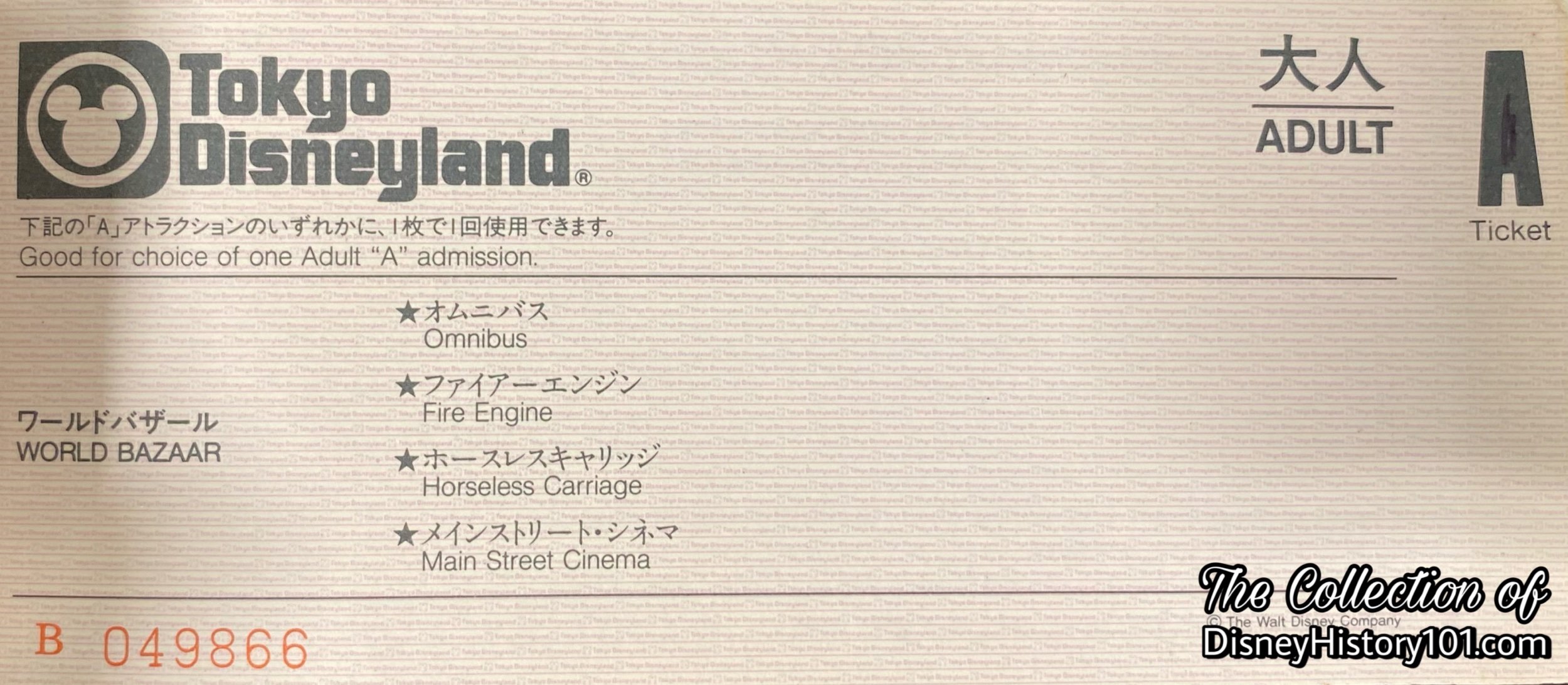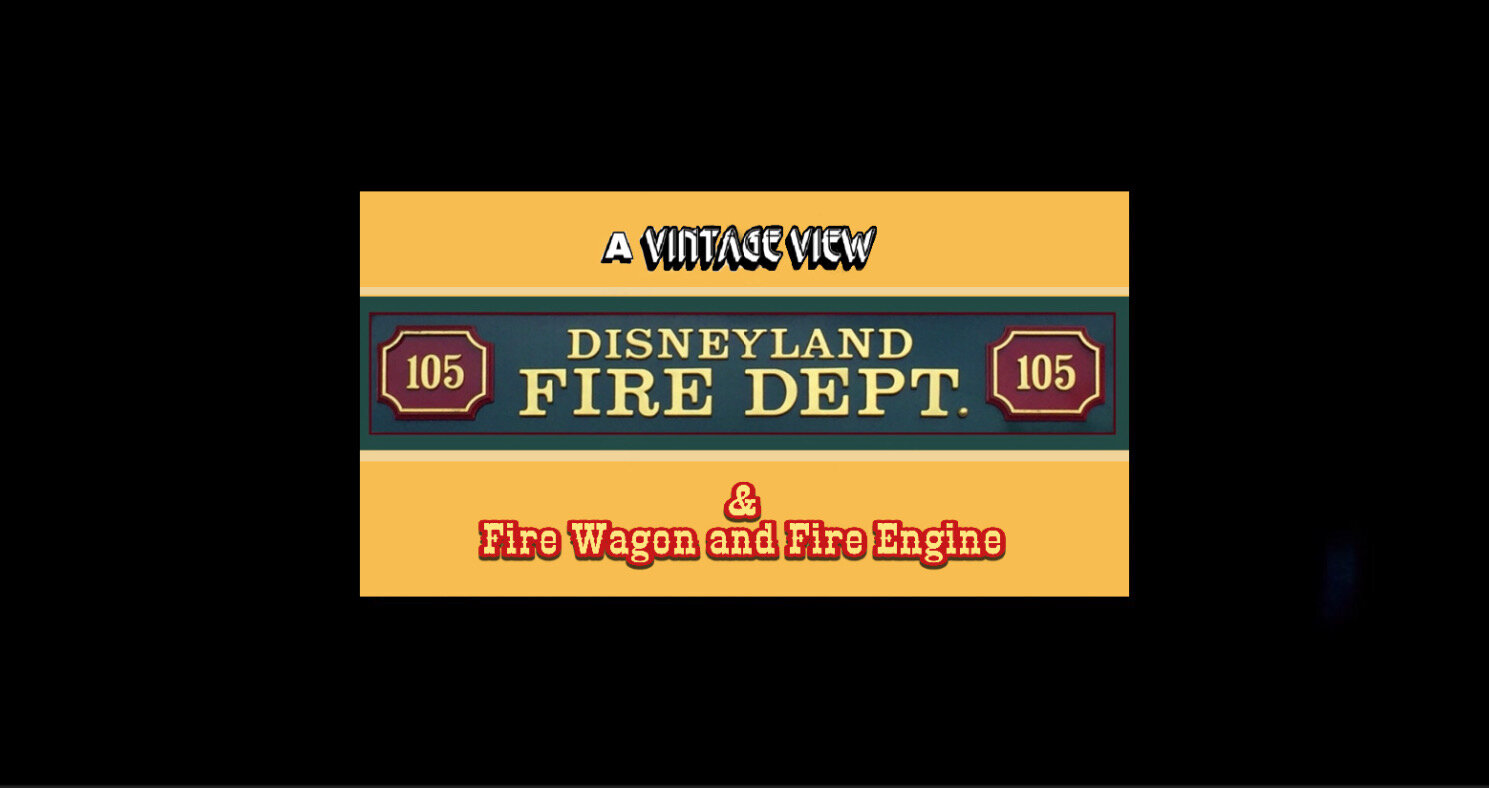DISNEYLAND FIRE STATION (FIRE DEPARTMENT)

(July 17, 1955 - present)
“Blue Sky for ‘Mickey Mouse Park’ Fire Station”
A Fire Station was included in some of the earliest designs for Walt Disney’s themed amusement park. Back in 1948, Walt was dreaming about a Park (to be located across the street from the Studio in Burbank). The opening words of the “Mickey Mouse Park” prospectus mentioned that “adjoining Town Hall will be the Fire and Police Stations. The Fire Station will contain practical fire apparatus… scaled down.” [“The Spirit of Disneyland”] Early thumbnail sketches and other concept artwork seemed to be unencumbered by restrictions of budget, schedule or the laws of nature and physics. Though guided by Walt, his artists appeared to engage in “free-thinking,” as if implementing the modern “Blue Sky” Imagineering process.
Even at this early date, the Main Street Fire Station had its roots in true-life structures. For instance, when Walt Disney Studio artist Harper Goff was tasked with creating Main Street building design concepts for the “Mickey Mouse Park” (an 11-acre plot across the street from Walt Disney Studio), he drew some inspiration from the old buildings of his hometown - Fort Collins, Colorado. Some of those very same structures (some of them two-story) that were present from 1911-1920), were also present when Harper arranged for photographs of Fort Collins to be captured and shown to Walt during the early 1950s. While the Main Street Fire Station was not directly inspired by any singular building, Harper’s memories of them doubtlessly continued influential to conceptual artwork soon produced for the early “Mickey Mouse Park” concepts and ultimately the 160 acres of Walt Disney’s Disneyland in Anaheim, California!

Aerial View of Disneyland "Brownline" Drawing Excerpt, originally produced September 26 & 27, 1953.
“Blue Sky for the Disneyland Fire Engine House”
The preceding image is an excerpt from Herb Ryman’s “Aerial View Over Disneyland,” which was produced over a weekend (September 26 & 27, 1953). In this excerpt (pictured above), we get a glimpse of the Main Street Fire Station (which appears to be an exhibit of sorts) located in Disneyland’s Civic Center of Town Square.
By July 1, 1954, George Whitney of Disneyland, Inc. directed Amusements, with Ron Miller overseeing analysis, philosophy, capacities, planning, operator training, and amusement procurement. Soon “The Disneyland Story” (a document produced on September 3, 1954), told the story of what guests would experience once entering Disneyland. The opening page states : “Here you will see…the Fire Engine House with the Old Fashioned Fire Engine.” Clearly, a Fire Department has been a part of Disneyland plans since it’s earliest conceptual stages.
Like some advanced “High Concept,” final designs were quickly generated and approved. Some of these viable project Concepts (as this), were supported by a well-developed business case and built expectation. In fact the Disneyland Fire House was included among the portfolio of colored sketches by Herb Ryman, Bruce Bushman, Harper Goff, and others that was prepared for Dick Irvine and Nat Winecoff to take back East to sell the Disneyland concept to prospective licensees.
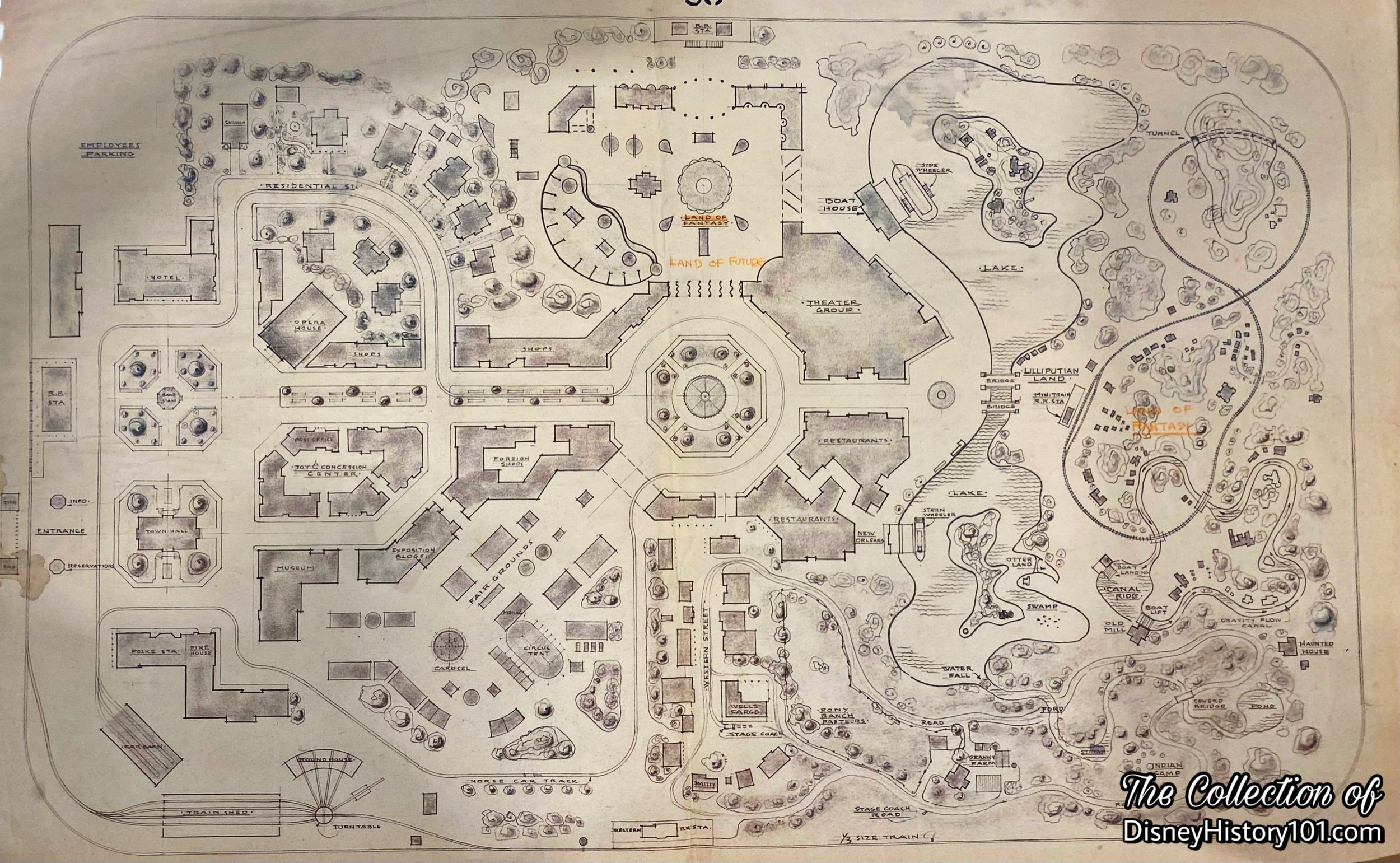
“Disneyland Preliminary Scheme #1”
“Master Planning and Design of the Disneyland Fire Engine House”
Next, architectural drawings helped define all designs, production and construction strategies, costs, schedule, and resource requirements. “Disneyland is unique in that some of the world's foremost creative artists and architects control all design at Disneyland.“ Models explored the various dimensional relationships, site-lines, flow patterns, ergonomics, and visual appeal to convey the desired creative intent. By January 7, 1955, architectural drawings (elevations and site plans) for “Town Hall” on the 200 Block had been completed by a “Lorrecc” and an “H.S.” of WED Enterprises, Inc. for Disneyland, Inc. The drawings were checked by a “WBK,” approved by two individuals, and revised twice - by “R.A.M.” (on March 4, 1955) and E. Jericho (March 9, 1955).
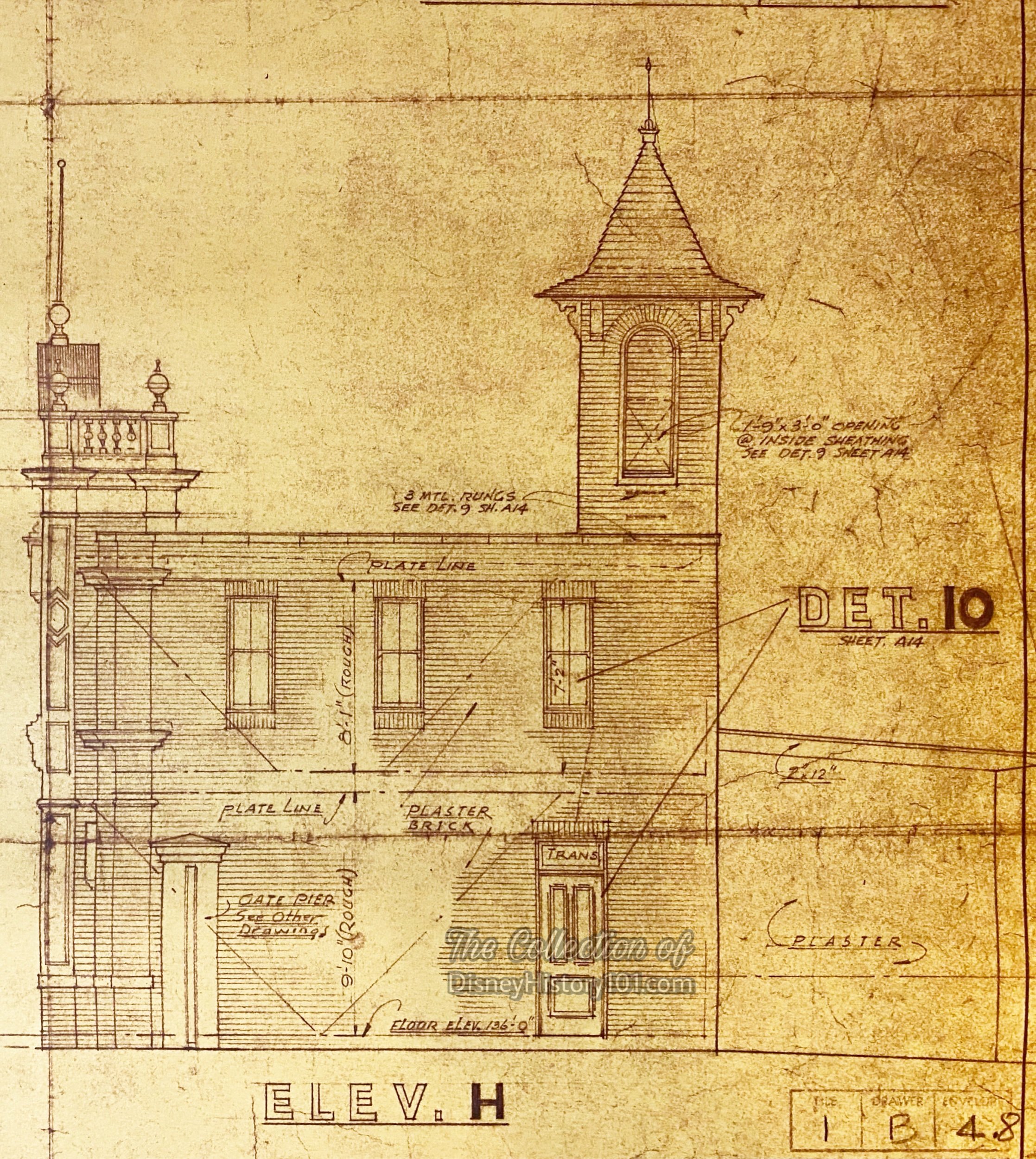
“200 Block Town Hall Elevations” of the Architectural Facade drawn by Lorrecc, January 7, 1955; revised by RAM 3-4-55 & E. Jericho, 3-19-55; checked by WBK
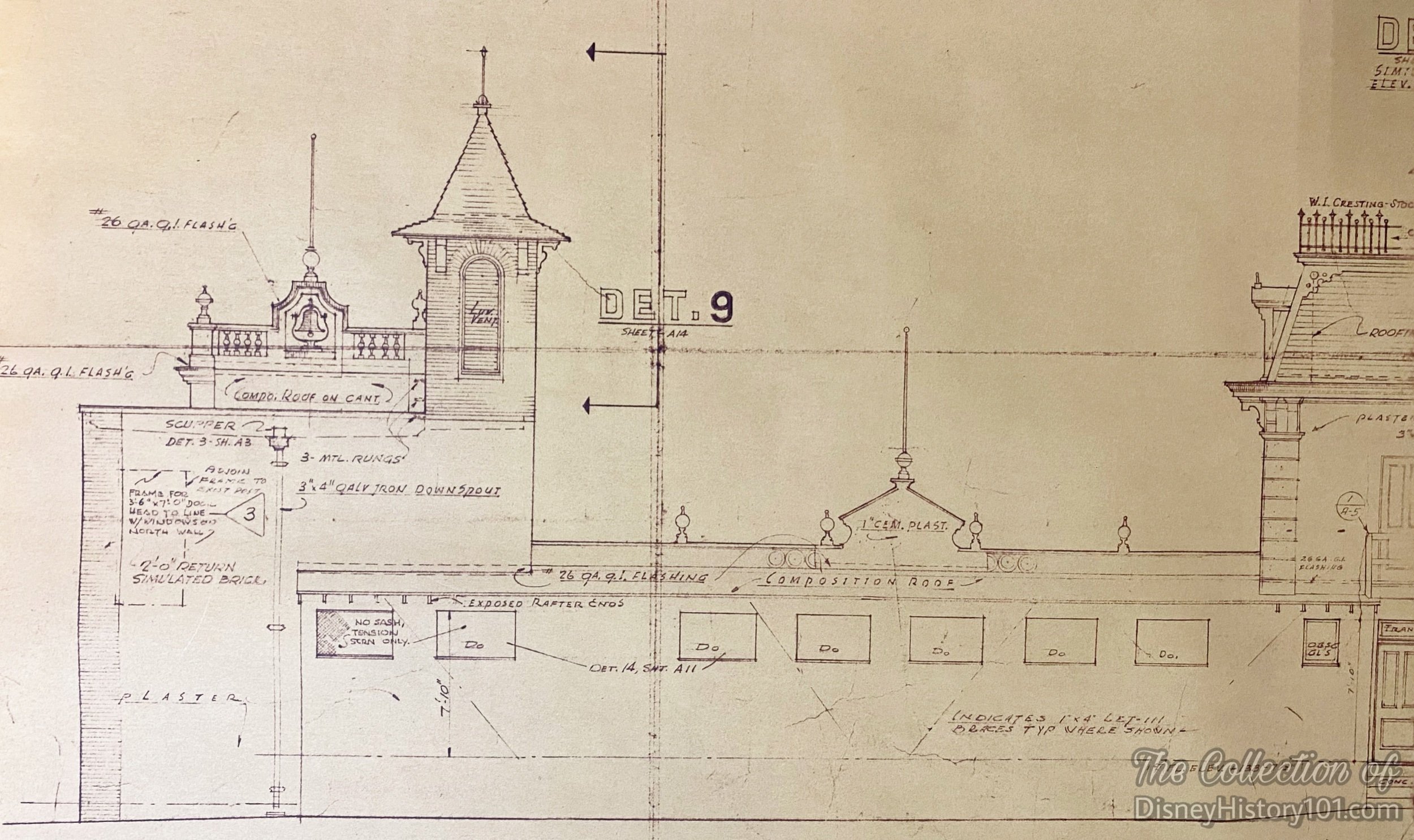
“200 Block Town Hall Elevations” of the Architectural Facade drawn by Lorrecc, January 7, 1955; revised by RAM 3-4-55 & E. Jericho, 3-19-55; checked by WBK
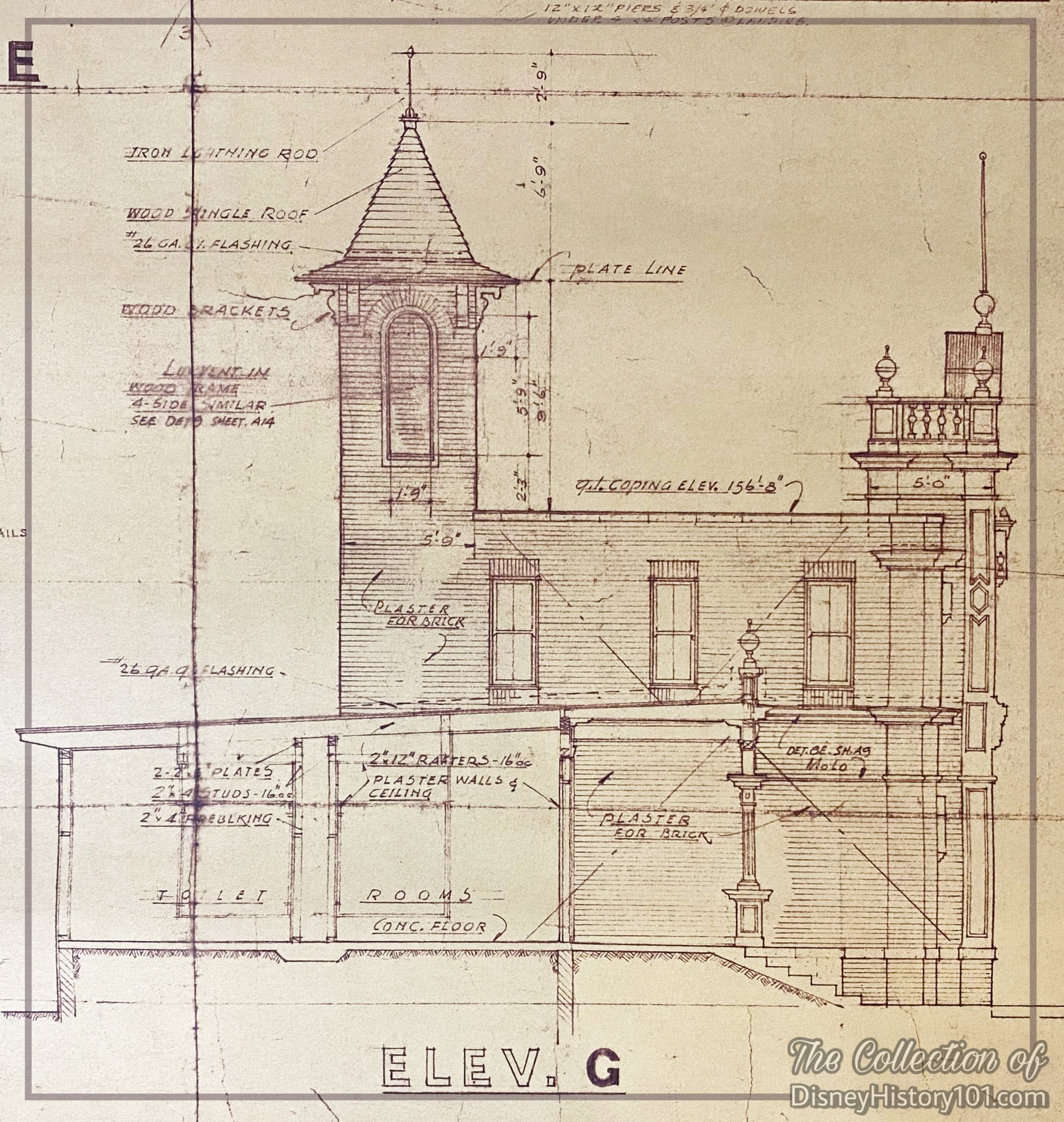
“200 Block Town Hall Elevations” of the Architectural Facade drawn by Lorrecc, January 7, 1955; revised by RAM 3-4-55 & E. Jericho, 3-19-55; checked by WBK
“Construction of Disneyland Fire Engine House”
F. M. Franz, manager of operations for MeNeil Construction expressed: "We feel sure there has never been anything built like this in Southern California, or elsewhere in the United States. Many of the items were constructed from artist’s sketches.” An excellent example is the Disneyland Fire Engine House!
Forced perspective would make the buildings on Main Street appear taller than actually are. On Main Street the buildings would not be full scale. Ground floors were built about 9/10ths scale. Second floors measured up to 7/10ths scale. The scale on the uppermost floors would be smaller still.
Floor Slabs and Framing - First, a concrete foundation and slab floors were prepared, followed by wood frame construction (while store units would have a combination wood and rigid steel frame). Oren Gallegly was one “55er” who came to Disneyland as a diver-welder, and soon found himself working as a carpenter, building the fire station.
According to inserts published in area newspapers during July of 1955, Disney buildings were roofed by Pioneer Roof & Shingle Company (then located at 608 Mateo Street, Los Angeles, California; 7522 Westminster Avenue, Westminster, California). The roof covering was a variable, dependent on the architectural design. This particular roof was covered in steep wood shingles with dormers, towers, and ornamental iron railings. The floors were of asphalt tile while the walls were painted and papered drywall partitions.
External Finishing - Larson Brothers Plastering Company of San Diego was a proud part of Disneyland. The company crafted the ornamental plastering and all brick used at Disneyland (including their amazing new plastered brick veneer). Like most facades of Main Street USA, that of the Disneyland Fire Department was designed and constructed at smaller scales - 9/10 scale for the first floor and 8/10 scale for the second floor. As for the simulated brick and stone of the exterior Main Street front and side elevations, it was comprised of QuikBrik, “real brick applied like plaster,” manufactured by American Cement Products, Inc. (of Detroit, Michigan). The versatile Quikbrick (real colorful and textural brick applied like plaster) was about half the price of ordinary brick. It insulated, beautified, and was meant to “last a lifetime.” It was used on the facade.
The rear elevation facade was composed of stucco.
Rough-In Plumbing and Electrical - The building (as each on Main Street U.S.A.) possessed complete fire sprinkling systems. By June 30, 1955, related Disneyland Site Work Fire Protection Utilities Plot Plans were prepared for Disneyland Inc., by J.E. Thomasson of WED Enterprises Inc.
“Newbery Electric Corp. took the rapid electrical construction of Disneyland in stride. The electrical installations were supervised by Roy J. Gruendler, manager of Newbery's Orange County district office located at 1335 Santiago Ave, Santa Ana.”
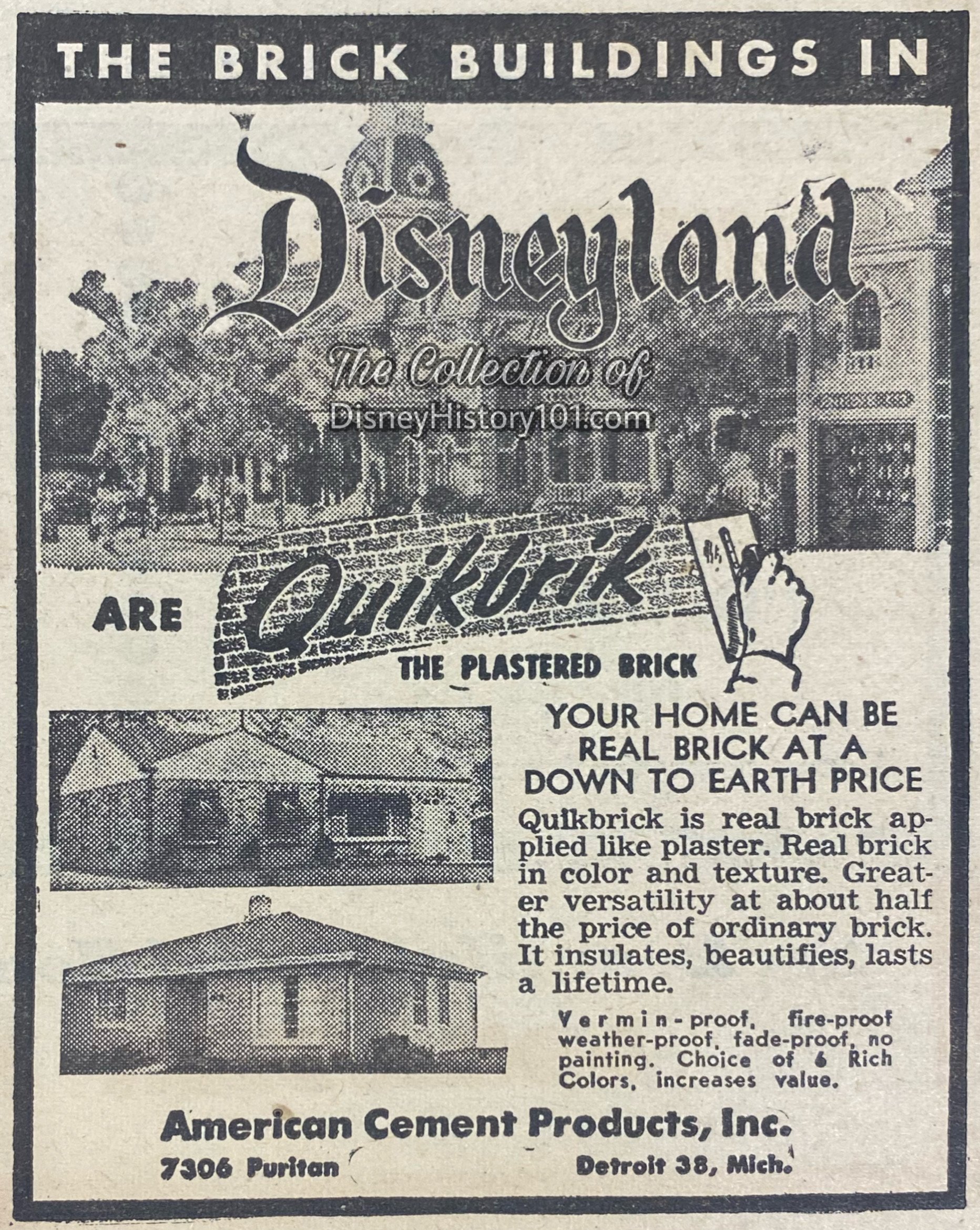
By July 2, 1955, shadow gags were ordered. Painted signs, window, curtains, and shades were projected to be completed on time. The sound equipment was be installed, with completion of the tape recordings appearing to be fairly tight. As of June 2, 1955, C.V. Wood Jr. sent an Inter-Office Memorandum to Walt Disney regarding the best estimates that could be obtained at the time regarding the status of individual sections of the Park and Opening Day. C.V. wrote: “Fire Station - With the exception of the upstairs for which the design is still unknown, it will be complete.”
While construction was being completed, Walt described the West side of the “City Square” (to Bob Thomas of Associated Press), this way : “next door is the firehouse, with an old fire wagon the kids can get on and ride around the town. Upstairs will be a room for VIP’s, where we’ll entertain the visiting firemen.’” One authorized “Disneyland Information & Nomenclature List” (prepared by Bill Cottrell of Disneyland Inc., by May 25, 1955) listed “official and authorized nomenclature” of Disneyland, distinguished the “Buildings in Civic Center” : “Disneyland Police Department, Disneyland City Hall, Disneyland Fire Department, Disneyland Opera House.”
“Press Preview and Grand Opening of Disneyland”
Art Linkletter - host of the televised Grand Opening of Disneyland (airing live on ABC, July 17th, 1955), first introduced the Main Street Fire Station this way : “Fire Station - that’s a special interest of the volunteer ‘bucket brigade,’ whose horse-drawn engine and up to date hose and chemical wagon are a source of real local pride!” Yes, this exhibit was reckoned among “Disneyland rides and amusements” that “will delight the very young, the teen-ager, young married couples, the middle-aged, and grandparents alike,” as some of the Vintage Views testify [Anaheim Bulletin “Premier Souvenir Edition - Walt Disney’s Magic Kingdom - Disneyland” Insert ; Friday, July 15th, 1955].
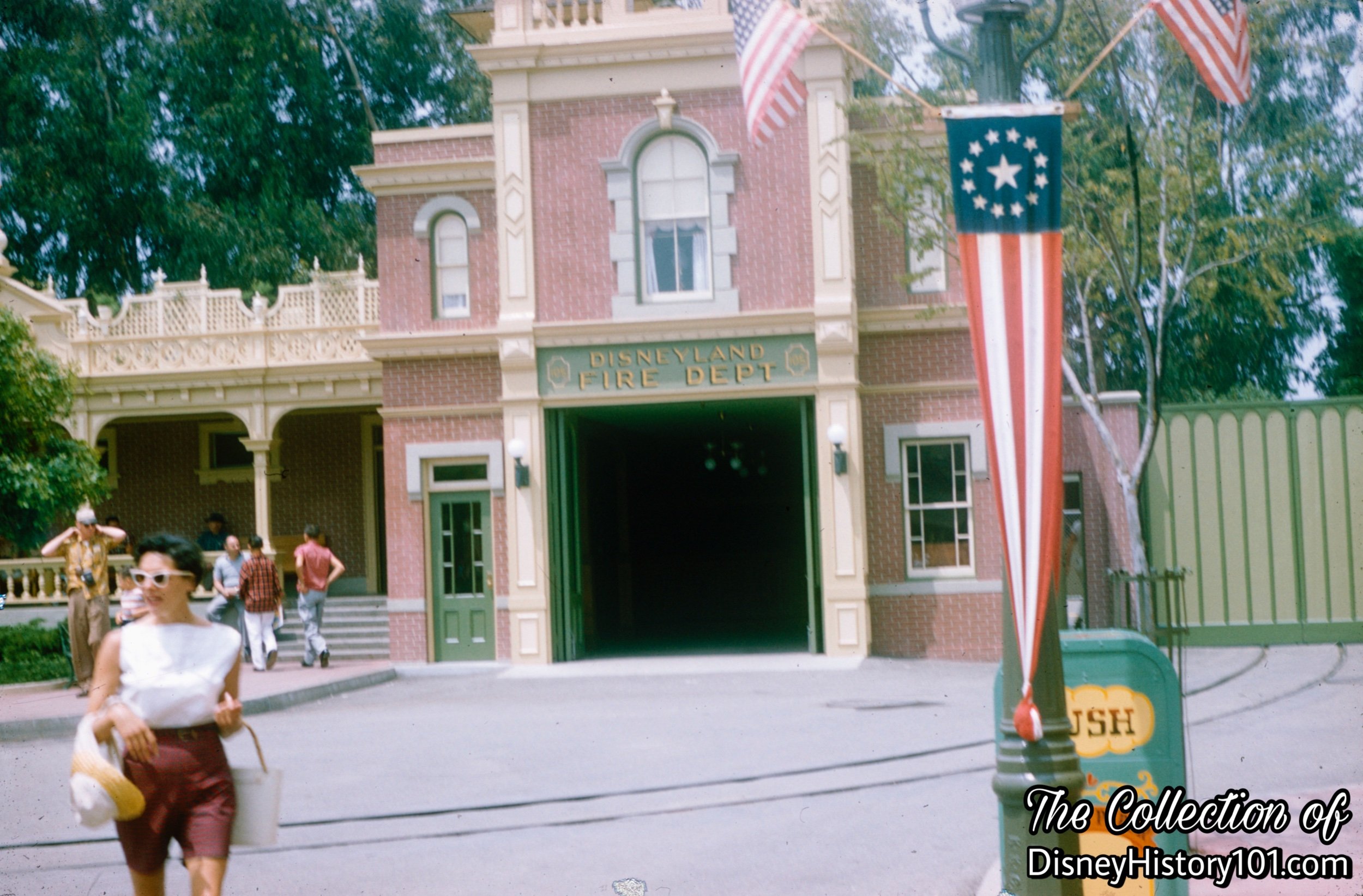
Disneyland Fire Department Front of House.
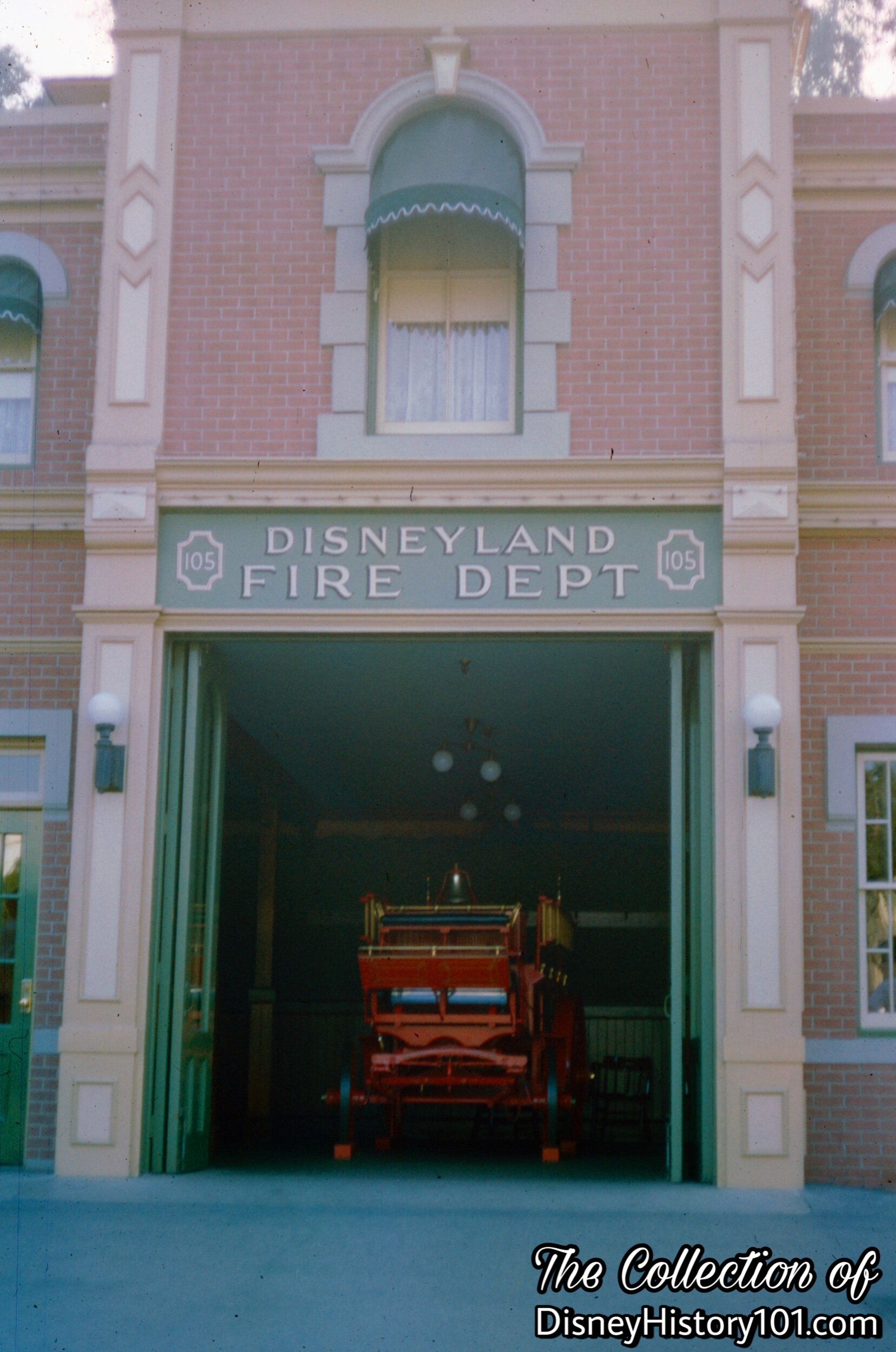
Disneyland Fire Department & Fire Wagon, (1955)
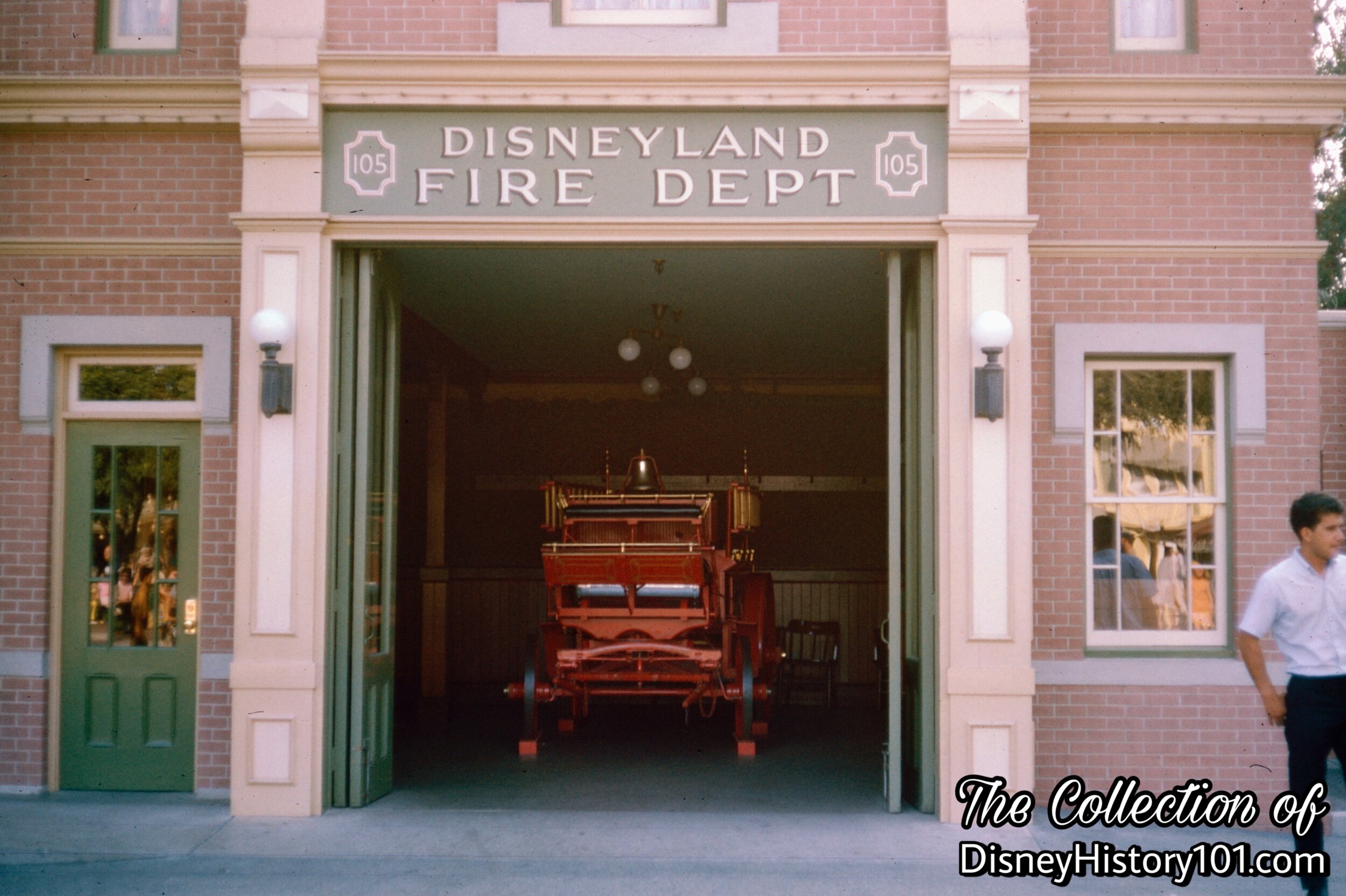
Disneyland Fire Department & Fire Wagon, 1955.
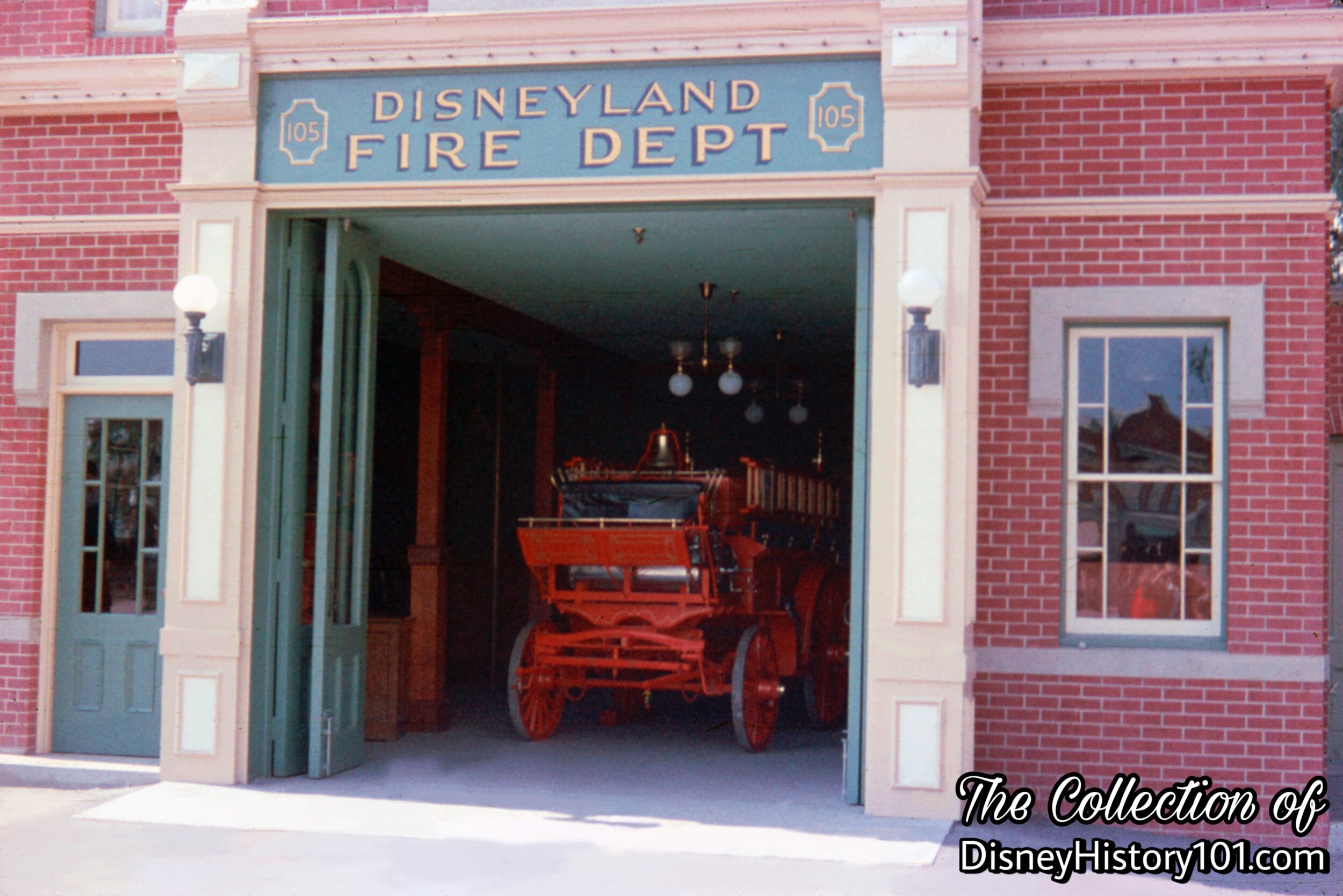
Disneyland Fire Department & Fire Wagon, 1955.

Disneyland Fire Department, 2019
With only slight deviation from the original color scheme (i.e. that of the doors, circular awnings and trim), as well as more durable materials, the Disneyland Fire Department Building facade is virtually similar to that of Walt’s day.
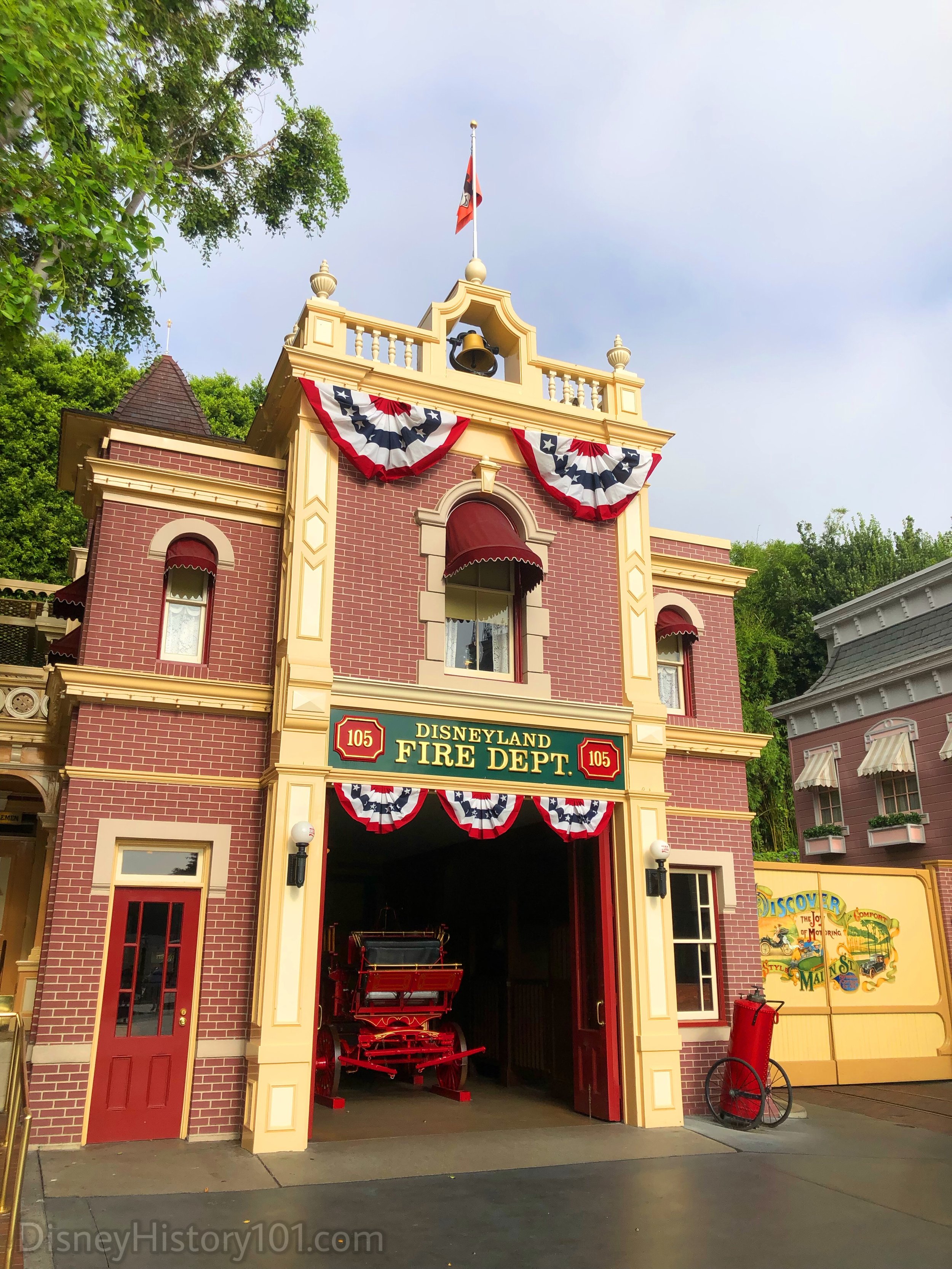
Disneyland Fire Department, 2019
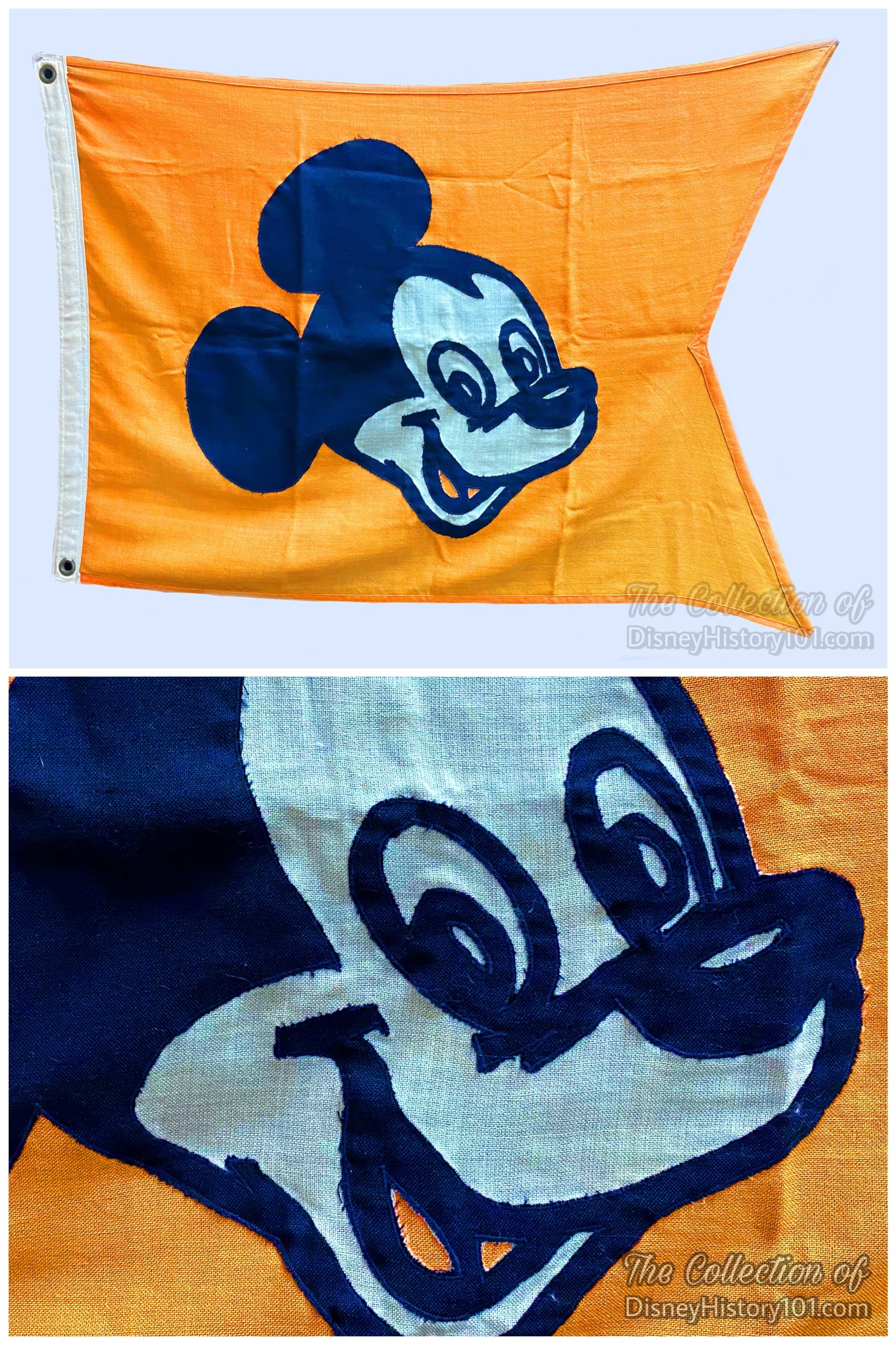
The Mickey Mouse Flag, which was flown over Disneyland City Hall, the Main Street Station, Guest Relations, the Disneyland Fire Department, and even “the Biggest Bass Drum” in the world.
The first Disneyland Dictionary (printed October 1959) makes a brief (but noted) distinction between the Mickey Mouse Flag and the “Official Flag of Disneyland”: “There are many flags flown in Disneyland - atop buildings, flag poles and many of Disneyland's boats. There are American flags of today and flags of our nation's historical growth, and flags of other countries. There are also Mickey Mouse flags and the official Disneyland flag.”
By 1959, The Mickey Mouse Flags were copyright Walt Disney Productions and once located over Main Street Depot, the Police Station, the Fire Station, and the Mickey Mouse Club Theater.
While there have been a number of Disneyland Flags produced for various Stages around the Park, the Mickey Mouse Flag, was later flown over several locations on Main Street Disneyland City Hall, the Santa Fe & Disneyland Railroad Main Street Station, Disneyland Guest Relations, “the Biggest Bass Drum” in the world float (which made appearances in Walt’s day), and the Disneyland Fire Department. These were a reminder “for all who come to this happy place,” that “it all started with a mouse.”
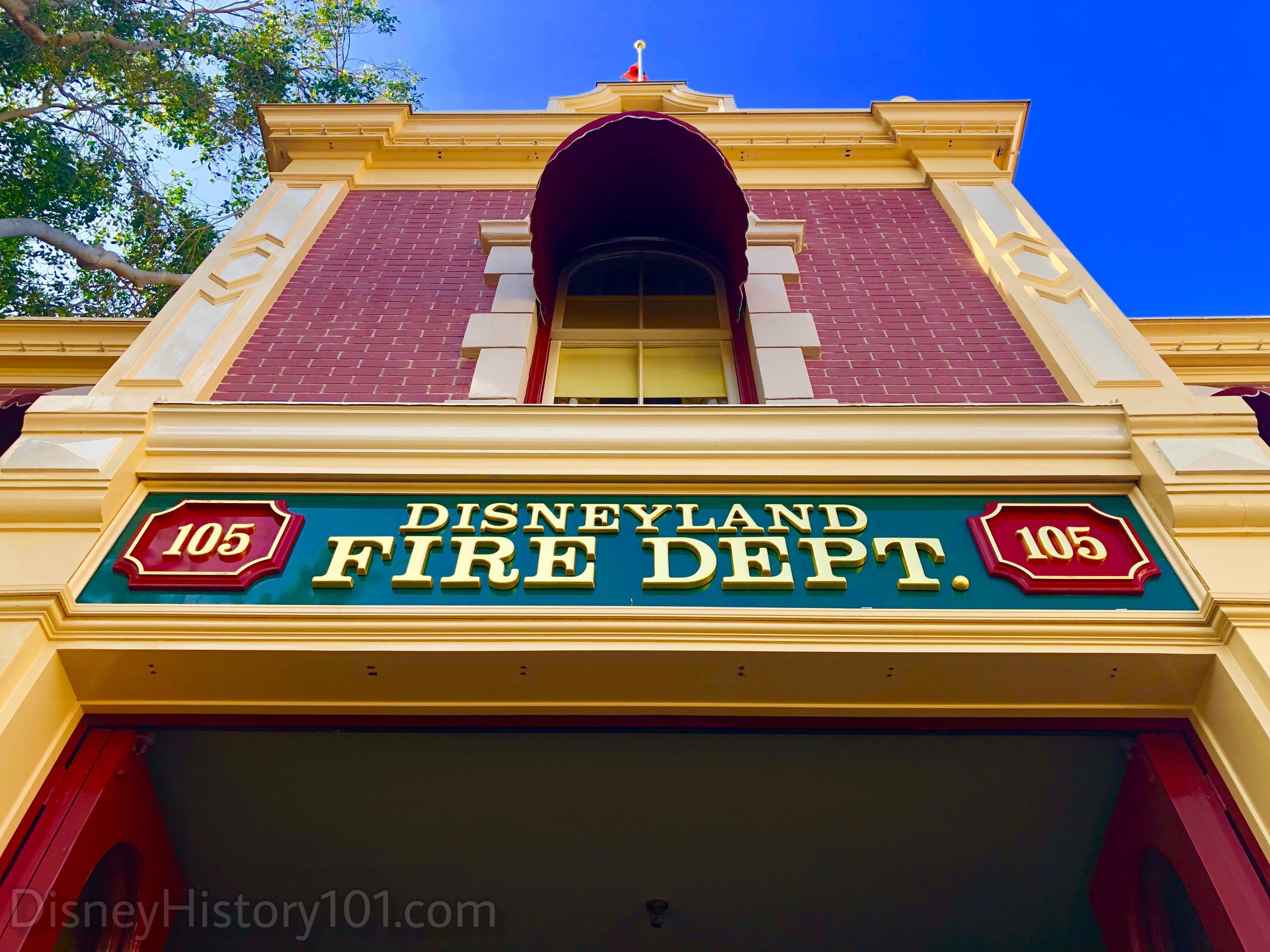
Disneyland Fire Department, 2019
Though this is an exhibit, Disneyland’s buildings were equipped “with sprinkler systems for fire protection,” by 1956, according to “News From Disneyland” (a c.1956 press release document). “Eight manual fire alarm boxes are on the site with connections in security offices and the Anaheim Fire Department.”
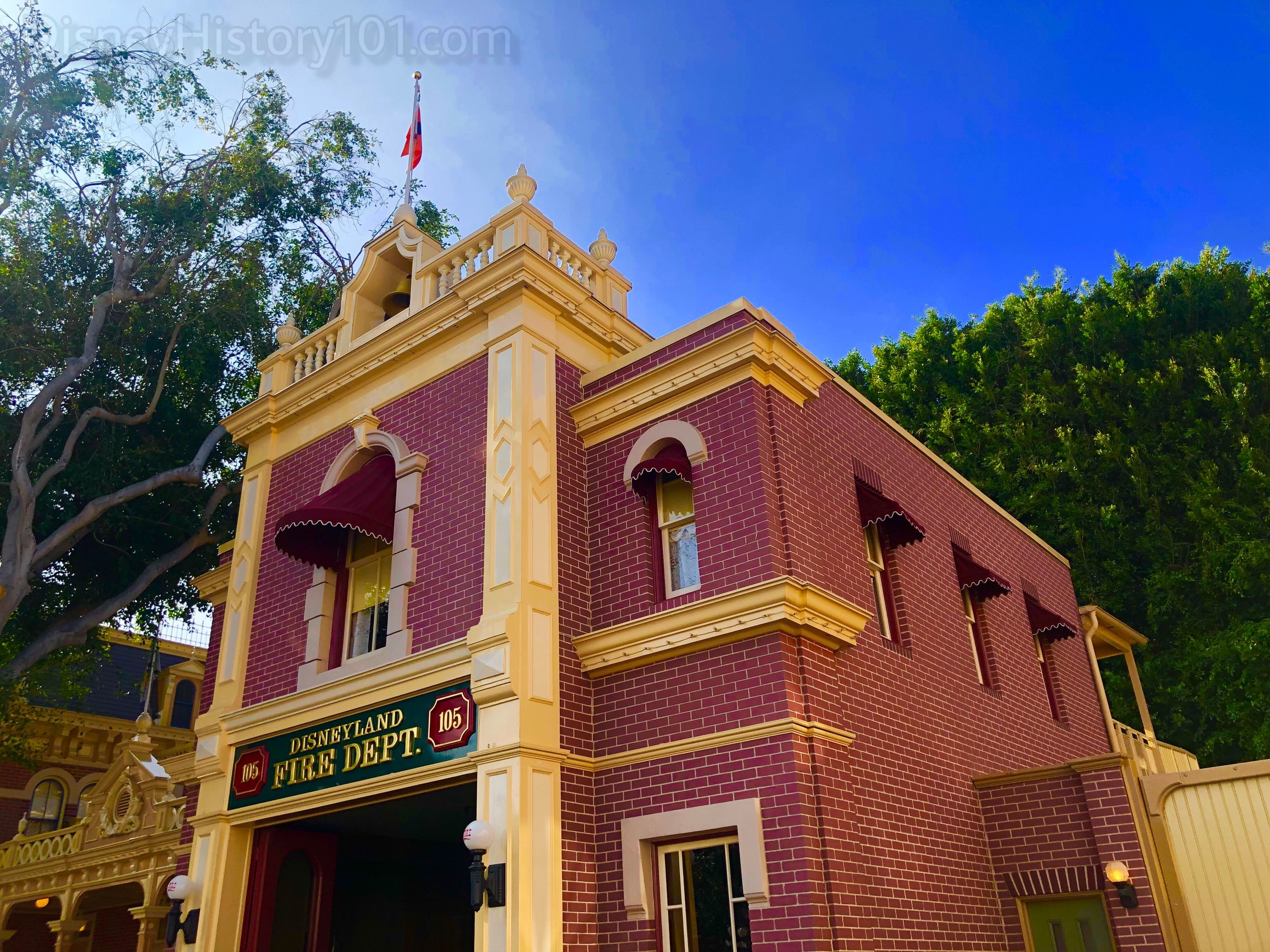
Disneyland Fire Department, 2019
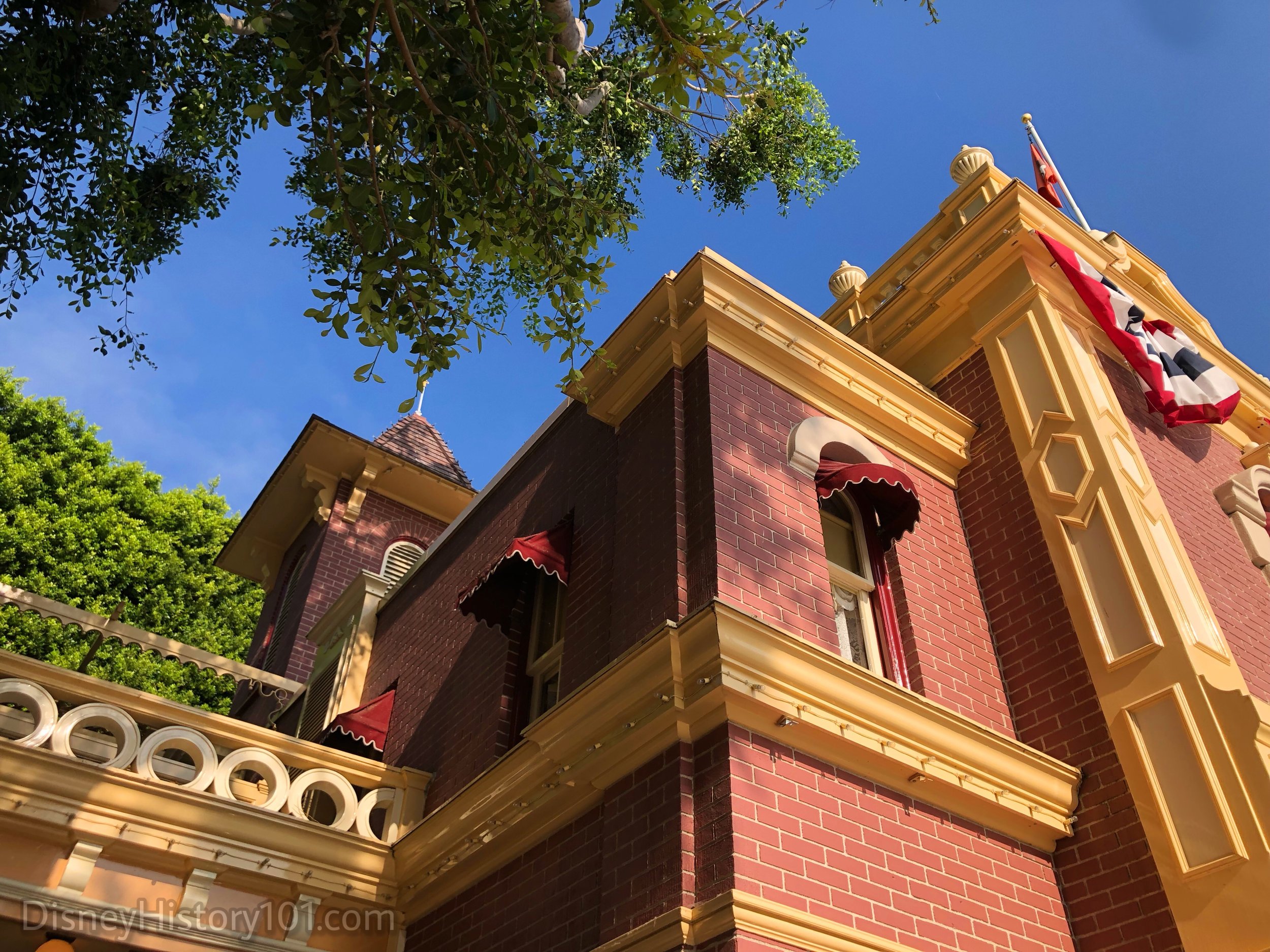
Disneyland Fire Department, 2019
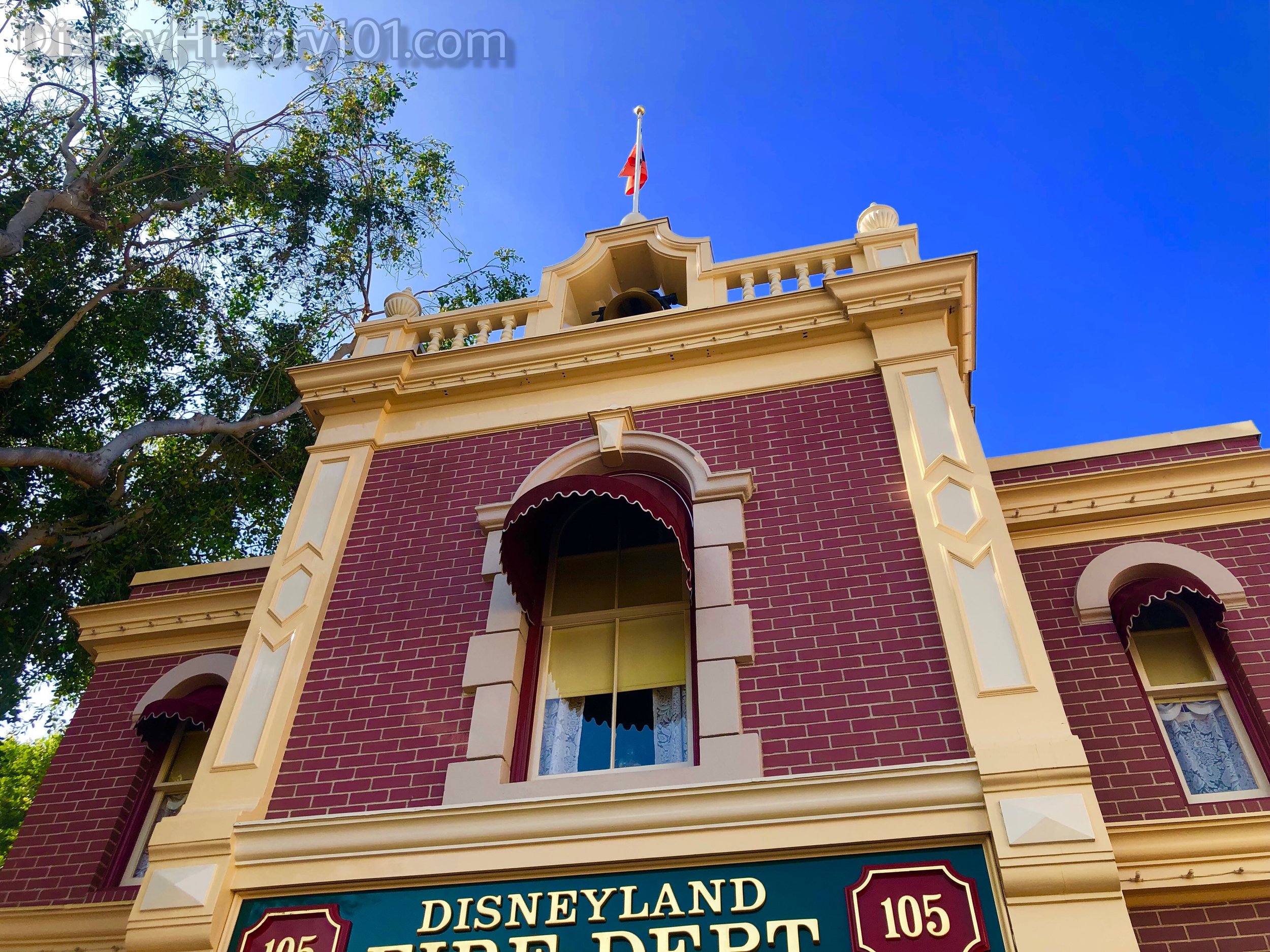
Disneyland Fire Department, 2019
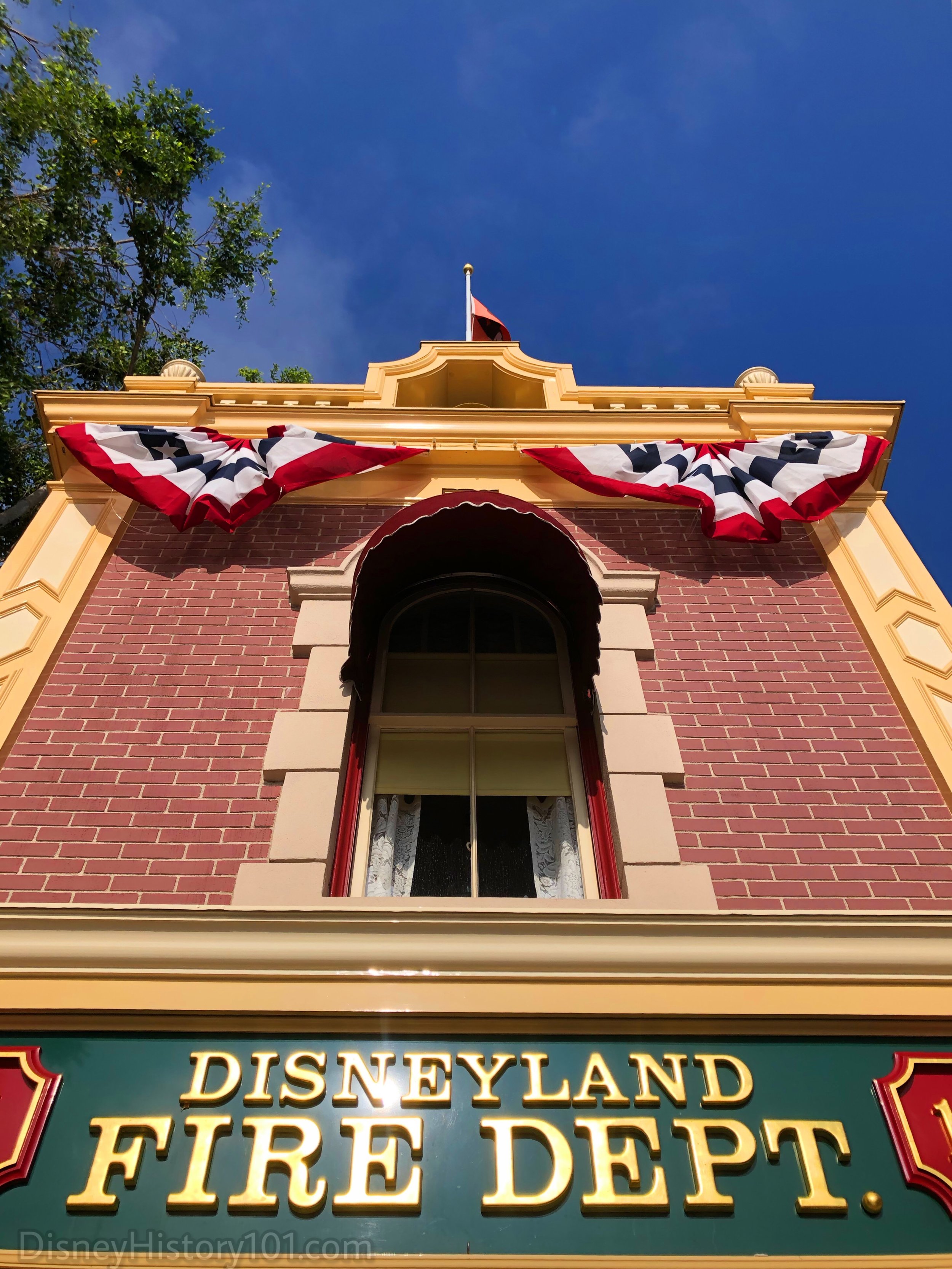
Disneyland Fire Department, 2019
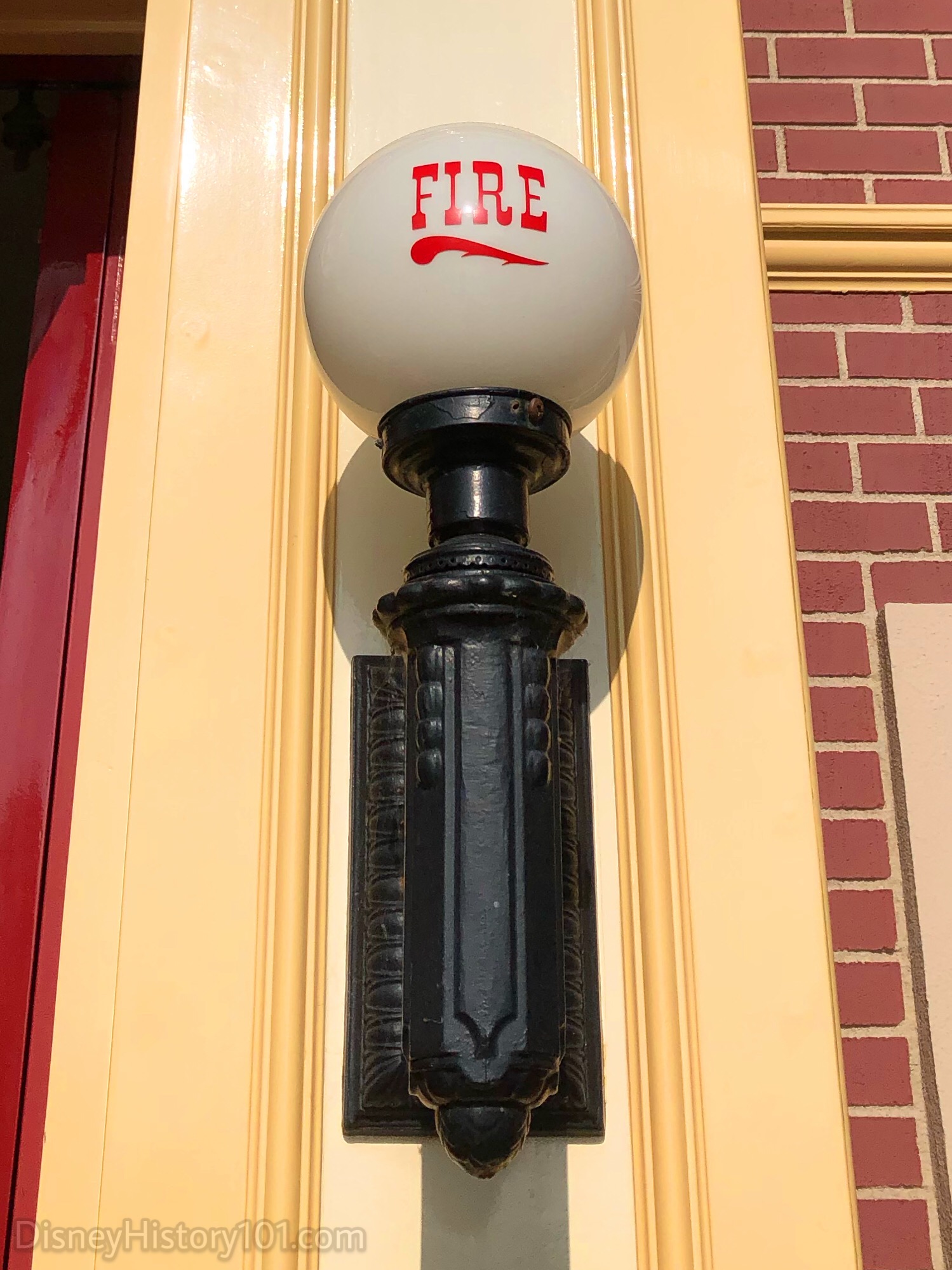
Disneyland Fire Department, 2019
The presentation of the Disneyland Fire Station show on the vast DISNEYLAND “stage” was a distinct part of the Disneyland theater concept. Character lighting was themed to the area to enhance the overall appearance and complement the interior, such as a chandelier or kerosene lamp. These add to the show, but don't necessarily create enough illumination for operation.
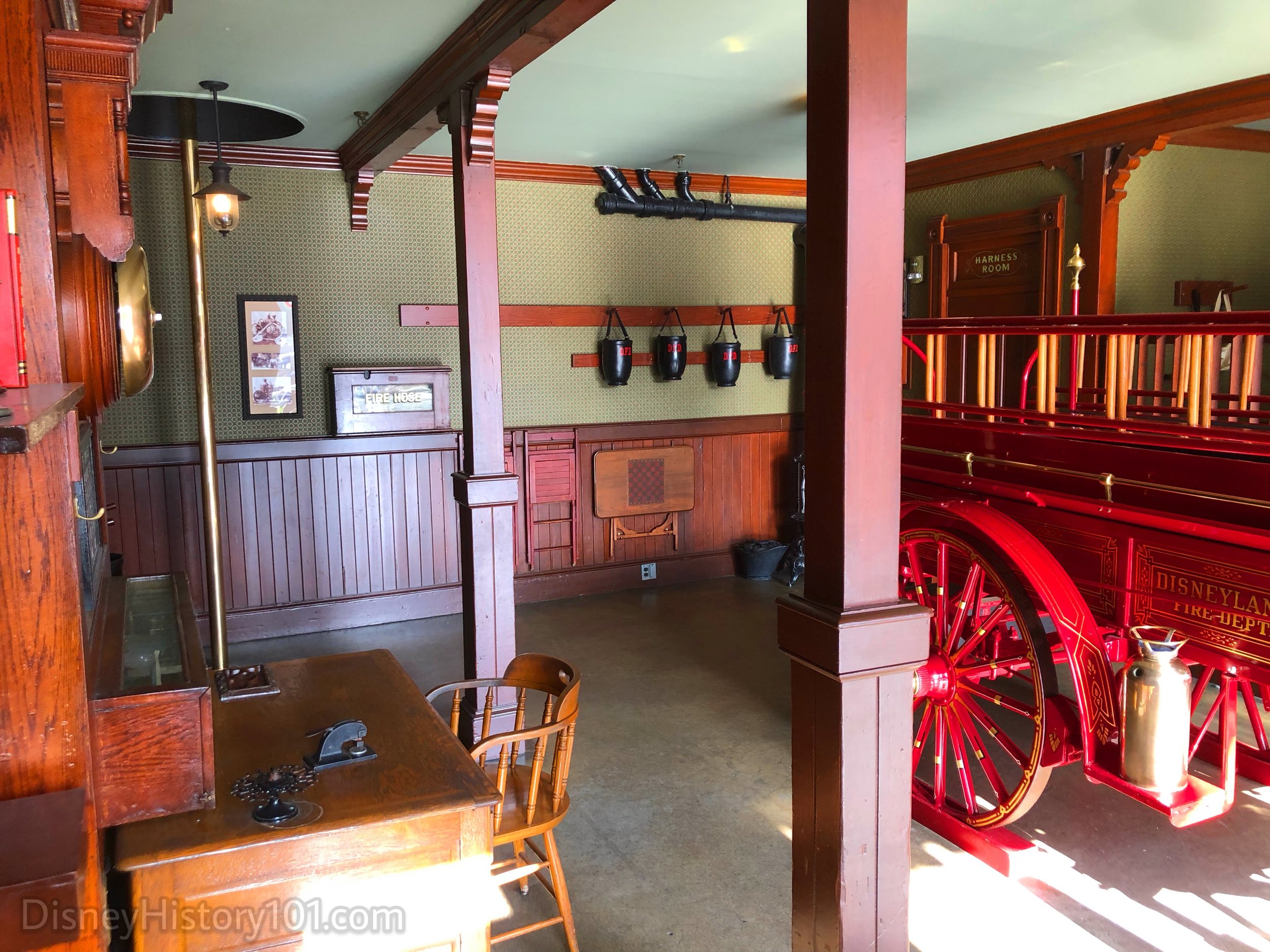
Disneyland Fire Department, 2019
Regarding most any project pursued, Walt Disney once said: “We have always tried to be guided by the basic idea that, in the discovery of knowledge, there is great entertainment as, conversely, in all good entertainment there is always some grain of wisdom, humanity, or enlightenment to be gained.” While fewer current Disneyland attractions embody the spirit of those words, the story was far different in the beginning, as the Firehouse itself was full of quite a few genuine antiques.
The first “Disneyland Dictionary” (printed October 1959) mentioned that the Insurance Company of North America Companies Exhibit: “Has display of actual antiques; Fire Hats, Water Bucket and axes used at the turn of the Century, as well as model fire fighting apparatus used during this period.”
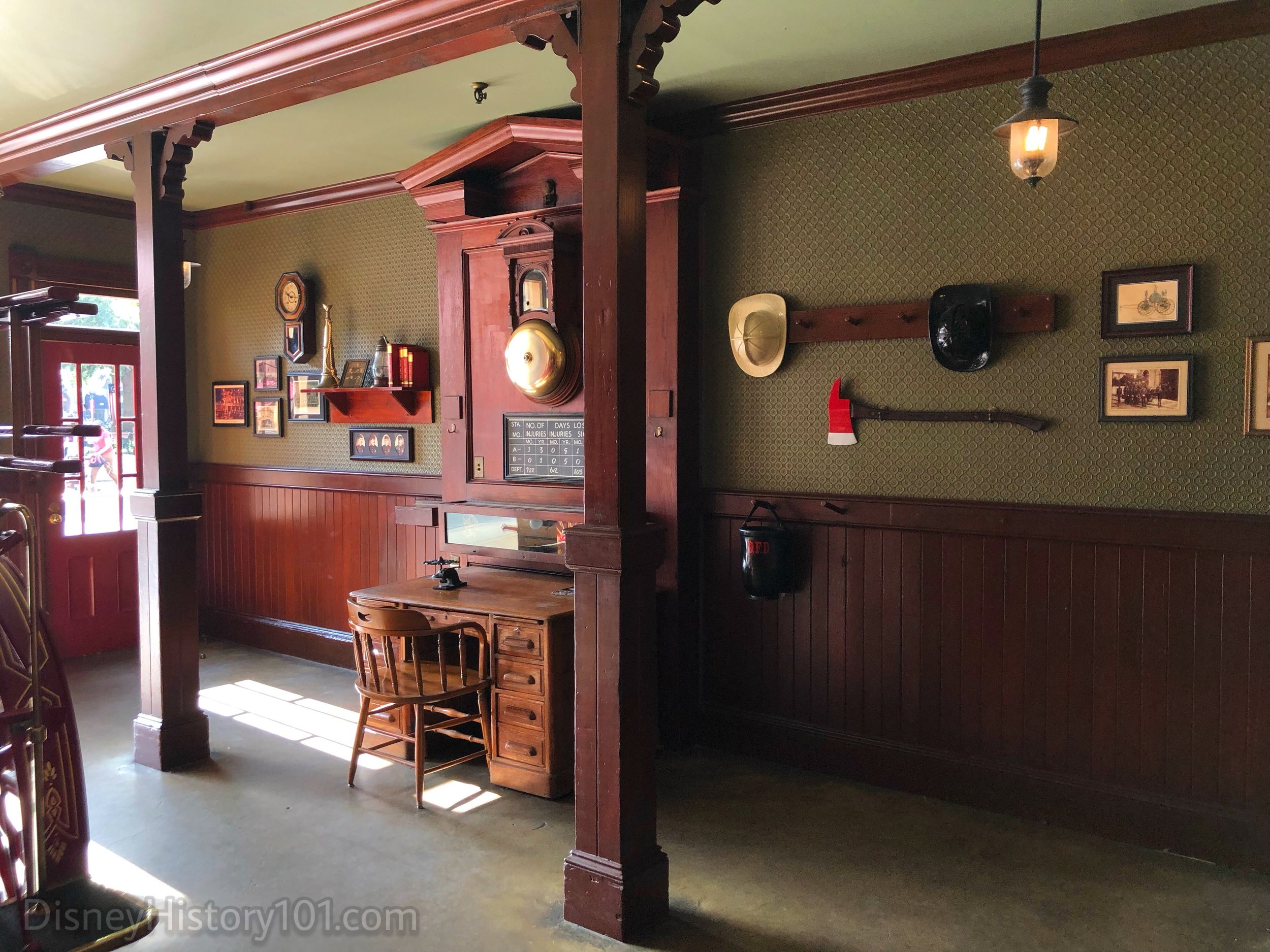
Disneyland Fire Department, 2019
The fire hats, flathead axes, and other props are authentic, verified by “Did You Know” (published by Disneyland in 1991).

Disneyland Fire Department Fire Alarm Exhibit, 2019
Above the desk, you’ll notice a rarely-seen c. 1860-1861 antique electric Gamewell Fire Alarm Telegraph Co. Firehouse Gong with a beautiful oak case. The bell alone is 12 inches in diameter. “The magnetic electric fire alarm gong which is part of the Main Street Fire House… works on the same principle as the old telegraphic key, and was first used in Boston in 1851. The hunt for this was begun at the obvious place - the fire department. However, none was available in the local area, and Disney searchers were referred to an individual collector, who agreed in part with the gong only after hearing the story,” according to “The Disneyland News” (Vol.1 - No.2 ; August, 1955). According to “Did You Know” (published by Disneyland in 1991), “the elaborate Alarm System is [sic]… also authentic… the Fire Alarm System was purchased from the City of Los Angeles.”
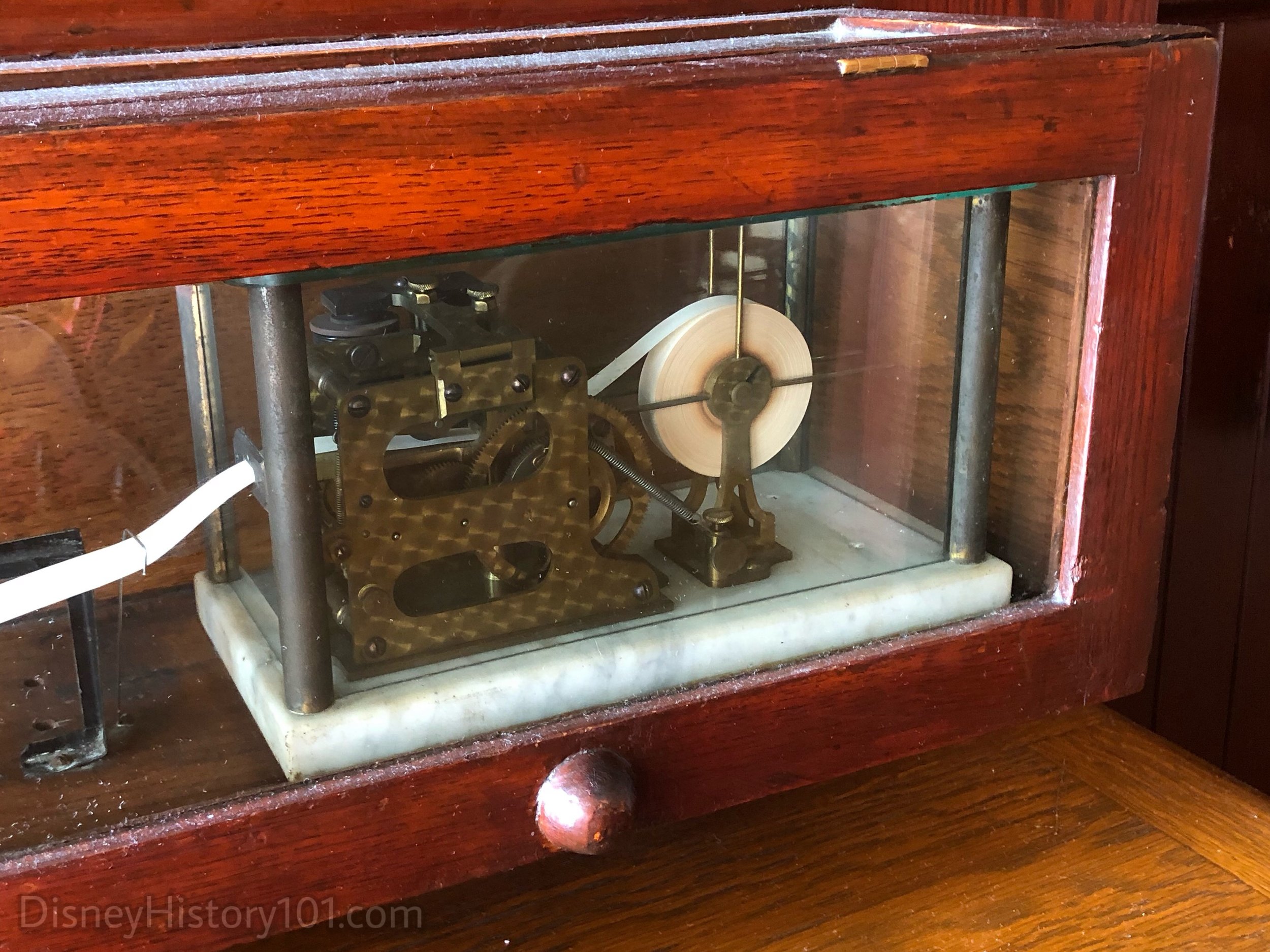
Disneyland Fire Department Fire Alarm Ticker Tape Machine Exhibit, 2019
Below (on the desk), is a Fire Alarm Ticker Tape Machine, that would print the location of the Fire Box that was used to telephone the emergency. Just a handful of United States firehouses had one of these machines around 1880, and all of them were located in major cities.
The authentic recreation of the Disneyland Fire House also holds Horse Stalls. “Each horse is named,” according to “Main Street Vehicles”, published 1966 by Disney University. You may recall hearing of George (born at Walt Disney Studios, before Disneyland was completed), or “Atom the Burro” (Disneyland’s first citizen, “born on the Magic Kingdom’s Pony Farm”). Since Disneyland began its first day of operation, each horse would clock “in and out when he works,” including Bess and Jess.
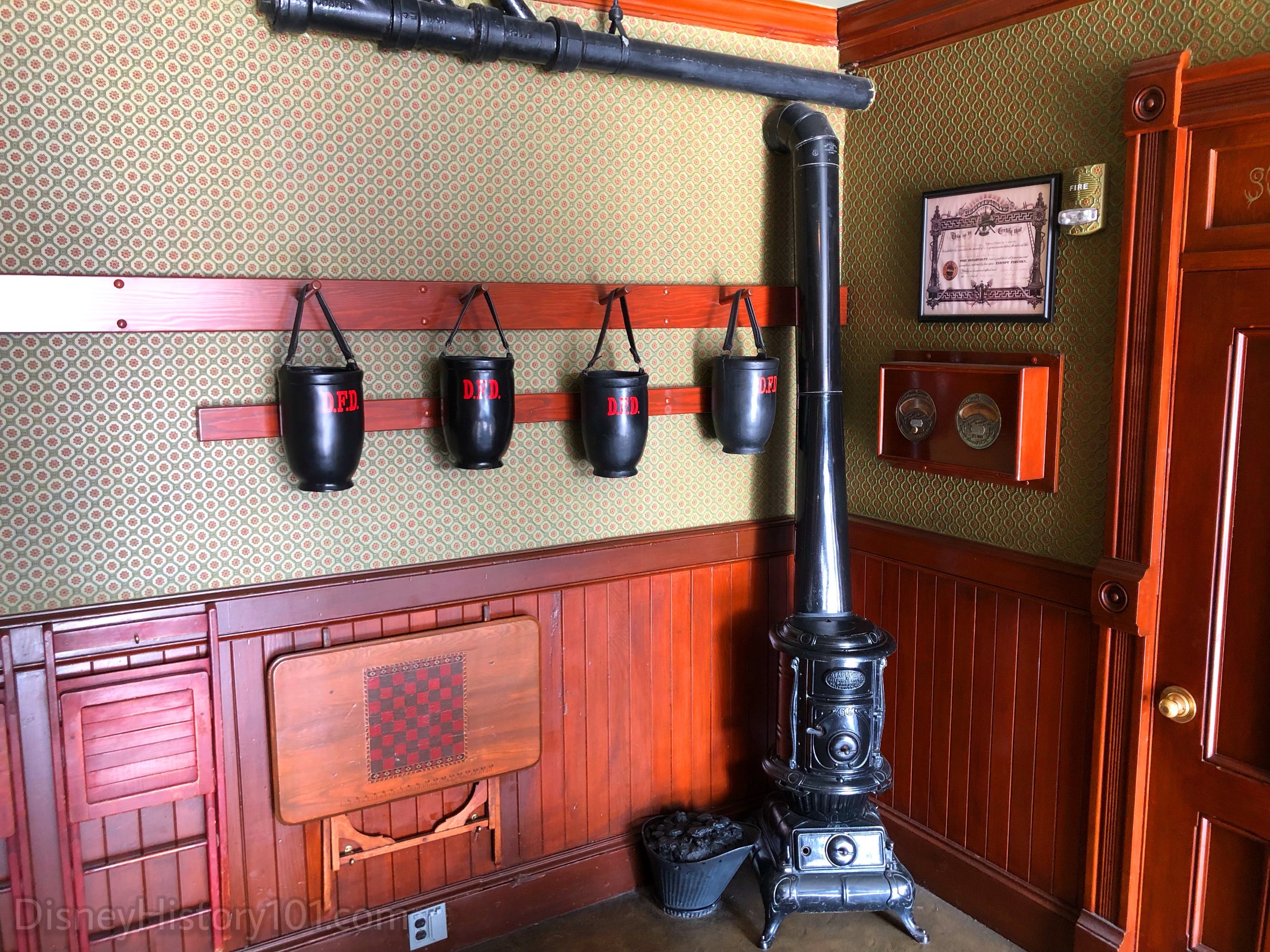
Disneyland Fire Department, 2019
The present exhibit attempts to capture the feel of the early exhibit, with Fire Hats, Water Bucket and axes similar to those used at the turn of the Century. The former Walt Disney Imagineering Principal Creative Executive Marty Sklar would probably agree that the small details like these make the story appealing.
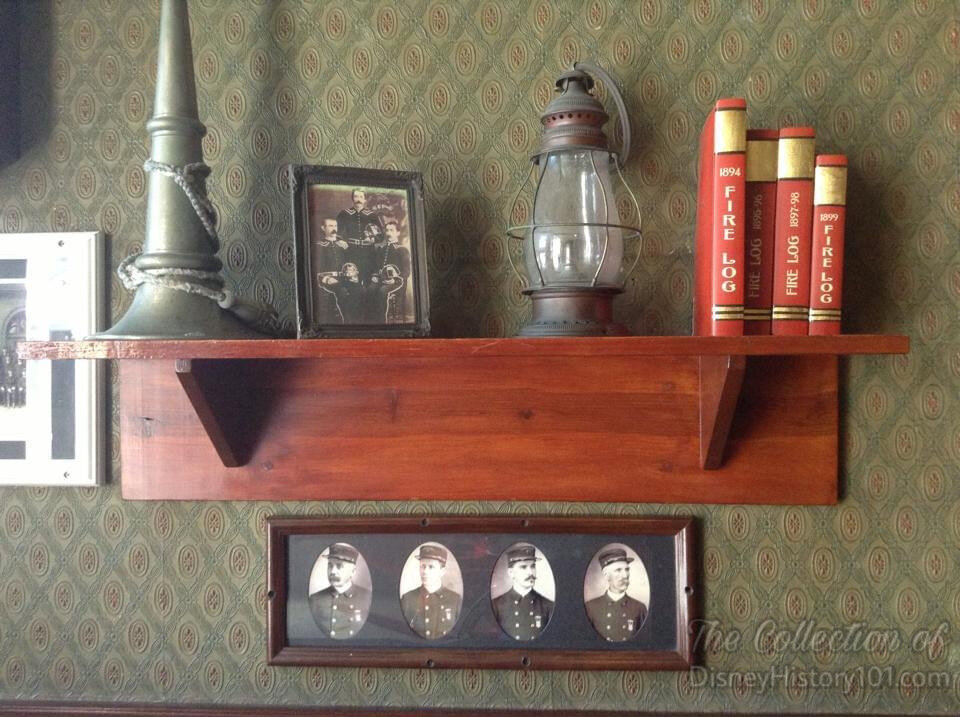
Disneyland Fire Department Exhibit, 2019
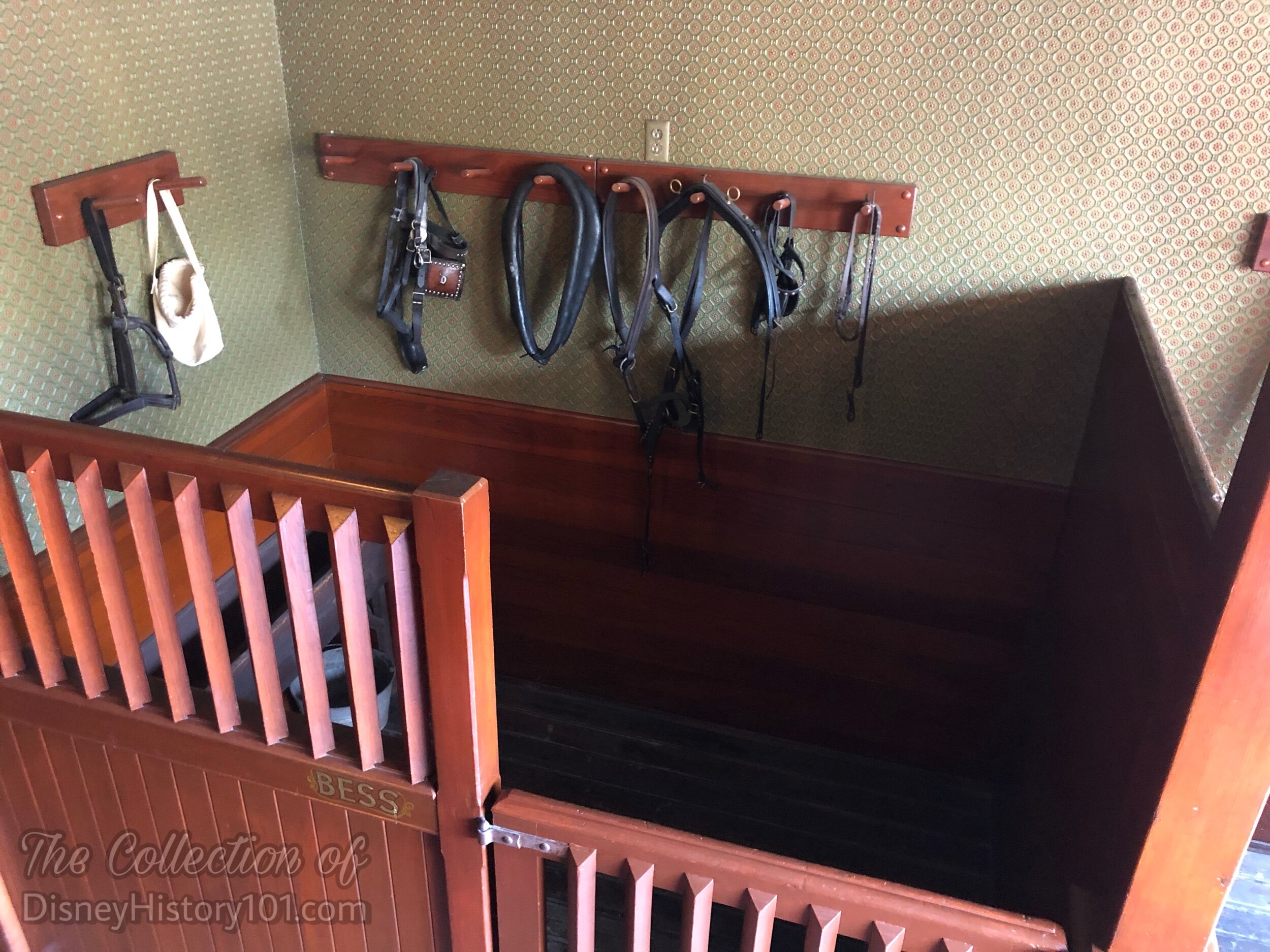
Bess Horse Stall
You’ll note a variety of horse tack props (like the Brow Bands with Disneyland “D” monogram) similar in fashion to the kind used specifically by the horses that pulled the Chemical Wagon.
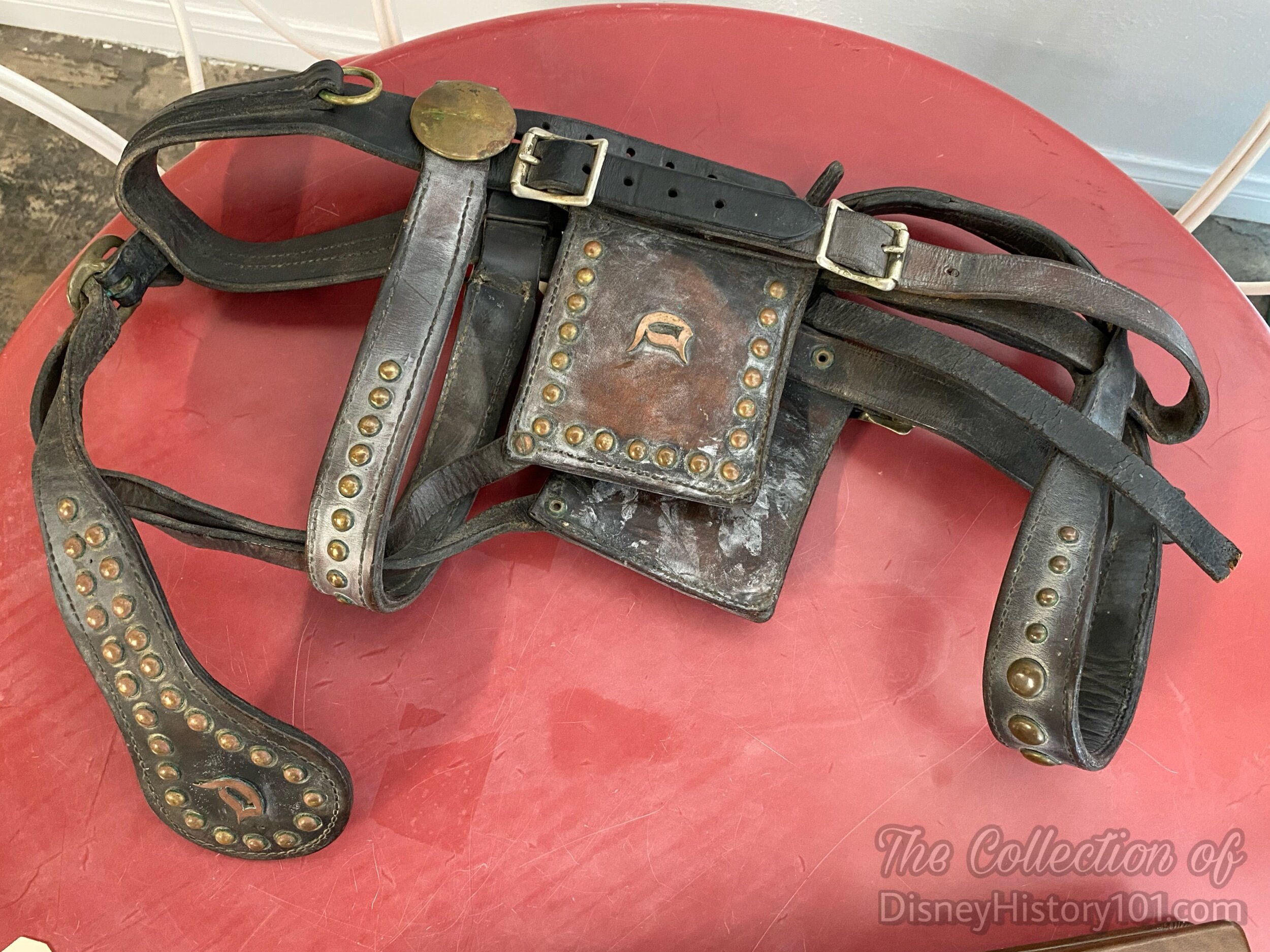
Disneyland Horse Brow Band
Much of Disneyland’s original equestrian gear was created by hand, under the direction of Owen Pope and his apprentices. Here, we see one of the Main Street Horse Brow Bands, which fits over the horse’s head. These were never used by the horses in Frontierland (as those that pulled the Stage Coaches, or the Conestoga Wagons). These Brow Bands were made specifically for the Percheron, Belgian, and Clydesdale horses that pulled the Main Street vehicles (the Surreys, and Hose and Chemical Wagon, included)! Brow Bands like these were also used by the “scaled-down” Hackney and Shetland breeds used to pull the Surreys, and Hose and Chemical Wagon! To put this in perspective, Brow Bands (like the one pictured above) would have only been used by the “15 draft horses” or “16 ponies” among Disneyland’s some 189 head of horses in 1966.
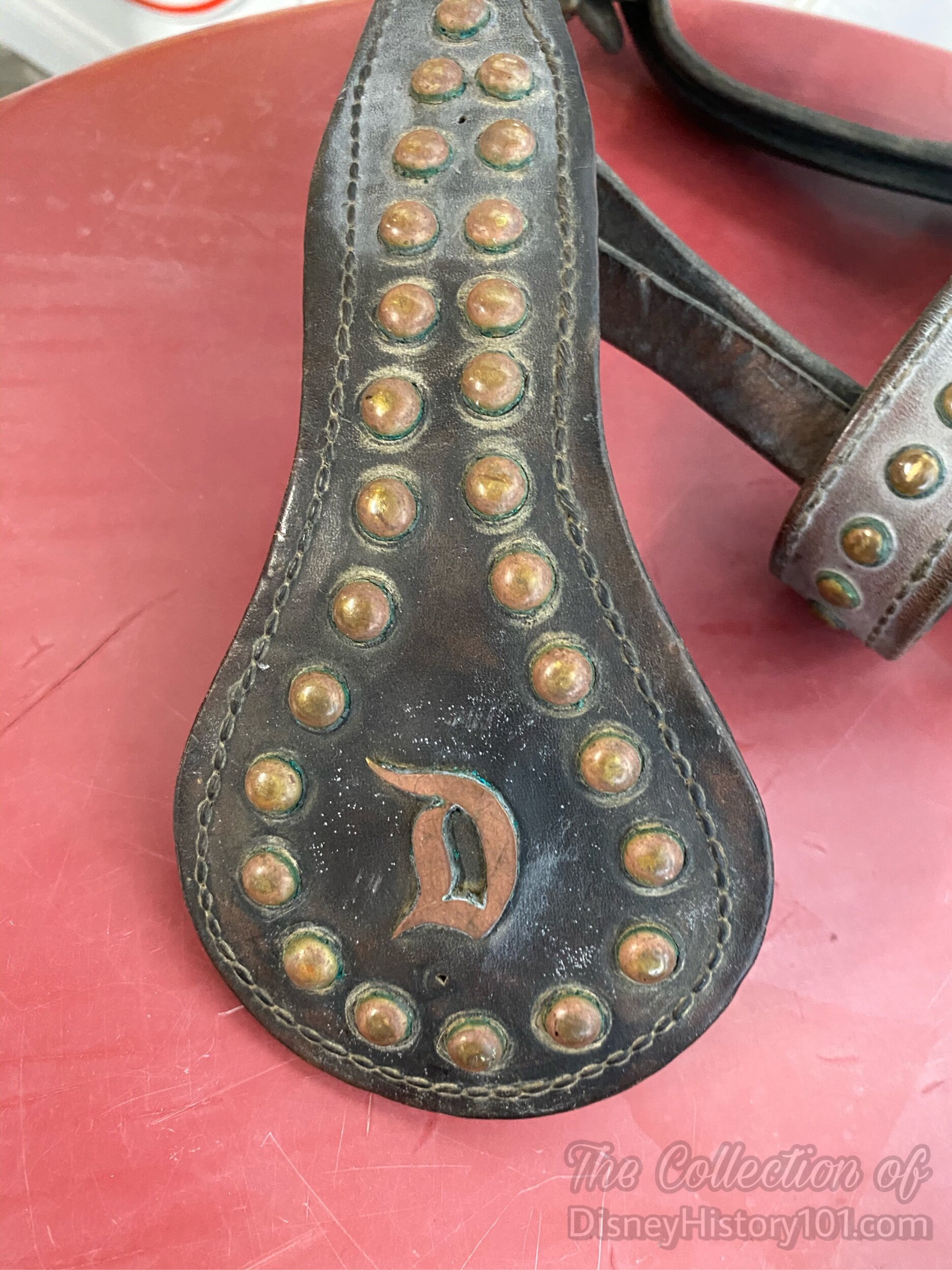
Disneyland Brow Band Face Piece
This portion of the brow band (with the “D” surrounded by bosses) is centered on the front of the horse’s head, between the eyes.
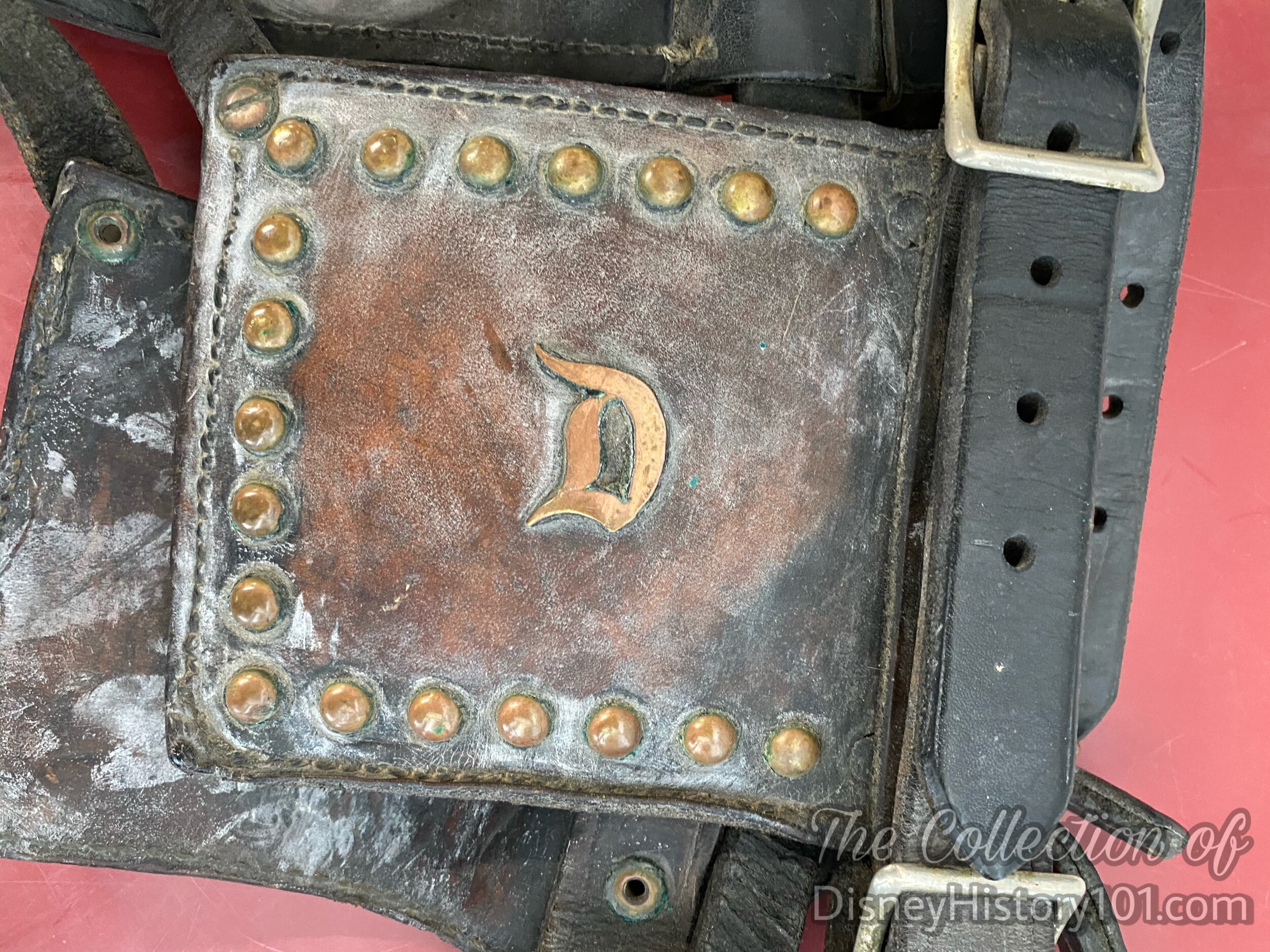
Disneyland Brow Band Blinker with Disneyland “D”
The blinker traditionally holds the owner’s monogram or initials. In this case, the Disneyland “D” was originally placed on blinkers of the Disneyland Main Street Horse brow bands.
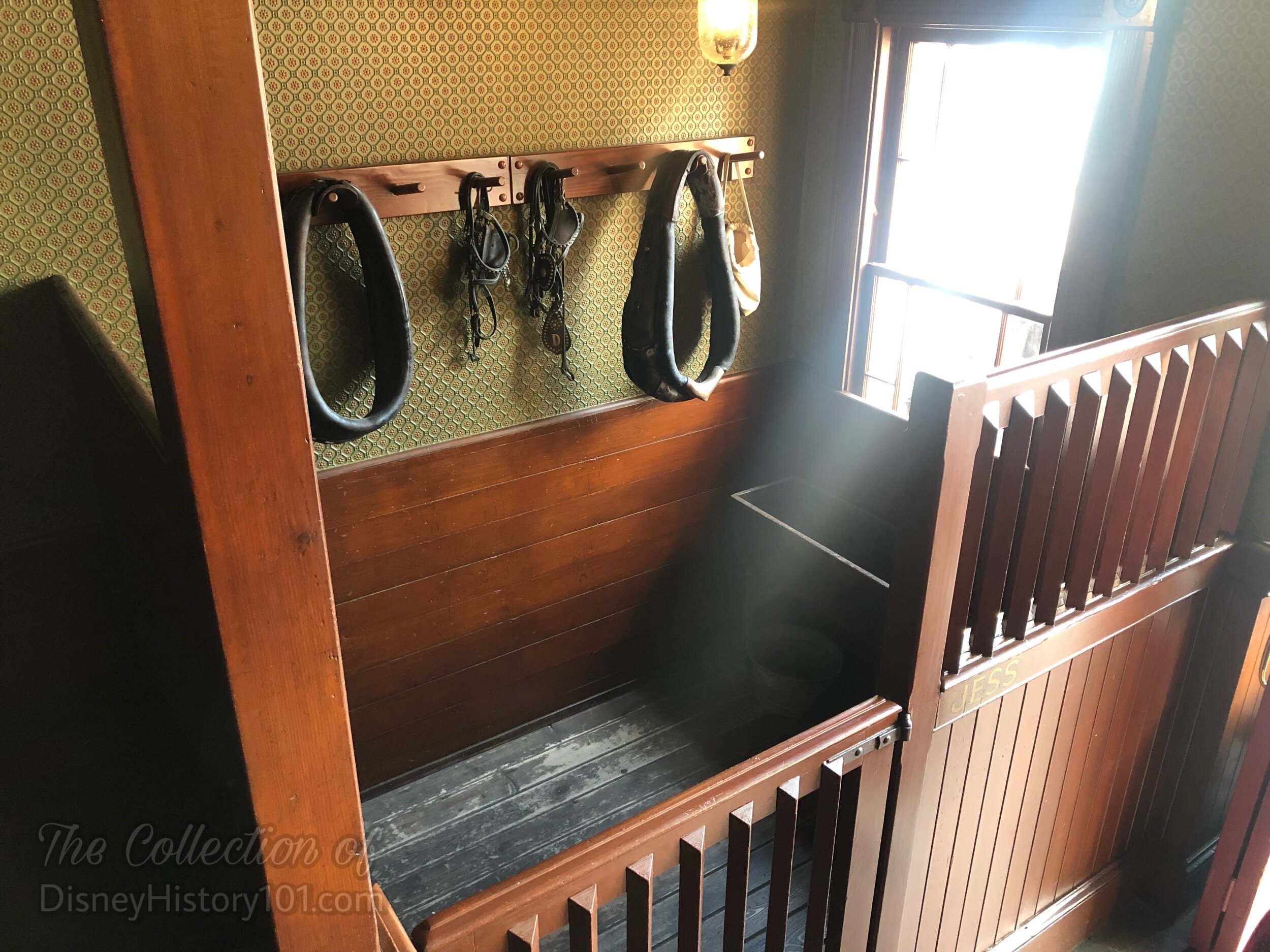
Jess Horse Stall
As to one particular reason for names, Van Arsdale France once wrote: “Since the horses were not directly on the payroll, they had to be carried as assets. All were given names. They all received names of people in accounting. Lucy Cotton, for example had a mule on the records named, ‘Lucy Mule.’”
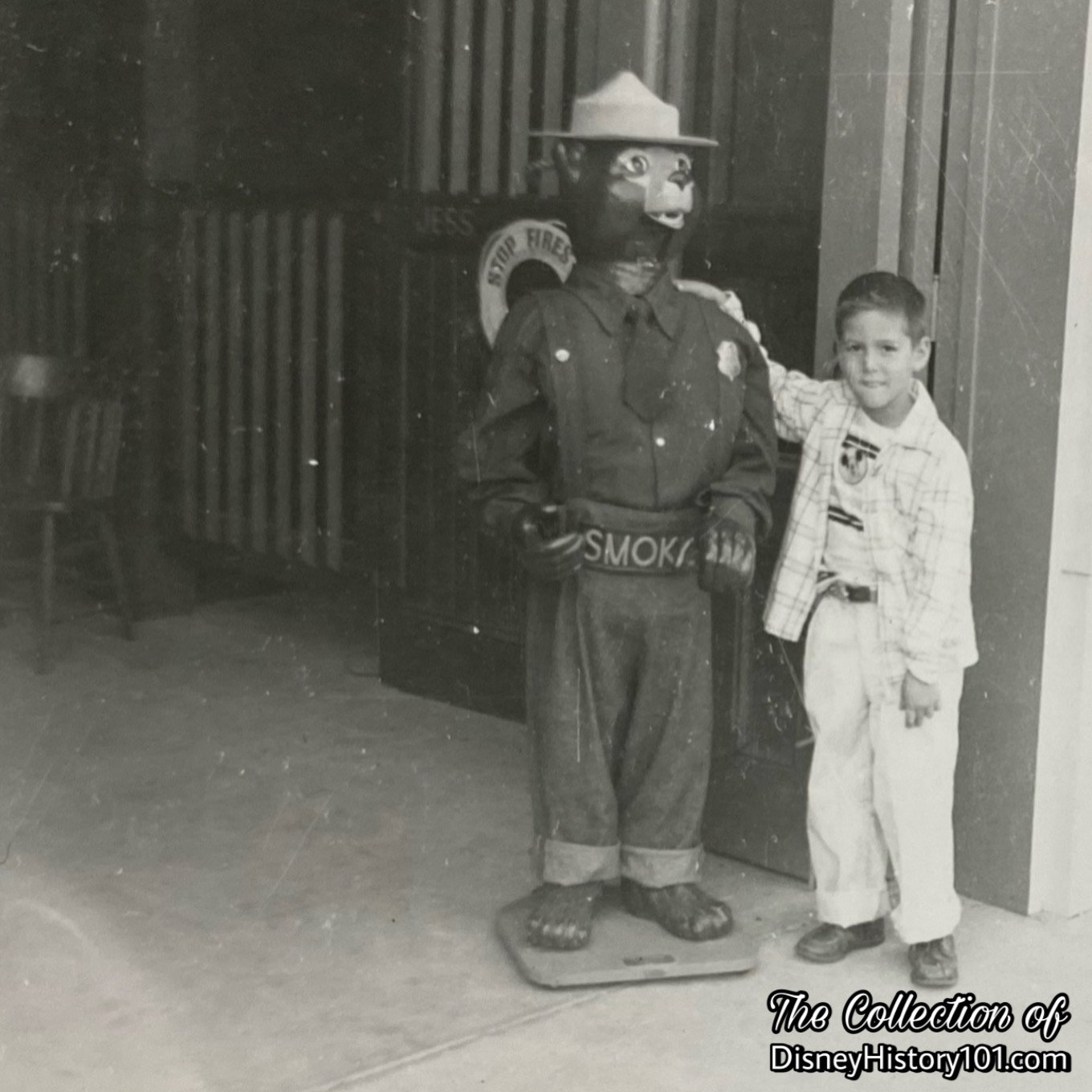
Smoky the Bear at Disneyland.
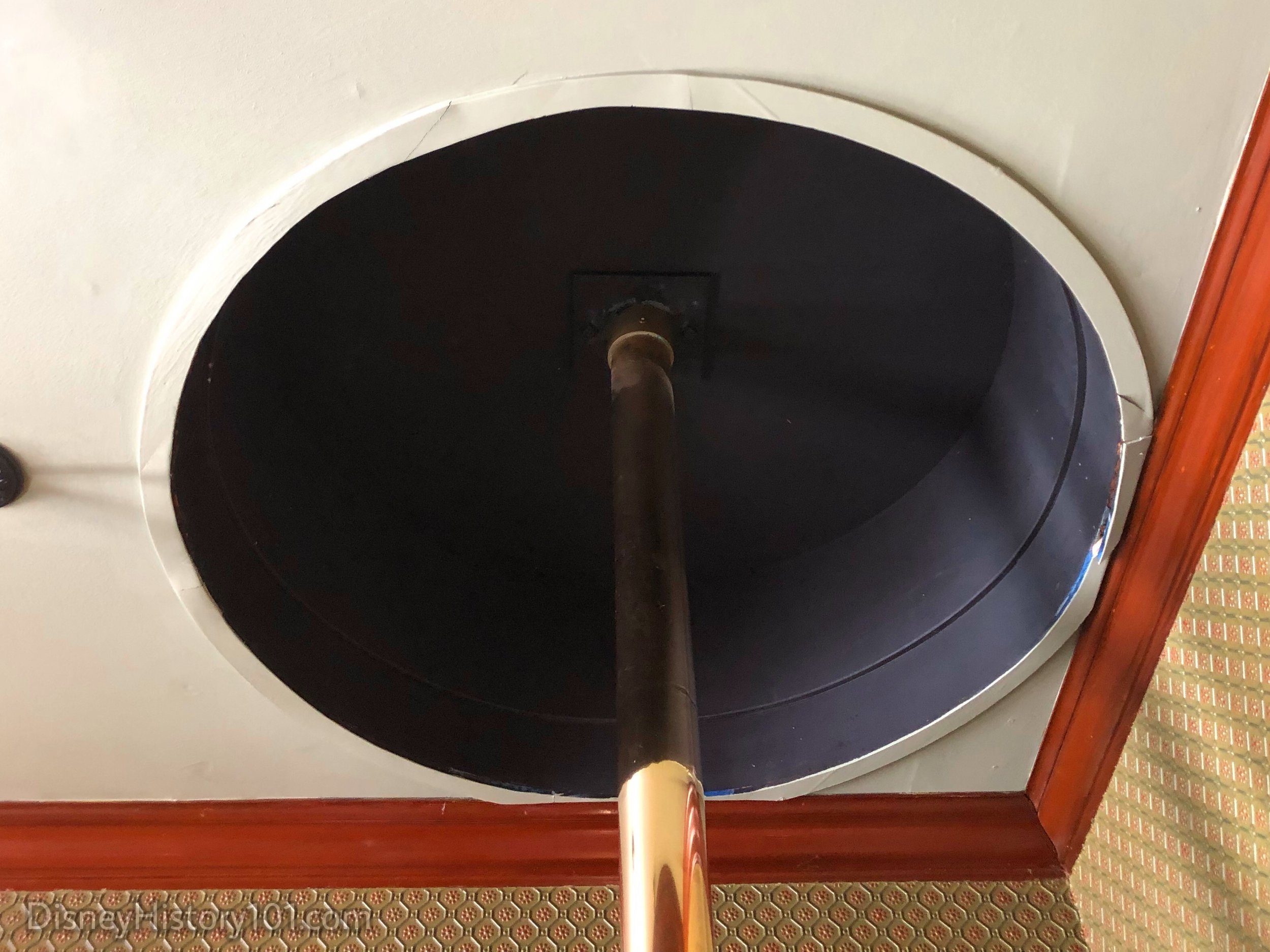
The Authentic Fireman’s Brass Pole.
Many wonder if Walt ever slid down the authentic Fireman’s Pole. According to Diane Disney’s own words, “I’m sure he didn’t.” However, visitors (like Fess Parker and Buddy Ebsen) occasionally did slide down the Fireman’s Pole. [see “Diane Disney Remembers Dad : Walt’s Secret Disneyland Apartment” by Jordan Zakarin, Huffington Post, February 11, 2012] On even rarer occasions, a few curious folks made their way up the pole. Diane also shared (with Michael Broggie), a story of a “small red-headed boy” who shimmied up the fire pole in order to meet her father, only to surprise Walt (who was reading nearby). Soon after, the additional means of egress was closed up.
Considering all these loyal details, it is not hard to believe why (by the year 1958), the Main Street Fire Station was one of 15 free educational shows and exhibits at Disneyland.
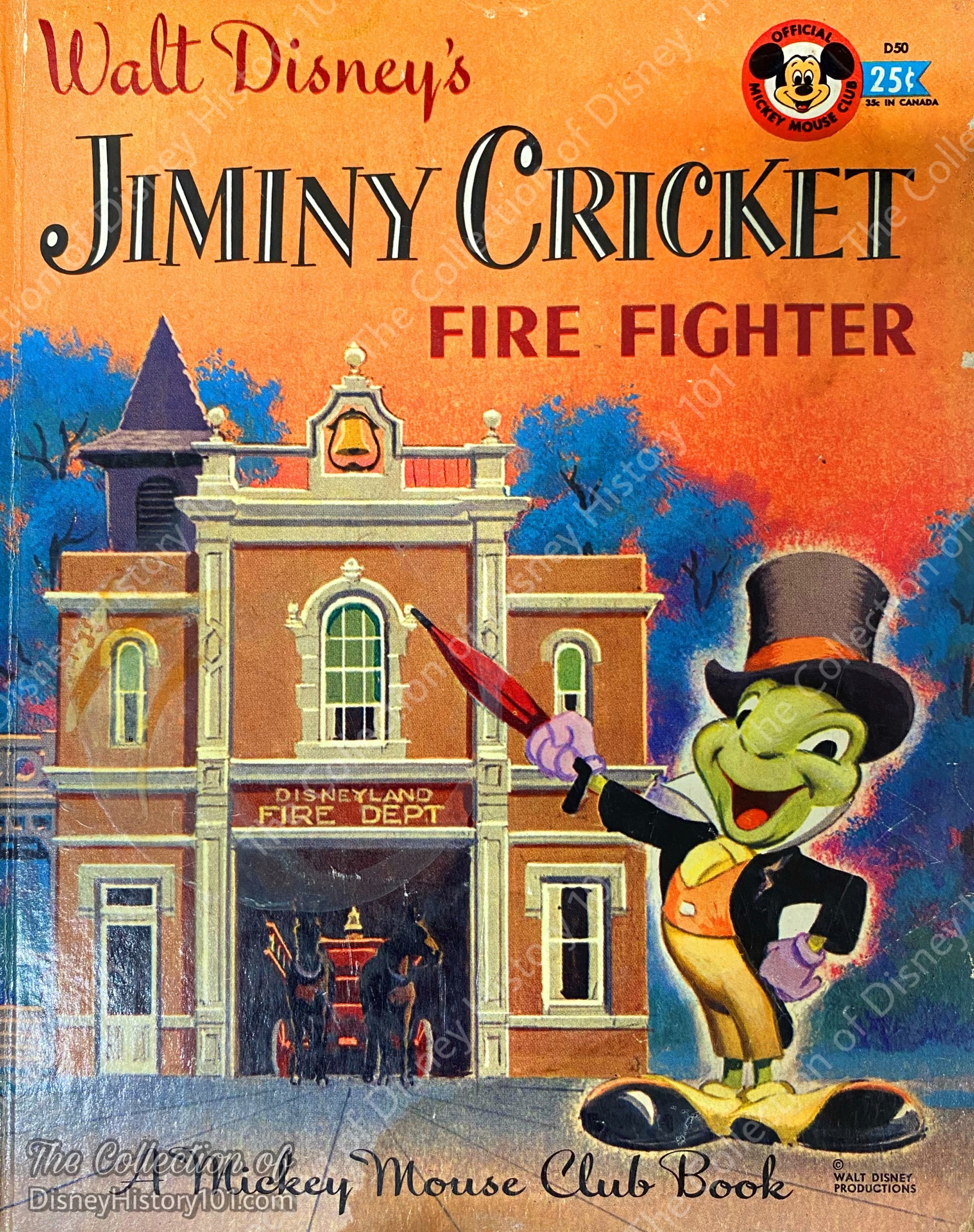
The Disneyland Fire Department also appeared in licensed merchandise. The DISNEYLAND Fire Department also appeared in licensed merchandise.
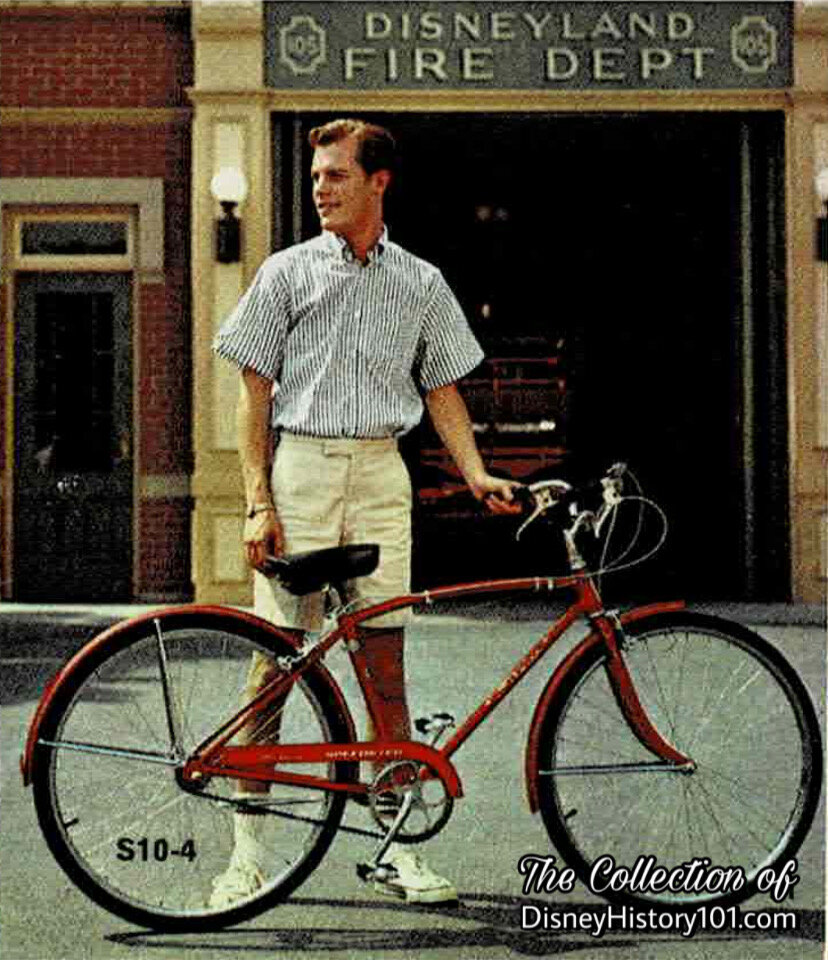
“Schwinn Takes A Trip To Disneyland” Catalogue Excerpt, (1966)
Disneyland has been utilized as a backdrop for many advertising campaigns made for television and publications (like magazines and newspapers). Photographs for the “Schwinn Takes A Trip To Disneyland” catalogue (including this one where the Disneyland Fire Station became a background for the Schwinn Speedster) were shot at Disneyland during the Disneyland Tencennial celebration of 1965.
On a rare occasion, the firehouse was home to a Hand-Crafted Bonsai Association exhibit, during “Festival Japan” (held October 12 & 13, 1985).
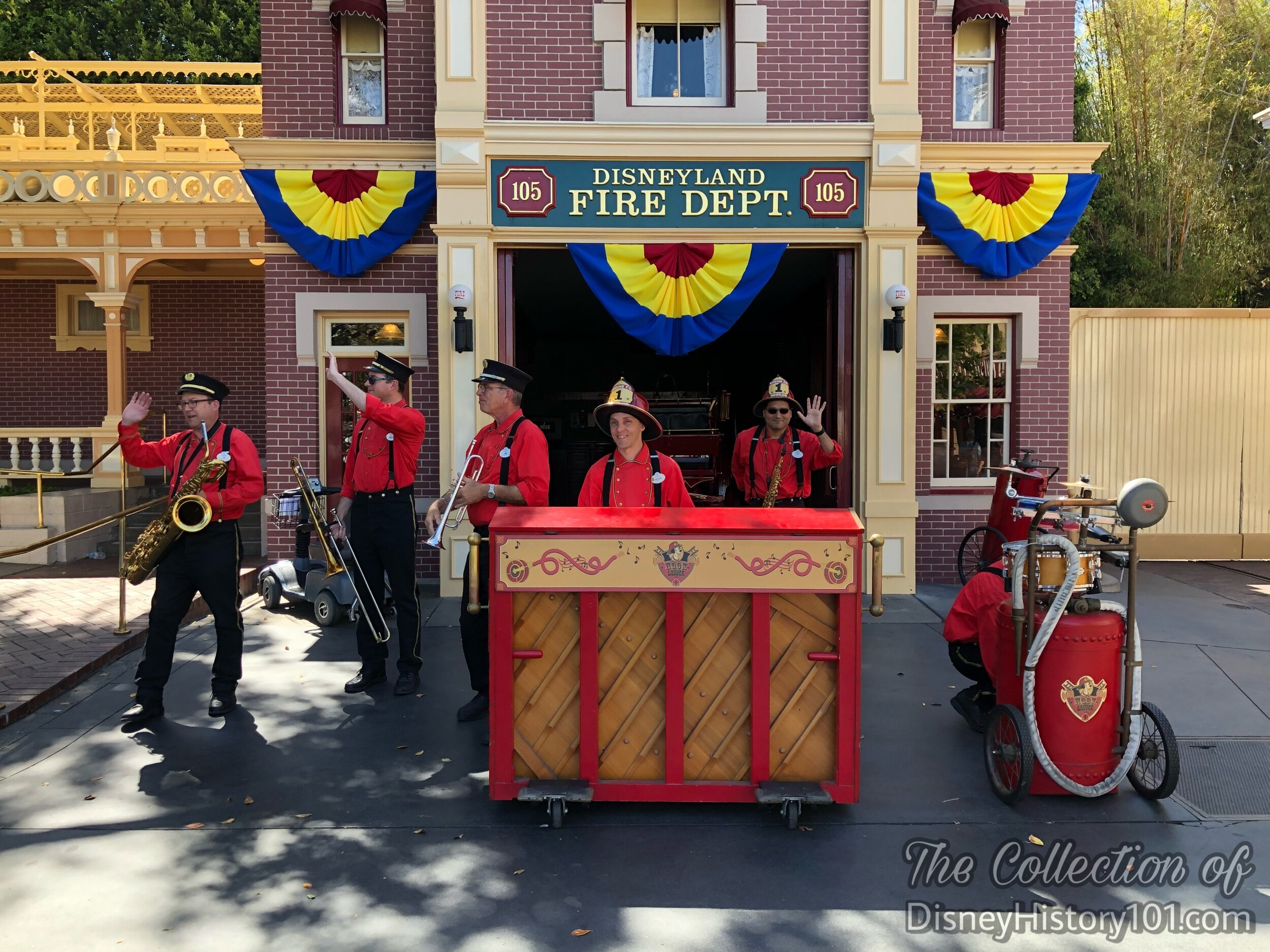
“Hook & Ladder” performing
In the present, the Disneyland Fire Department has become the Stage for “Hook & Ladder” performances. The Hook & Ladder’s entertaining sight and Dixieland sound are something reminiscent of both Ward Kimball’s Fire House Five Plus Two and the Main Street Saxophone Quintet.
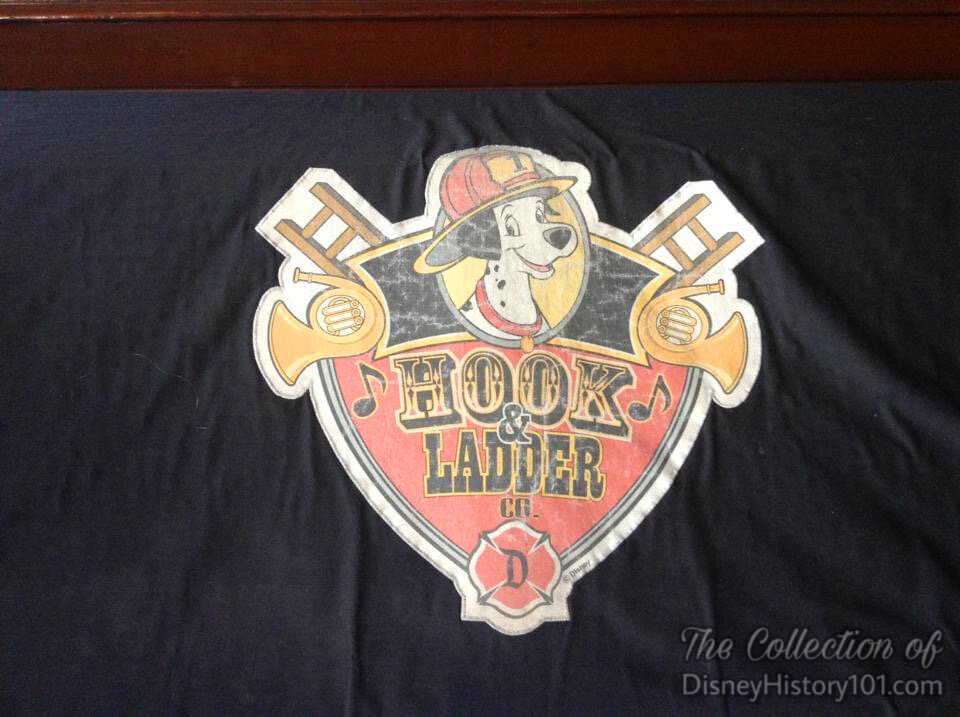
“Hook & Ladder” Equipment stored at the Disneyland Fire Department.
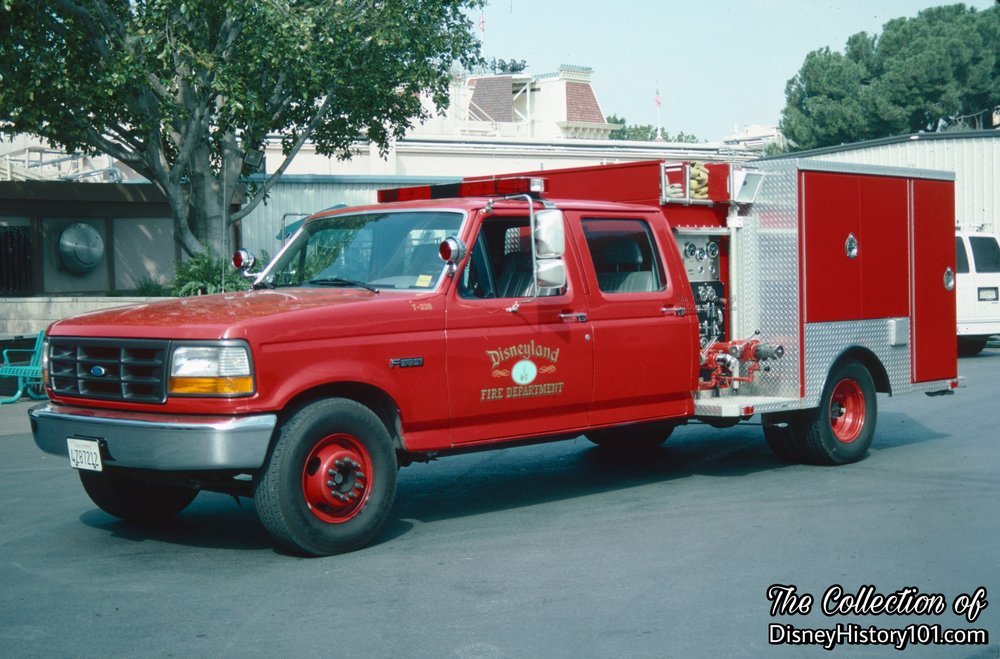
The true-life Fire Department was located Backstage behind the 700 Block, ready to respond to a code “904.”
The Disneyland Fire Department/DFD is the Resort's internal fire department. Since the beginning, Disneyland has always been serviced by on-call personnel handling true-life fire fighting equipment. When Disneyland opened, the Fire Department was under Burn's until October, 1956. At that time, it was protected and serviced by a 1954 Willys Jeep (acquired July 17, 1955). It was occasionally parked near the Fire Chief’s Office behind Great Moments with Mr. Lincoln, Backstage of Main Street East).
Then one day in 1956, Ben Meister asked Dick Galentine (of Burns) to join him as Disneyland had taken over the department. The Disneyland Fire Truck was staffed by: Chief Ben Meister, Lt. Earl Considine, and six (6) experienced firemen. By 1959, this department could be summoned during an emergency by dialing EMERGENCY call ext. 229 or Disneyland operator. By 1969-1970, the department also made use of three R.C.A. 2-way 2-frequency radios (Personalfone 150) Model # C.P. C. JIPNHTOA which were assigned to the Fire Dept. Chief. The price/unit for these was $546.00 with batteries and antenna.
Through the years, the Disneyland Company would have several cutting edge models of fire engines on reserve. Of course, these were true-life engines, not attractions for On Stage. For instance, when the Disneyland Fire Department was located Backstage behind the 700 Block (adjacent to Administration Building in the Service Area near both the Lincoln Theatre and Security) there was a 1981 Chevrolet Pierce Pumper.
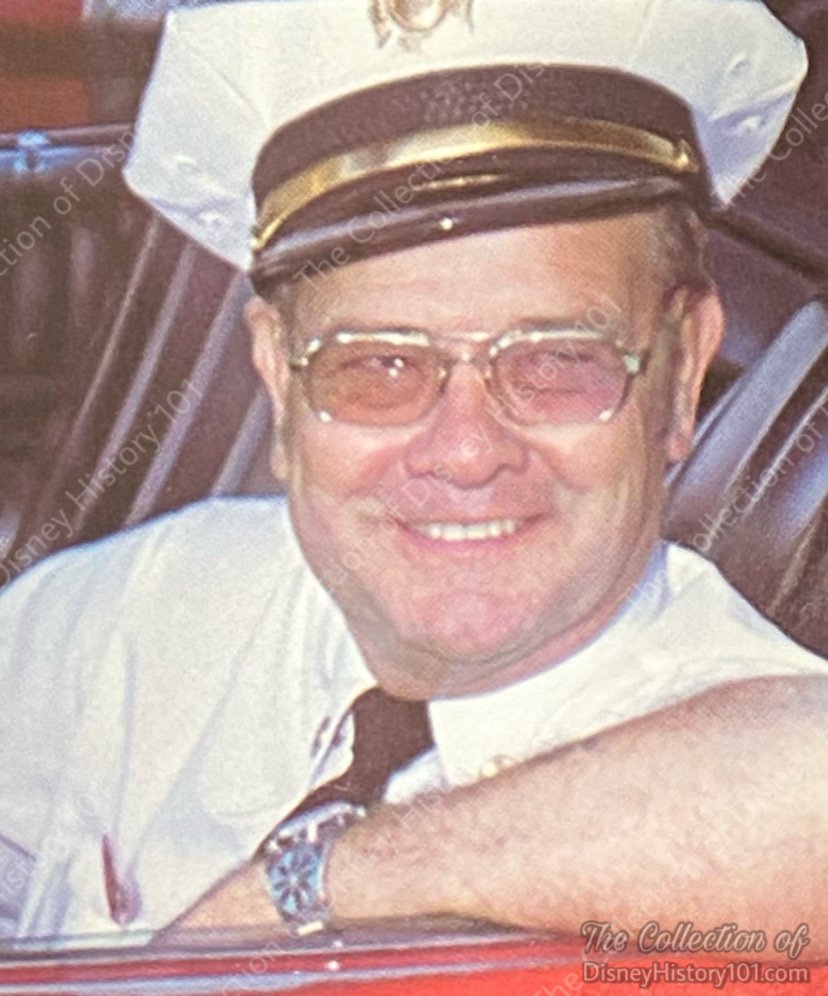
Backstage Disneyland, 1977.

As a sidelight, by October 1959, Truman Woolworth (of General Services) was overseeing the Disneyland Safety Departments (both Medical and Fire Departments).

Disneyland Fire Department Helmet, 1970s.
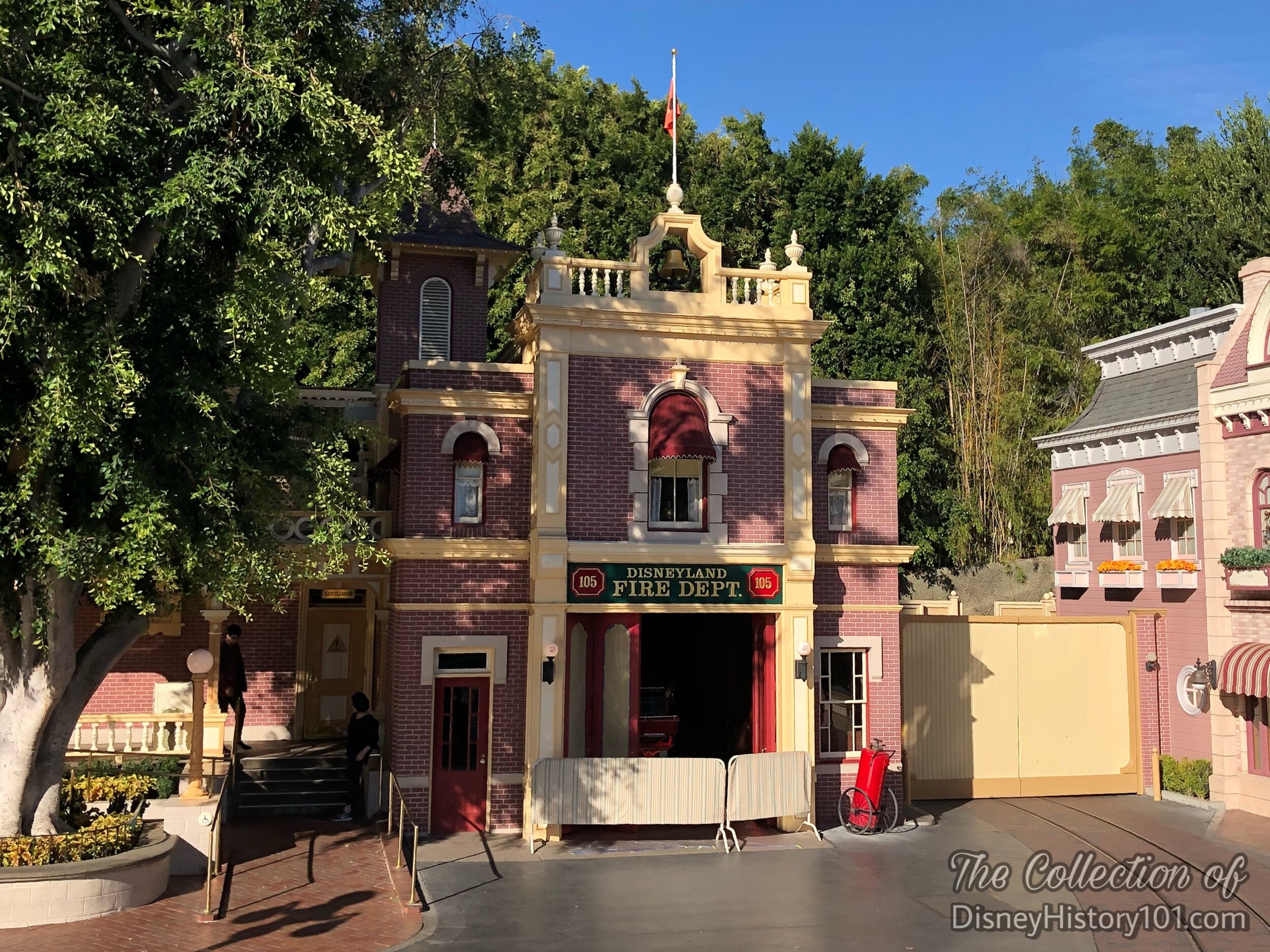
Disneyland Fire Department, 2019
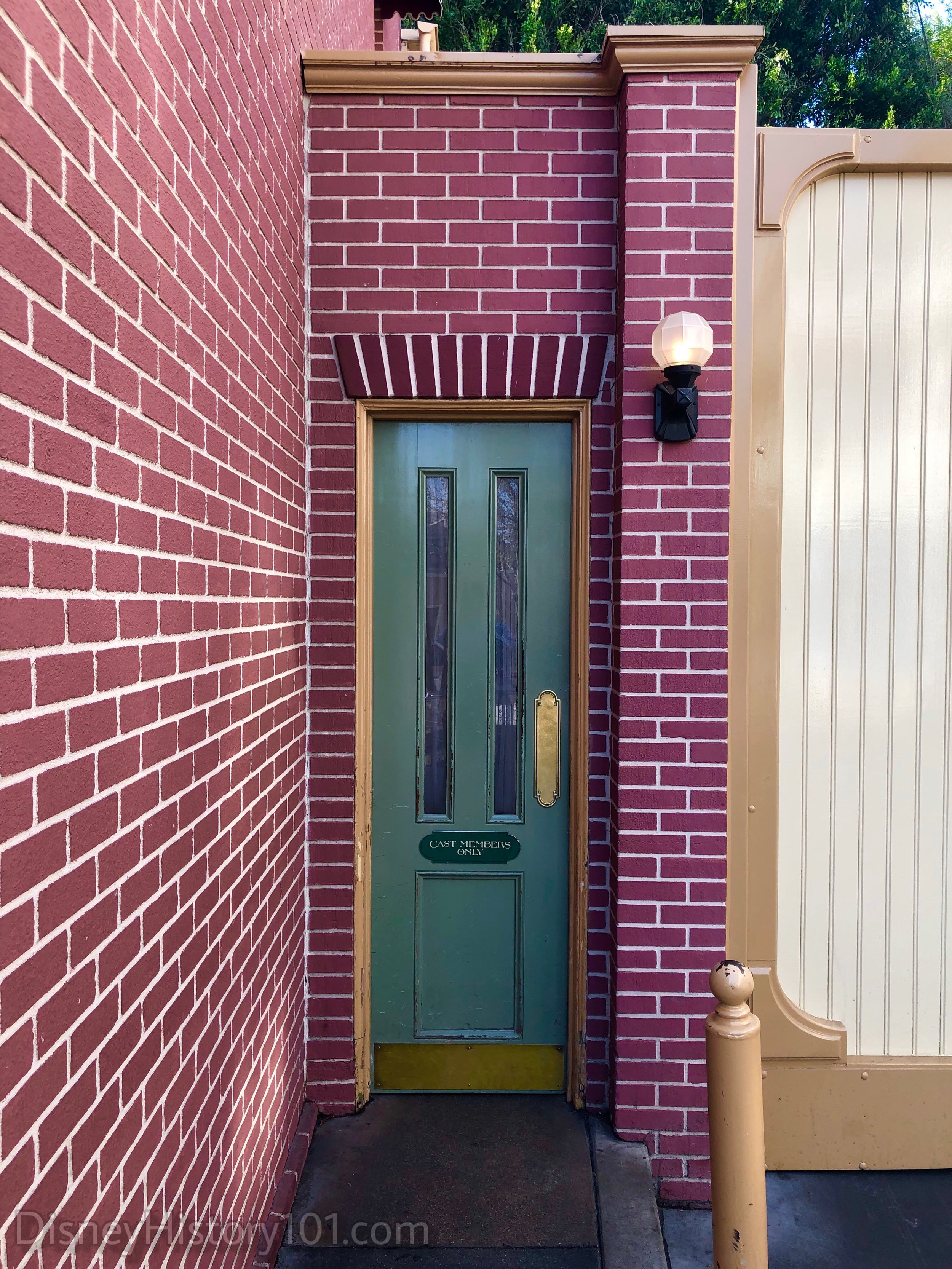
Disneyland Fire Department Pedestrian Cast Member Doorway at the Firehouse Gate, 2019
To the right is a Controlled Access Barrier (one of two in Town Square) that is part of the Park-wide Emergency Access System and the Firehouse Gate occasionally utilized for crowd control during peak periods and parades. But, most days the doors are closed to the public.

“Right above the Main Street Fire Station is one of Disneyland's best-known, ‘well kept’ secrets-Walt Disney's private apartment. The apartment was built in 1955 as a place where Walt might spend the evenings during the construction of Disneyland. Because Disneyland would be built in 257 working days and because there were no other local lodging areas at the time, the apartment was built partly out of necessity.”
“Construction”
Above the Disneyland Fire Station an efficient, small, 500-square-foot (or, 675 square feet according to one 1958 appraisal) apartment was built, to house a living space room, kitchen, closet, and a 3/4 bathroom. The 3/4 bathroom was a tiny area, complete with a working shower. The shower had four showerheads. There are a couple of theories behind this. The most likely theory is that it was just a luxury Walt had installed for the sake of having it.
The interior of the apartment had carpeted floors, plaster board, paint and paper walls and ceilings. These were serviced by an air conditioning system and possessed complete fire sprinkling systems. All fixtures were placed in their correct motif and many light fixtures of Disneyland were authentic antiques.
“Décor and Furnishings”
The original décor of the apartment was a joint effort between Mrs. Disney and the set designer for Mary Poppins, Emile Kuri. The theme was Victorian. Representative elements of the theme included rose and green colors and the repetition of the rose motif.
There were two sofas which were actually hide-a-beds; one for Walt, and one for his wife, Lillian. Each bed used to have portraits of Walt and Lillian's mothers above their respective beds, so there was no late night confusion over who slept in which bed.
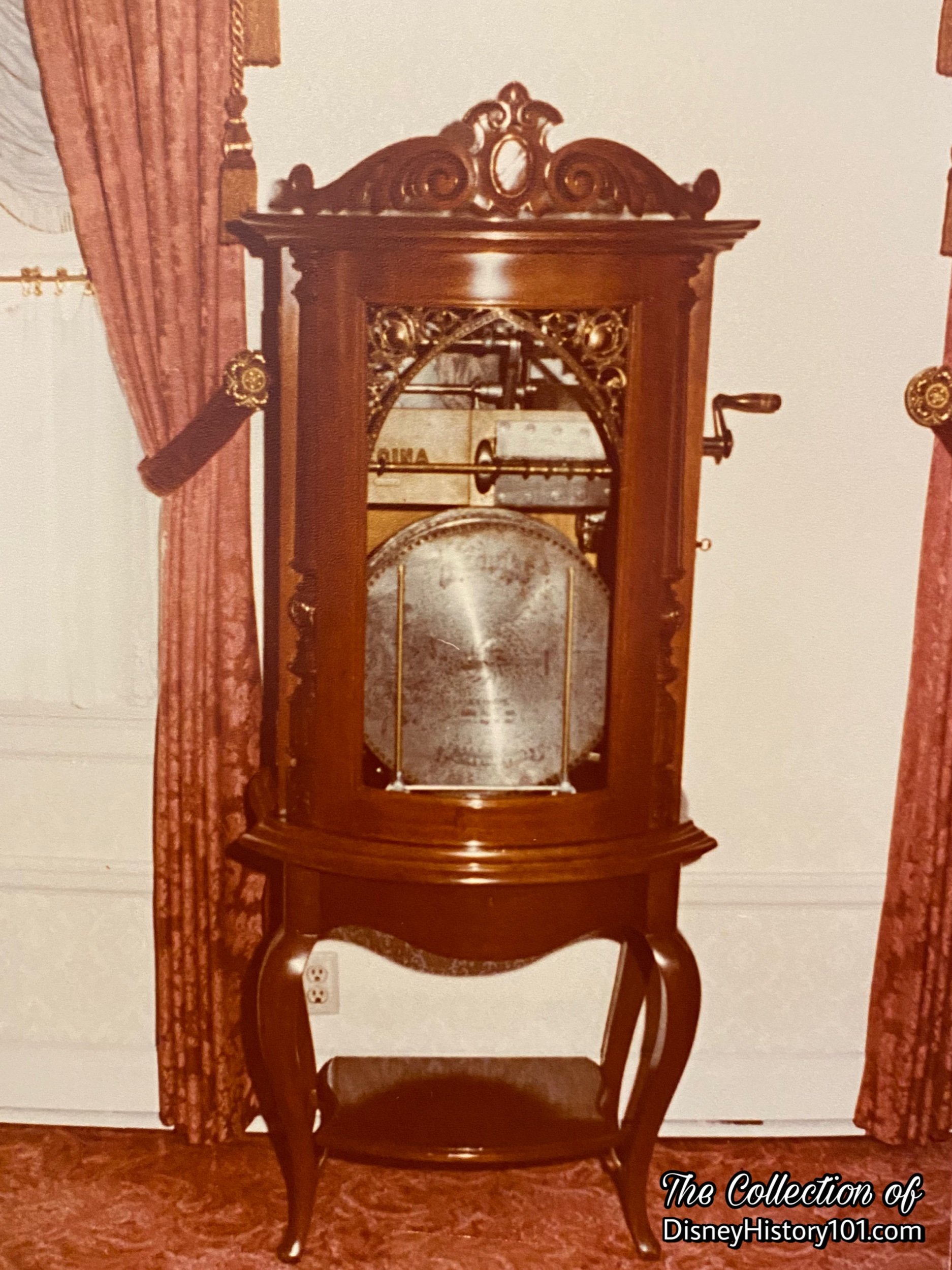
The Regina Music Box Company Corona, Style 35 Disc Player.
Mrs. Disney purchased some items right on Disneyland property, like an ink well set (that still carried its price tag) that was on display below a mirror in the apartment.
Speaking of antiques, the apartment contained an Edison Company Standard Victrolla Phonograph and an original 1890s Regina Music Box Company Corona, Style 35 Disc Player, each purchased by the Walt Disney family from the A.C. Raney collection in 1953. These items were gifts to Lillian from Walt.
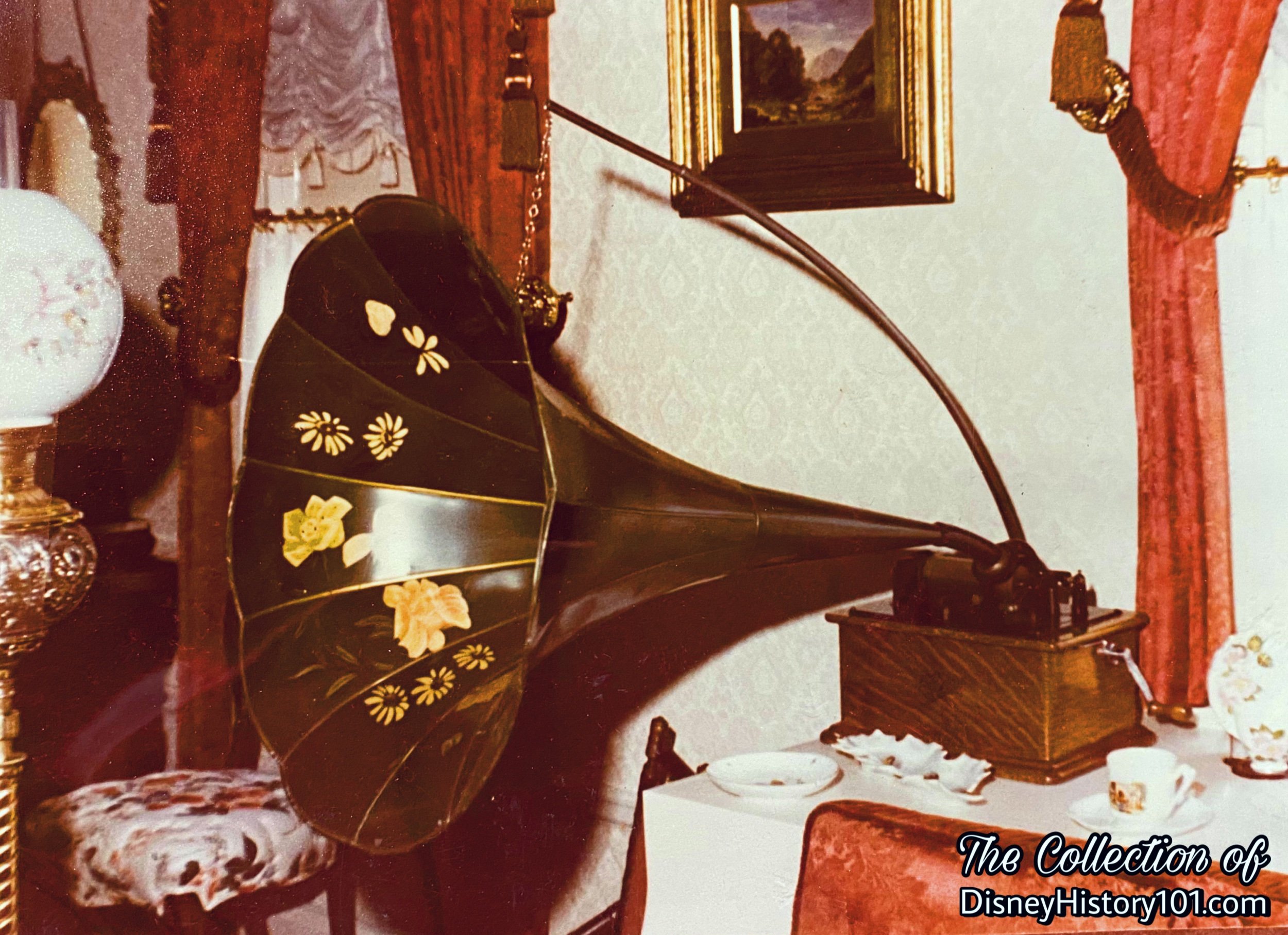
Disney Music Box File Photograph of the Edison Company Standard Phonograph.
As with all Disneyland keys produced in 1955, the special Yale Lock to Walt’s Apartment could only be opened by a special YALE Key, which Walt (and evidently, his assistant Dorothy Wrigley) possessed.
Next to Walt's Apartment, VIP guests watched the Press Preview Day Parade from the Restroom rooftop (as seen in televised footage and images captured by photographer Mel Kilpatrick).
“Walt Moves In”
According to the “Disneyland 25 - Happy Birthday to a Dream” newspaper supplement: “Once Main Street was constructed, Walt moved into his own small apartment above the Fire House to be closer to the action.” Disneylander and “55er” Bob Milek remembered “Walt was practically living here in the early days.”
Dorothy Wrigley (Walt’s Secretary, Park Operations Secretary & Disneyland’s 26th employee) helped set up (and regularly stock) Walt’s Main Street Apartment. In the kitchenette, there was a sandwich griller that Walt probably used many times to make his favorite food: grilled cheese sandwiches. There was a ‘Tom and Jerry’ bowl set is named for a popular holiday drink, not for the cartoon characters that, incidentally, are NOT part of the Disney family.
“Press Preview Day”
From the onset of construction Walt spent-as much time at Disneyland as his schedule would permit-and often times more so. Walt was making daily visits to the site and his apartment, especially on the Press Preview Day. Proving this is an anecdote preserved in the same publication: “Walt… confided to a reporter that he had almost missed the Park’s spectacular debut. Exhausted, he had gone to bed in his tiny apartment above the Firehouse to try for a few hour’s sleep. Because people kept waking him up with problems, he finally locked his door, only to find that later in the morning he couldn’t get the door open. In desperation, Walt finally had to yell for help.” [Disneyland 25 “Happy Birthday to a Dream” Advertising Supplement; published January 20, 1980] Walt clearly made it out in time for the Dedication of Disneyland. This is also where Walt could come to observe his first Guests on that opening day, between ceremonies and interviews.
Next to Walt's Apartment, VIP guests watched the Press Preview Day Parade from the Restroom rooftop (as seen in televised footage and images captured by photographer Mel Kilpatrick).
“Grand Opening”
Hank Dains recalled “the first day we had paying guests in the Park, and Walt was over at the Fire Station looking out the window. And I heard him say ‘Paying guests, I love you... and threw them a great big kiss.’”
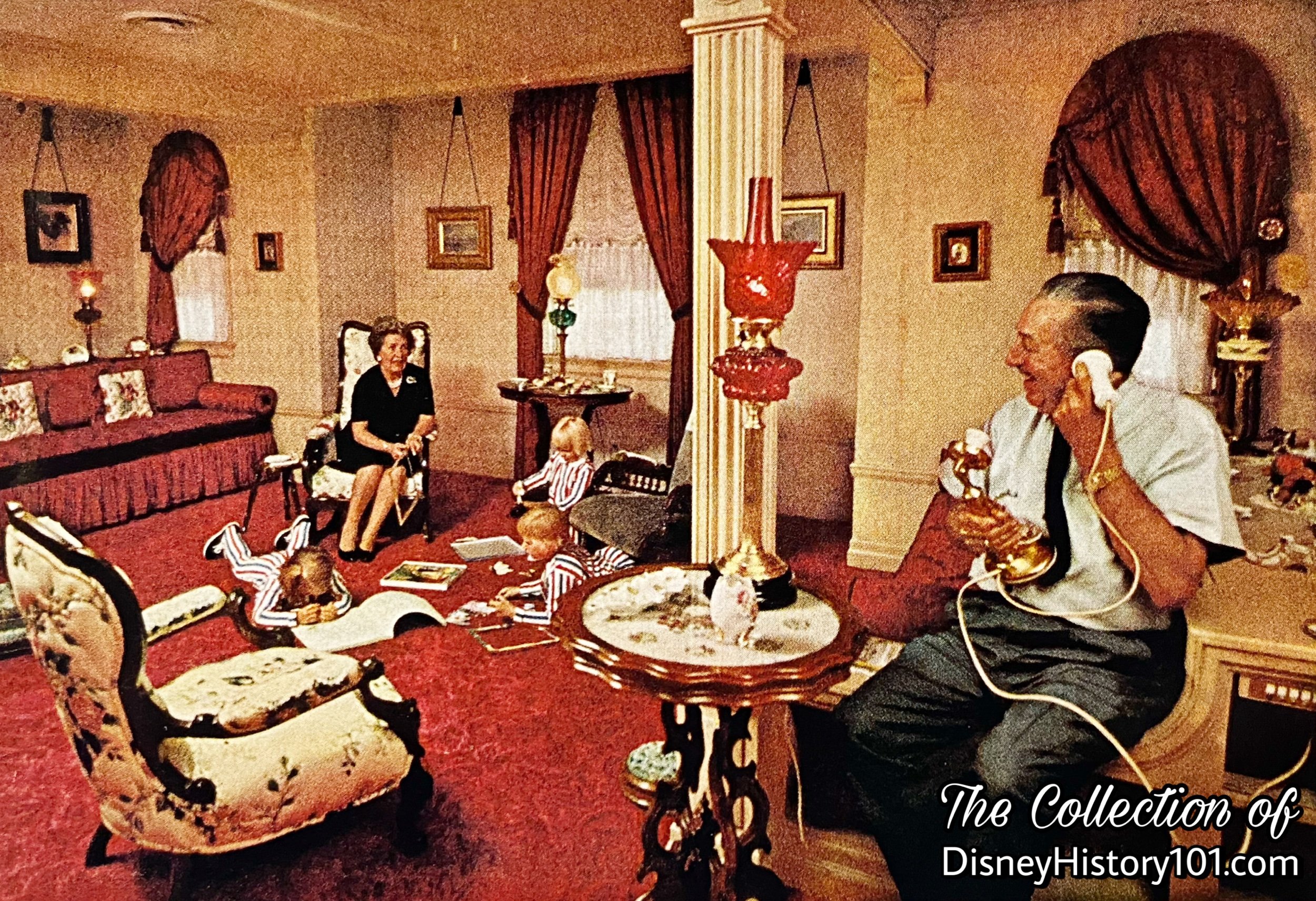
A rare image of “Walt’s Quarters” otherwise known as the Disneyland Firehouse Apartment appeared in the pages of National Geographic (Vol.124; No.2) published for August of 1963.
“Walt & Lillian’s Retreat”
Walt would spend a lot of time at the park on weekends coming back from Palm Springs.“Most of the time, Walt was here on what he called ‘business’ - observing maintenance and construction on the off-season Monday and Tuesday closure days, and patrolling the Park ‘incognito’ or so be tried to be almost every Saturday, so he could gage his Guest's reaction to Disneyland.”
One indication that Walt was ‘home’ in the apartment would be the closed doors to the Fire Station below. “This was done to ensure no fire bells were ringing if the Disney's were taking an afternoon nap. The fire pole in the station once extended right into the apartment.” As far as historians know, Walt never used the pole as a quick exit from the apartment. Another sign that Walt was in for the evening was an illuminated light located in front of the window facing Main Street.
The apartment eventually become Walt and Lillian’s private retreat in the Park. “In the early days, when Disneyland was still in an experimental learning period, Walt and Lilly would come to the Park to spend a few days in his apartment above the Fire Station,” according to “The Spirit of Disneyland” (published 1985, for Disneyland Cast Members). Staying here may have very well seemed familiar to Lillian, whose father was once the Fire Chief of Lewiston, Idaho.
“The Disney Family Retreat”
You may recollect how Walt described (to Bob Thomas of Associated Press) a particular element of the “firehouse” : “Upstairs will be a room for VIP’s, where we’ll entertain the visiting firemen.’” We’re unsure of how many “firemen” were actually entertained in Walt’s Apartment, but Walt and Lillian often hosted family members. “After Disneyland opened to the public, Walt found the apartment was a good idea as it allowed him a place within the park where he could entertain his family in private or even spend the night before his Saturday ‘inspection days.’”
Sometimes, though, Walt's visits were strictly recreational increasingly so as his family grew. “During Disneyland's first decade, Walt and Lilian Disney had acquired 11 grandchildren and you can bet what weekend outing was very high on those grandchildren's list!“ The Main Street apartment could scarcely accommodate so large a group and the children and, later, the grandchildren, would sleep on the floor. Inside the cabinets there were glass baby bottles which were used by the Disney grandchildren. Joanna Miller (the second eldest child of Diane and Ron) often shares fond memories of her grandfather Walt Disney, including staying in the apartment above the fire station.
Therefore, with Disneyland's first new land, New Orleans Square, already under way, Walt decided to build a larger version of his home-away-from-home up in the otherwise unoccupied second level of the gracious, balconied buildings.
“Walt Entertains a Few Guests”
As the Disneys loved to entertain, a few non-family members were also guests of Walt’s Apartment through the years! According to Mouseketeer Sharon Baird’s account, the Mouseketeers were in Walt’s private apartment when Guests first stepped through the turnstiles below, on the Opening Day of Disneyland. The adjoining Roof Terrace allowed guests to enjoy the air (and the view of Town Square) from the second story. Many guests could be seen on the Roof Terrace during the Opening Day Parade as attested to in "Homecoming - Destination Disneyland" by Carlene Thie with photos by Mel Kilpatrick. Another event (in coordination with the release of a Davy Crockett film) brought both Fess Parker and Buddy Ebsen to Walt’s Apartment.
Original Mouseketeer Tommy Cole recalled: “Our first schoolroom where they would tutor us was above the fire station in Disneyland. It was close to Walt's office, for he had an office above the firehouse. I so remember that and all the back streets, back parts of Disneyland.“
In its early years, while Walt and Lillian were alive, the apartment was as private as anyone's home. Few photographs (as one published in National Geographic, August of 1963) of Walt’s Apartment, were made public, so it was hard for the average Park-goers to imagine what Emile Kuri’s interior decor (now enhanced with trinkets personally selected by both Lillain and Walt) looked like.
Not many Cast Members or guests ever saw the inside of the apartment. Bill Sullivan recalled: “I think my most memorable encounter was when we opened Small World. This was my first experience at being responsible for opening a new attraction. Walt and I walked through the area one night, and talked for about half an hour about things in general and the attraction in specific. In fact, we kept on walking and talking all the way from Small World and down to Main Street to his apartment.”
“Disneyland Cast Member Re-Orientation Tour Groups Visit Walt’s Apartment”
There were a few unauthorized visitors according to Van France: “Everyone was curious about Walt's apartment located above the Fire Station on Main Street. So, for a re-orientation group I was leading, I managed to borrow a key (I can't remember how), and each group would "ooh" and "ah" as we walked through Walt's private quarters. Many Cast Members enjoyed the tour until, on rainy day, the raincoat of one participant brushed against one of Lillian Disney's table decorations. The Cast Member made a courageous reach, and fortunately caught it before it hit the floor.
In addition to the re-orientation traffic, a young Host, the son of one of our executives, had found a key to the rooms, and had used the apartment... I planned to have someone clean and straighten up, but I had somehow forgotten about it, a fatal error just before Walt's weekend visit. When the Housekeeping Hostess entered the apartment in anticipation of Walt's arrival, she found clues that there had been unauthorized intruders. Panic buttons were pushed from Disneyland to the Studio to WED and back. That was the end of our tours of the apartment.”
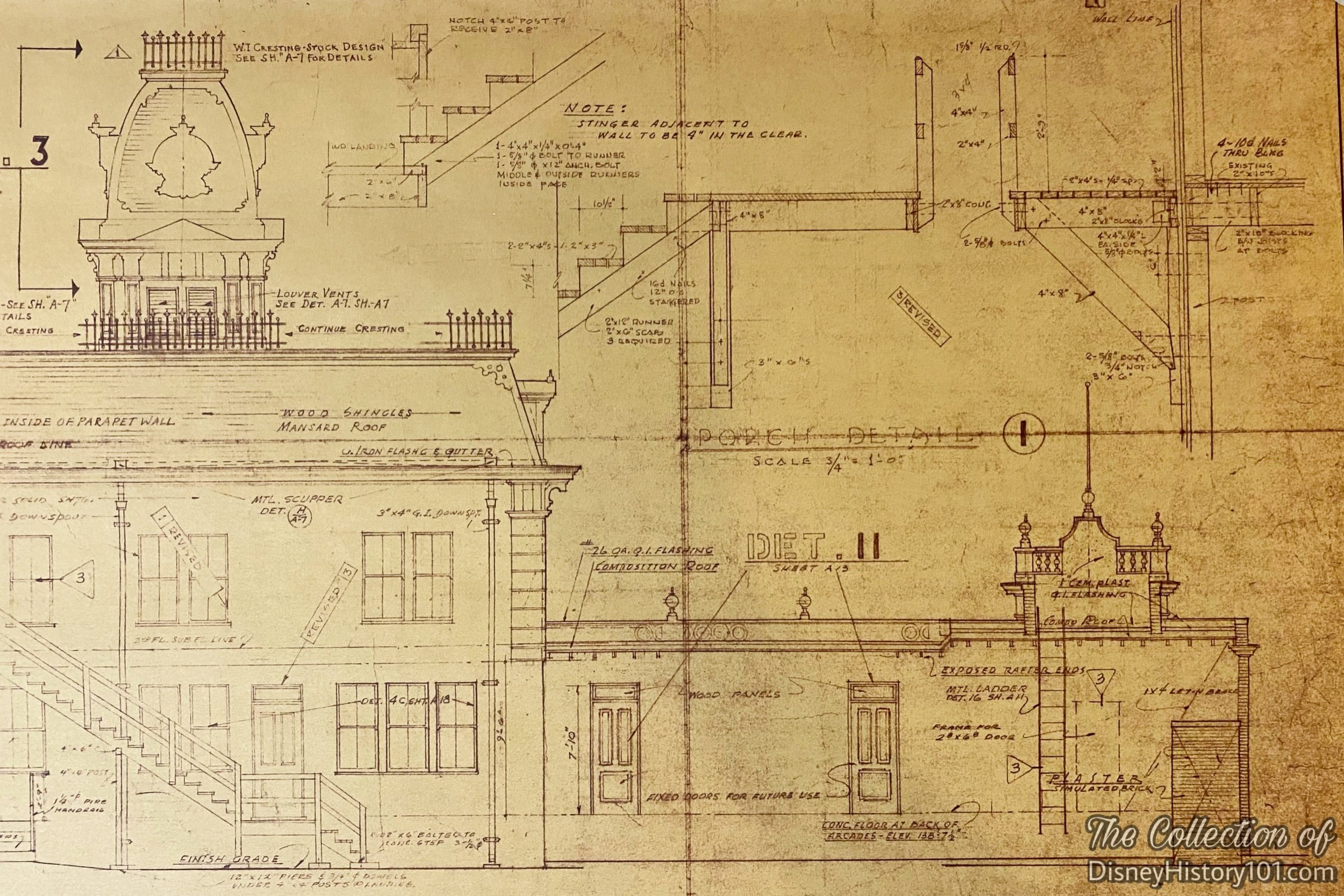
“Main Street 400 Block” elevations, produced c.1961.
During 1958, a shade roof lattice was constructed over the 20’x33’ Walt’s Roof Patio. This Roof Patio Addition to Walt’s Apartment (Disneyland Inc. Job #032-50-45) was accomplished through the help of Disneyland & Studio laborers, as well as sub-contractor Cowelco. The covered porches and steps measured 1000 square feet. The labor and materials of the Roof Patio Addition project were later appraised at $5728.42.
By March 15, 1961, the design of louvre shutters (by Art Director Harvey Gillett of WED Enterprises, Inc.) was completed for Disneyland, Inc. and added to Main Street Buildings.
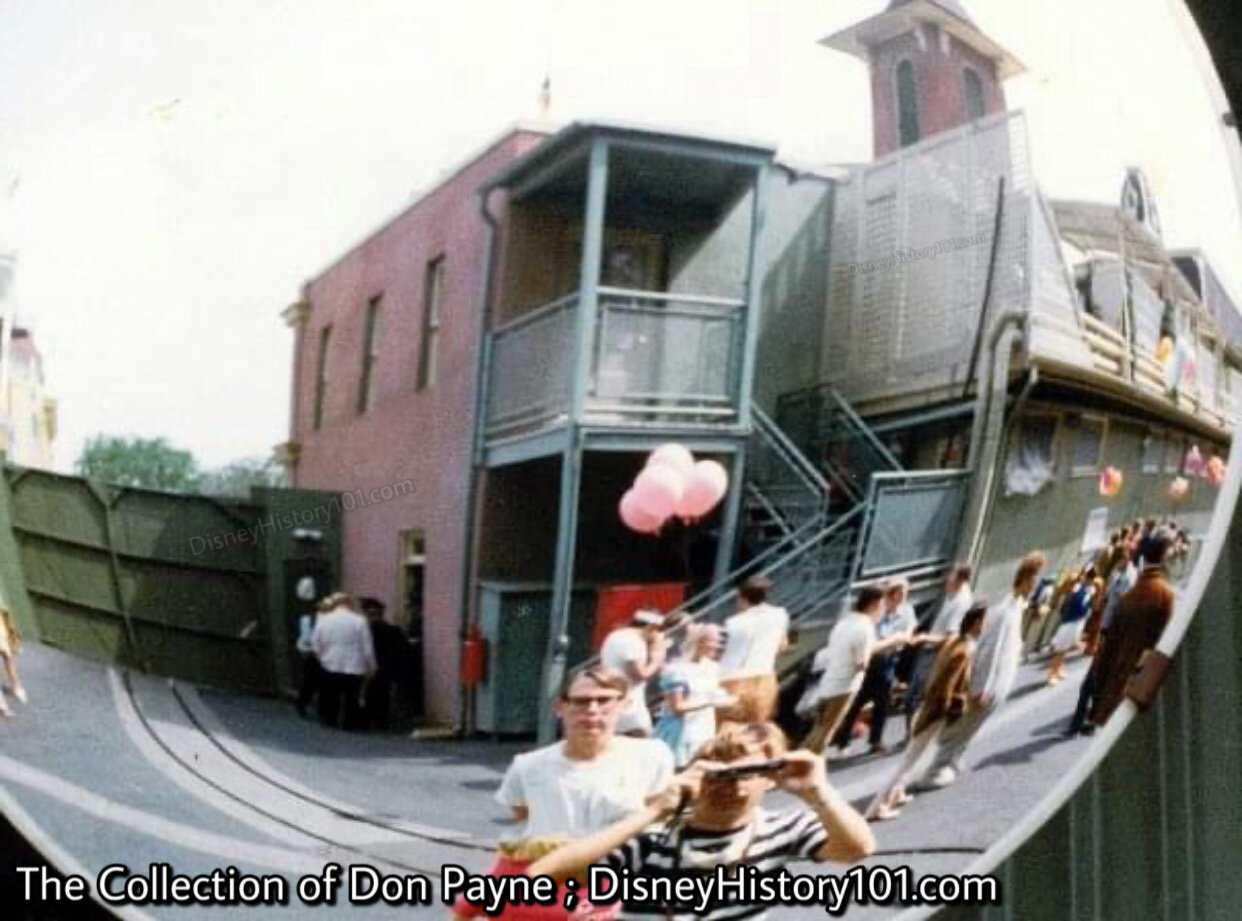
Walt’s Apartment “Back of House” Stairwell allows good access from Backstage.
“After Walt Tours Resume”
The Disney apartment is a very special part of Disneyland history. After Walt and Lillian passed away, the apartment remained locked for years.
The Disney apartment was not an attraction for the general public. From time to time, a few select few Cast Members (and some distinguished guests) were invited to take a tour of the apartment. But ultimately, thanks to the magic of Disneyland Guided Tours, many a guest has set foot into Walt’s firehouse apartment. It was and is the distinct privilege of tour guides, to preserve this piece of history, hoping that Guests considered it a privilege to have been able to experience it.
Walt Disney's personal apartment is still decorated in the Victorian style Lillian, Walt's wife, chose for their home away from home. The decorating staff showed impeccable care in mirroring Lillian's original collection and in preserving the style of Emile Kuri. While very few of the current bric-a-brac items actually belonged to the Disneys, Guests are encouraged to not handle old and fragile items or irreplaceable antiques within the apartment (or on the balcony). In order to preserve the sanctity of the apartment, pictures were also initially prohibited then limited. Above, Bob and Don make a sanctioned memory behind the Main Street Fire House (and Walt’s apartment).
Today, Walt’s Apartment is a unique part of our resort history, and a fun glimpse into Walt's life here at Disneyland. In visiting, I am often reminded of an expression made by Martin Sklar, how: “you can't beat the original Disneyland. I always like to remember that this is the only park Walt ever walked in.”
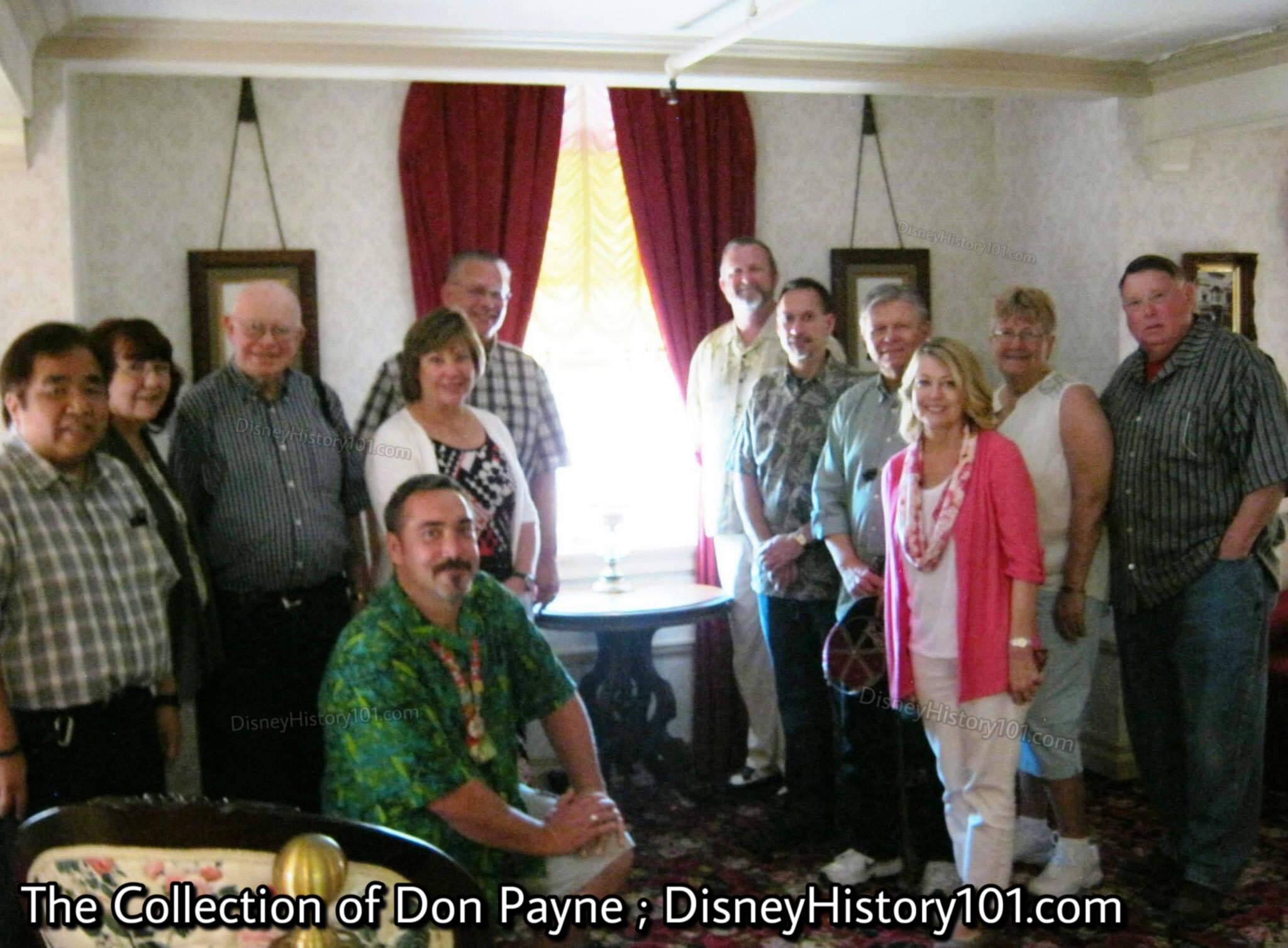
Dave Smith and Former Golden Horseshoe Revue Cast Visit Walt's Apartment
Walt’s Apartment continued to occasionally host events. Club 55 celebrated “40 Years of Adventures” here with a friendly champagne reception and reminiscing, on Saturday, July 15, 1995.
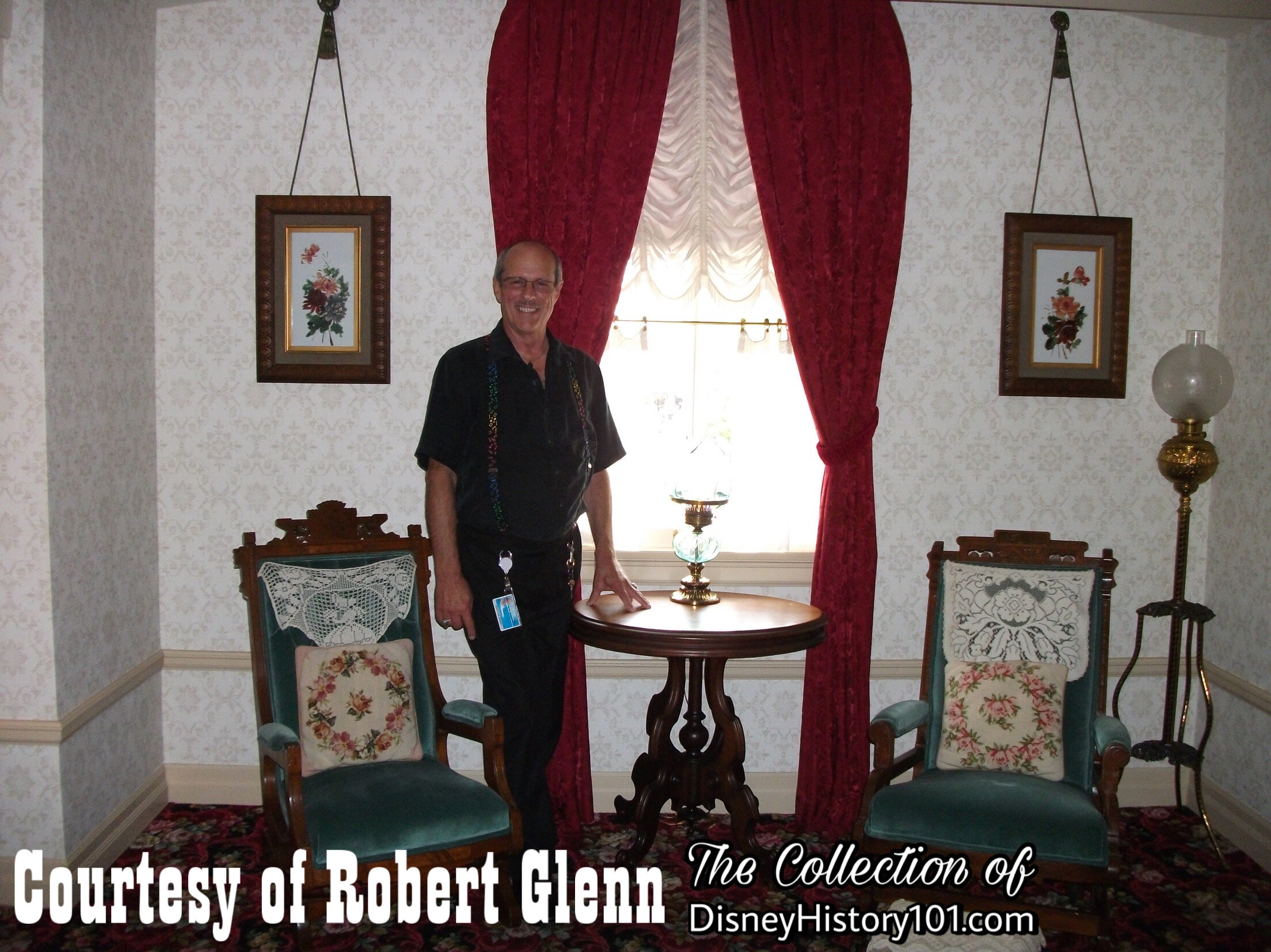
Former four-hand Coca-Corner pianist Robert visits Walt’s Apartment Interior
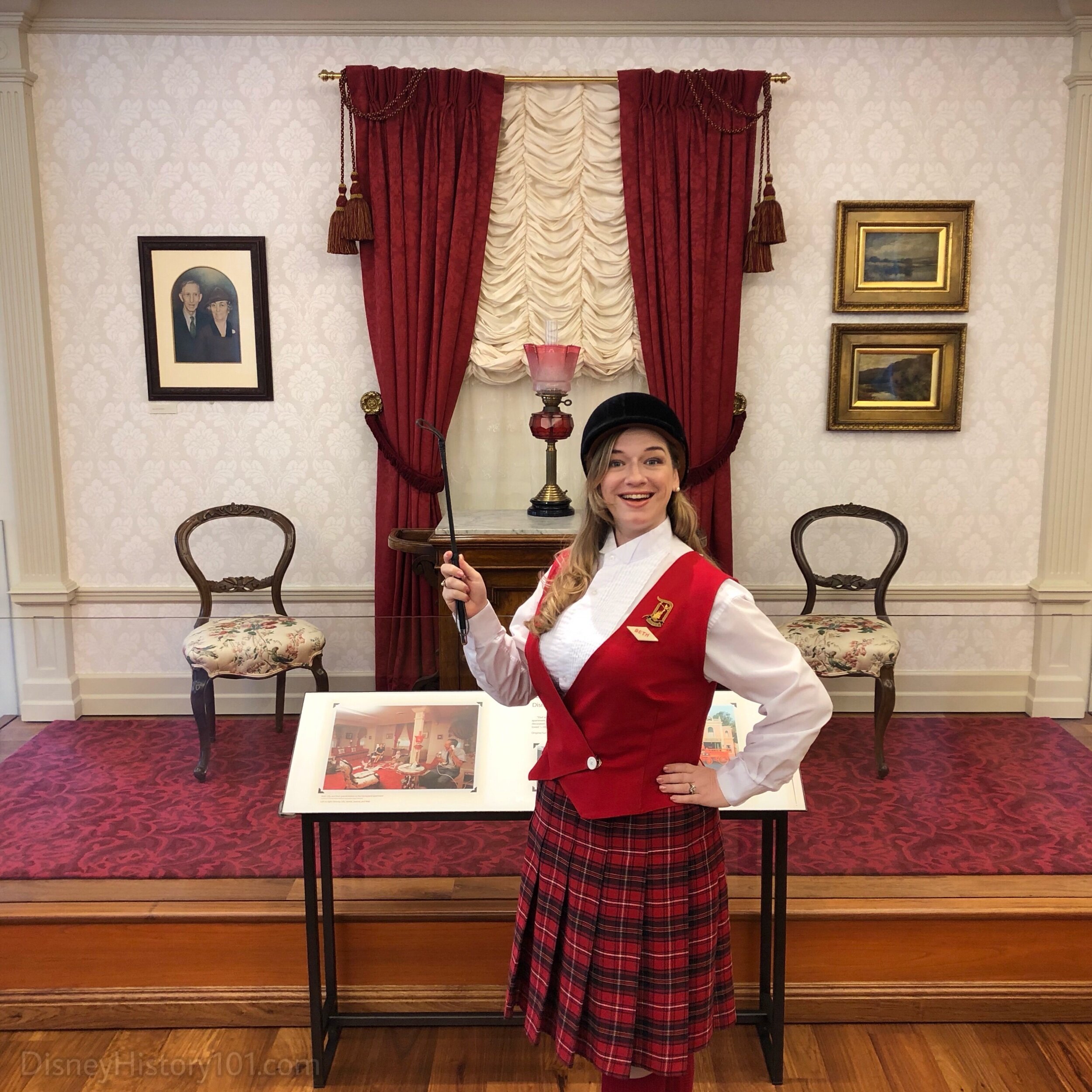
“Walt’s Apartment Display”, The Walt Disney Family Museum
“Legacy”
In order to share the experience of Walt’s Apartment with Disneyland fans, the Walt Disney Family Museum (of San Francisco, California) has created a special diorama in honor of this rarely-seen “dwelling unit”! The Walt Disney Family Museum Trophy Room houses some amazing antiques from Walt Disney’s so-called “super secret hideaway” - the Main Street Fire House Apartment. According to Walt Disney Family Museum docents, some of the furniture and pictures on exhibit were removed from the Fire Station Apartment by Disney family previously. Some pieces (like the lamp) are representations of the antiques that once furnished the apartment. Though the authentic antiques have been cared for (receiving some level of refurbishment and restoration), they can still be seen as they are rotated in and out of the exhibit.
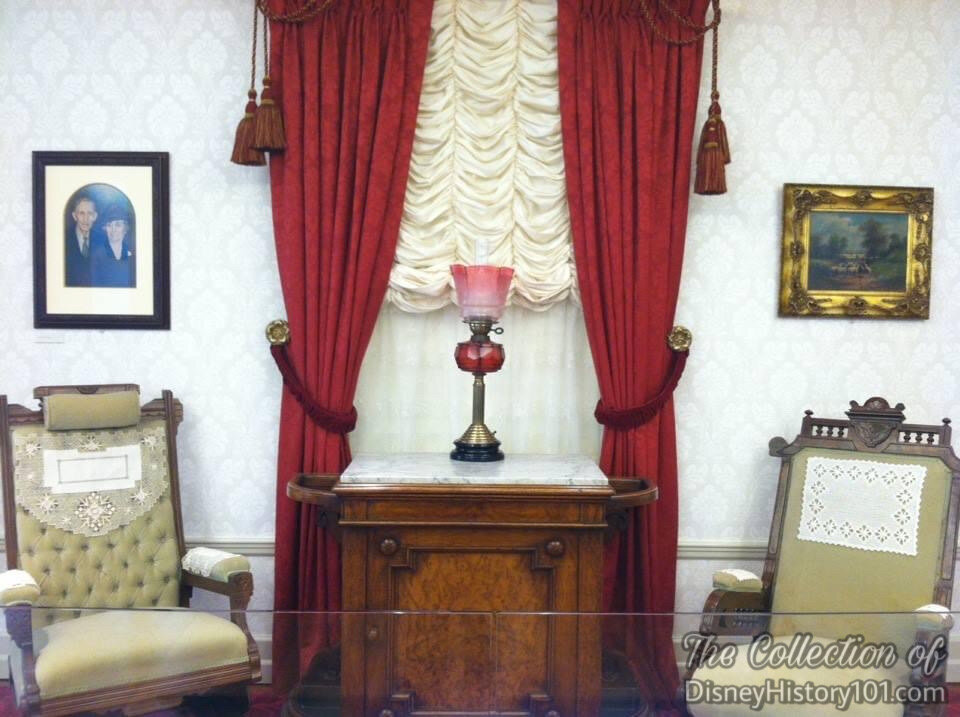
“Walt’s Apartment Display”, The Walt Disney Family Museum
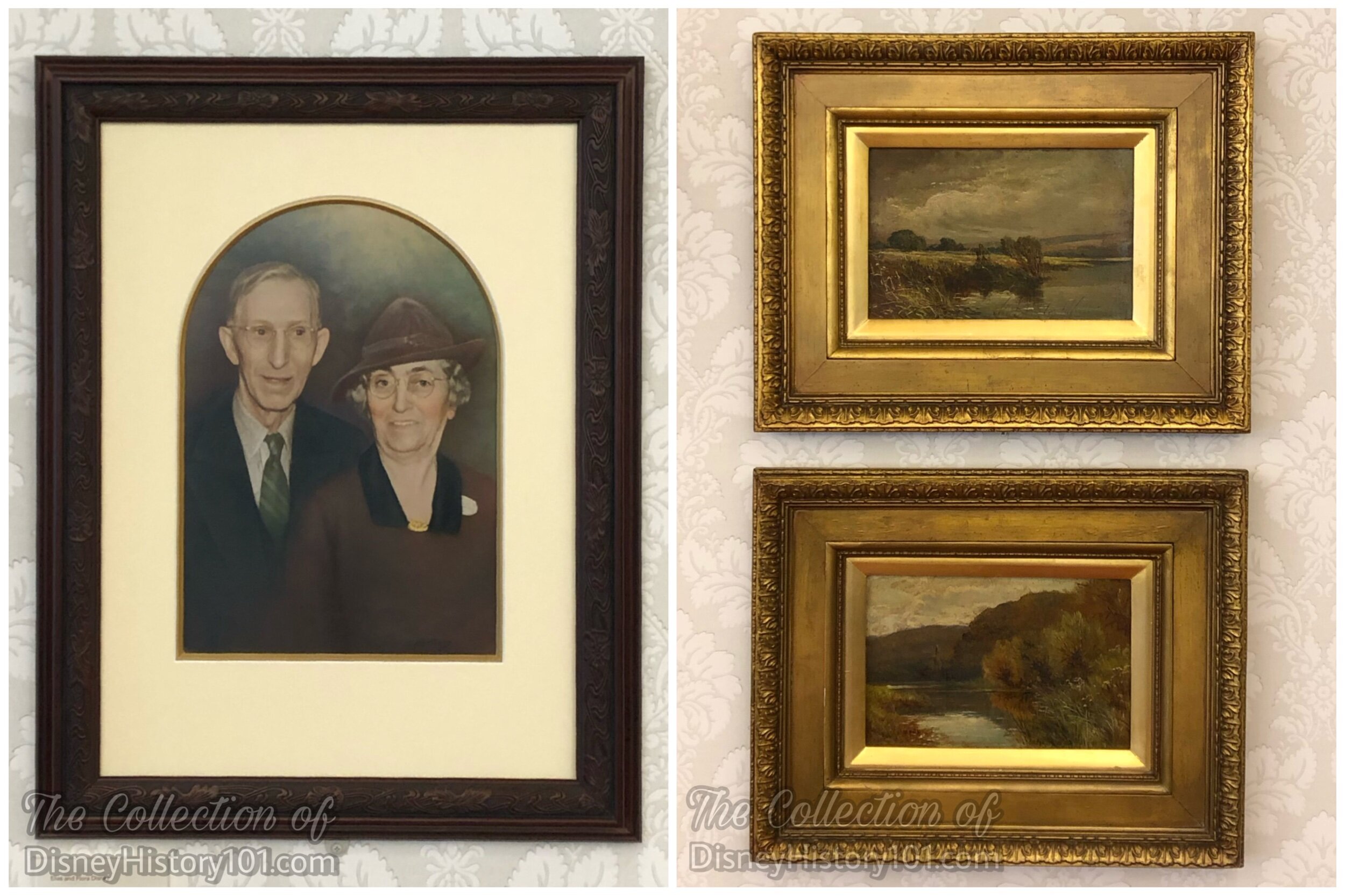
Authentic Decor From Walt’s Firehouse Apartment - Framed Pictures of Elias & Flora and Scenic Paintings, The Walt Disney Family Museum
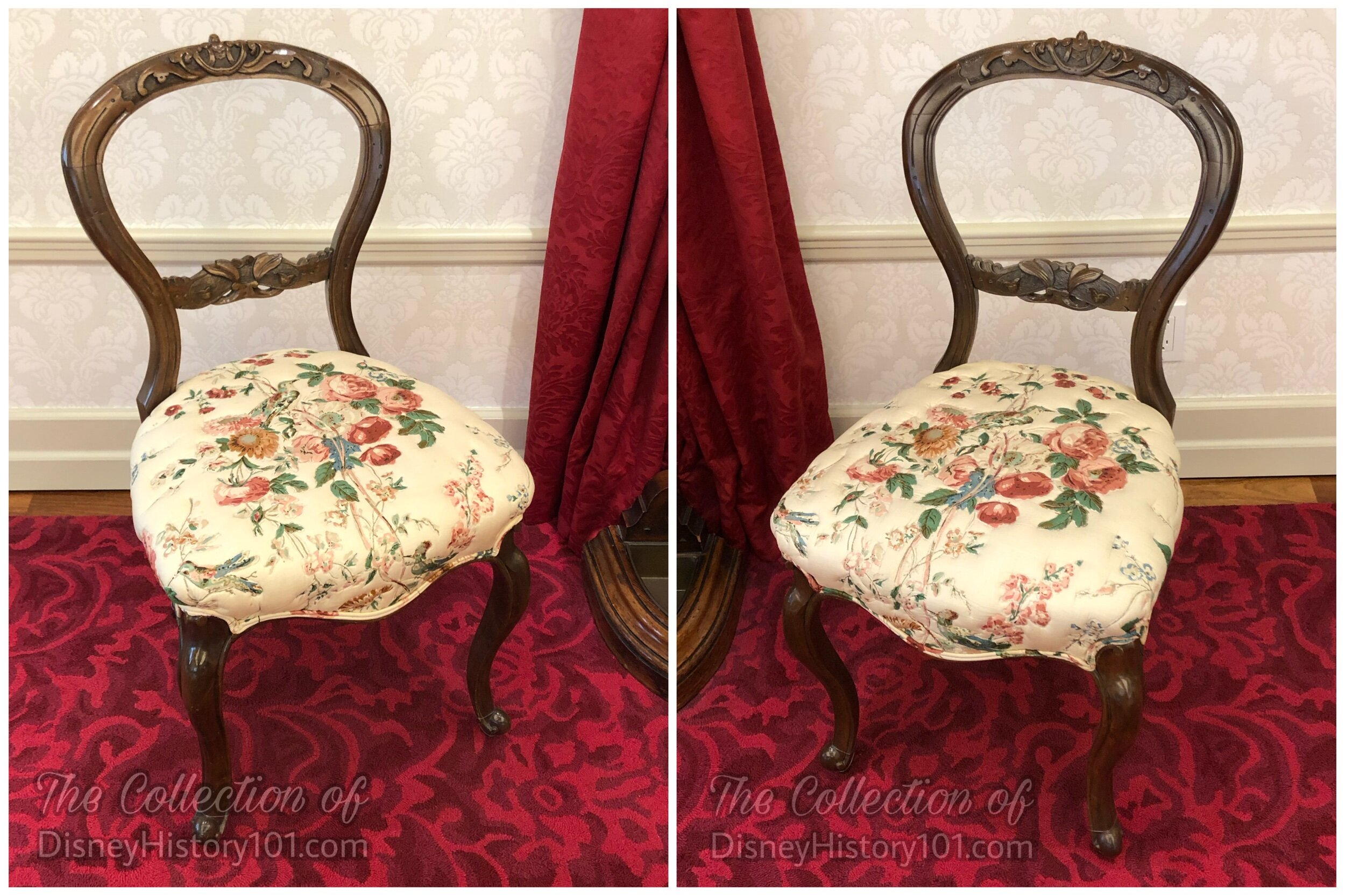
Authentic Chairs From Walt’s Firehouse Apartment, The Walt Disney Family Museum
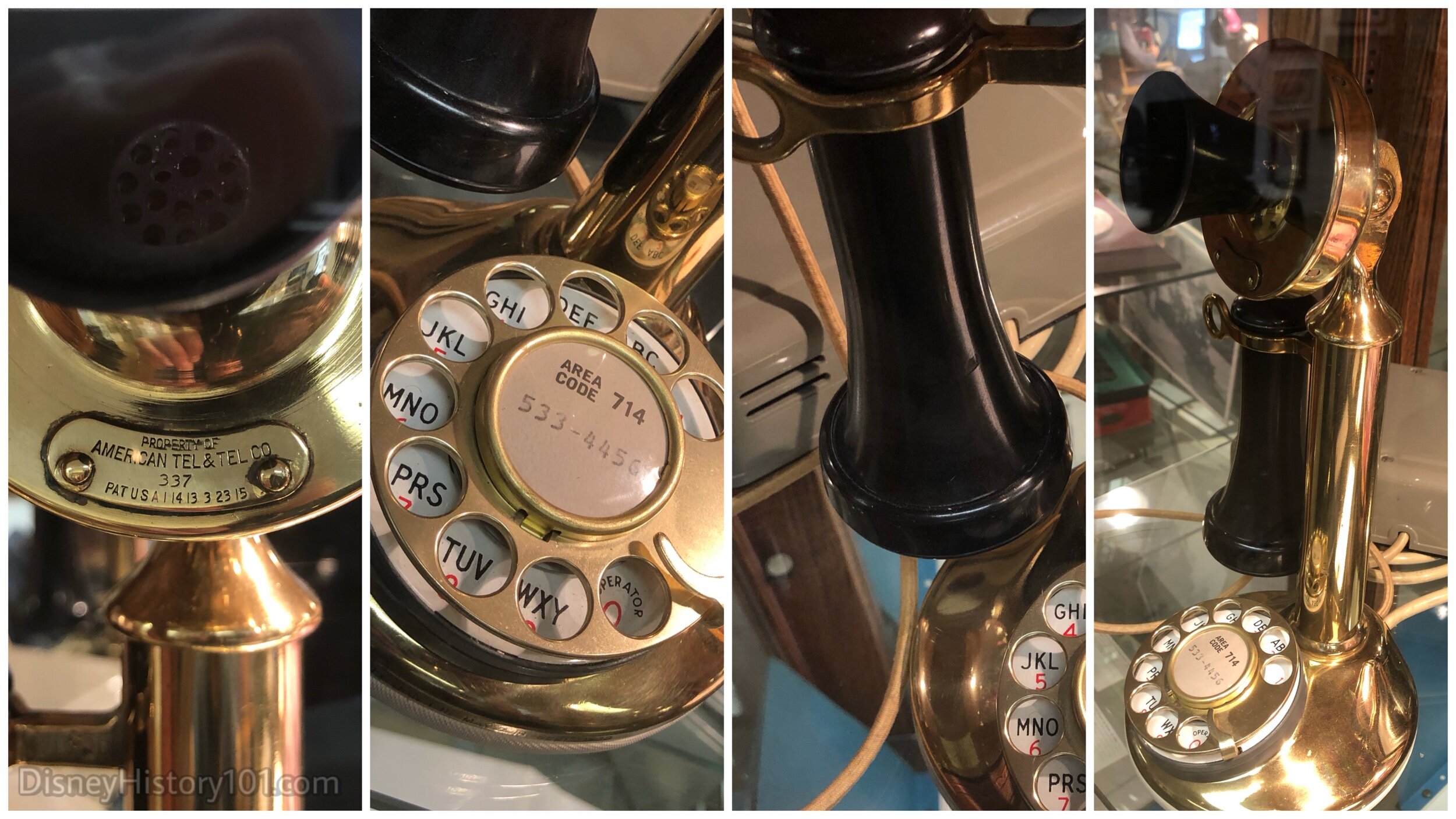
Candlestick Phone from Walt’s Apartment (c. 1960s - 1980s), Former Collection of Bob Penfield
Occasional unique artifacts from Walt’s apartment have surfaced at auctions over the years, including lamps and even swatches of carpet. We once came across this most unique artifact (pictured above) at one of Van Eaton Galleries’ pre-auction shows. This beautifully elegant candlestick (or, “grandfather”) telephone (was actually seen in the few approved press photos of the Disney family Firehouse apartment interior). Even more, this piece was also once the property of ATT (the American Telephone and Telegraph Company, and one-time sponsor of the Circle Vision Theater in Tomorrowland). Walt and Lillian often visited antique shops along their travels, and likely found this on one of those excursions. The phone number for the apartment is even still on the telephone, reading “(714)533-4456”.
This artifact is now part of some private collection.
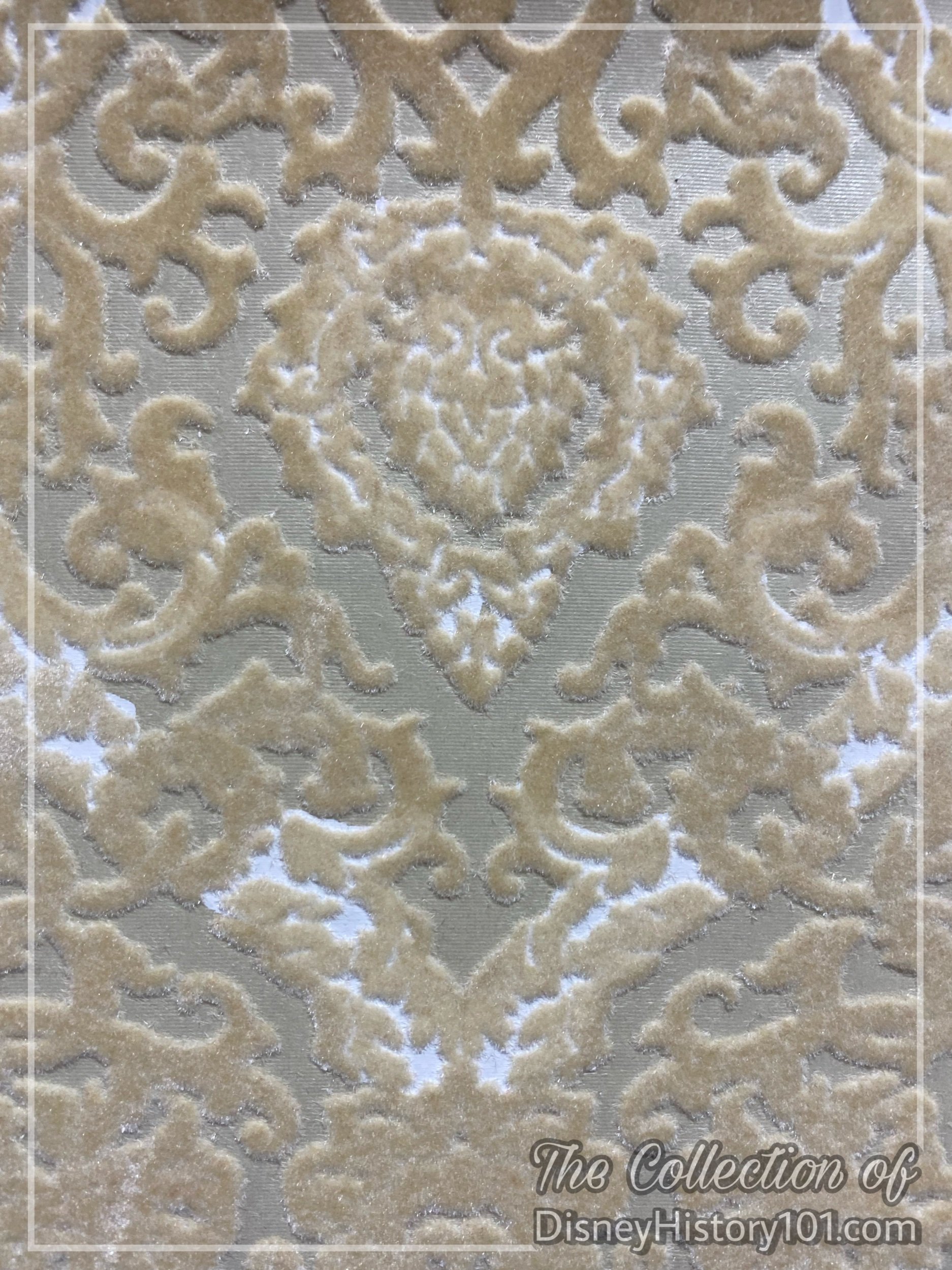
A Close-up of a Wallpaper Swatch from Walt's Firehouse Apartment, Private Collection
This sample of wallpaper from Walt Disney’s Firehouse Apartment gives us an idea of one element of the original setting enjoyed by guests.
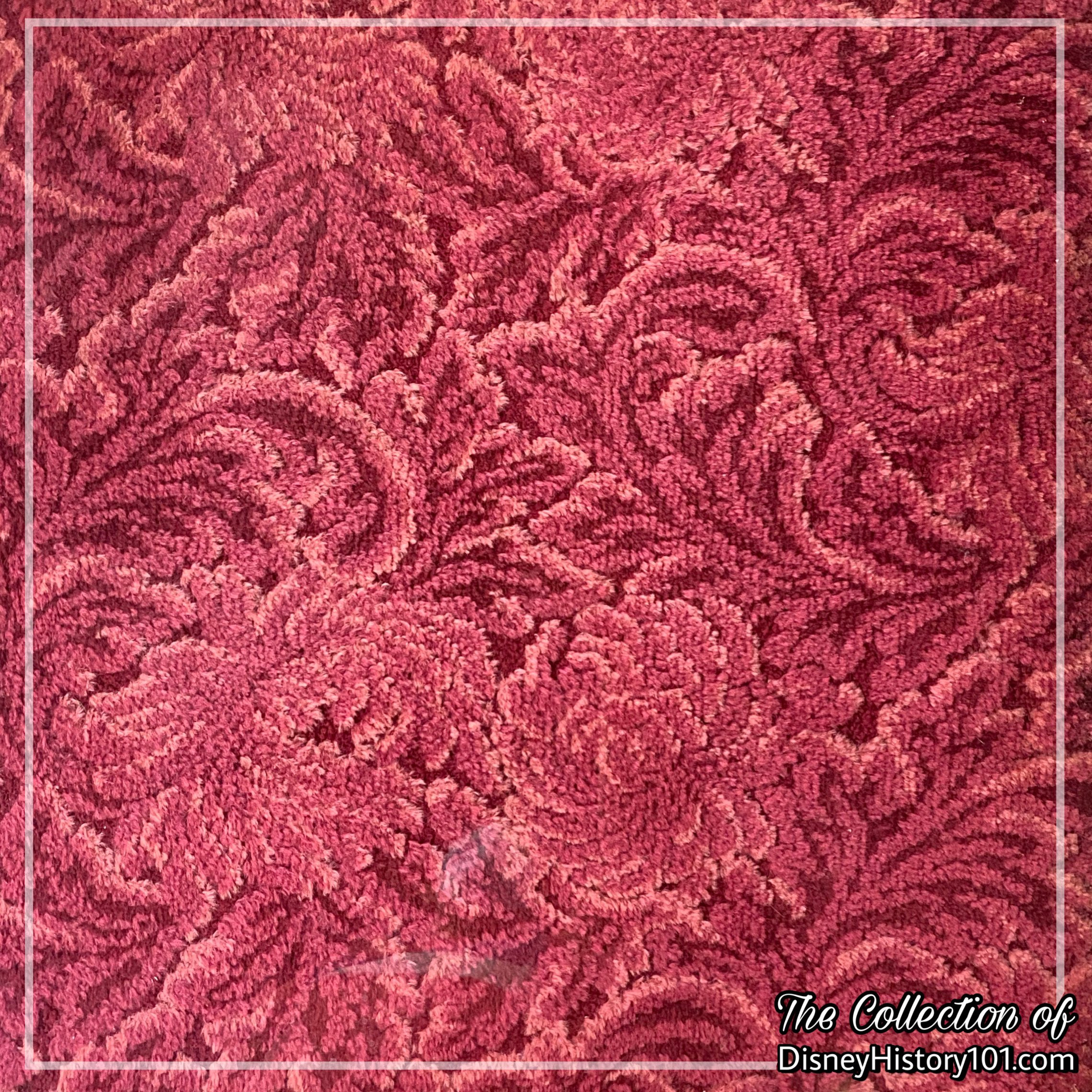
A piece of carpet from Walt’s Apartment.
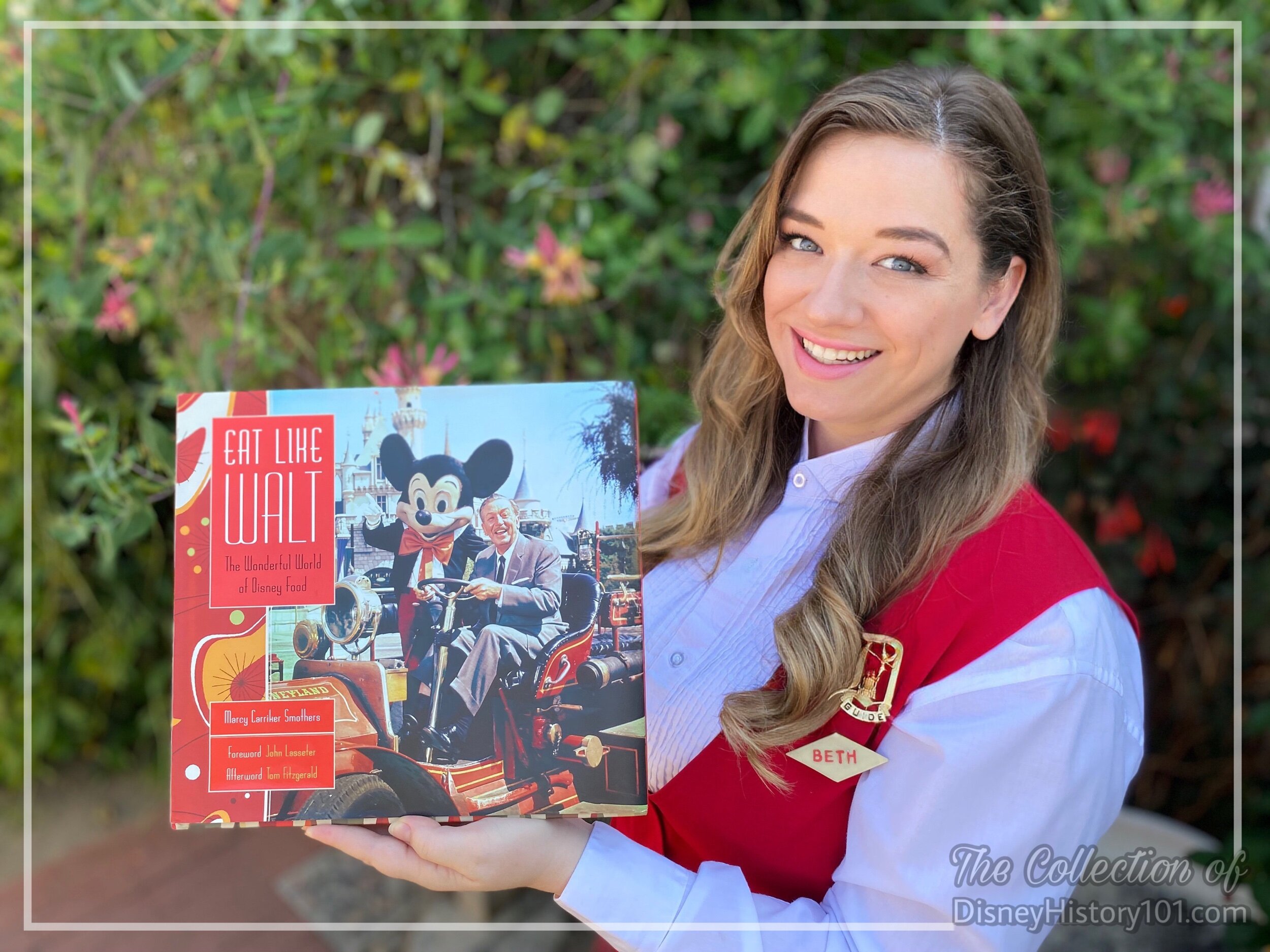
If you would like to read more about the Walt’s Apartment, I highly recommend adding Marcy Smothers’ “Eat Like Walt - The Wonderful World of Disney Food” to your personal Disney Home Library! Therein, Marcy has extensively researched and finely crafted a small section of a chapter “Walt Disney’s Disneyland - Main Street U.S.A.” dedicated to “Walt’s Apartment.” Marcy even shared the contents of a “1959 Memo” which “listed the supplies to be stocked in the apartment.” If you would like to bring the magic of Disneyland restaurants and concessions to your dining room table, “please step this way” toward www.eatlikewalt.com where Marcy has shared a few recipes for memorable Disneyland menu options, so you too can “Eat Like Walt.”

The Disneyland Fire Department with shade lattice (seen upper left), 1961.
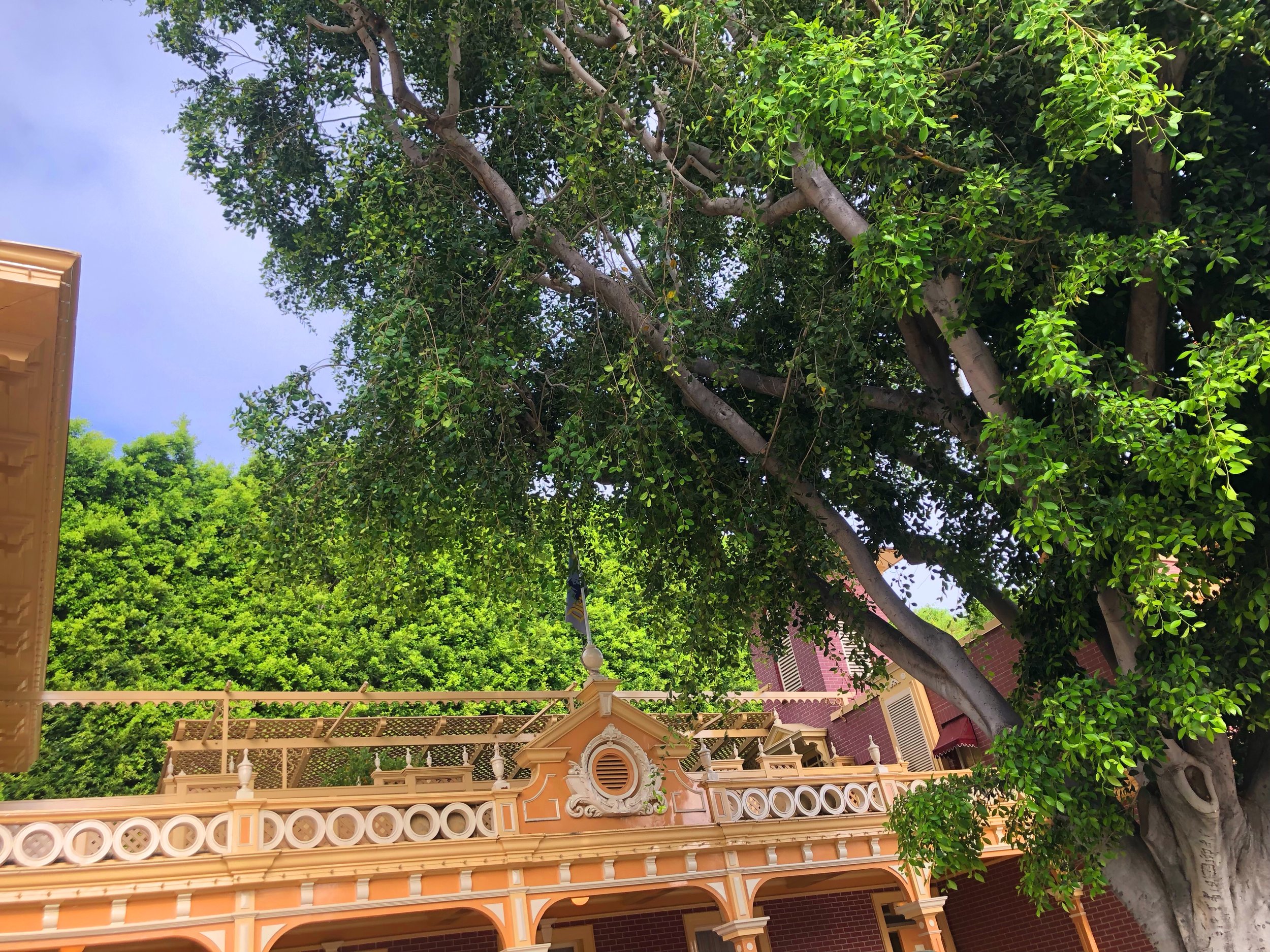
Disneyland Fire Department Apartment Patio (or, "Roof Terrace," 2019
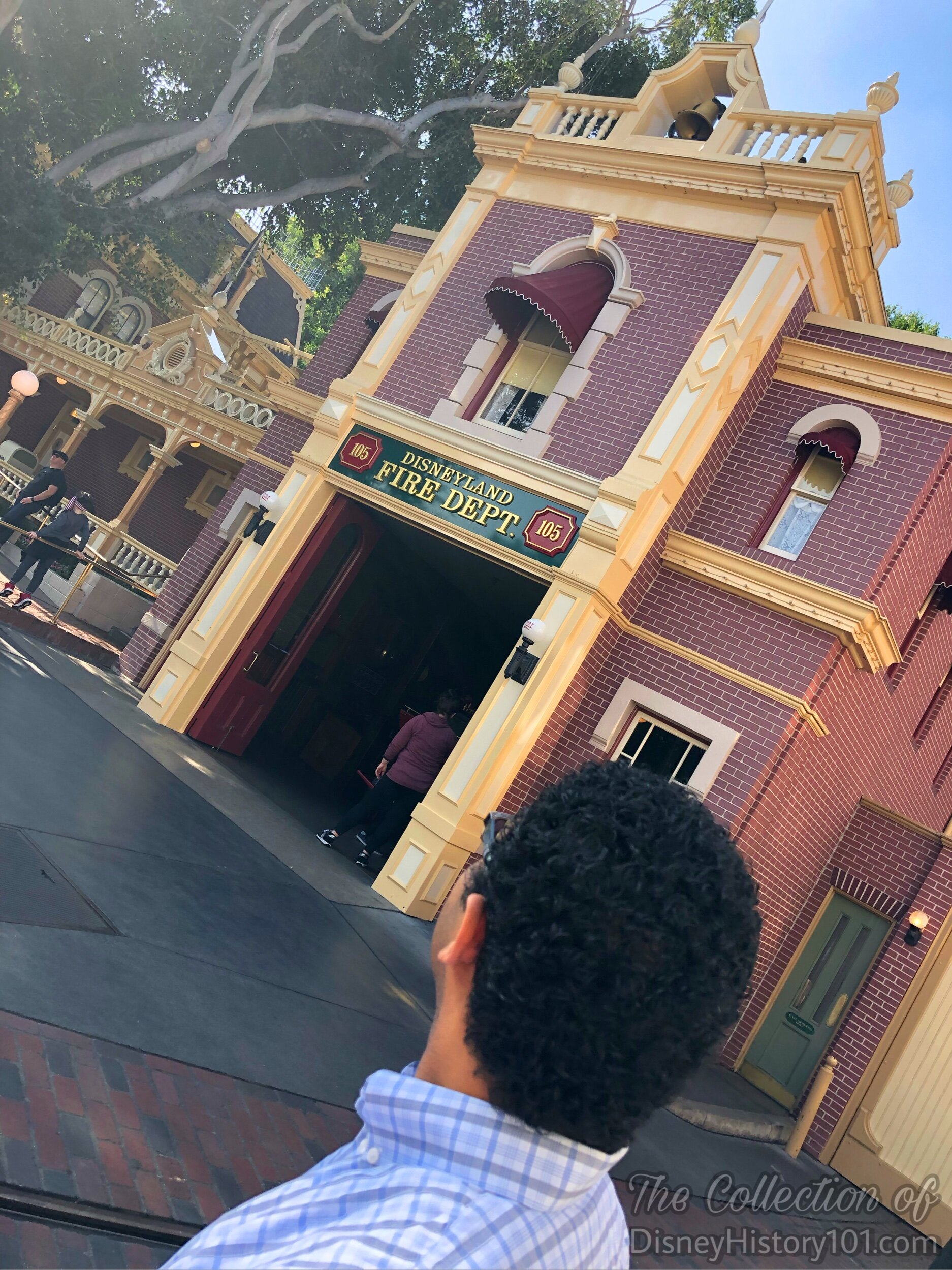
Disneyland Fire Department, 2019
The Disneyland Fire Department would have a legacy in Disney Parks worldwide. In fact (by the spring of 2003), the concept of an “old-time” Disneyland Fire Department was being Imagineered for the south side of Town Square at Hong Kong Disneyland, but with a practice usage of space. The structure was planned to be utilized as a “stroller and wheelchair rental” facility.
While there will continue to be such Fire Department buildings on the Main Streets of Disney Parks worldwide, the Disneyland Fire Department (in Anaheim, California) with its upstairs apartment, will forever be the one and only with the personal imprint of Walter Elias Disney. Today, a light remains lit 24 hours a day, all year long, to remind us that Walt is still here at Disneyland, in spirit.
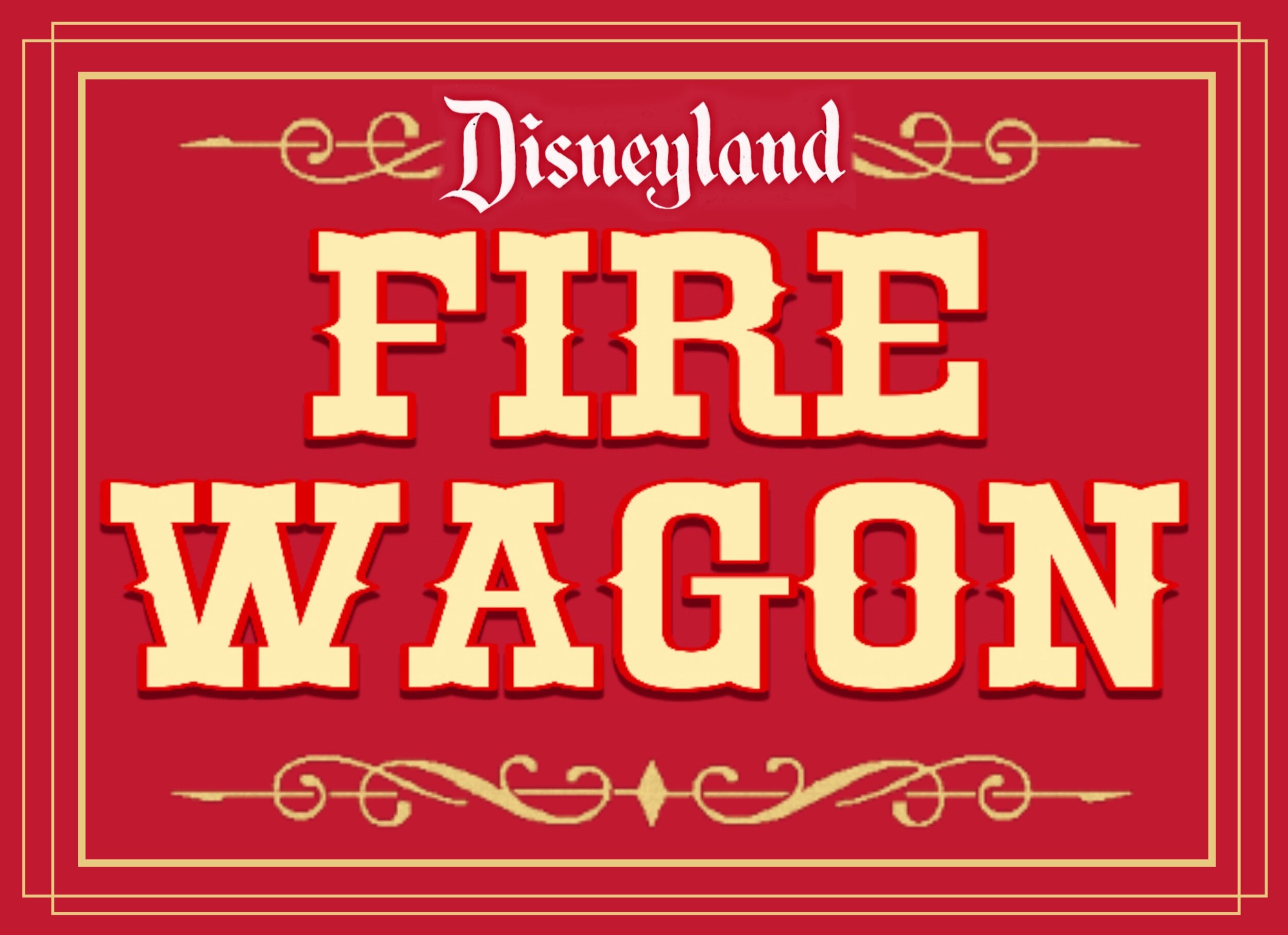
(July 18, 1955 - September 11, 1960)
“Walt was reared in the mid-western town of Marceline, Missouri. As with other lands, he wanted Main Street to be a Main Street - authentically recreated to get the feel of a typical small town thoroughfare of the 1900 era with which he was familiar.”
Take a close look at Main Street. “Note the results of years of research to determine and design a composite Main Street of the typical small town of the early century. Note the demanding attention to detail designed and built into every nook and cranny by Walt and his ‘Imagineers’ at WED Enterprises. This same demand for detail is designed into Main Street vehicles.”
At Disneyland there is a "story behind the story" of every attraction, every attraction is a living experience for the guest. Disneyland ride-through attractions or adventures have officially been defined as an “individual show, ride, or exhibit designed to produce an entertaining Guest experience. Disney attractions stir the imagination, enliven the senses, and provide the participants with positive, innovative entertainment, which is the essence of the DISNEYLAND Show.” It is important to review the story of the attraction, tell the story, explain it, and create interest. This is the story of the Fire Wagon.
“Main Street vehicles play an important part in the Disneyland show. First, they are essential to the staging of Main Street, U.S.A. The contrast to the hustle and bustle of our modern world and its streamlined modes of transportation is sharp and penetrating. Suddenly, as a guest comes onto Main Street, the entire mood changes. The years roll backward. back to Main Street, U.S.A., circa 1900. It wouldn't be Main Street without the leisurely clop-clop of a horse-drawn surrey, or the chug-chug of a horseless carriage.”
Second, they serve as much-needed transportation for our guests. They provide a convenient and colorful way to reach the heart of the Magic Kingdom - or back to Town Square after a long day in the Park. Third, hosts assigned to operate these vehicles play an important part in answering questions - giving tips and directions - to guests who are either starting out or winding up their day at Disneyland. Their role falls into what might be called our ‘first impression - last impression’ group. They can start guests off on the right foot - in the right mood, and send them away with a warm feeling - and a desire to come back.
Three years before Disneyland acquired an antique fire engine, guests could “be a fireman” and “answer the alarm” on Disneyland’s very own horse-drawn fire wagon! At the time, there were already several other horse-drawn vehicles in Disneyland - the Main Street Surrey, as well as the Frontierland buckboard & Stagecoach. Grandmother and Grandfather could reminisce about the good old days while riding aboard these “vintage” vehicles of their youthful era. However, among this lot of vehicles, there was just one Disneyland Chemical Wagon.
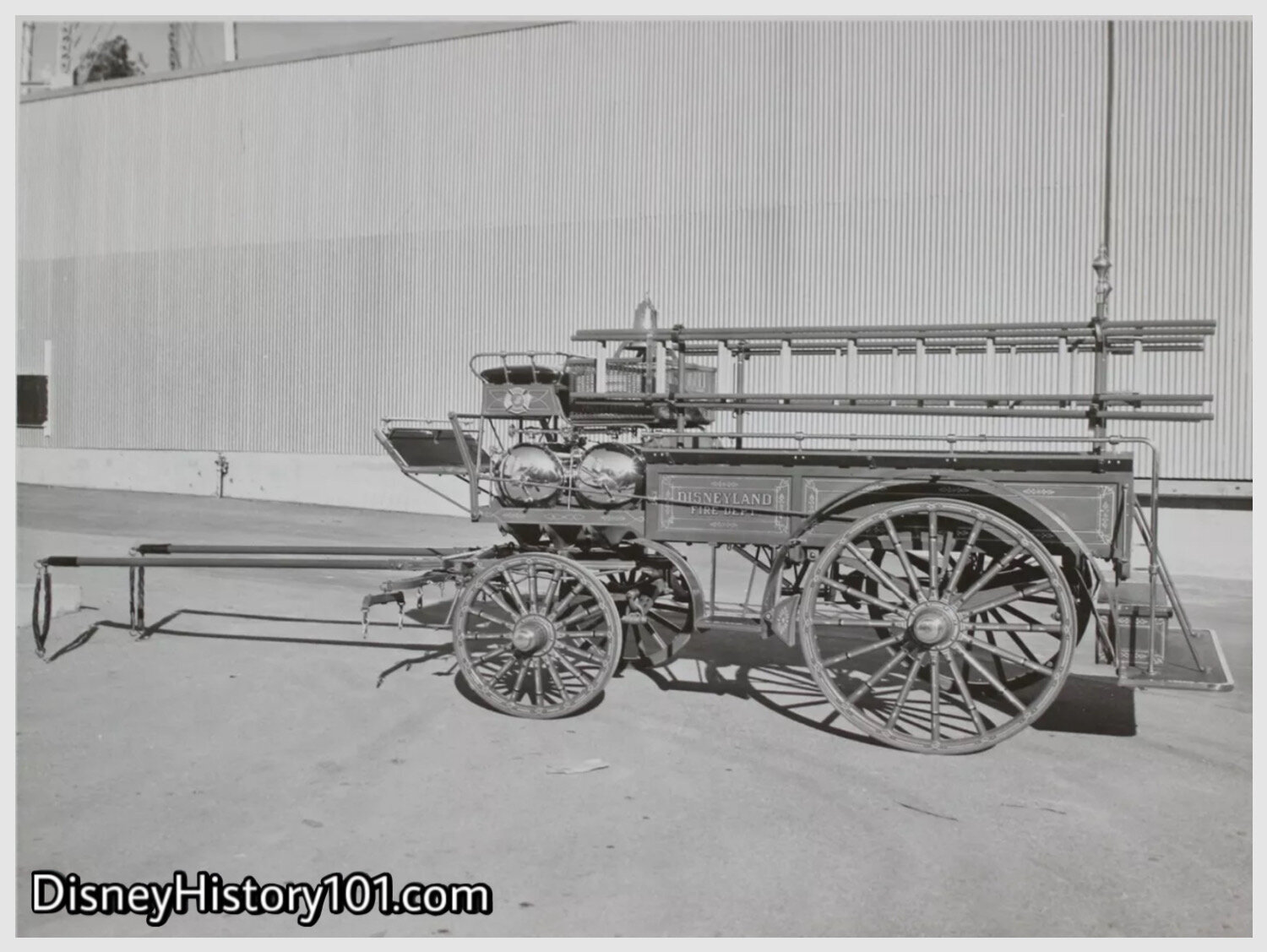
Owen Pope’s Chemical Wagon apparatus at Walt Disney Studios, c. 1955
The Chemical Wagon was one of several horse-drawn vehicles constructed on the Walt Disney Studio Lot. Horse trainer (and temporary Walt Disney Studio resident) Owen Pope helped design this vehicle, while Walt Disney Studio carpenter Ray Fox helped construct this re-imagining of a late nineteenth-century Chemical Wagon.
While one authorized “Disneyland Nomenclature List” (prepared by Bill Cottrell by of Disneyland Inc., May 25, 1955) soon described “1 Horse drawn fire engine” with a “3 horse hitch,” two horses would typically be used to pull the final vehicle. According to “Walt Disney Disneyland” (published 1964): “To recreate a fire engine that might once have answered the alarm in a small American village at the turn of the century, studio men designed a chassis and then poured through standard catalogs for unlikely but practical equipment: a jeep rear axle, a three-speed truck transmission, the power plant of a small pickup truck, standard drive line parts.”
“In 1954, Day Sechler [sic] went to the STUDIO, where he helped Owen Pope make street cars, surreys, stage coaches and even a fire engine.”
Necessary firefighting implements were placed as props, around the apparatus. There were shiny chrome sulfuric acid tanks placed under the driver’s bench. Instead of soda-acid tanks in the rear, guests would sit on one of two rows of benches. The ladders were even rearranged to serve as railings to the passengers.
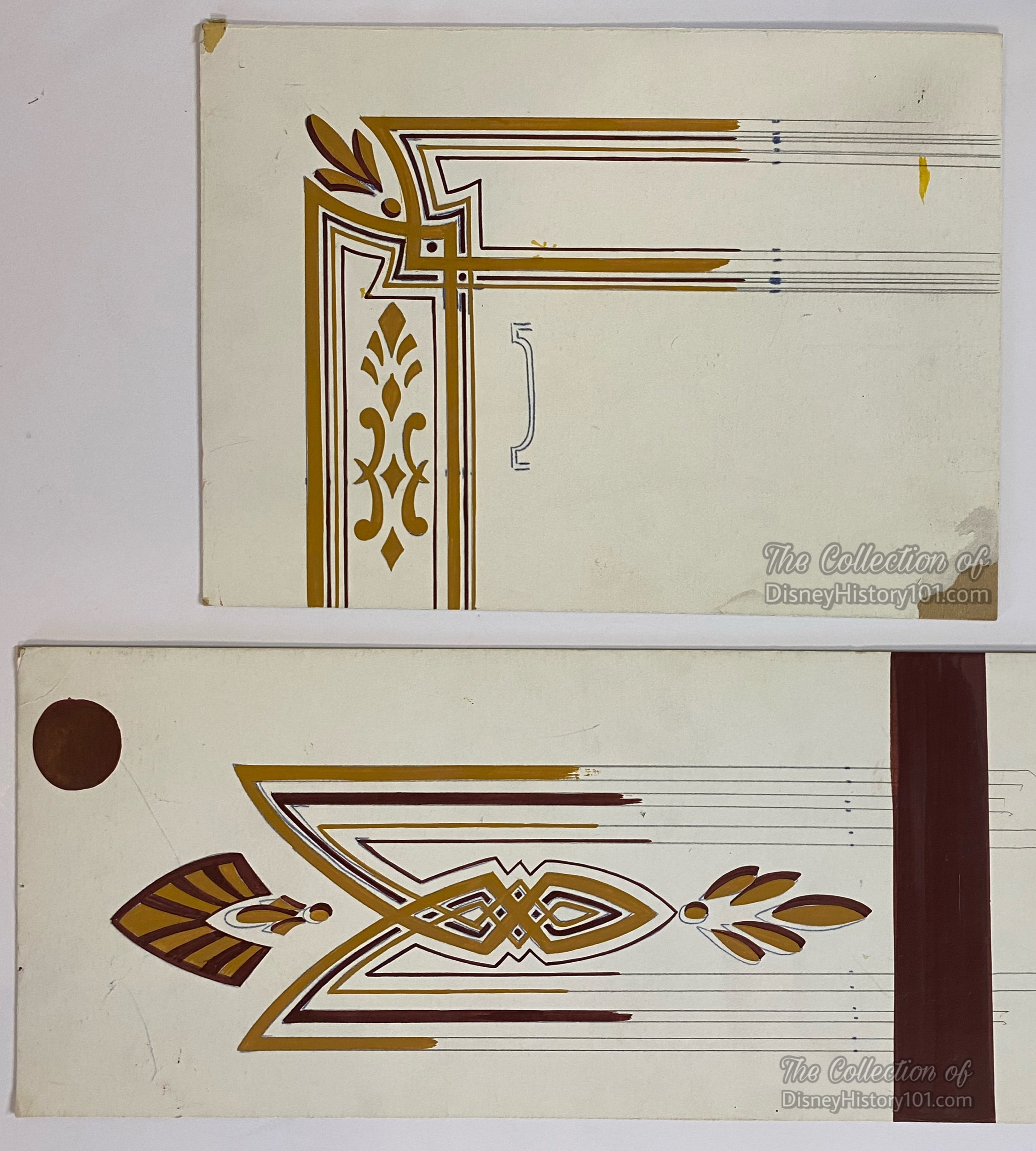
Hand-drawn patterns.

Hand-drawn pin-striping patterns.
There’s a story that speaks volumes of more than the craftsmanship of the Main Street vehicles: “A staff member was concerned that the Main Street vehicles would be vandalized. Walt discarded the notion. ‘Don’t worry about it. Just make them beautiful an you’ll appeal to the best side of people. They all have it… all you have to do is bring it out.” [“The Spirit of Disneyland,” page 43 ; Prepared 1984 by Walt Disney Productions.] And so with an optimistic view of Disneyland Guests in mind, these particular Main Street vehicles were born.
While most employees of Disneyland attended an orientation program, during this era, there were many who worked on The Pony Farm at Disneyland, who did not. Van Arsdale France remembered: “I think I managed to schedule almost everyone through orientation, with one exception. My only failure was with the people who were to operate the horse drawn vehicles. This operation was controlled by a crusty man named Owen Pope, whose headquarters were in what is still called ‘The Pony Farm.’ When I cornered him, he explained by saying, ‘Van, you're dealing with people people. We're horse people out here.’ He finally sent me one or two of his men. But, he was. doing his own training program.”
Before the Park opened, the Belgians, Percheron, Clydesdales, and Shire-Percheron cross-breed draft horses that pulled the Main Street vehicles (the Surreys, and Hose and Chemical Wagon, included) were prepared for the noises that they would hear once On Stage on Main Street (and other parts of Disneyland). Van Arsdale France once wrote: “He [that is, Owen Pope] was worried about the horses ‘spooking’ with all the sights and sounds of Disneyland. So, a recording of sounds from arcades and shooting galleries, and yelling kids made up. This was used as an audio aid for horse training. Since the horses were not directly on the payroll, they had to be carried as assets. All were given names. They all received names of people in accounting.
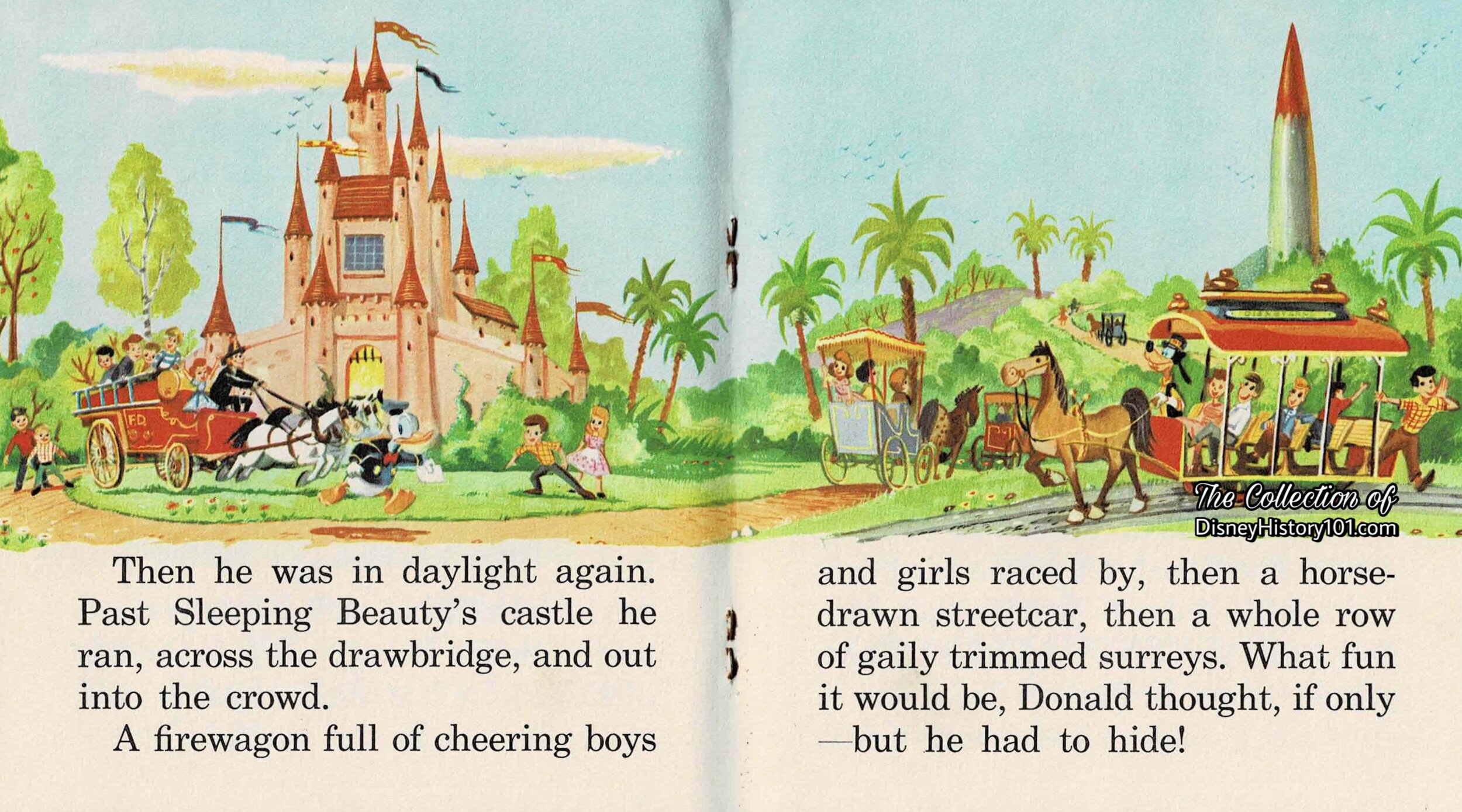
Donald Duck Goes To Disneyland, Whitman Publishing, (c. 1955)
Some pre-opening day licensed merchandise (like the children’s book pictured above) prepared Disneyland guests for adventures in store on July 17th, 1955.
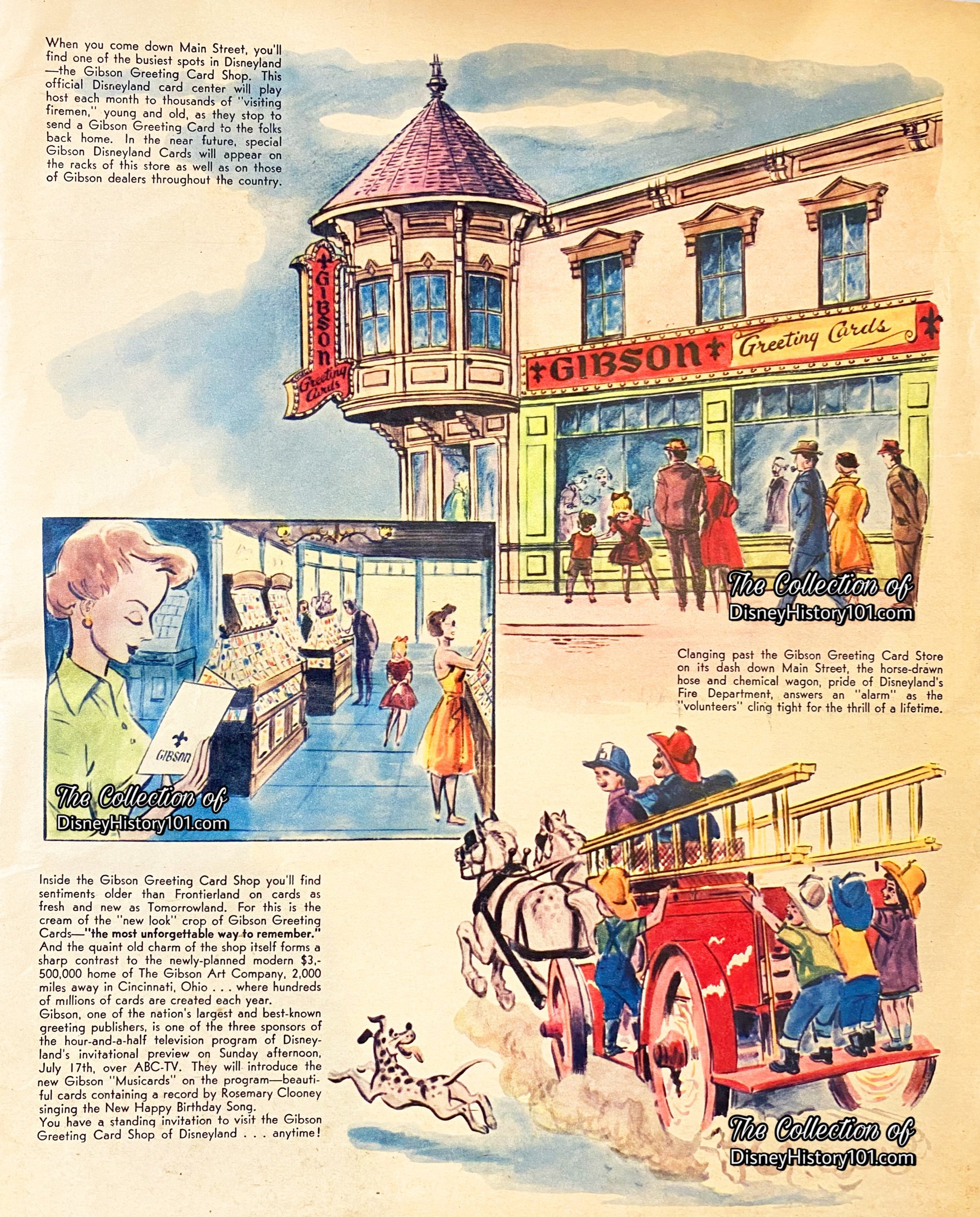
"Disneyland" Supplement Excerpt published July 15, 1955
Two days before the televised Press Preview event at Disneyland, a newspaper supplement (published for July 15th, 1955) included this preview of the “horse-drawn hose and chemical wagon.”
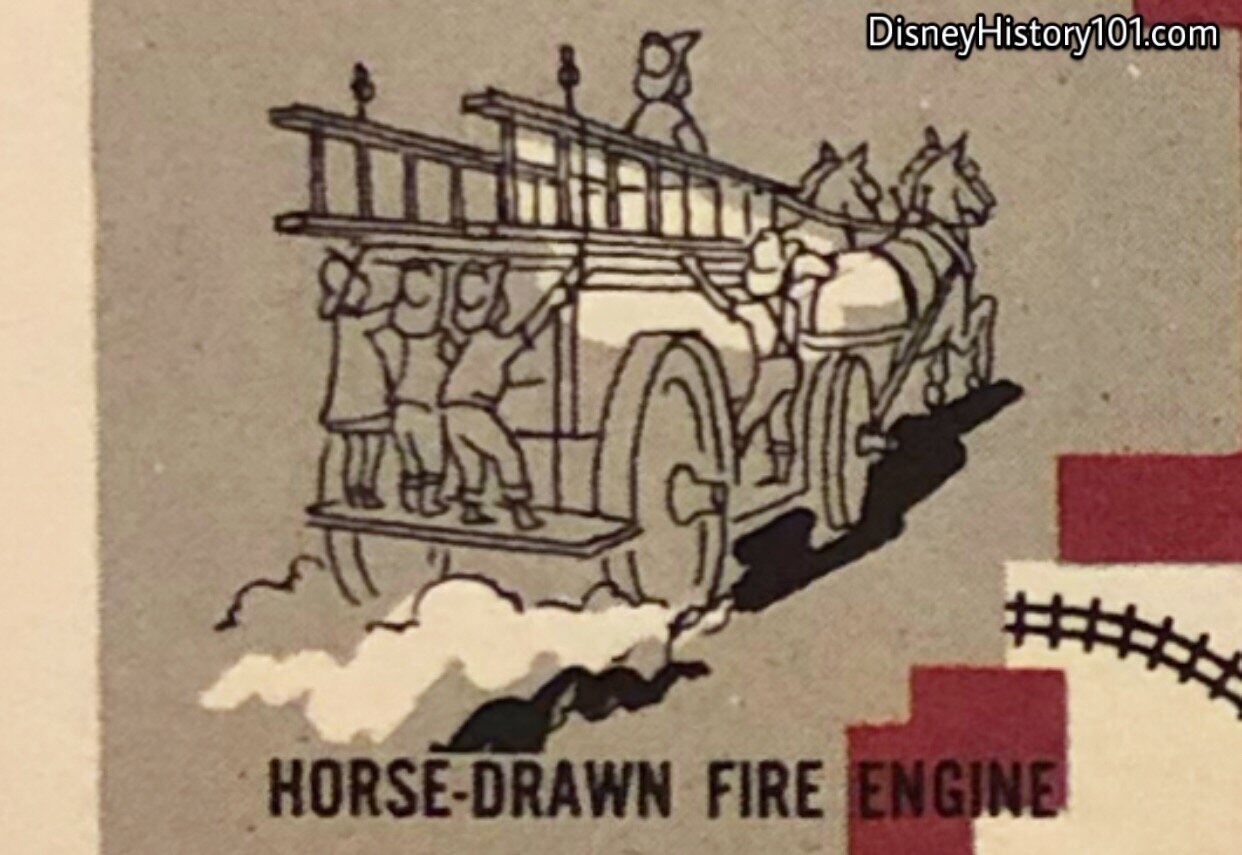
The Chemical Wagon (variously referred to as the Horse Drawn Fire Wagon, and the Horse Drawn Fire Engine) was originally 1 of 22 initial major attractions at Disneyland. In fact, in advertisement for the Park’s many adventures, some box backs of Cheerios featured colorful artwork (in the form of “Disneyland Park Light-Up No. 15”) highlighting the “Fire Company Hook and Ladder on Main Street - Disneyland Park”.

Disneyland Souvenir Book in Natural Color, c.1955.

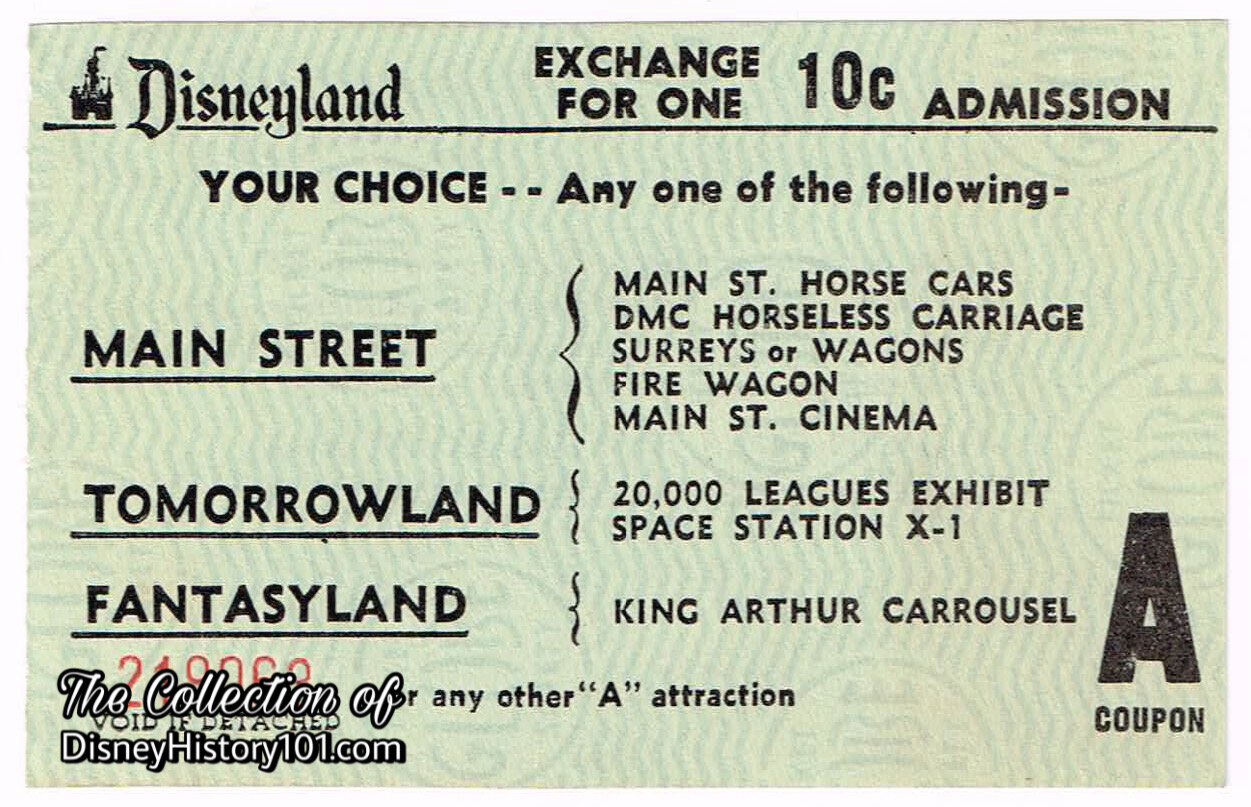
Disneyland "A" Attraction Coupon (10 Cent Value)
The popular Chemical Wagon remained in service to Disneyland for five years (from July 17, 1955 - September 11, 1960), before being retired. During this time, admission for a one-way ride (during 1958), was one “jumbo” “A” coupon (the price of 10¢, for one adult) - the same as the 20,000 Leagues Under the Sea Exhibit, the Omnibus, or the later “motorized Fire Wagon”!
By October 1958, the “Disneyland Dictionary” commented: “There is one (1) horsedrawn fire engine, typical of the 1900’s. (operates in peak seasons.)” As to the route, the same publication states: “Town Square, down Main St., Circles Plaza. Return trip - Plaza, Main Street to Depot. Serves as Main Street transportation.”
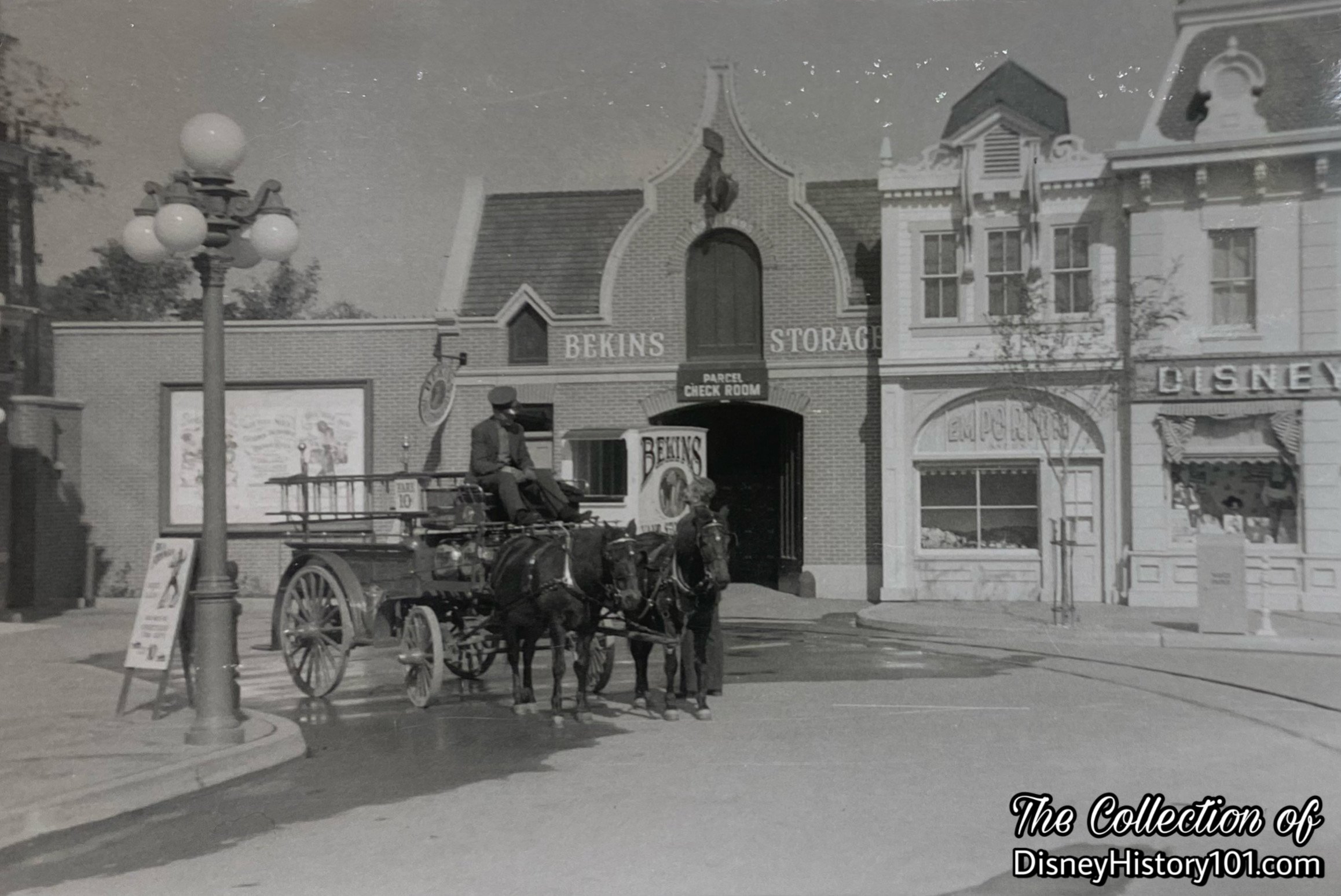
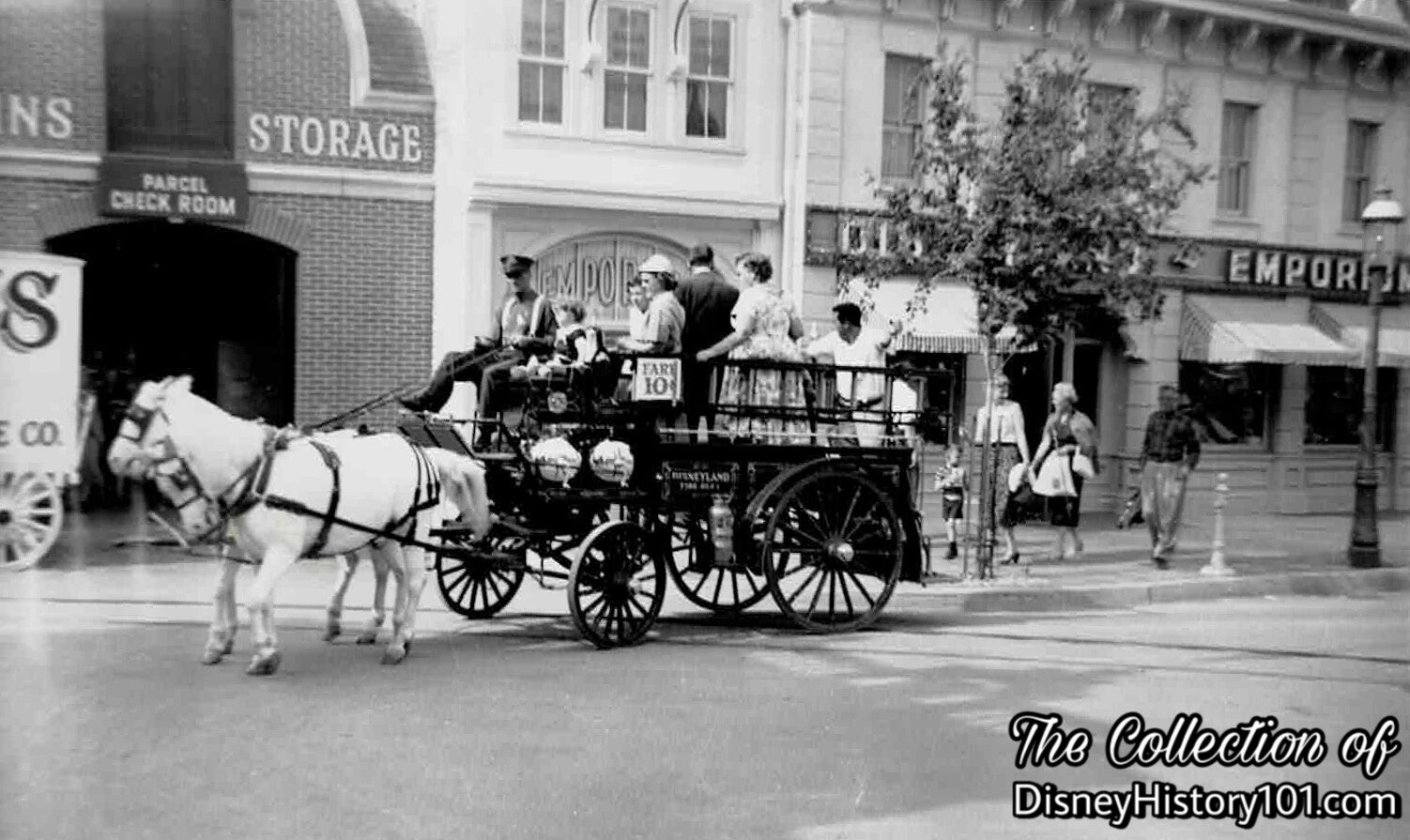
Disneyland Fire Wagon and Guests Pulled by Shetland Ponies, (1956)
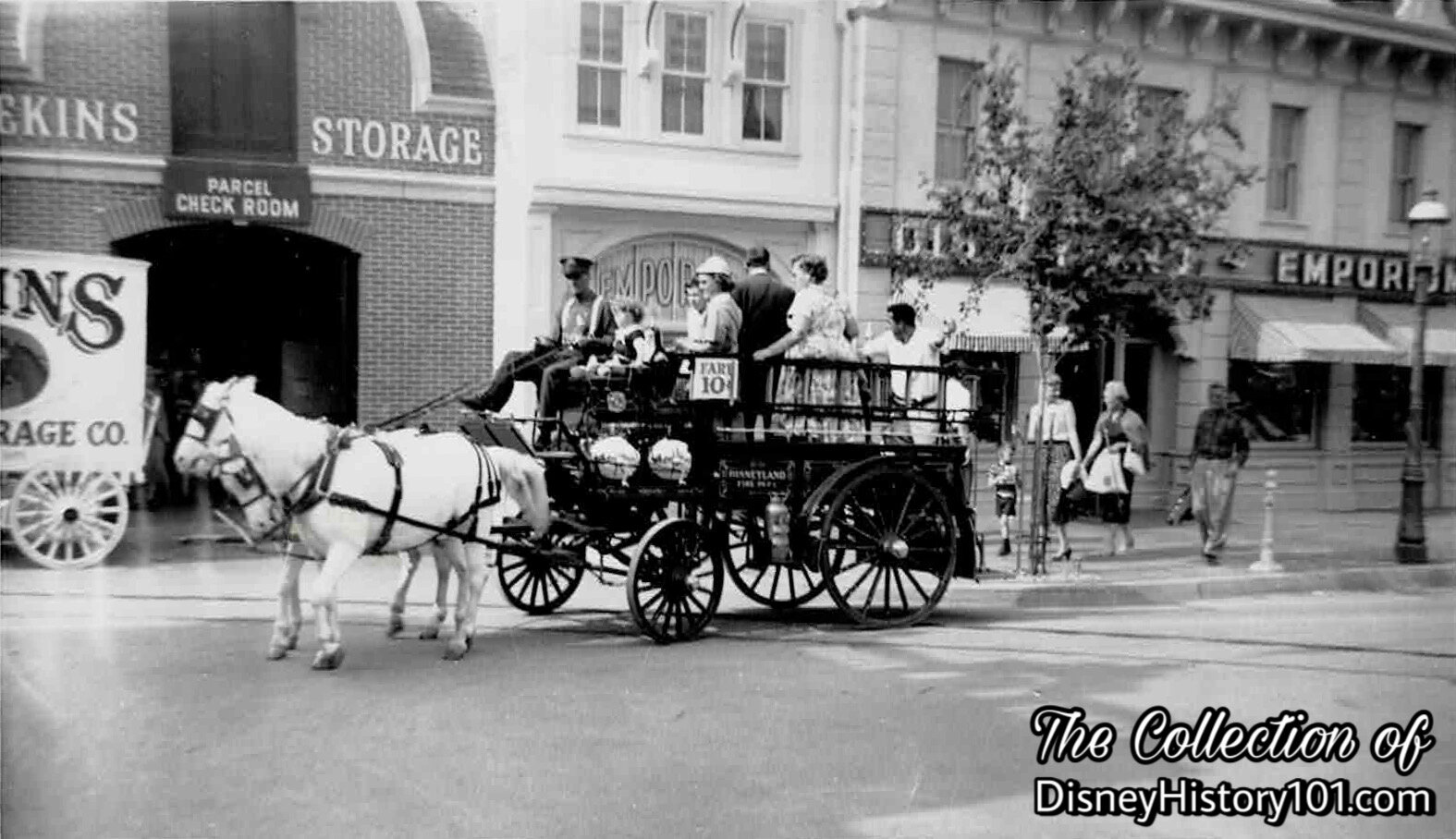
Disneyland Fire Wagon and Guests Pulled by Shetland Ponies, (1956)
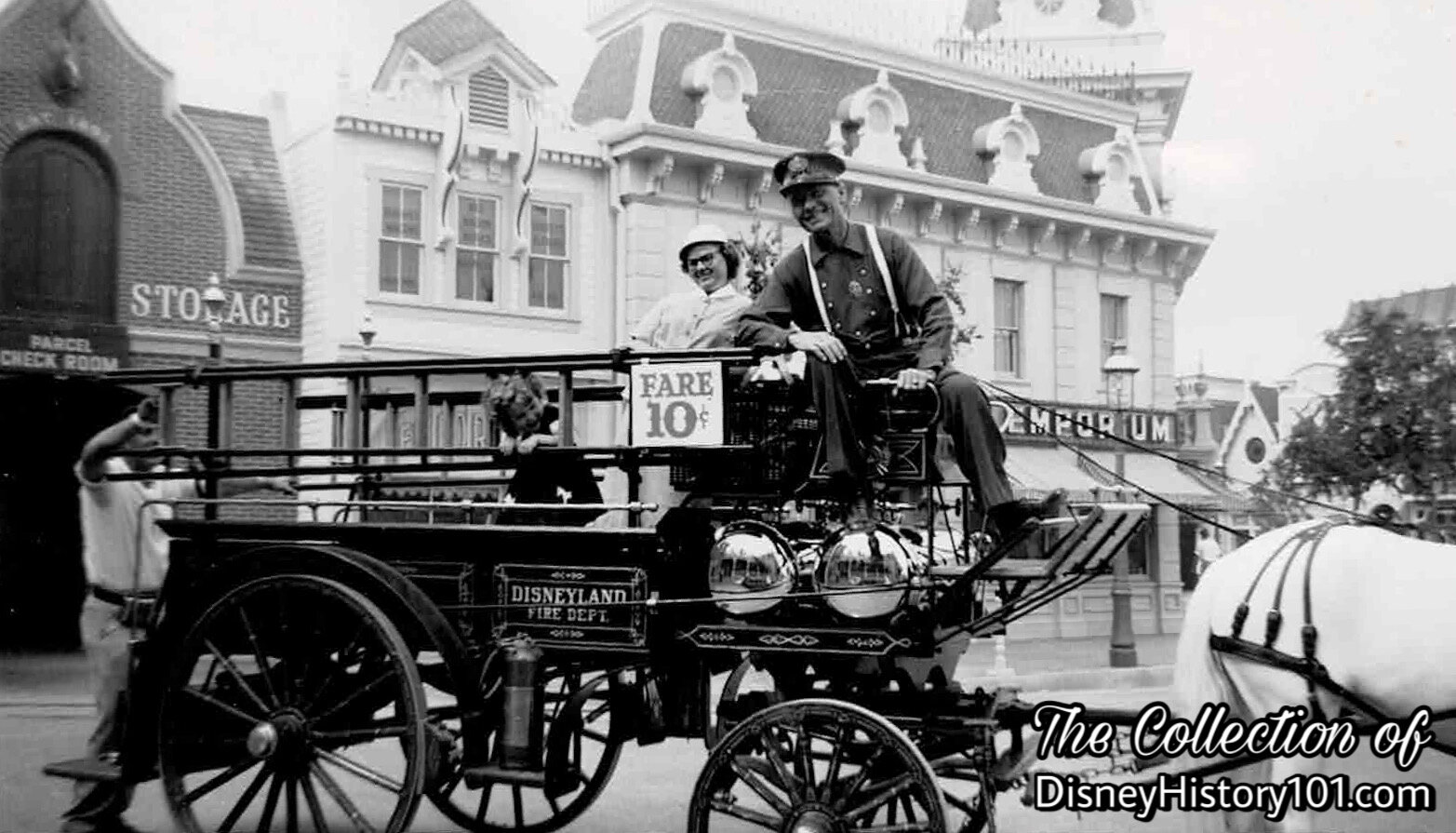
Disneyland Fire Wagon, Attractions Host, and Guests Pulled by Shetland Ponies, (1956)
A Disneyland Fire Wagon Driver proves that a smile was essential, and a genial and friendly personality was the Disney style.
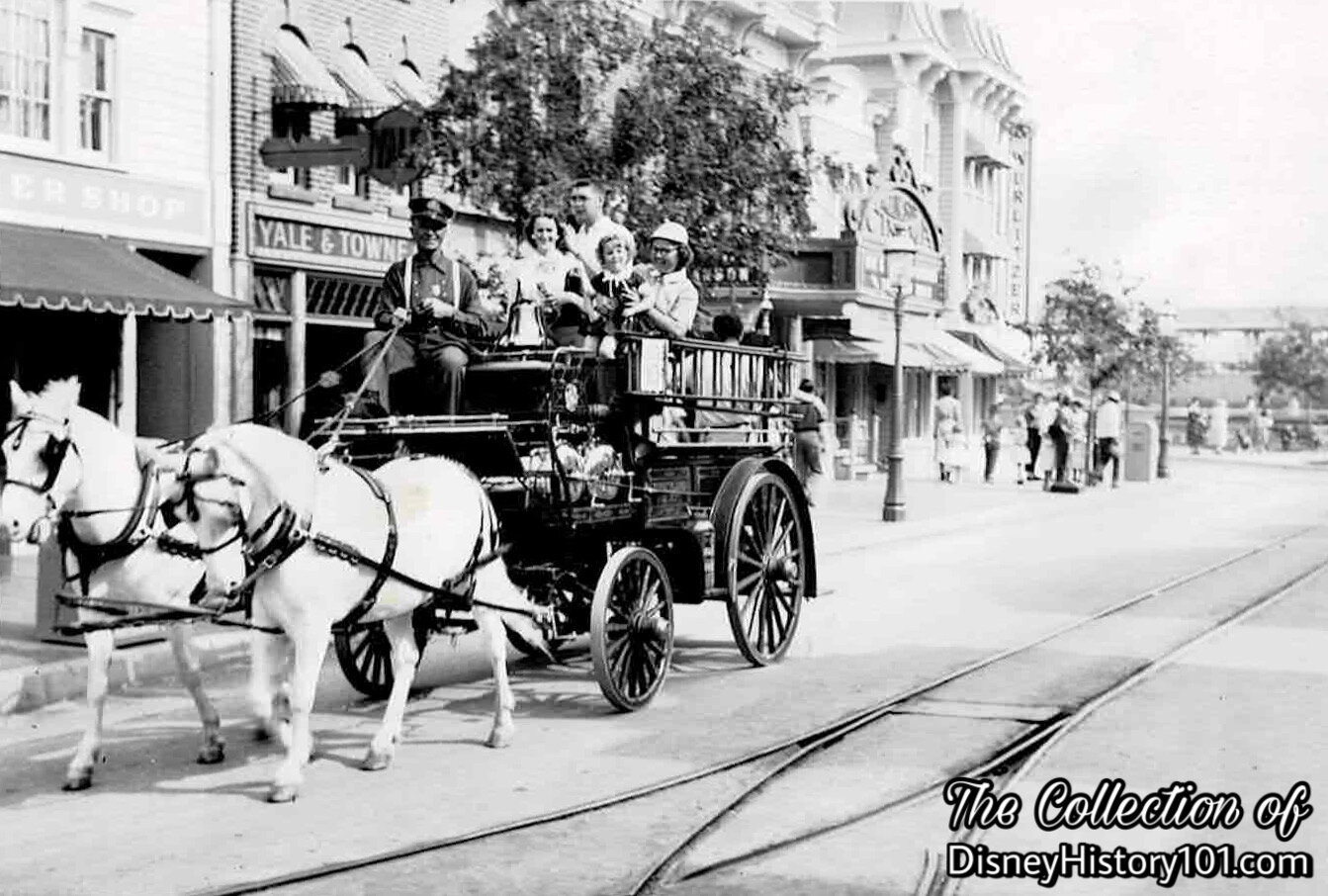
Disneyland Fire Wagon and Guests Pulled by Shetland Ponies, (1956)

Fire Wagon Operator, (1956)
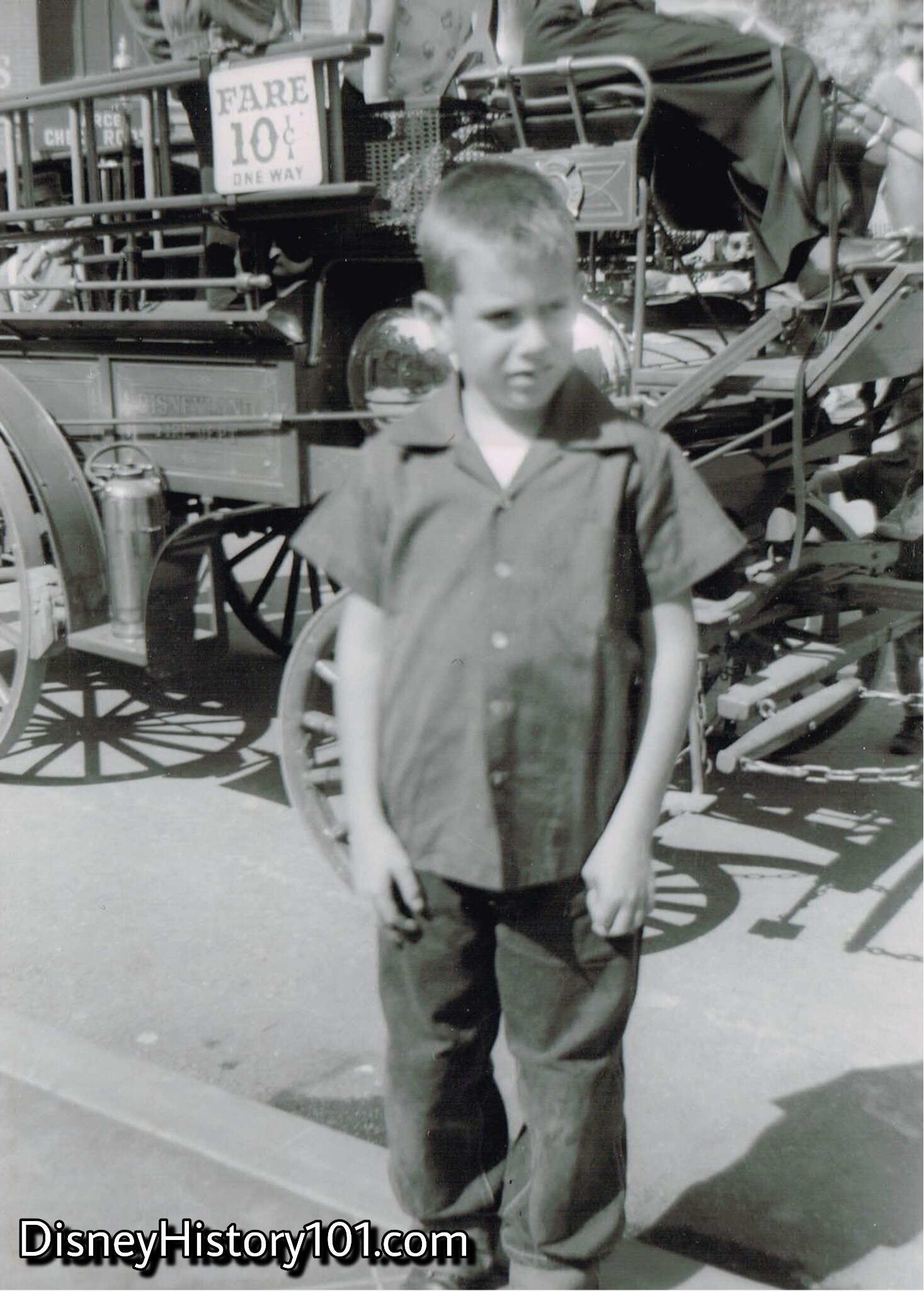
Disneyland Guest & Disneyland Fire Wagon, (1956)
This young honorary fireman looks like he’s “ready to answer the call”. Are YOU ready to answer the call?
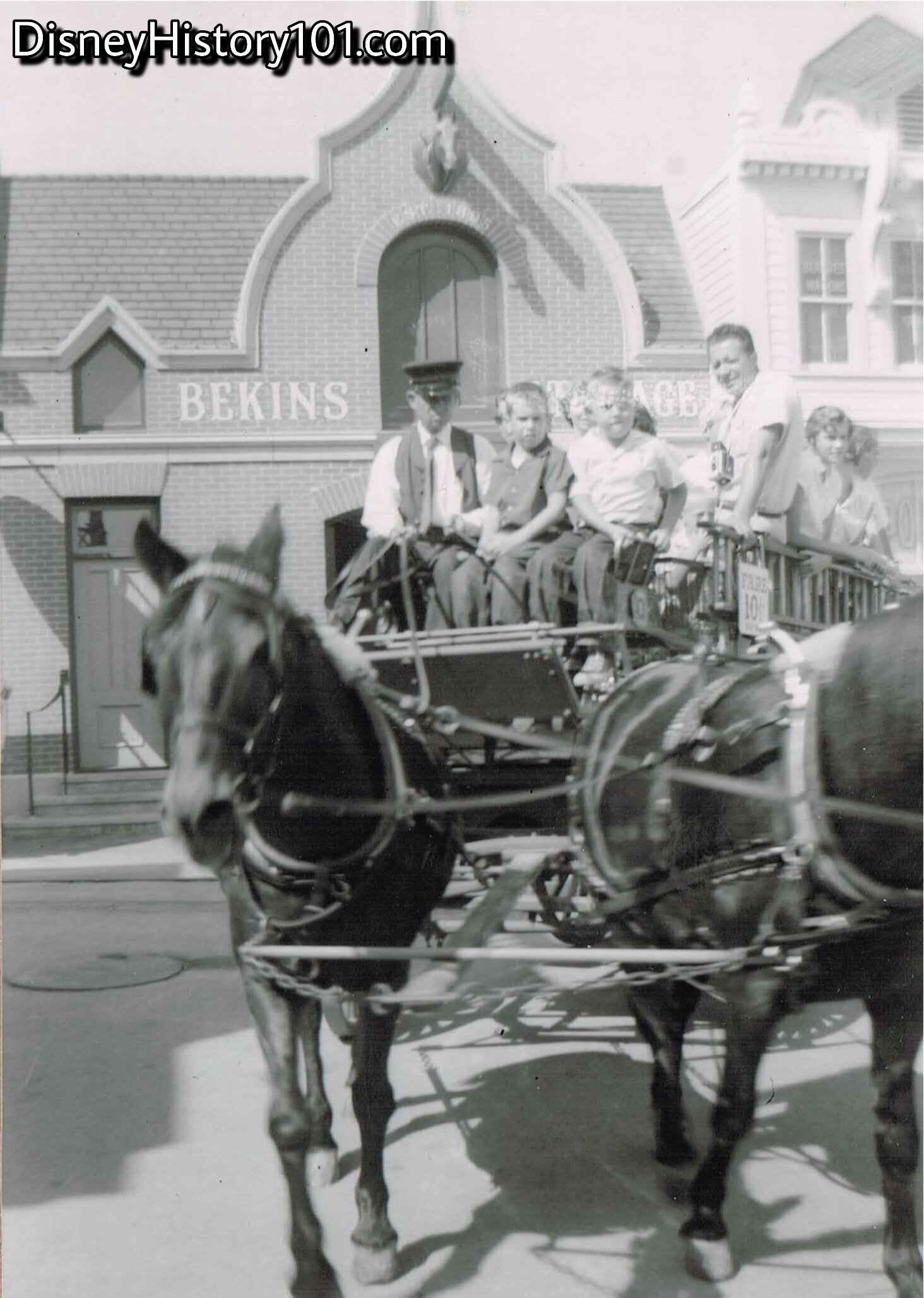
The Disneyland Fire Wagon, Attractions Host, and Guests Pulled by Hackney Ponies, (1956)
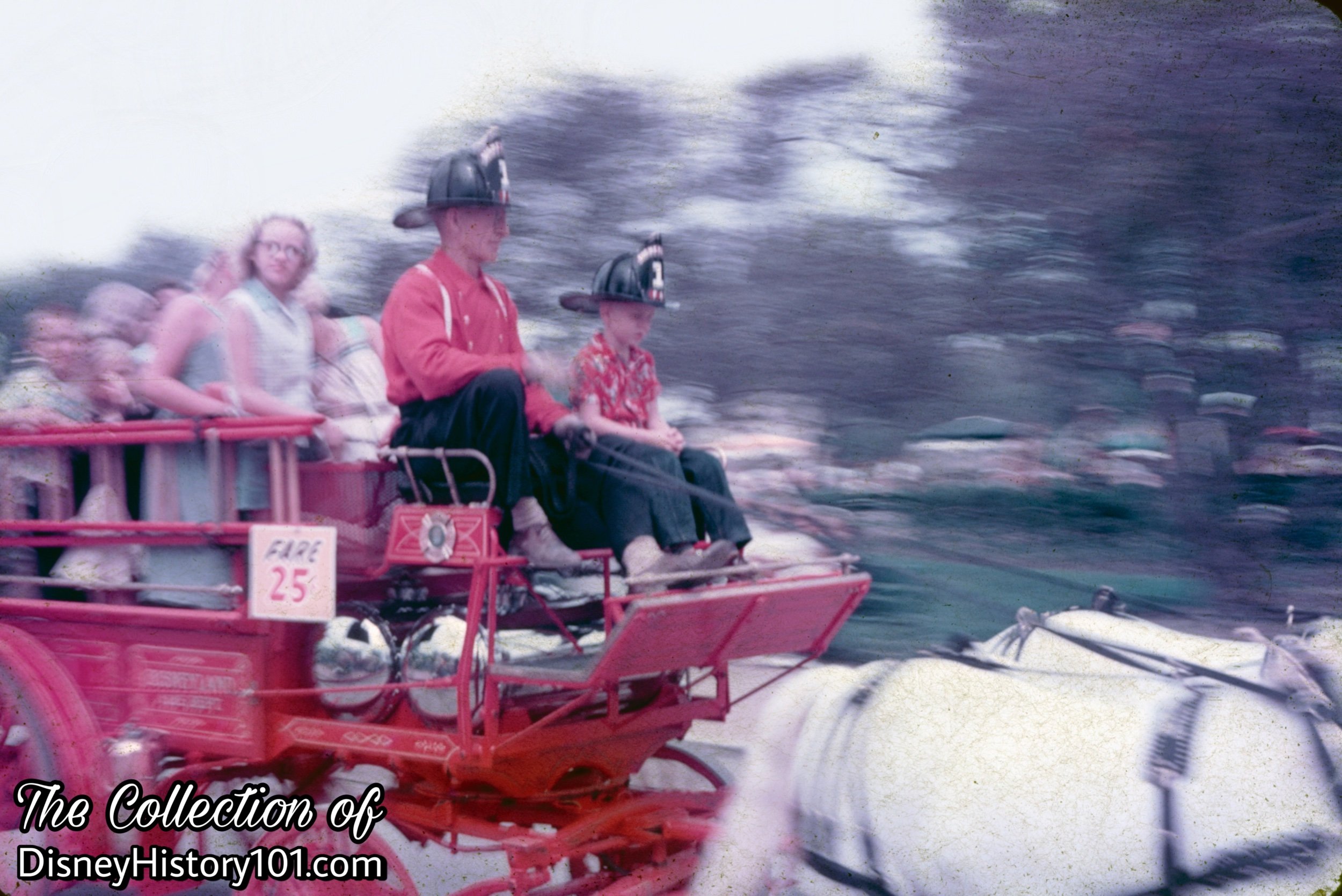
Engineer and a junior firefighter.
“Yes-Junior, and even Dad can answer an ‘alarm’ and ride to a ‘fire’ behind the department's gallant steeds.”
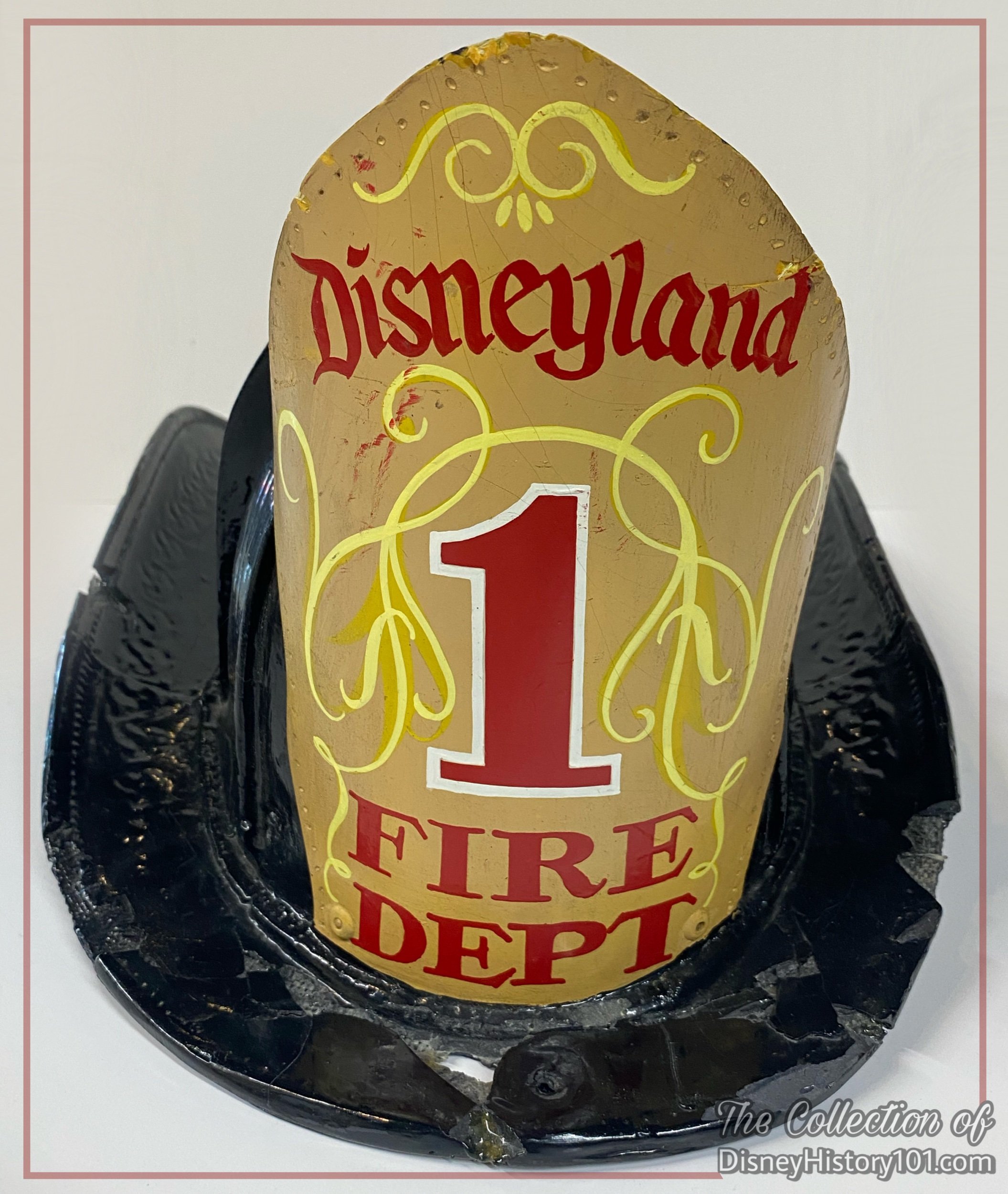
A prop hat similar to those worn by the Chemical Wagon Drivers and Guests.
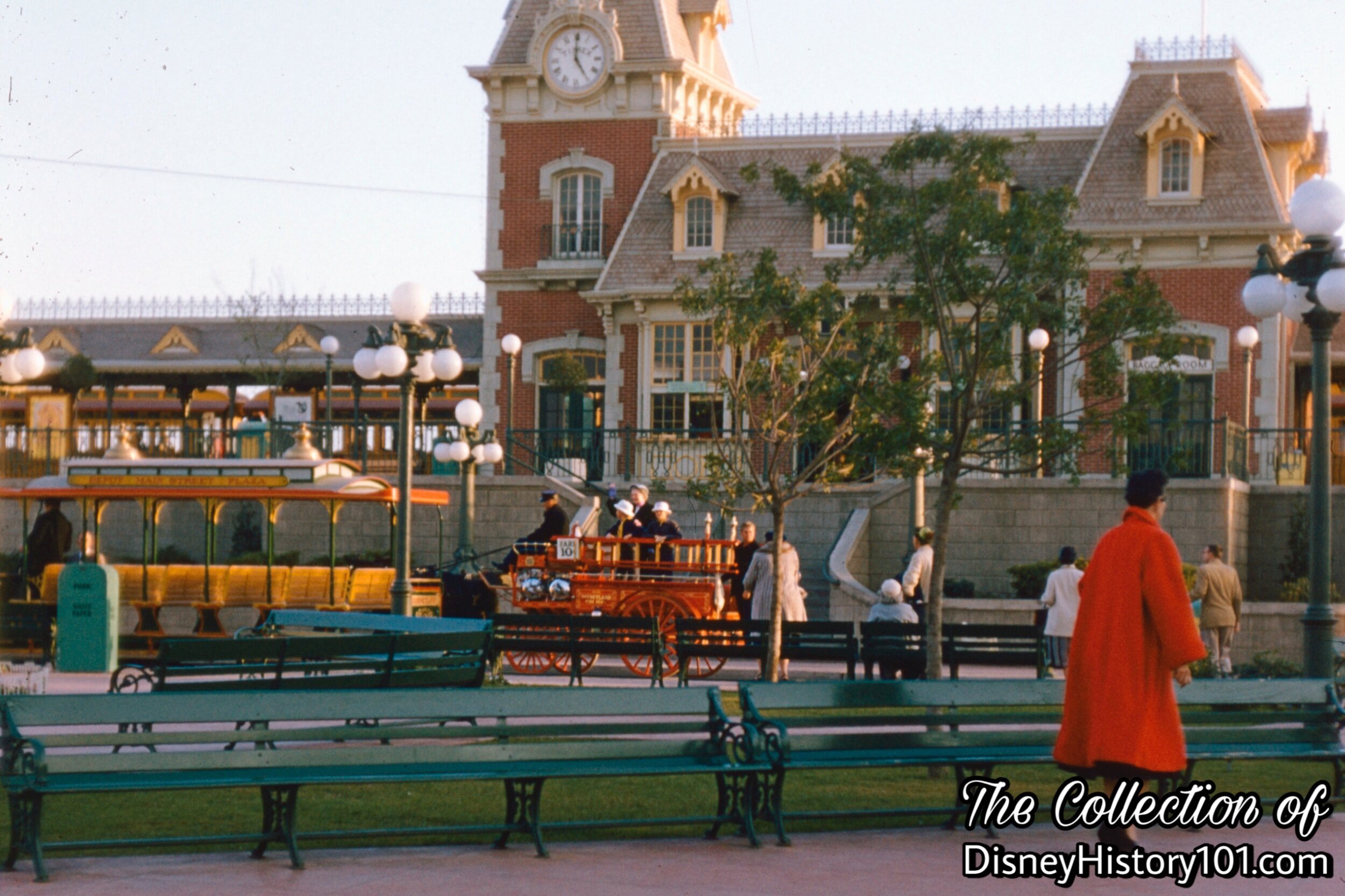
Disneyland Fire Wagon
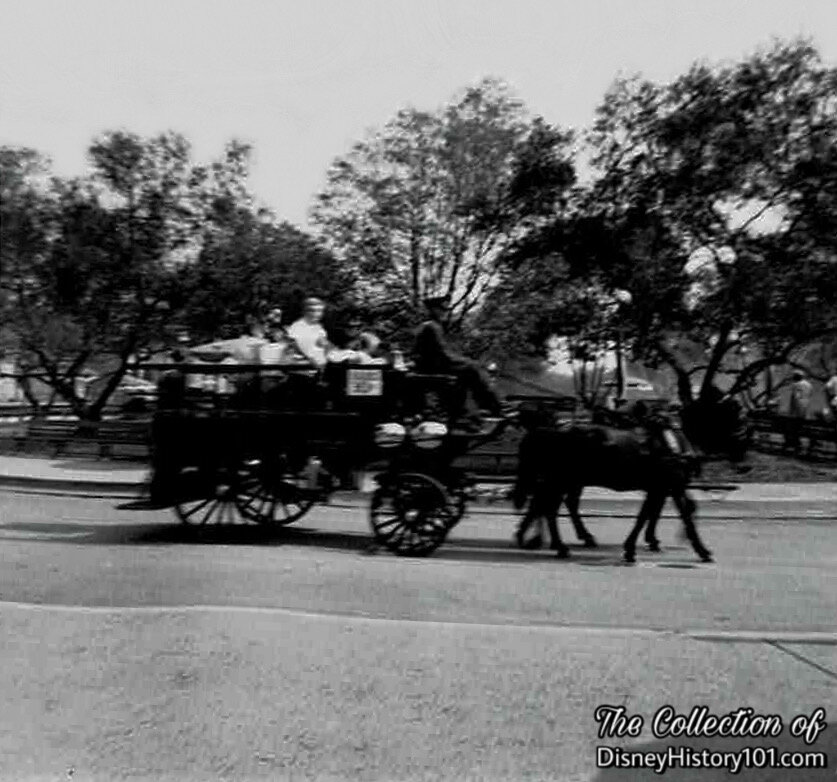
Disneyland Fire Wagon and Guests Pulled by Hackney Ponies.
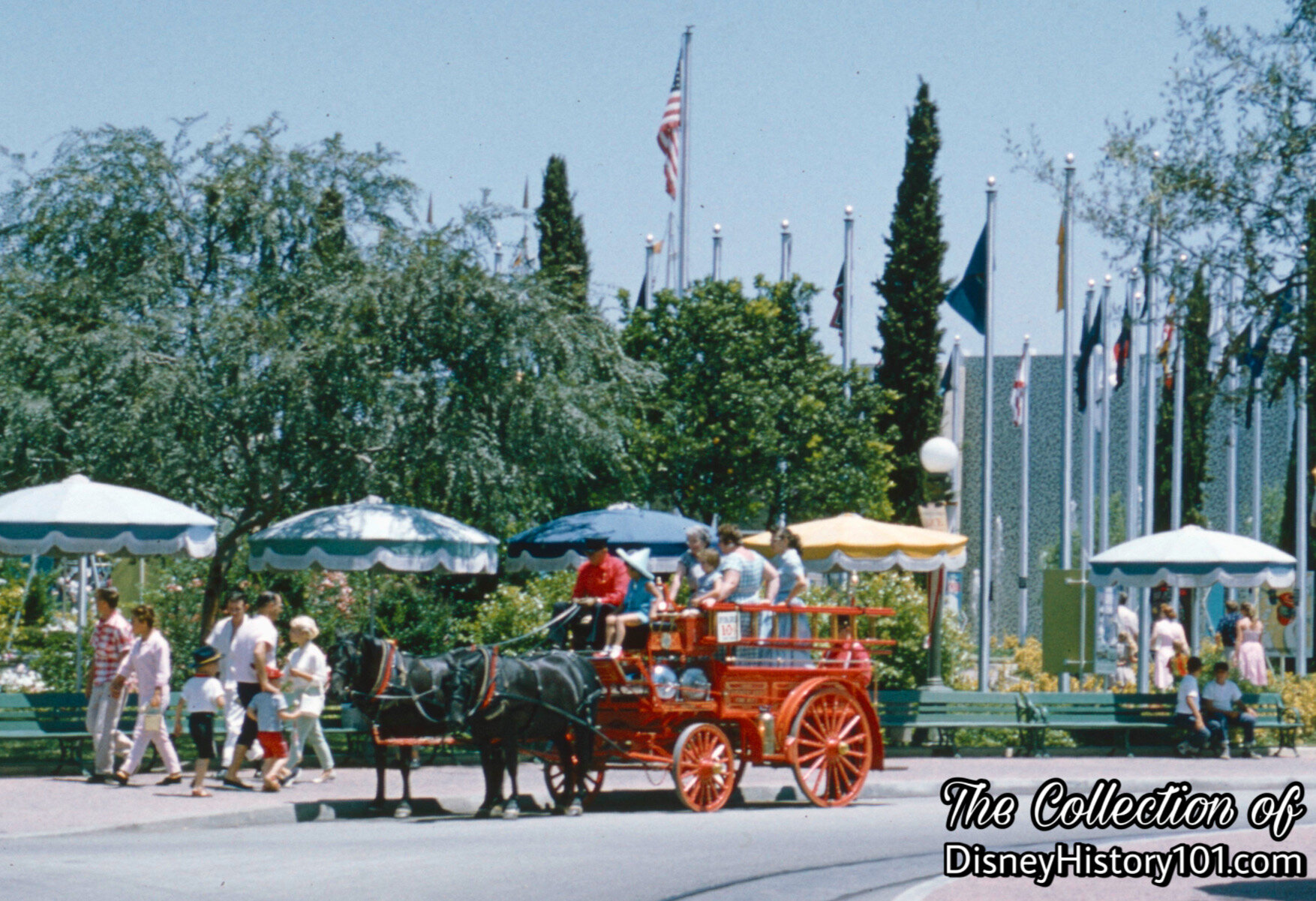
Disneyland Fire Wagon and Guests
By September 28, 1958, Bank of America appraised the Fire Wagon (considered a Park Asset) and valued it at $6,056.
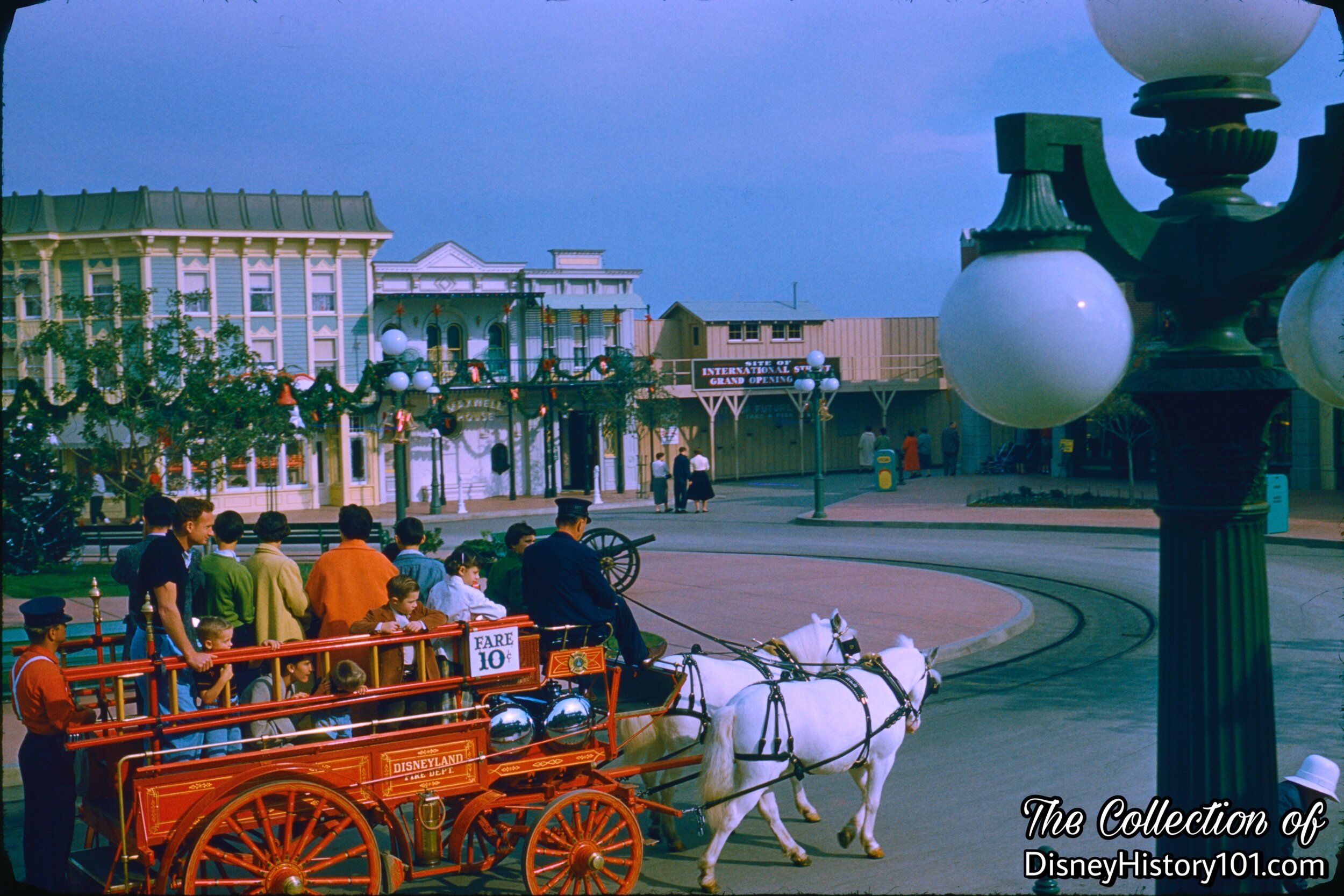
Fire Wagon Pulled by Shetland Ponies Through Town Square, (December, 1956)
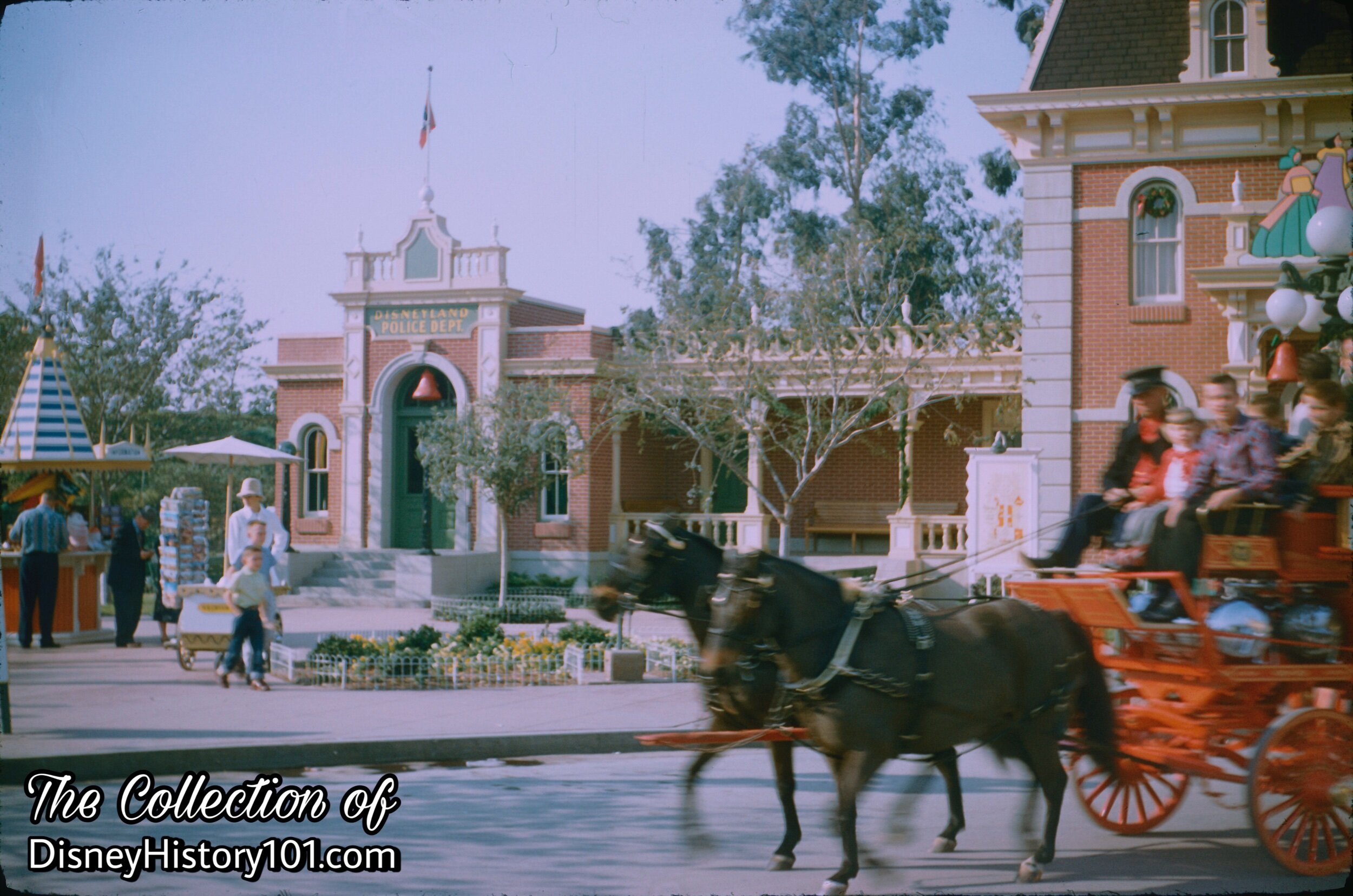
Disneyland Fire Wagon and Guests Pulled by Hackney Ponies, (December 30, 1956)

Disneyland Fire Wagon and Guests Pulled by Hackney Ponies
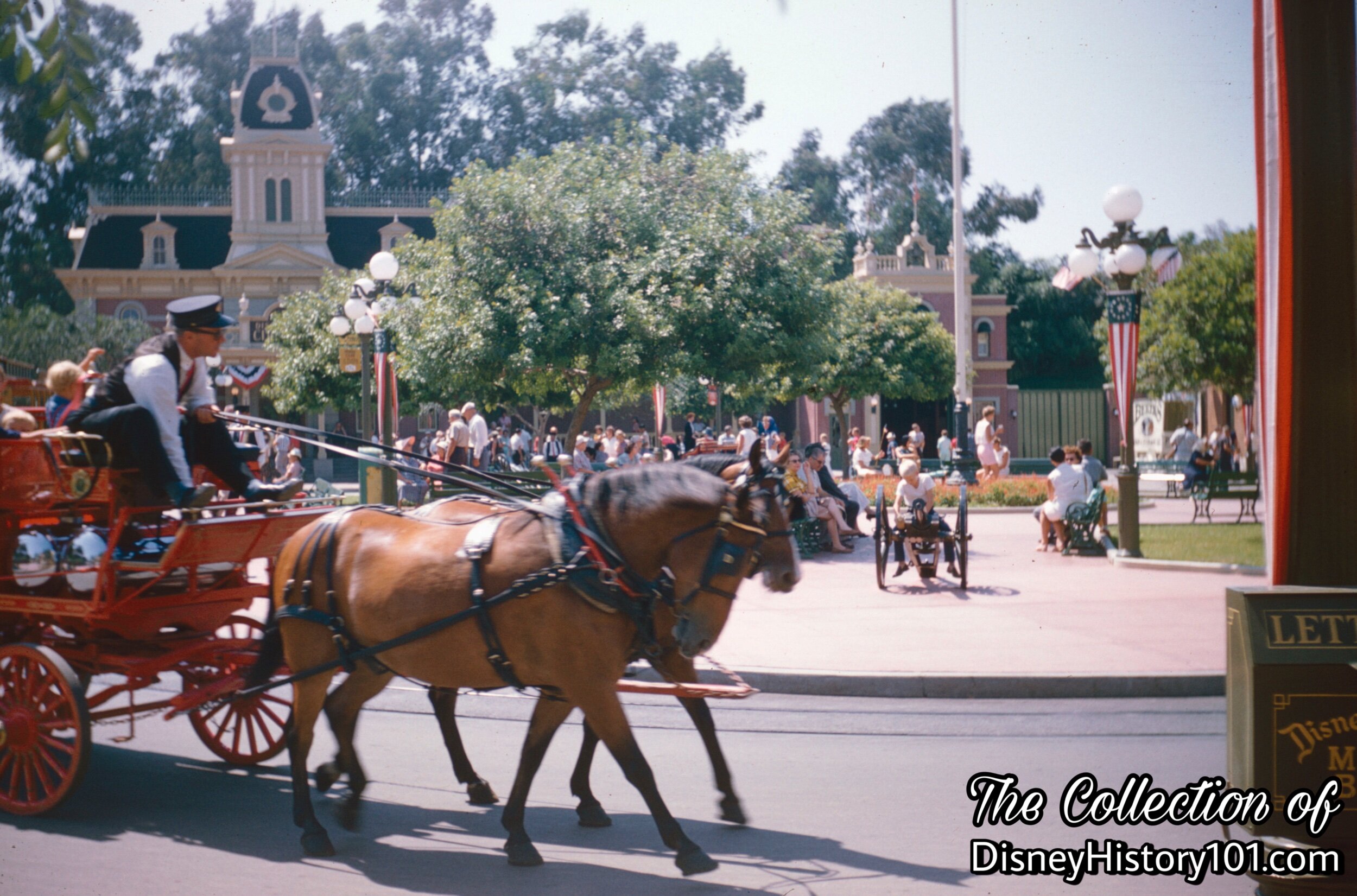
Disneyland Fire Wagon and Guests Pulled by Hackney Ponies
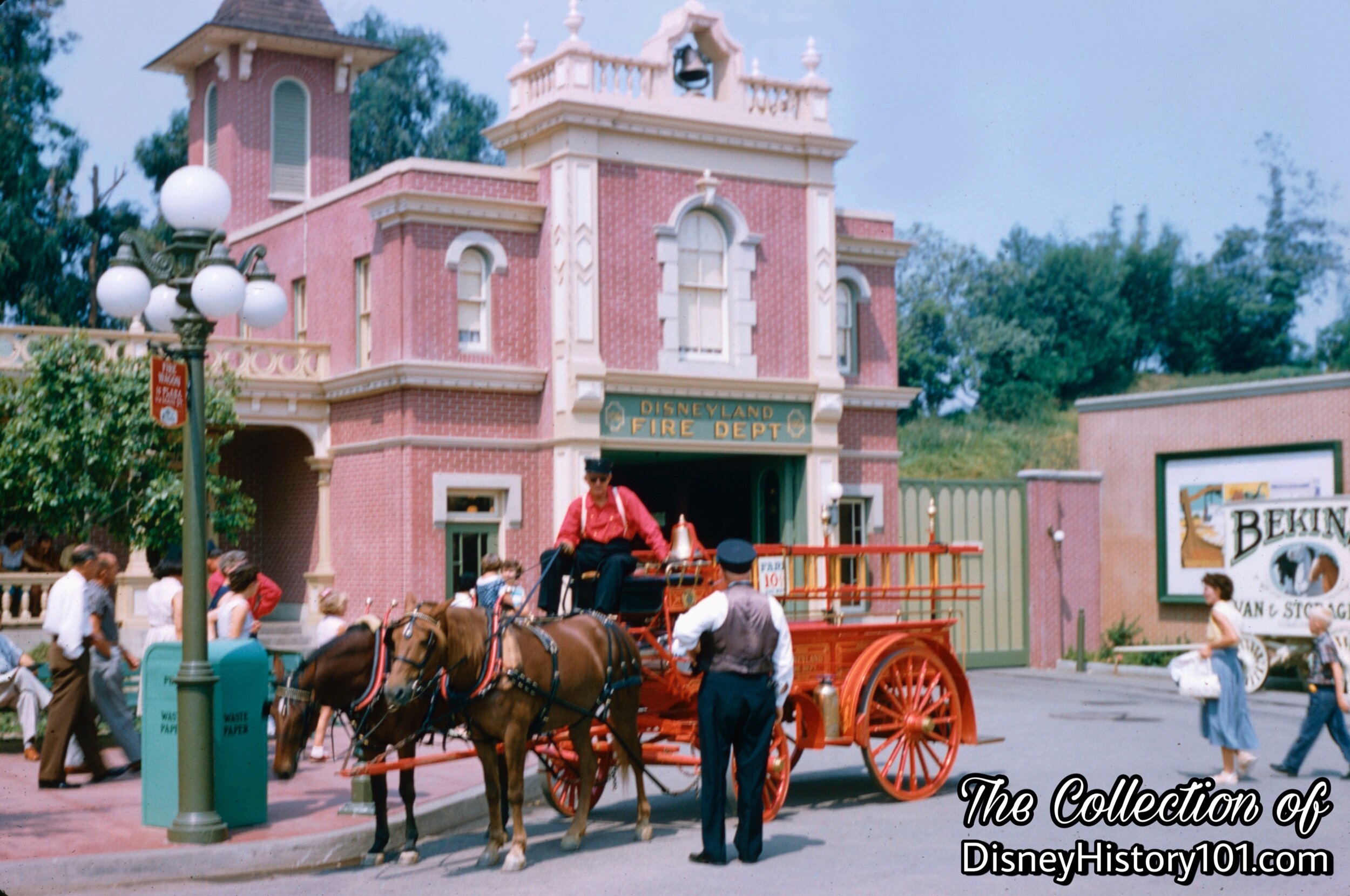
Fire Wagon & Hackney Ponies in Front of The Disneyland Fire Dept.
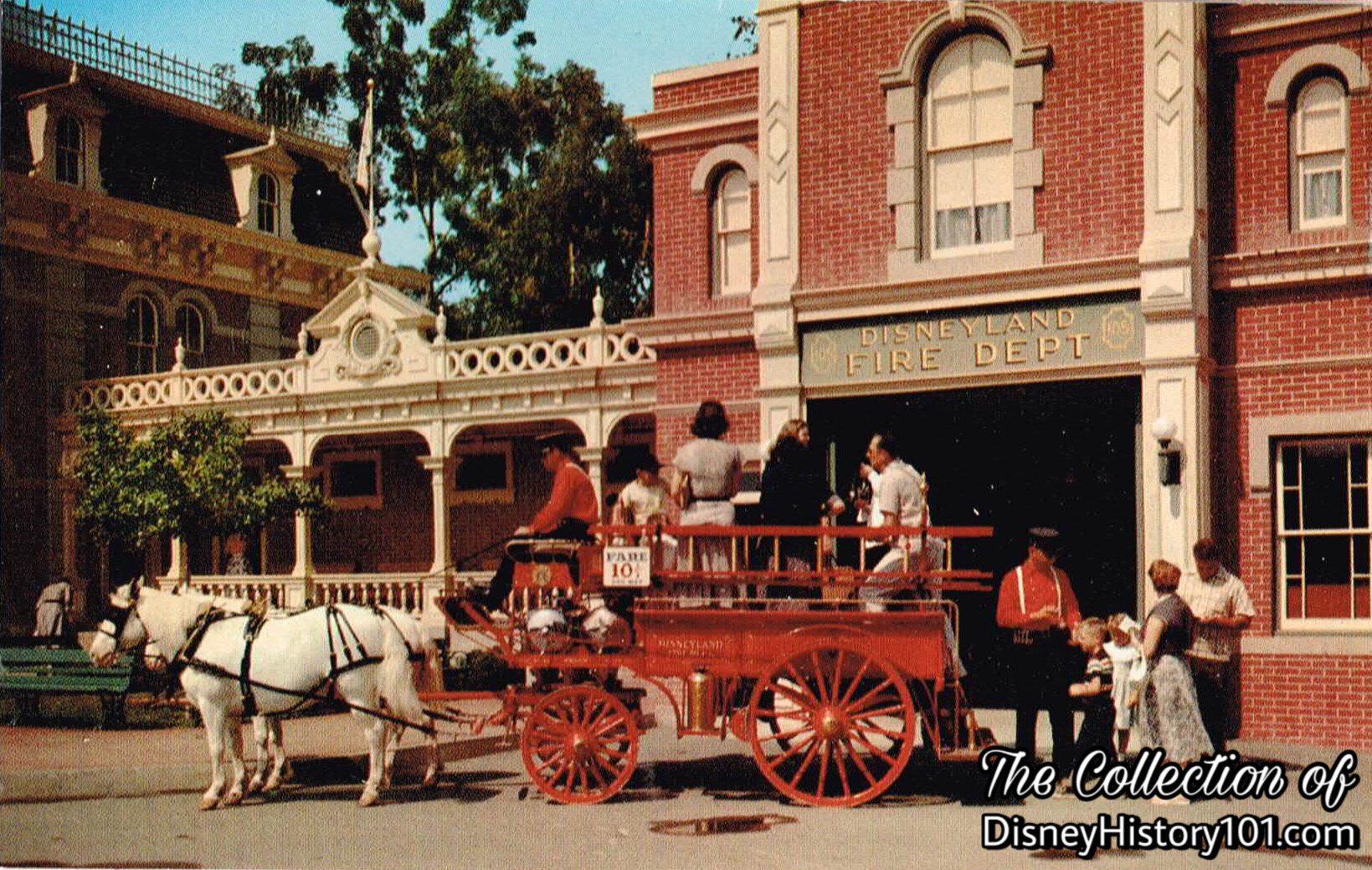
Disneyland Chemical Wagon & Shetland Ponies Postcard Image
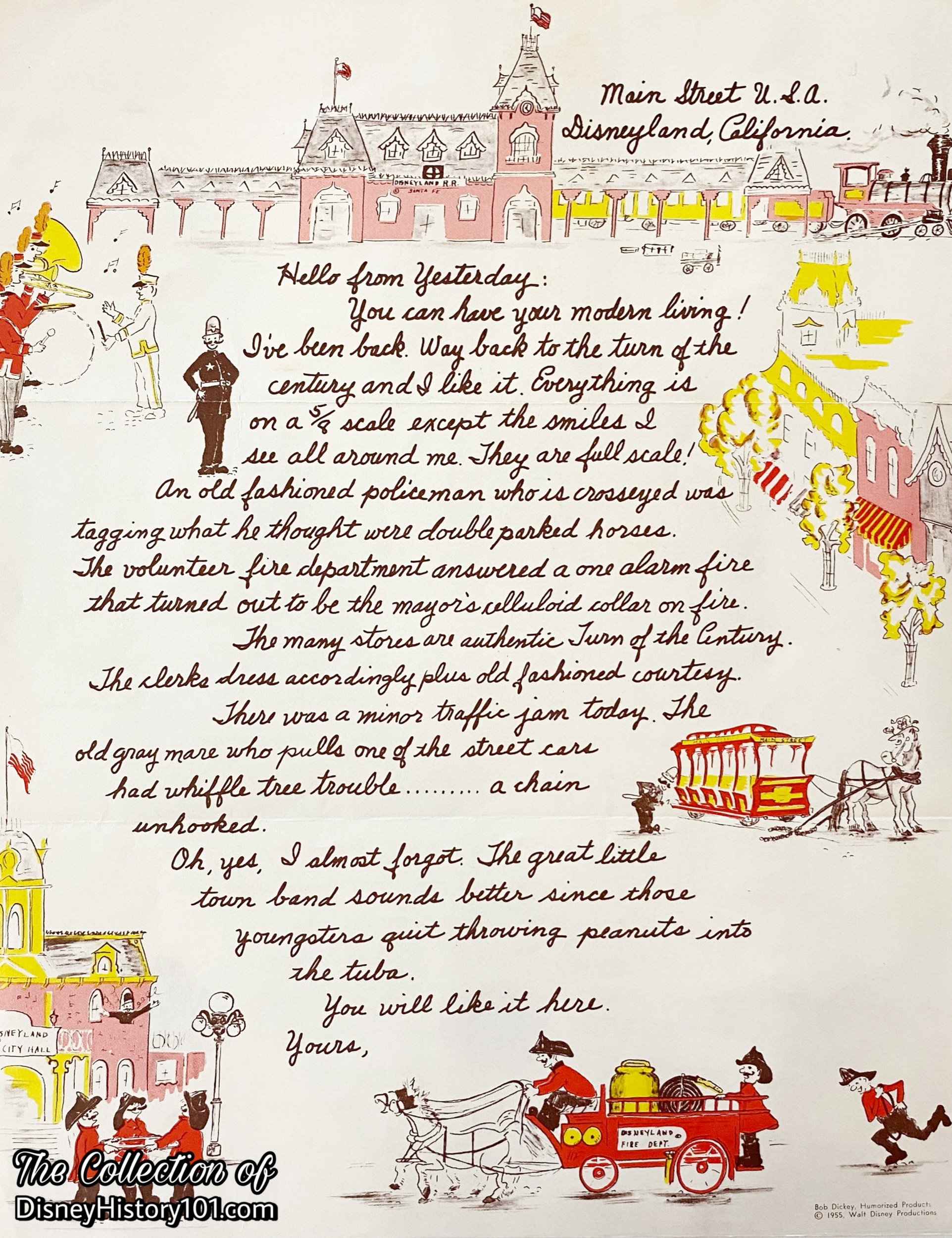
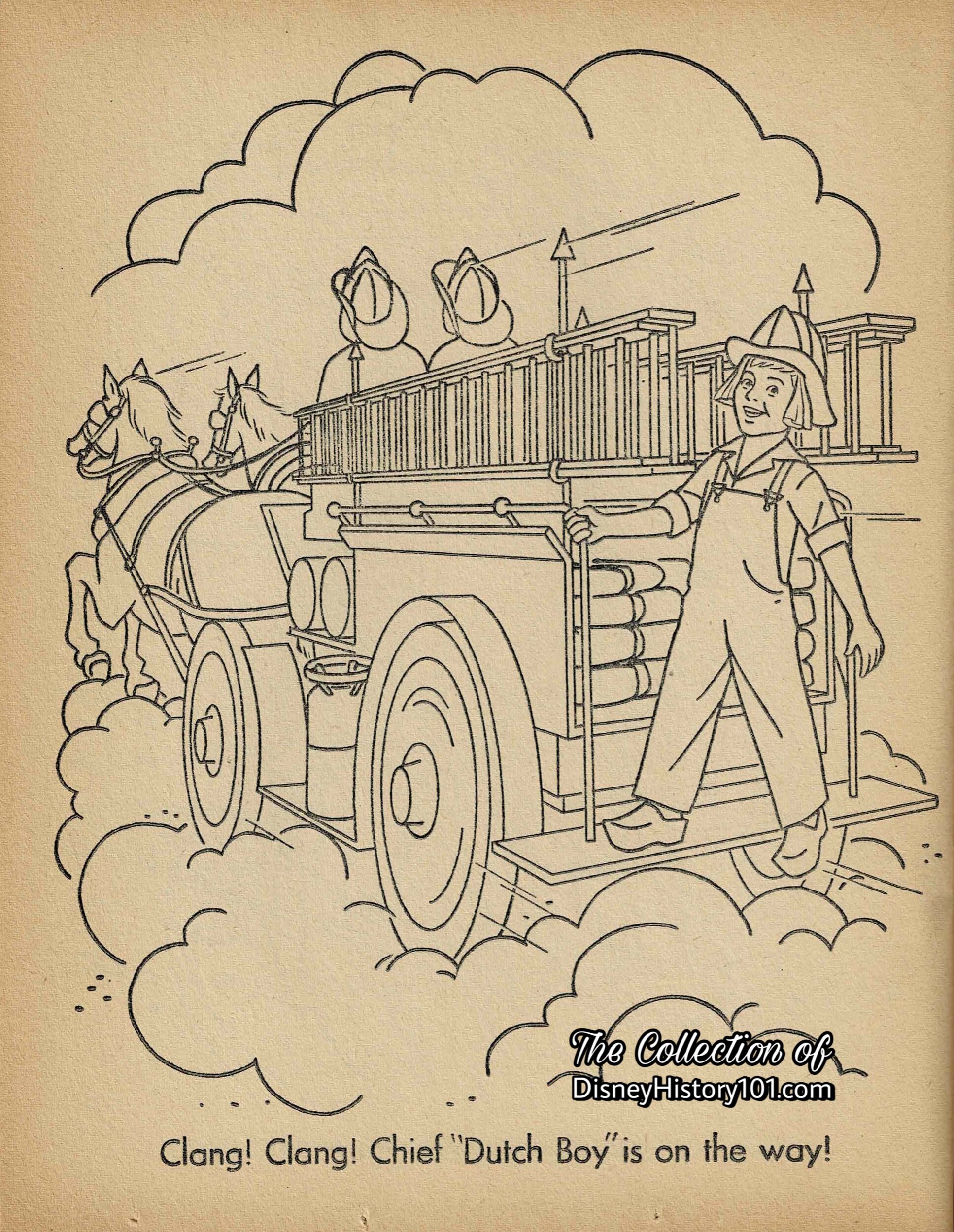
"The Dutch Boy Disneyland Coloring Book", (published 1957)
The Chemical Wagon was even featured in “The Dutch Boy Disneyland Coloring Book” (published 1957). As mentioned, the popular Chemical Wagon remained in service to Disneyland for five years (from July 17, 1955 - September 11, 1960), before being retired. By the time the Horse Drawn Fire Wagon had ceased operation, it had transported a grand total of 379,969 guests down Main Street U.S.A.!
By 1966, only brief mention of the Horse-Drawn Fire Wagon is made in the pages of “Main Street Vehicles” (published 1966 by Disney University), where it states, “the Horse Drawn Fire Wagon… in the Fire Station at City Hall is authentically reproduced from pictures. The hats, axes, and other props are authentic. The wagon is part of the show, but is not used on Main Street to carry guests.”
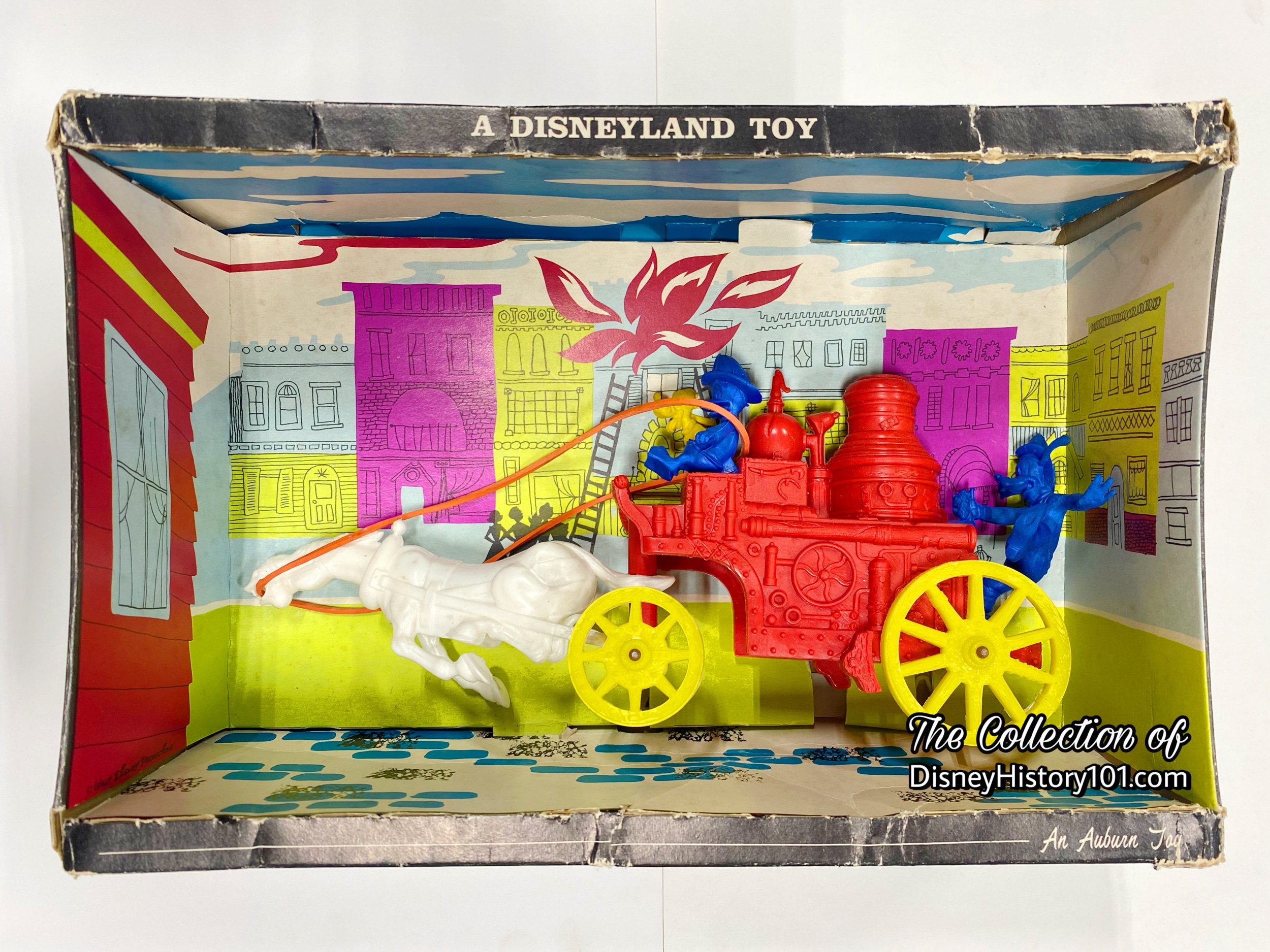
A Disneyland Toy by Auburn Toy.
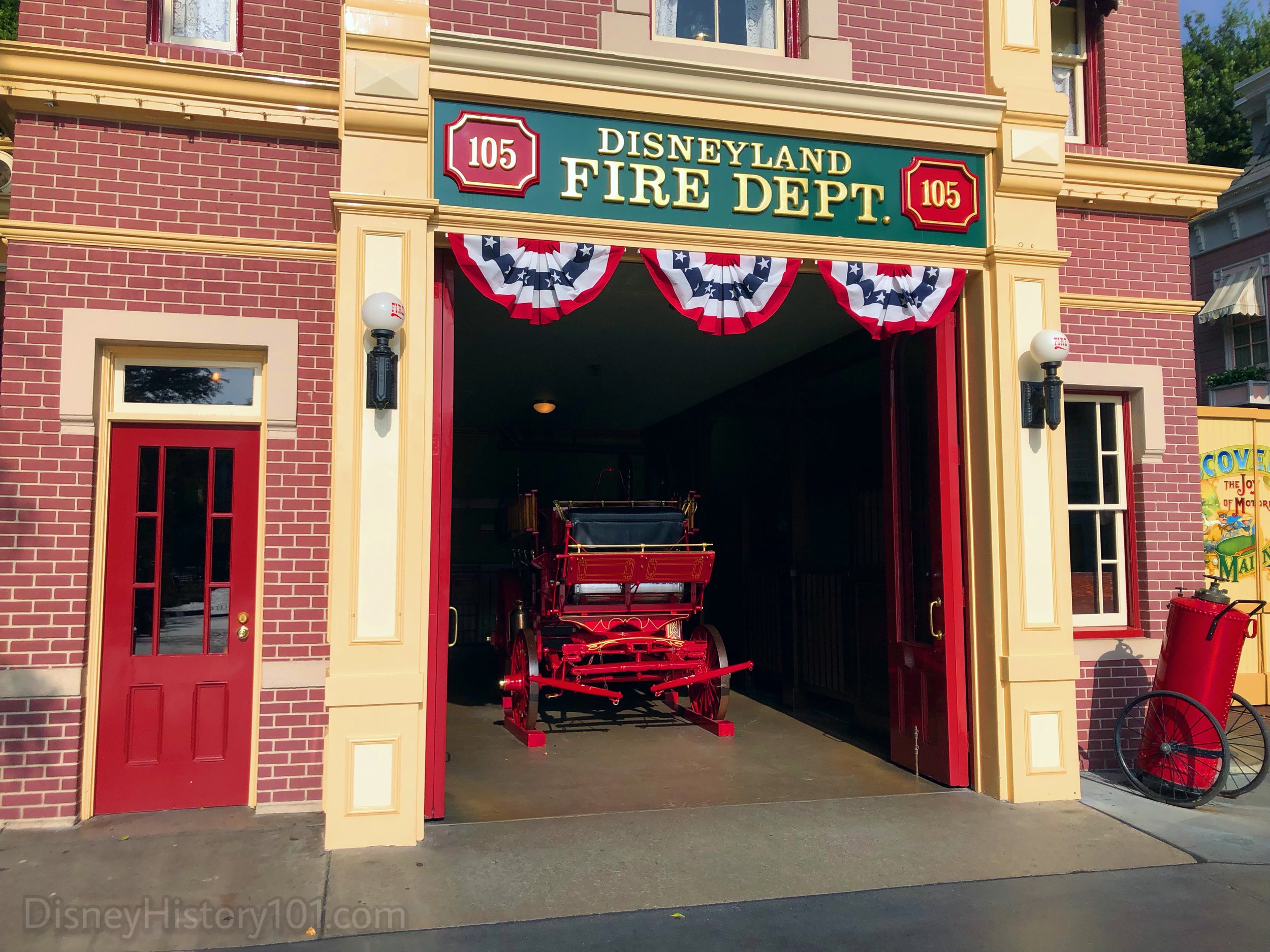
Disneyland Fire Wagon, (2019)
Currently the bright red Chemical Wagon is still part of the Disneyland show, but is not used on Main Street to carry guests. It sits inside Main Street Fire Station amidst many fire fighter-related antiques and reproductions, decorated with authentic hats, axes, and other props.
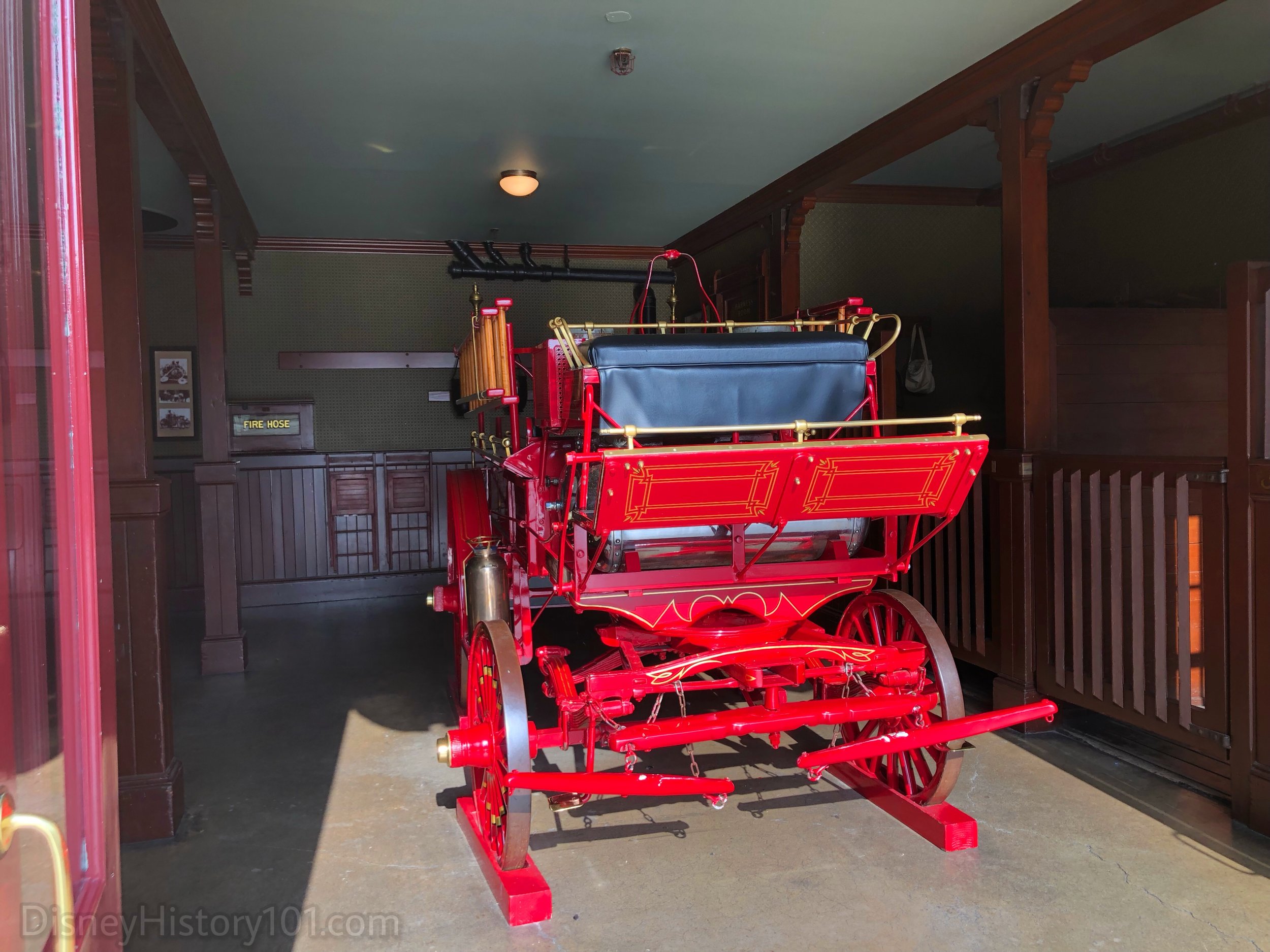
Disneyland Fire Wagon, (2019)
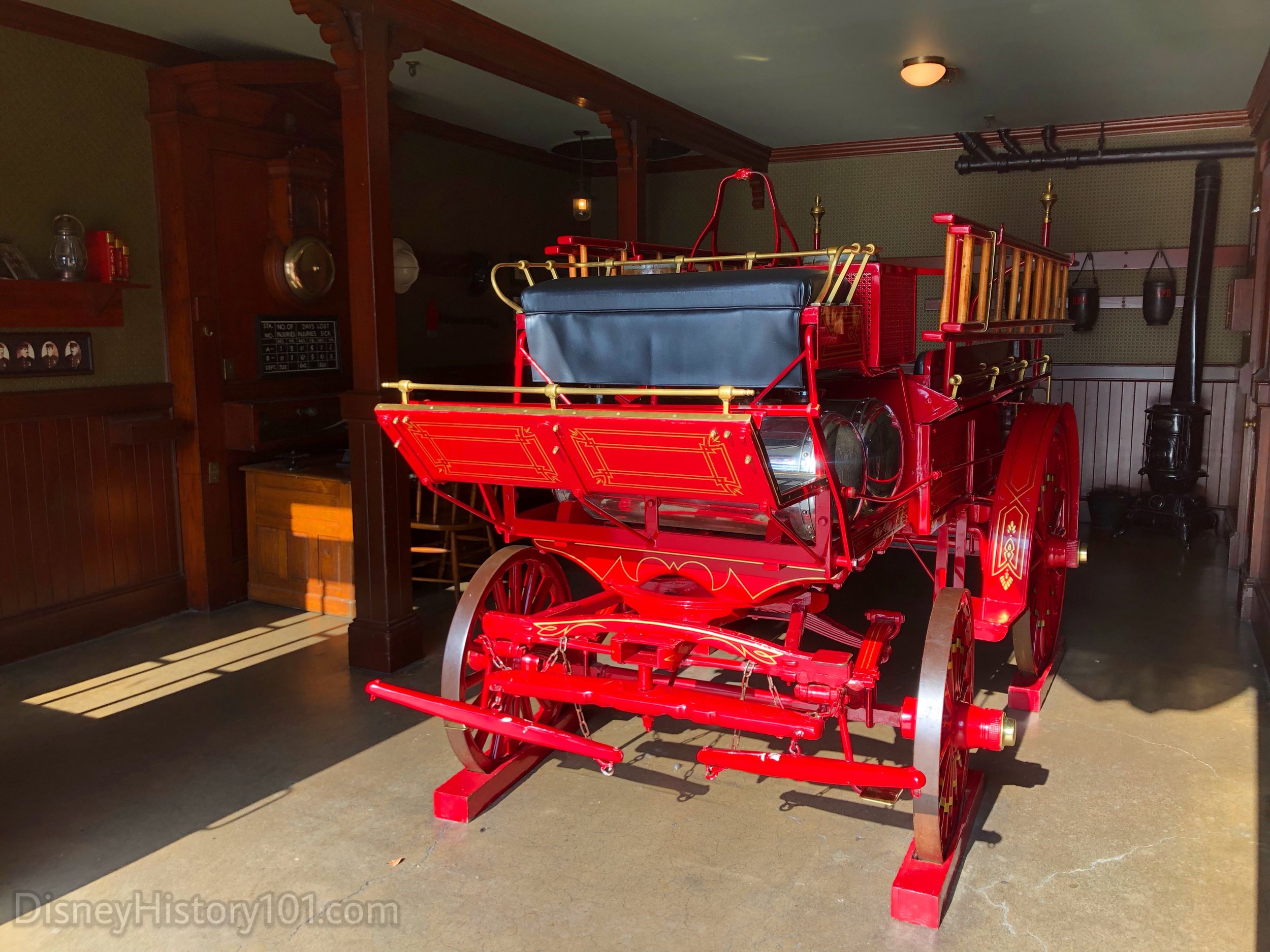
Disneyland Fire Wagon, (2019)
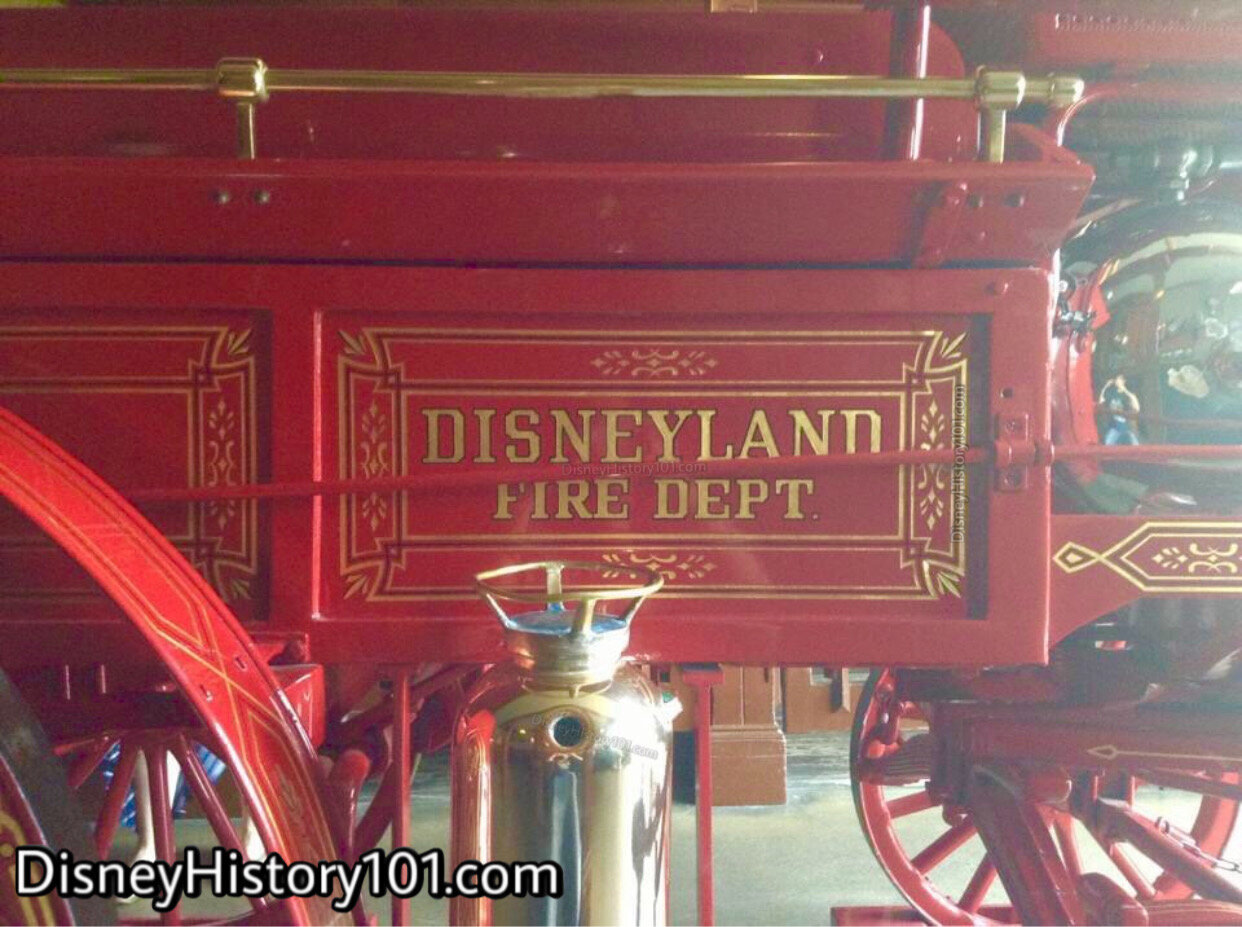
The Disneyland Fire Wagon logo in “Spanish red,” and gold with black outline.

Disneyland Fire Wagon
In the present, it seems that the authentic bell has been removed to improve the Show Quality of this free exhibit.
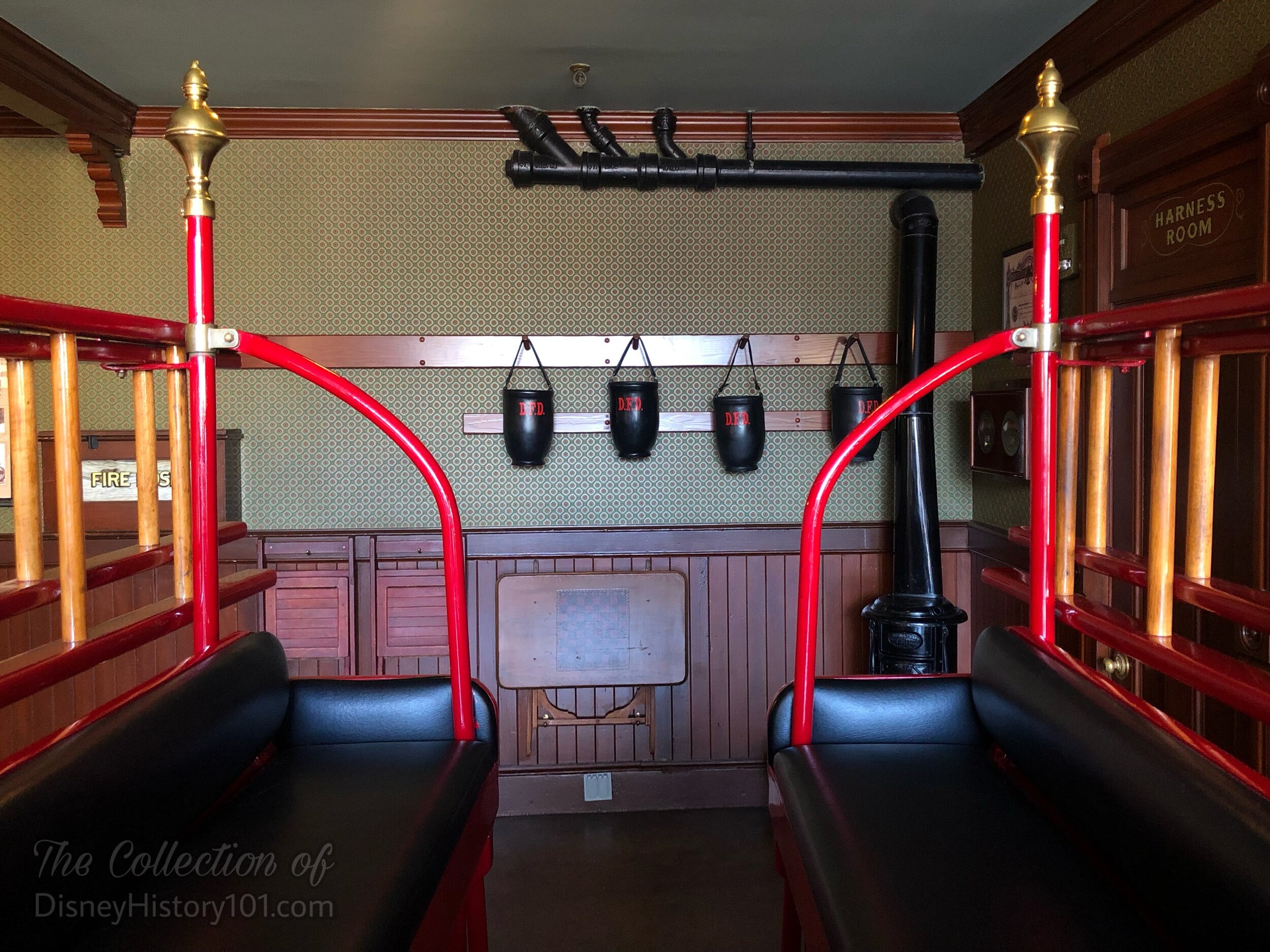
Disneyland Fire Wagon
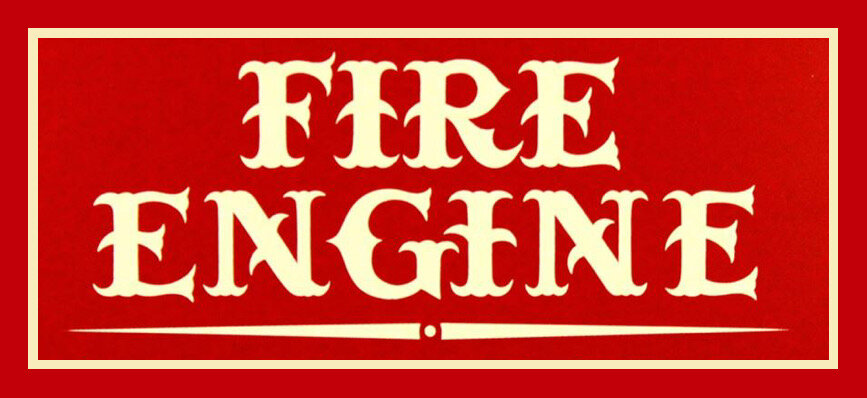
(August 16*, 1958 - present)
*Some sources (as “Disneyland Admission Media Rides and Attractions” report, page 40, published 1971) cite August 27, 1958
The Main Street Fire Department Engine has become a Disney Parks tradition from Walt Disney World to Shanghai Disneyland. But the story of the Disneyland Motorized Fire Engine begins with one true-life fire engine - the former Los Angeles Fire Department Engine No. 63! After being retired during the late 1940s, the engine was acquired by Walt Disney Productions artist Ward Kimball (c.1949).
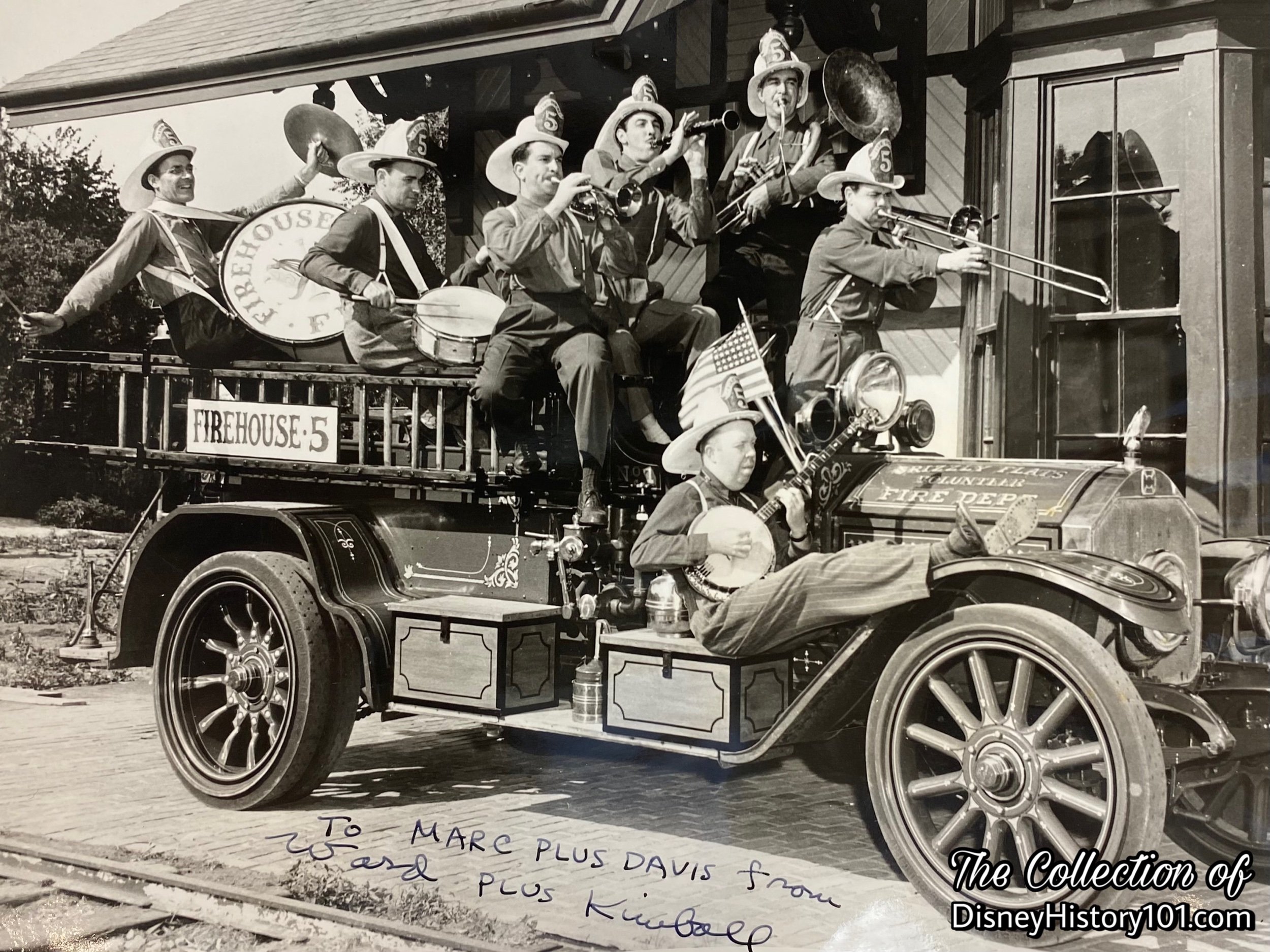
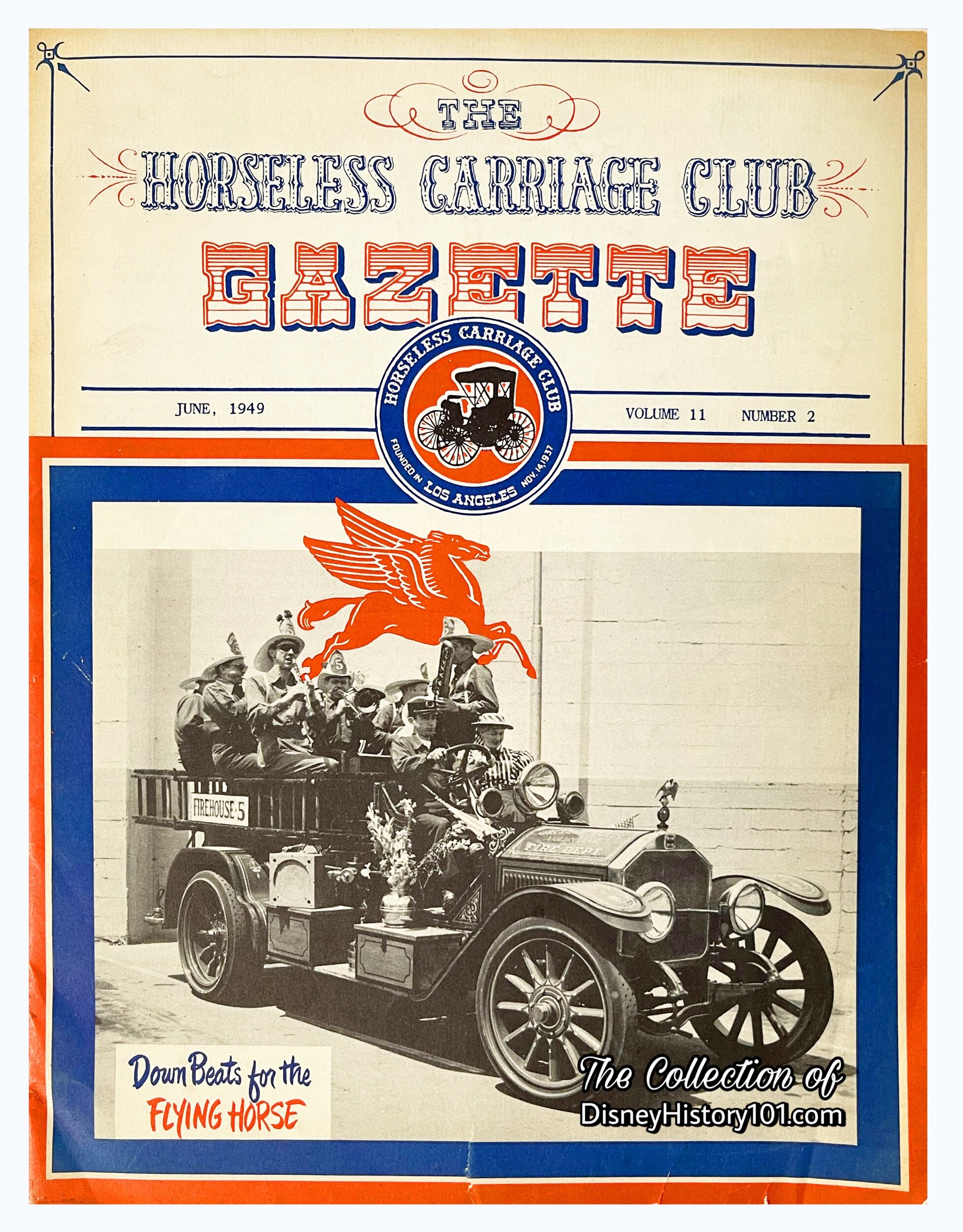
The Cover of The Horseless Carriage Gazette featuring Ward’s American LaFrance Engine, (June, 1949)
During this era, Ward’s “Firehouse Five • Plus Two” performed from his 1916 American La France Fire Engine in Disneyland Parades, and even in the Tournament of Roses Parade! This antique Fire Engine may be the reason for Disneyland’s own Fire Engine according to Bob Gurr’s account.
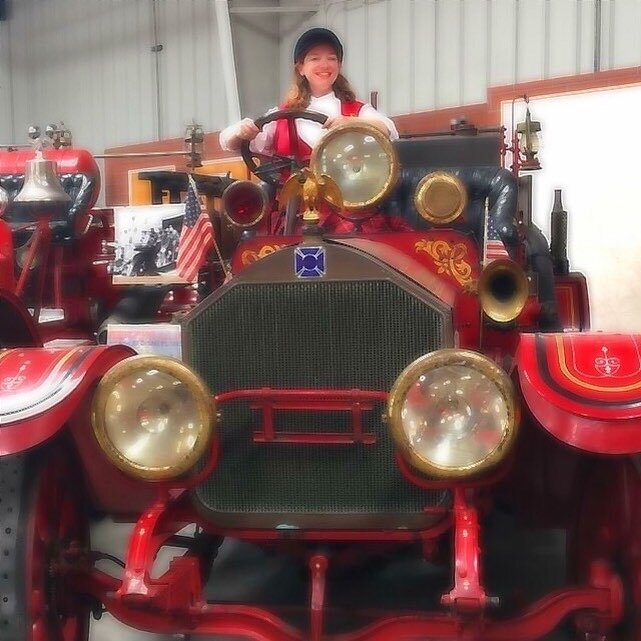
Disneyland and Magic Kingdom Fire Engines everywhere owe their existence to Ward Kimball’s 1916 American La France! ; LA County Fire Museum.
WED employee Bob Gurr first laid eyes (and hands) on Ward Kimball’s American La France fire engine in 1953, when he was asked to help Ward drive the engine to the local fueling station in order to fill the radiator with water. Early in 1958 (three years after Disneyland’s first operational day), Bob was sitting in the Burbank office of Walt Disney. He had been meditating on what to add to Disneyland’s “turn-of-the-century” land, and recollected Ward’s little ALF engine. Up to this point, the Disneyland Fire Department had a horse-drawn Chemical Wagon that was being utilized for the free exhibit, as well as to offer guests passage down Main Street. It was at this point, that Bob Gurr (knowing the audience) pitched the idea of an antique engine to his boss Walt Disney. For the FULL STORY on Ward Kimball’s Fire House Five • Plus Two engine, please VISIT the following link to Disney History 101’s tour of Los Angeles County Fire Museum!
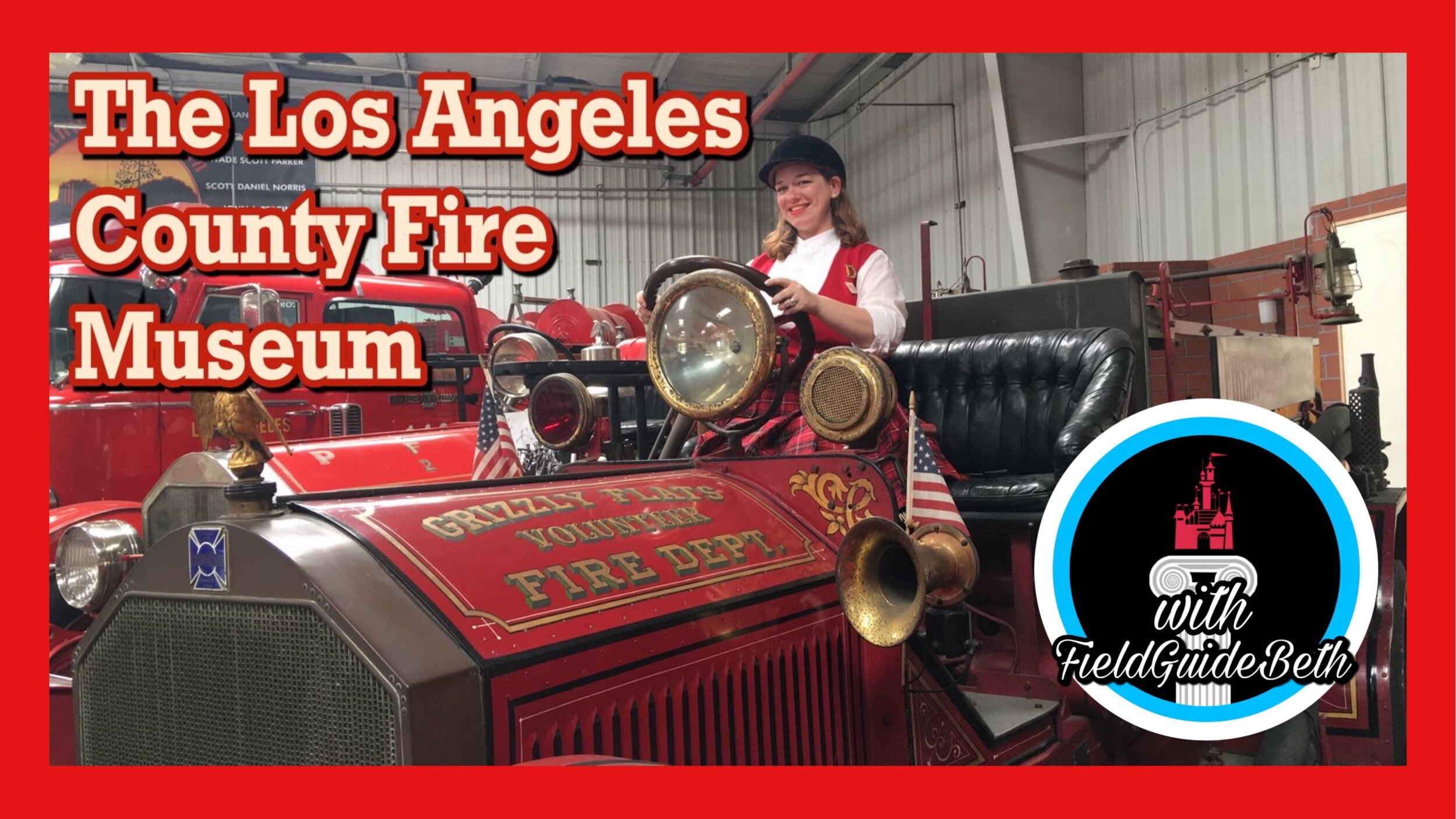
“Disneyland Fire Engine Design and Construction”
The replica 1916 vehicle was recommended and, but also designed by Bob Gurr with color by Sam McKim. Like the Horseless Carriages, “the Motorized Fire Engine …is similarly a composite design of a hose-carrying fire engine of the turn-of-the-century,” according to “Main Street Vehicles,” published 1966 by Disney University. “The studio’s Imagineers designed a chassis, then used practical equipment like a jeep rear axle, a three speed truck transmission, and standard drive-line parts.” [“Did You Know?” prepared for Disneyland, c.1991.] A 2-cylinder Hercules gasoline engine was installed in the vehicle. “The primary change we made was to place seats where the hose was carried. The Studio men designed a chassis, then pored through standard catalogues for unlikely, but practical equipment - a deep rear axle, a three-speed truck transmission, the power plant of a small pick-up truck and standard drive-line parts. The bell and the siren are authentic, purchased after considerable search. At the turn of the century, gas-driven cars were considered a novelty - and a hazard - lacking the reliability of a horse. Motorized fire equipment was merely supplementary to the more respected steed.” [According to “Main Street Vehicles”, published 1966 by Disney University] Much of that “fire equipment” was acquired through Bob’s $150.00 purchase of a 1938 Chevrolet fire engine, from the Crown Coach Fire Engine Company. Ward Kimball (who owned and operated several antique fire engines) recommended the Bob install Rushmore headlamps on the engine, for a finishing touch.
“Debut & Response”
During 1958, the Disneyland Fire Department took a step forward in time, when it received its first motorized fire engine (appraised and valued between $3,600 and $4,300). By September 28, 1958, Bank of America appraised the Motorized Fire Wagon (considered a Park Asset) and valued it at $12,267. This vehicle would bear the distinction of becoming the last DMC attraction vehicle to be added to Main Street!
For a little over a year, two fire fighting vehicles shuttled guests down Main Street. The Main Street Fire Engine ferried guests on a one-way trip, from Town Square to the Plaza. The new 2000-pound vehicle had an 8-Guest capacity. Eventually (in 1960), the Chemical Wagon was retired, and the Main Street Fire Engine became the “chief” form of transportation! According to one Disneyland Admission Media Rides and Attractions Report [prepared in April 1971, by Disneyland Research Department], 2,787,155 guests had already taken a ride aboard the Fire Engine.
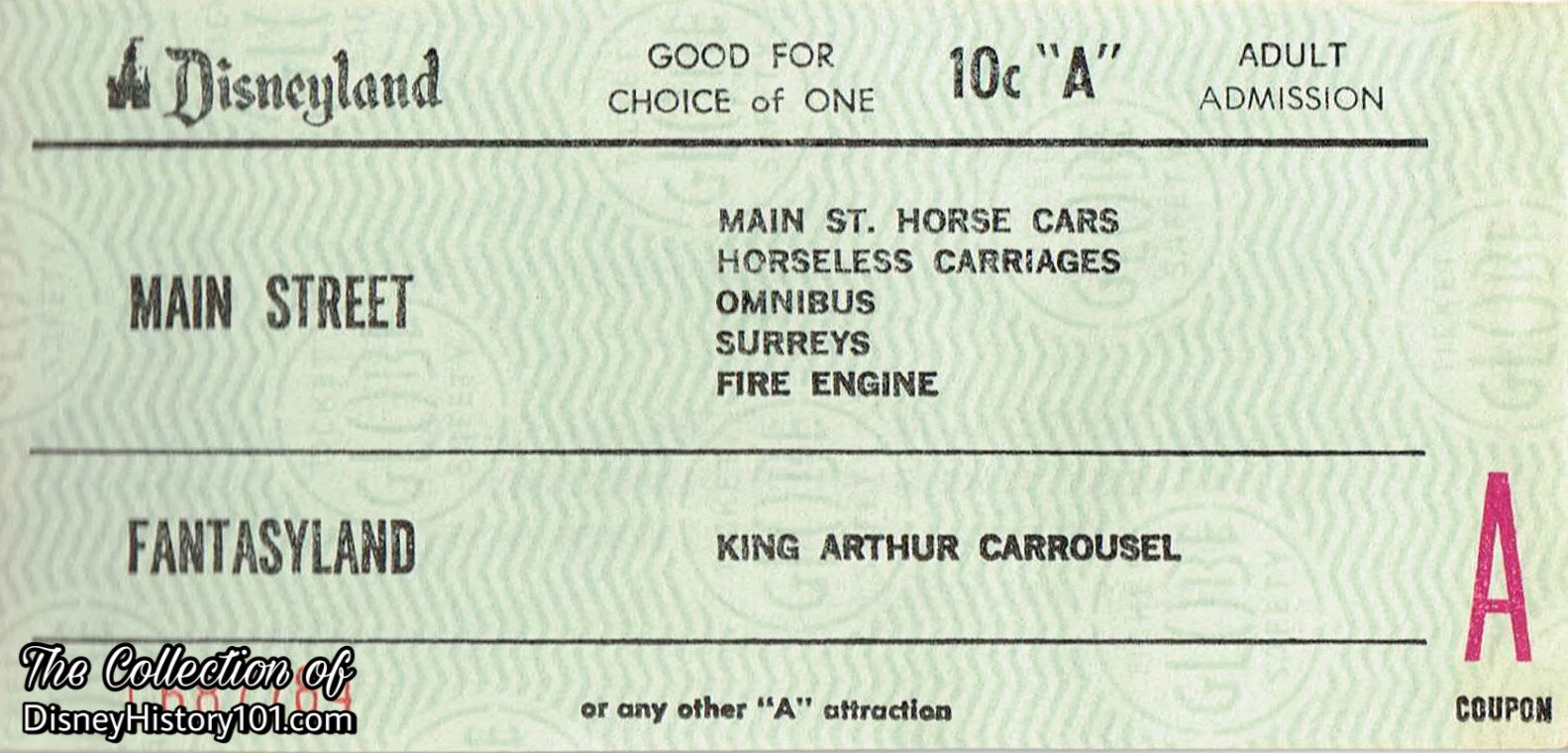
Disneyland "A" Attraction Coupon
A number of Disneylanders operated the Fire Engine like Ralph Hansen (1967).
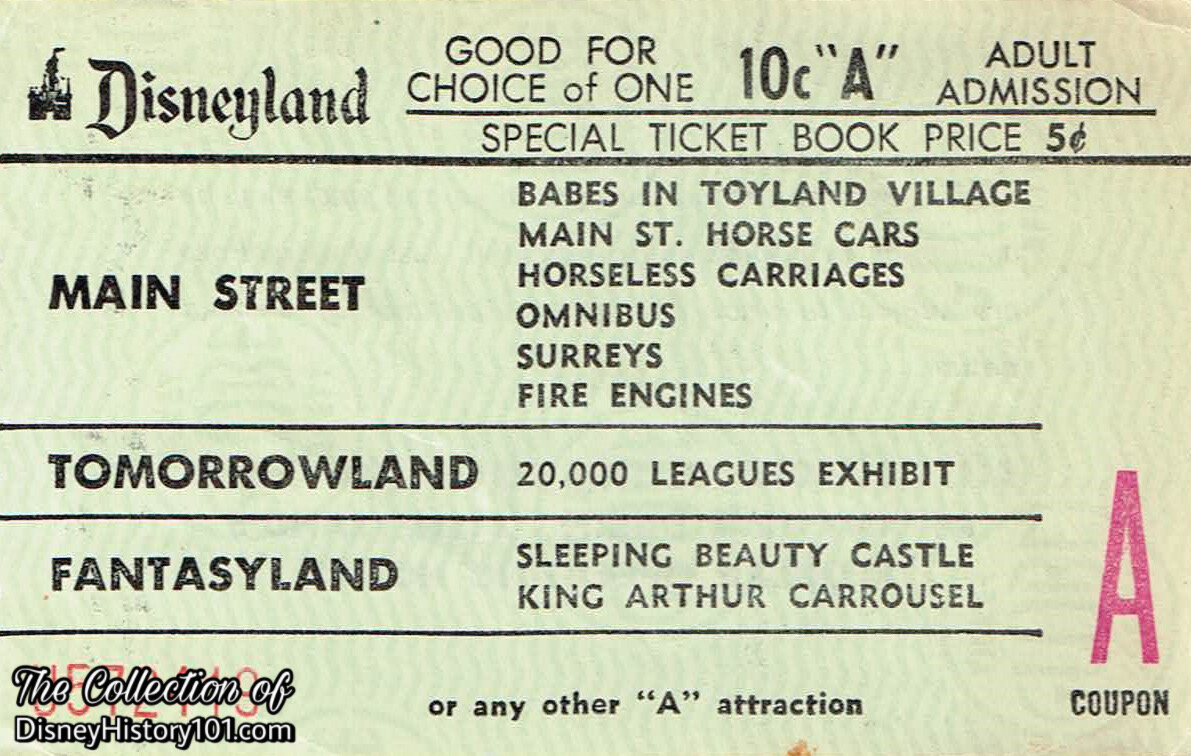
Disneyland "A" Attraction Coupon (December 1961 - September 1963)
The Disneyland Fire Engine was closed weekdays during the winter season of 1962, operating on weekends.
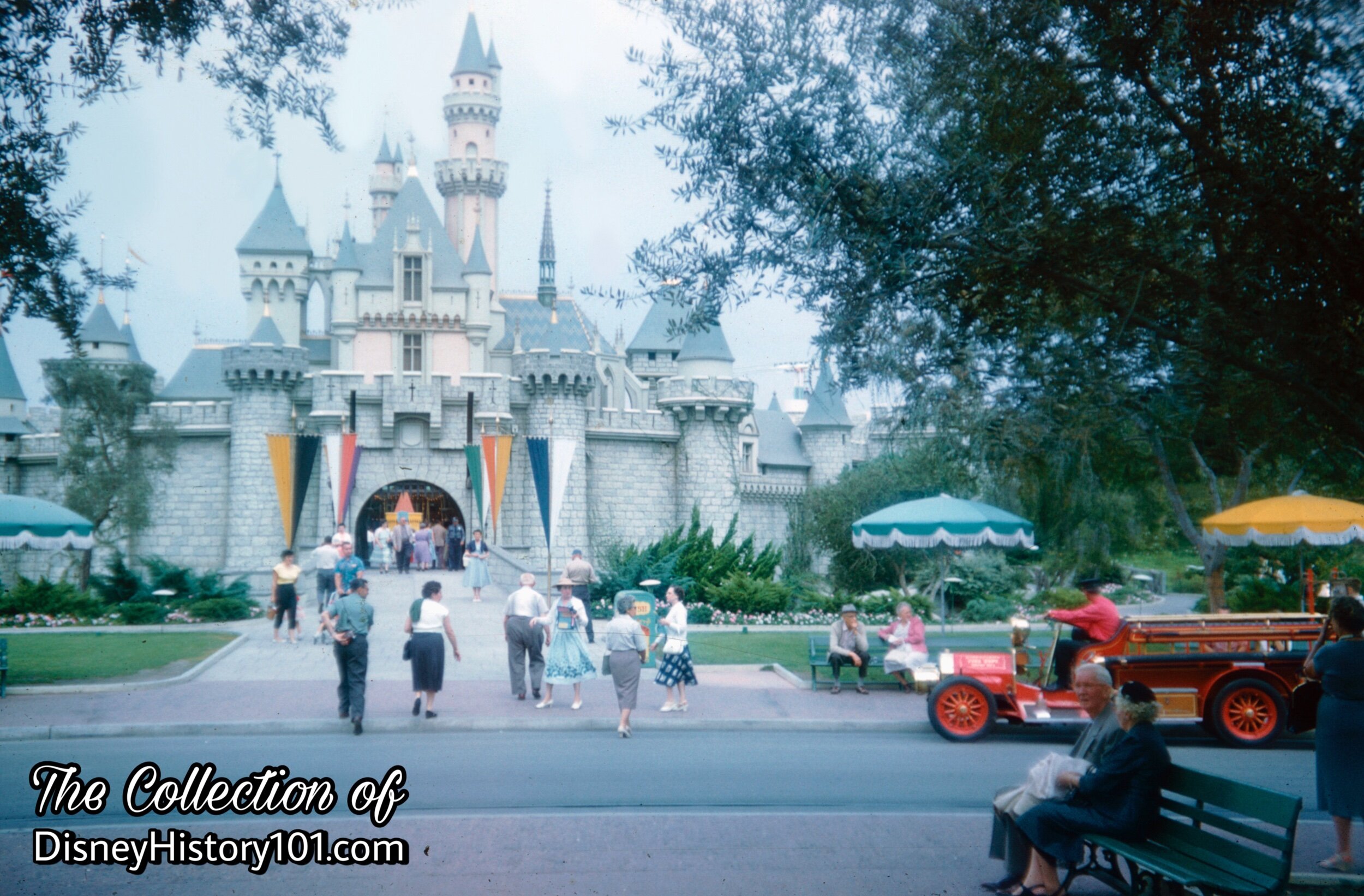
Disneyland Fire Department Engine, (1959)
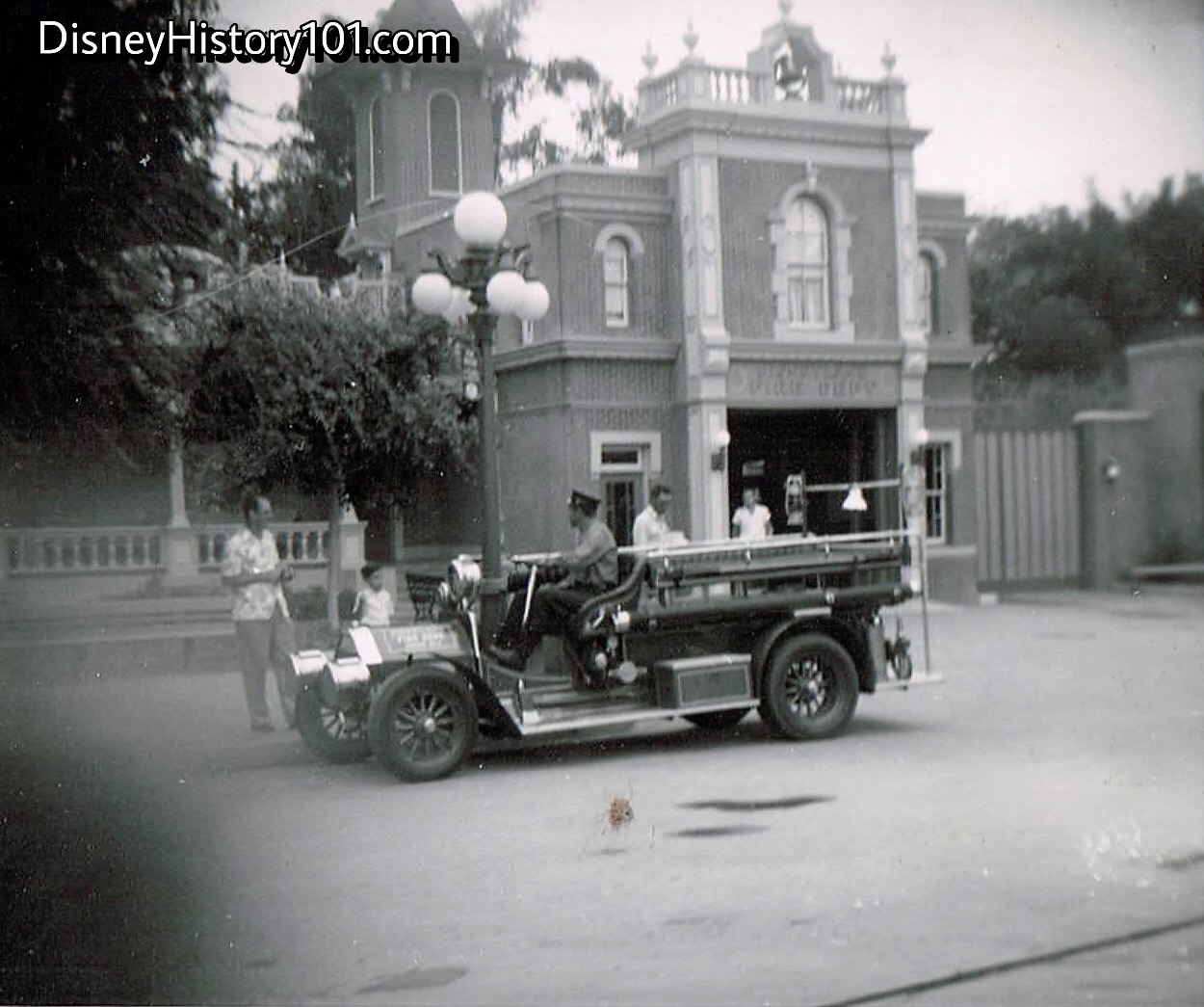
Disneyland Fire Department Engine, (1960)
Here’s the Main Street Fire Department during the debut year of the Main Street Fire Engine.
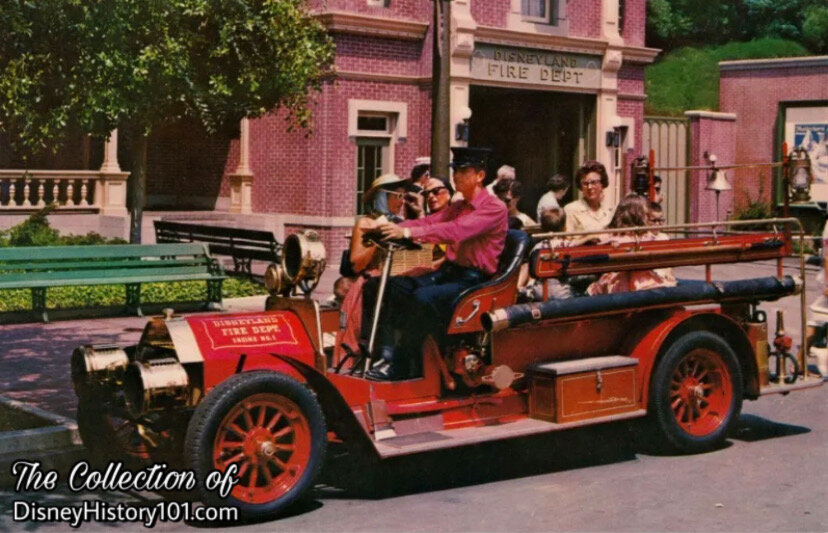
Disneyland Motorized Fire Engine Postcard, (c. 1958)
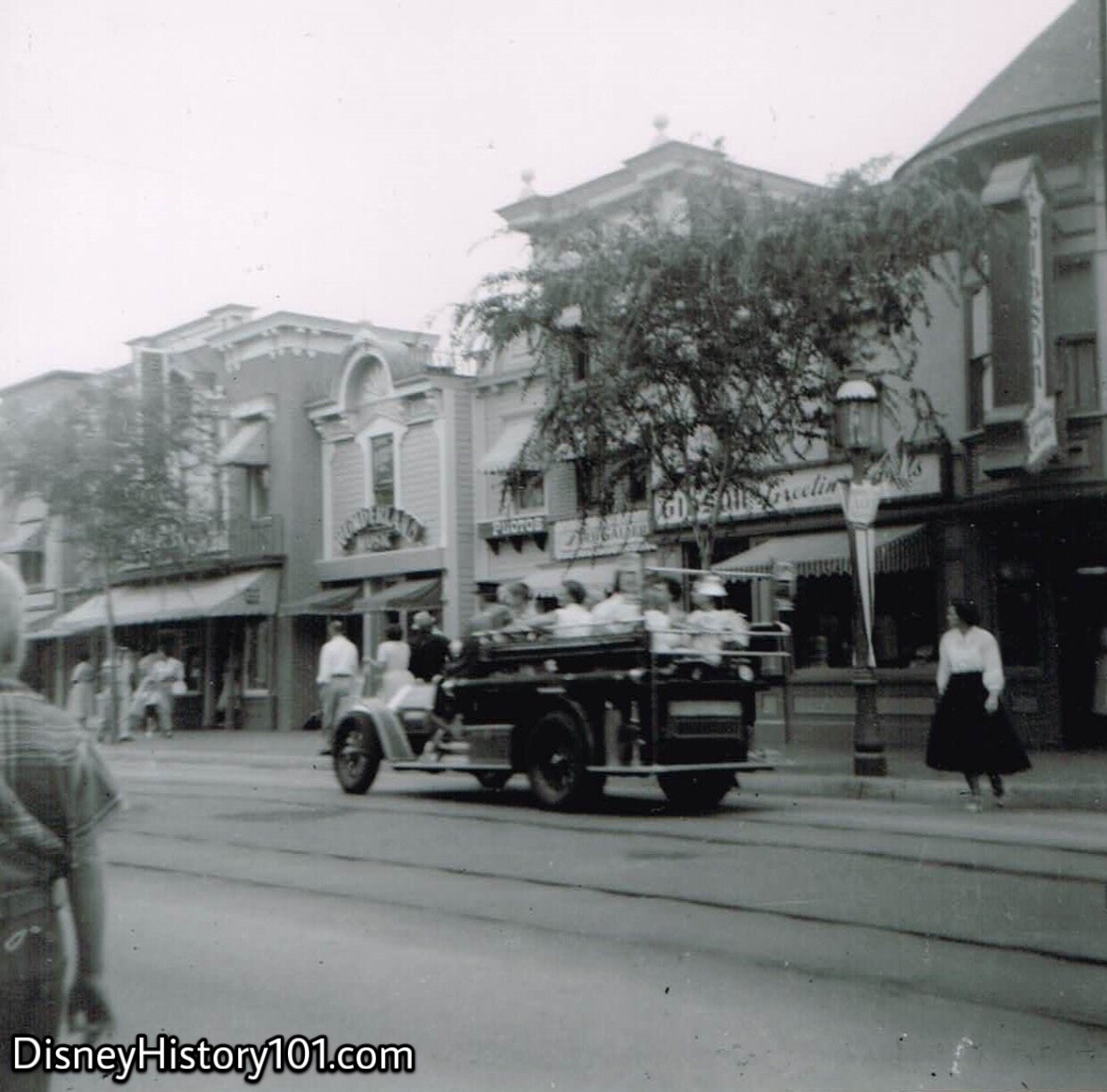
Disneyland Fire Department Engine, (1960)
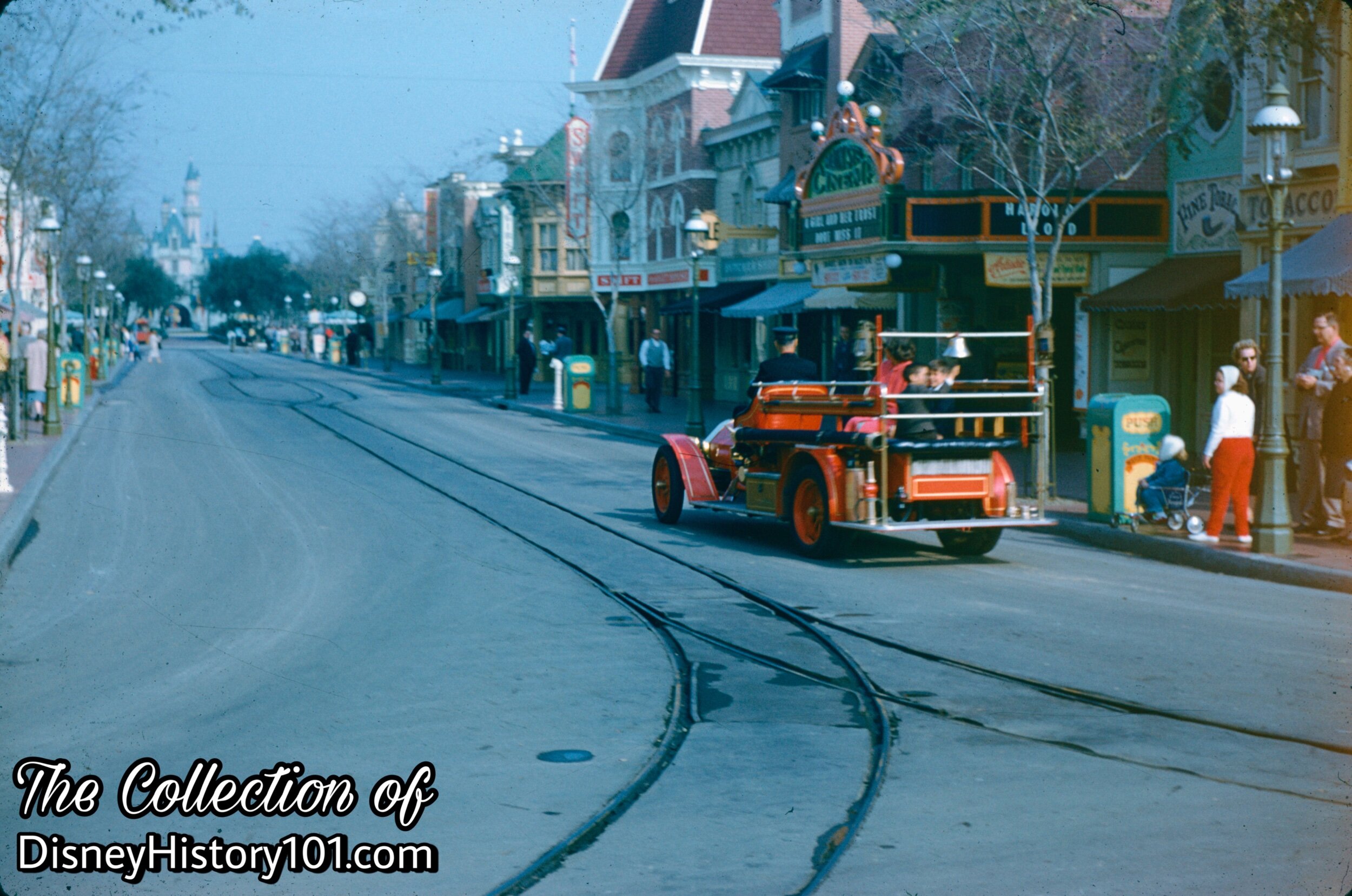
Disneyland Fire Department Engine, (February, 1960)
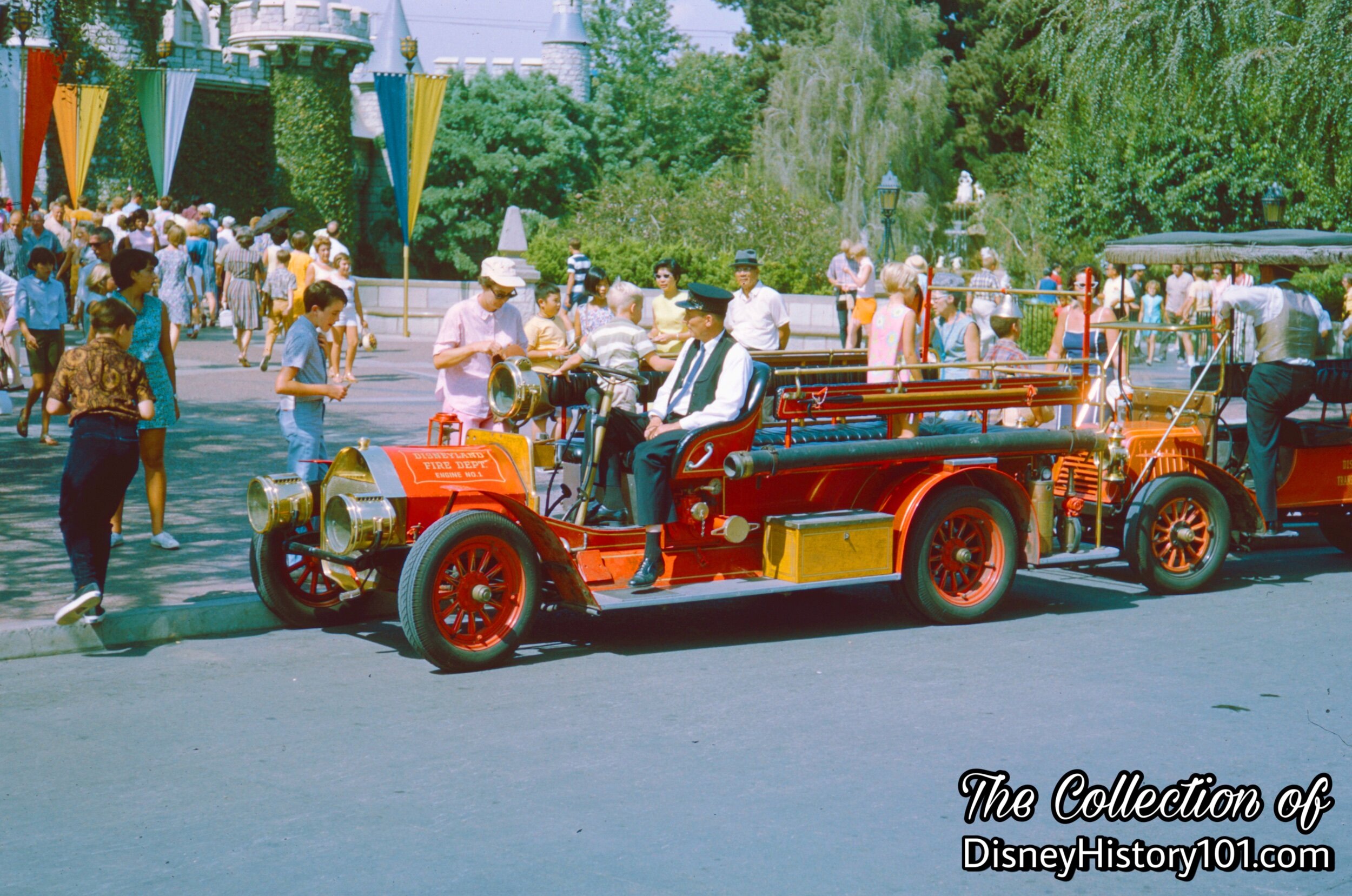
Disneyland Fire Department Engine
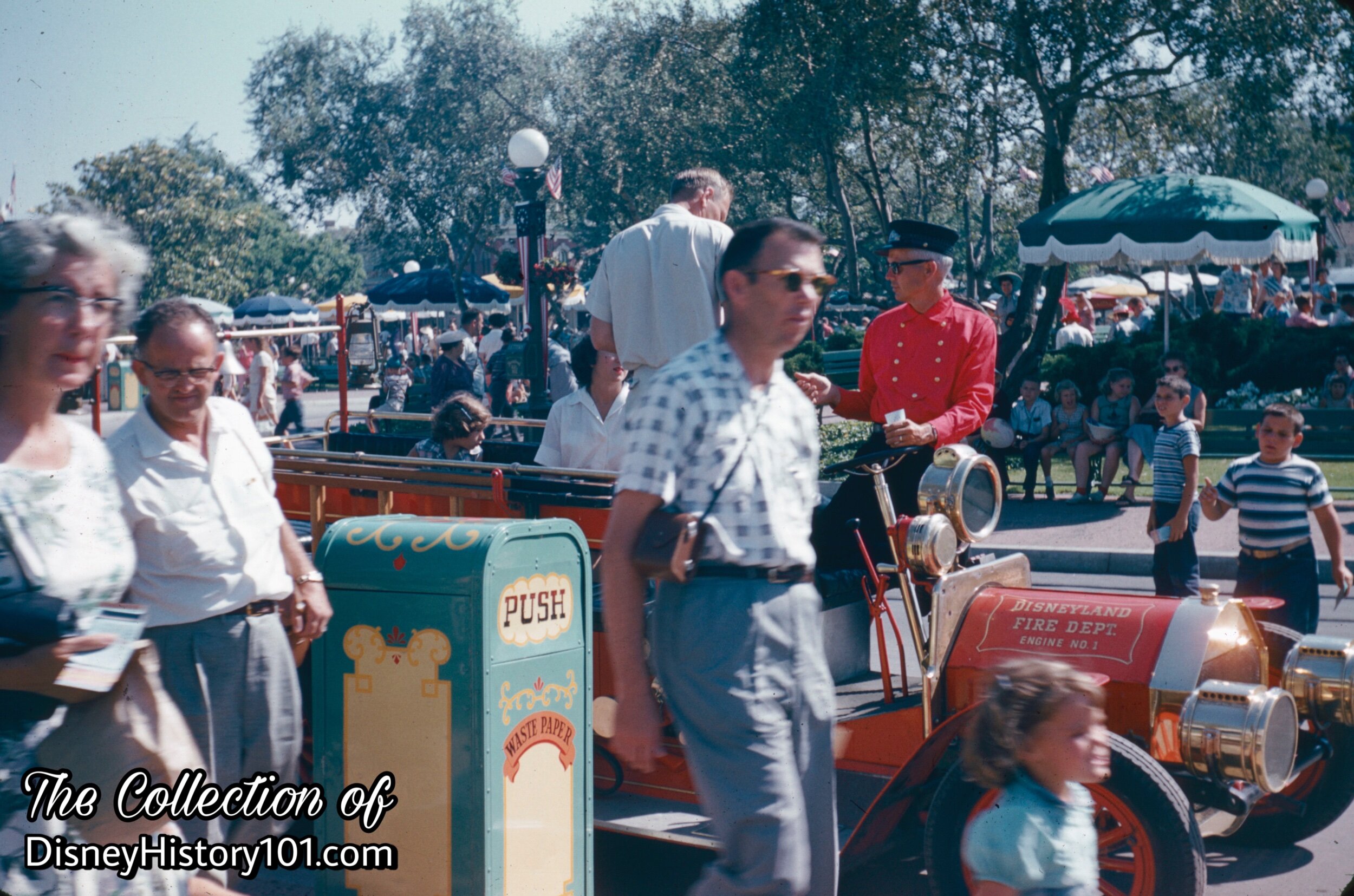
Disneyland Fire Department Engine, (June 27, 1960)
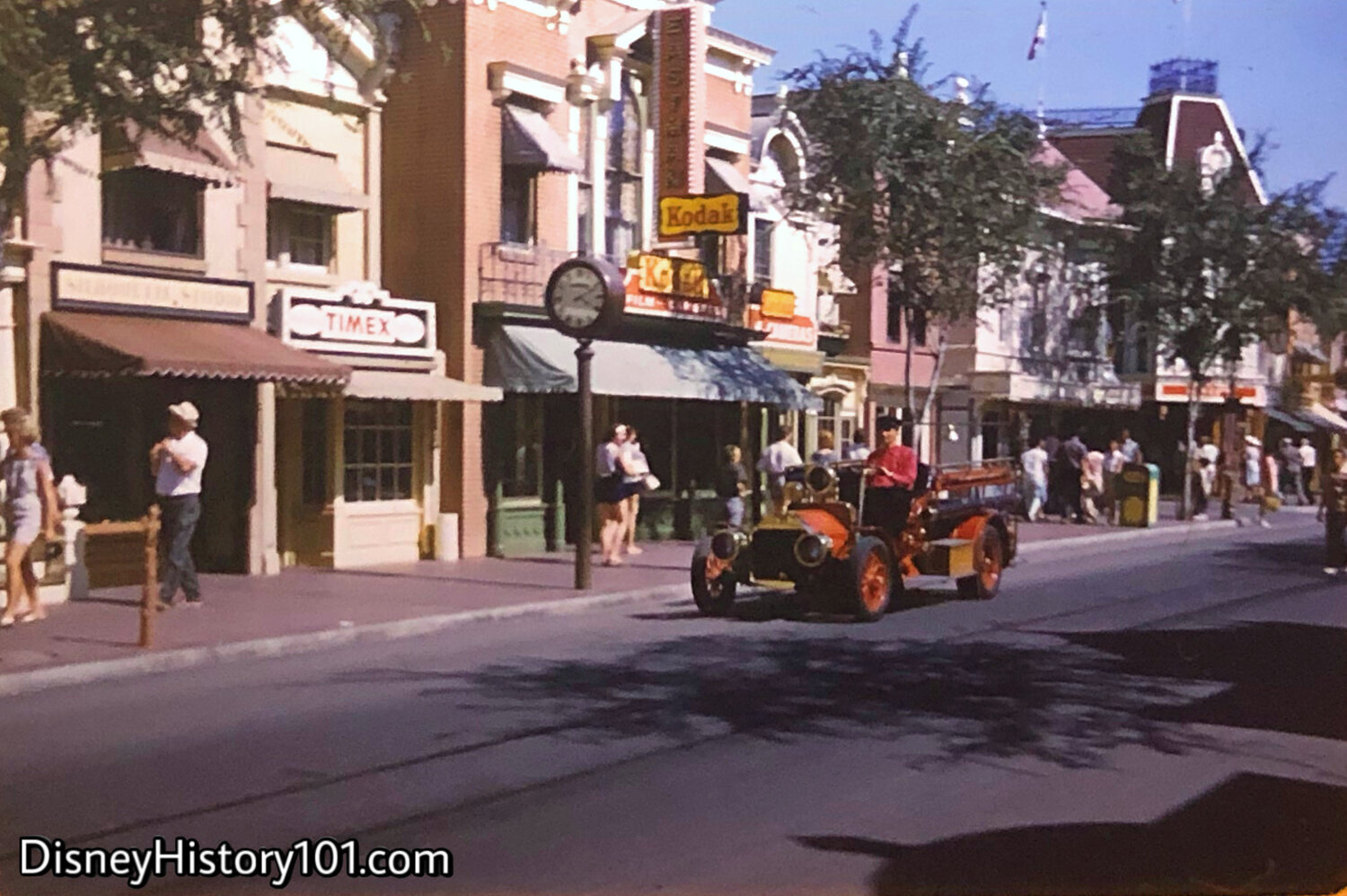
Disneyland Fire Department Engine

Disneyland Fire Department Engine, (1960)

Disneyland Fire Department Engine
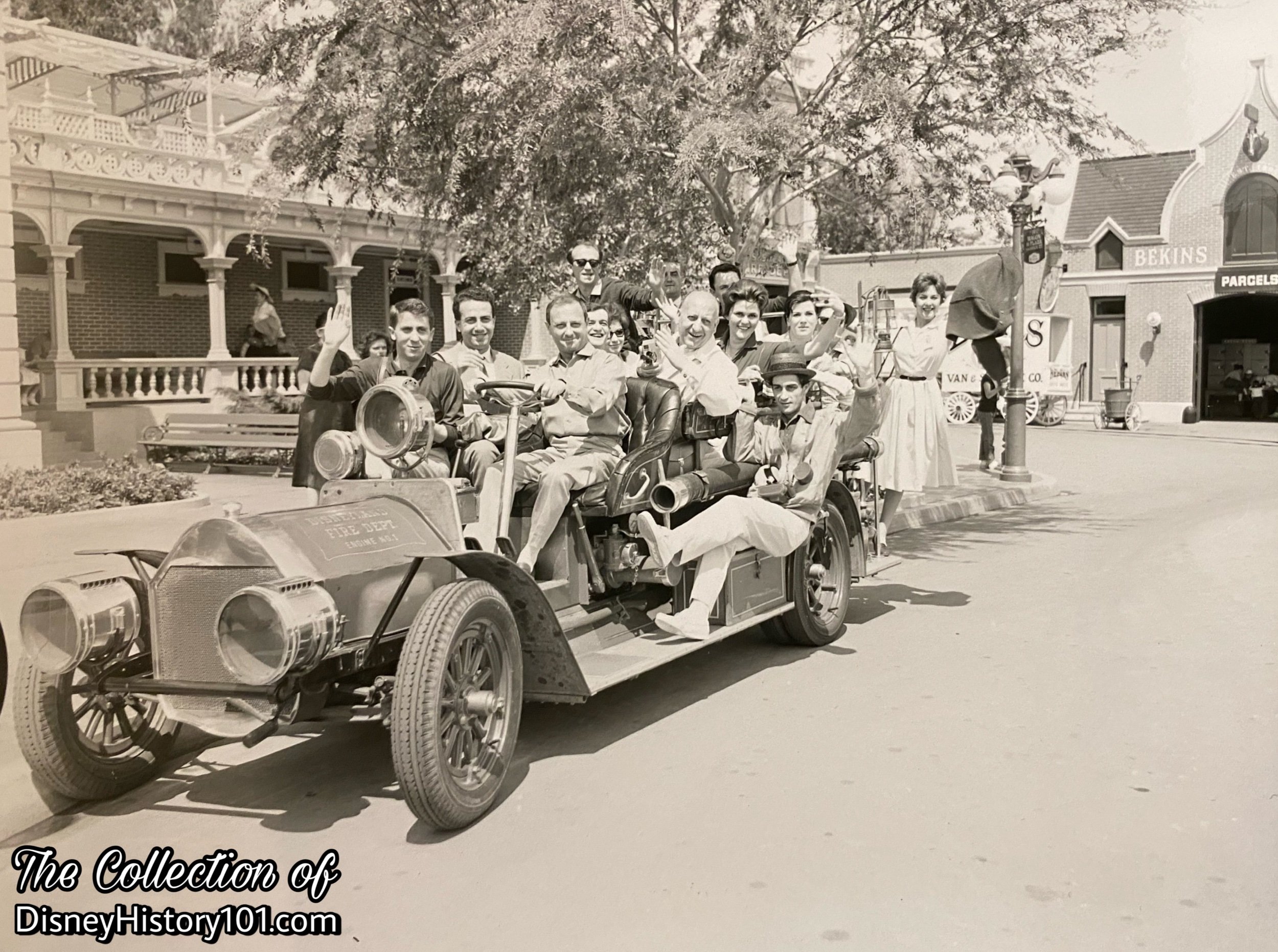
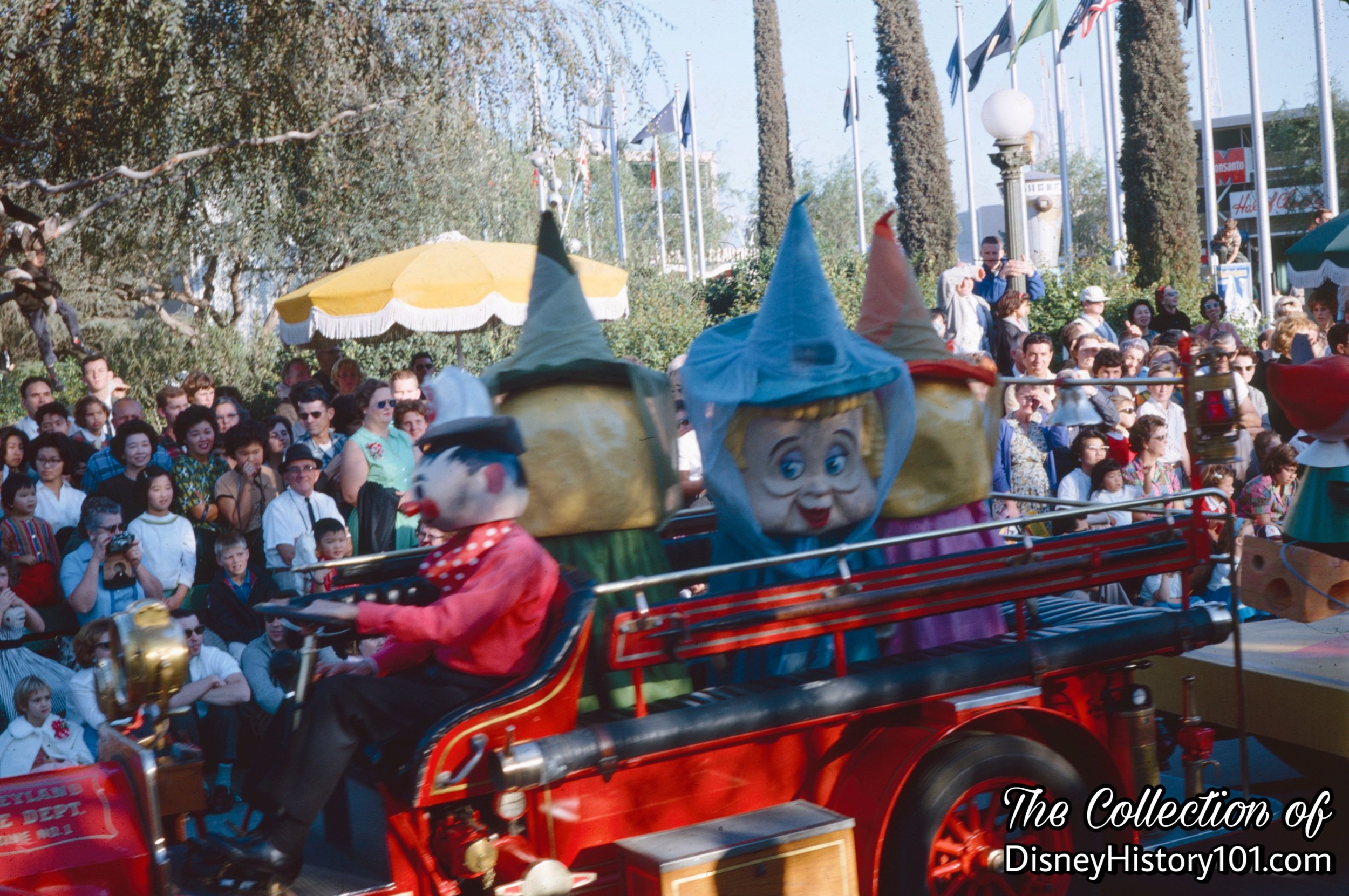
The Disneyland Fire Department Engine carrying a trio of Witches in the Parade of the Toys.
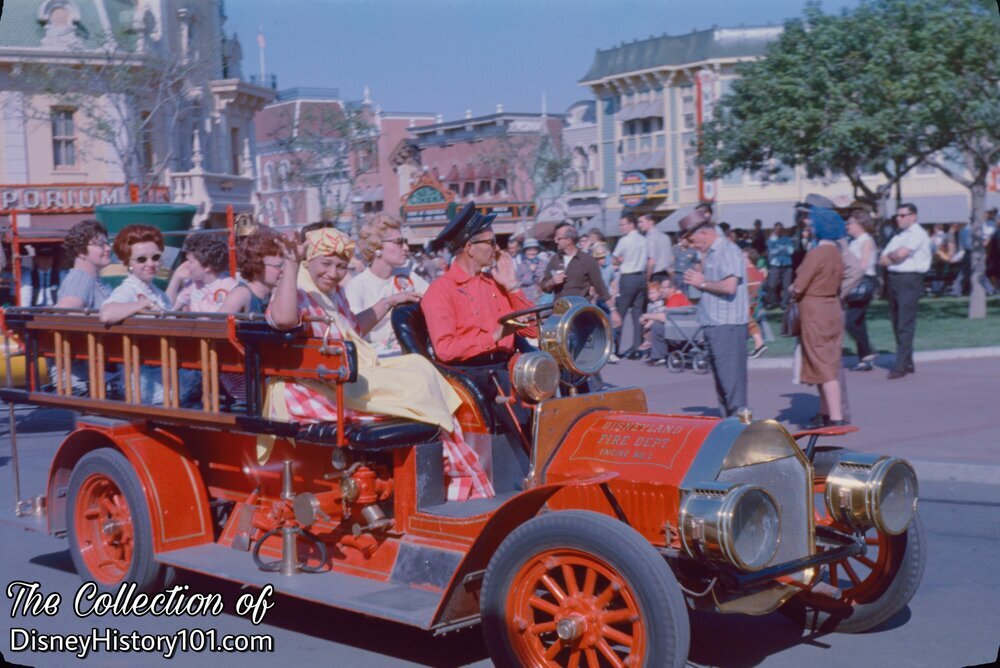
Aunt Jemima and VIPs aboard the Disneyland Fire Department Engine in National Pancake Day Parade, February, 1964.
The Disneyland Fire Engine didn’t respond to “code 904,” but it was quite often used in parades and occasionally ferried special guests down the parade route. Among the notable Guests to take a ride aboard the Disneyland Fire Engine were :
•Sergei Gerasimov (Soviet Union Producer) and Georgrii Mdivani (Soviet Union Playright)
•The Tournament of Roses Queen Carole Washburn and her Royal Court, on December 19, 1960
•Richard Nixon and his family, 1961
•President Eisenhower and his wife, 1961
•Kyu Sakamoto, Japanese singing sensation renown for his hit Sukiyaki, was photographed aboard the Disneyland Fire Engine in August of 1963.
•Illinois Governor Otto Kerner (and family), on December 30, 1963 (in conjunction with their visit to the Rose Bowl)
•February of 1964, the Disneyland Fire Engine ferried Aunt Jemima (portrayed by vocalist Edith Wilson) and National Pancake Day Race Contestants in a Parade.
•Bob and Helen Bezucha (the editors of “The Golden Magazine for Boys and Girls”) sat behind the wheel of the Disneyland Fire Truck, and their photo was published in “The Golden Magazine for Boys and Girls” (June of 1965).
•The Disneyland Fire Engine was also used as a prop for a Look Magazine photo shoot (in conjunction with new Disneyland 3-D post cards) on May 24, 1966.
•The last photo of Walt Disney in the Park, was taken while he was aboard the Disneyland Fire Engine during the Fall of 1966.
•Camp Fire Girls Day at Disneyland (on Saturday, March 23rd, 1968) was advertised with a photograph of three Camp Fire Girls (and their Leader) aboard the Disneyland Fire Engine on the cover of Disneyland News (published for March of 1968).
•The c.1987 Interstate Batteries Great American Race Grand Marshall was transported down the parade route in the Disneyland Fire Engine.
•President Ronald Reagan at Disneyland’s Rededication, on January 11, 1990
•Disney Legends Alice Davis, Blaine Gibson, Bob Gurr, Harriet Burns, and Xavier Atencio rode in an event in honor of “Pirates of the Caribbean”, March 8, 2007.
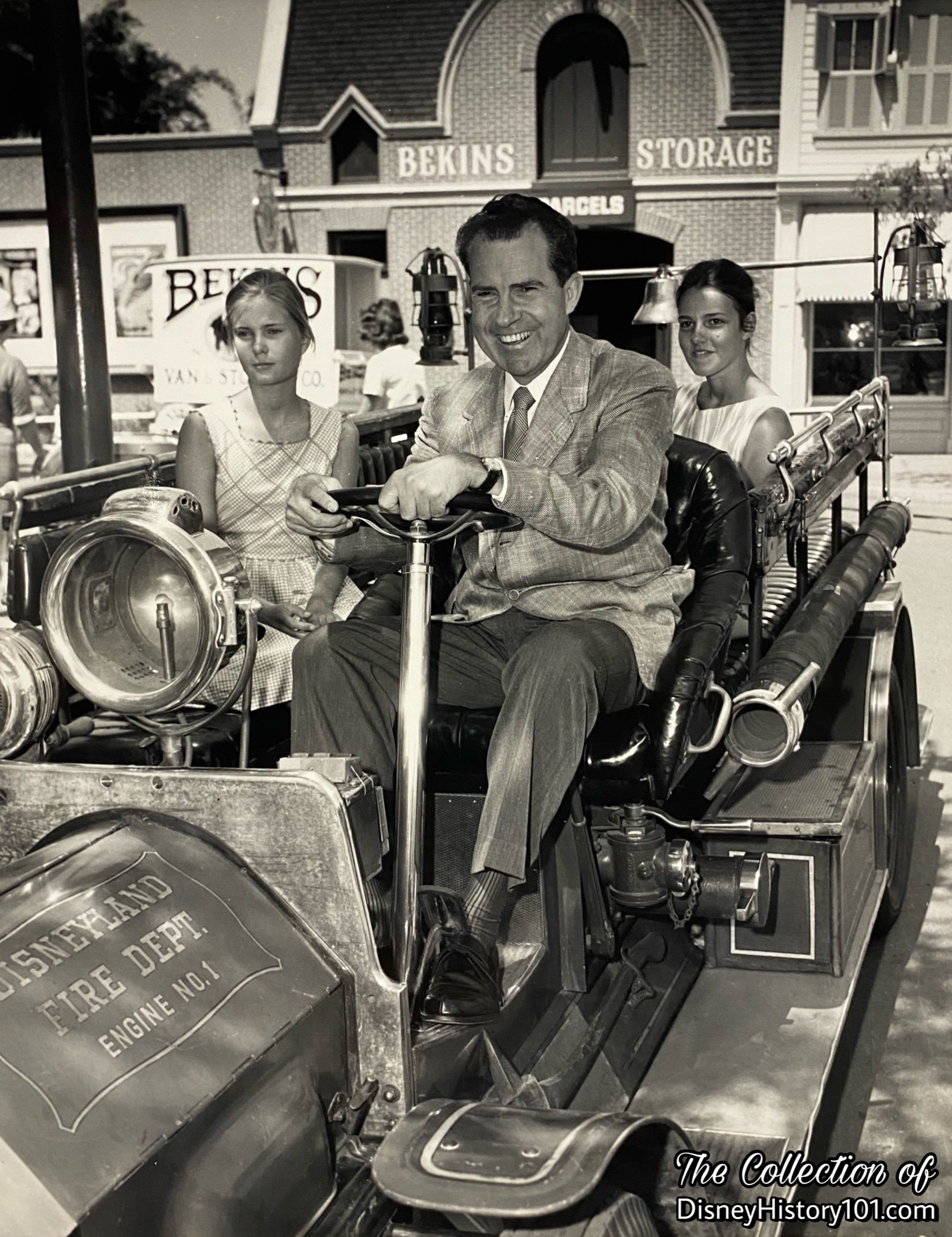
©Walt Disney Productions.
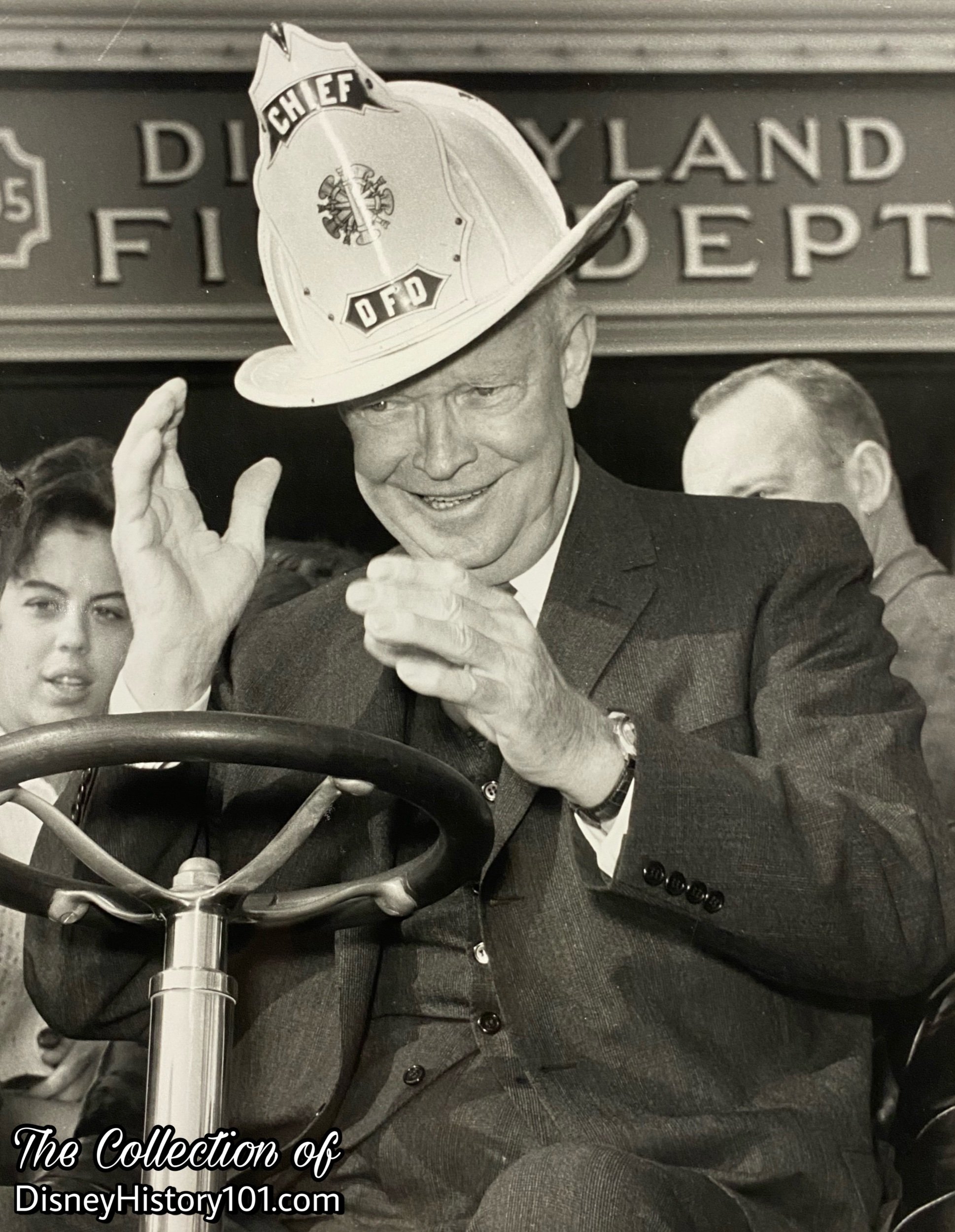
Eisenhower visits Disneyland in 1961 ©Walt Disney Productions.
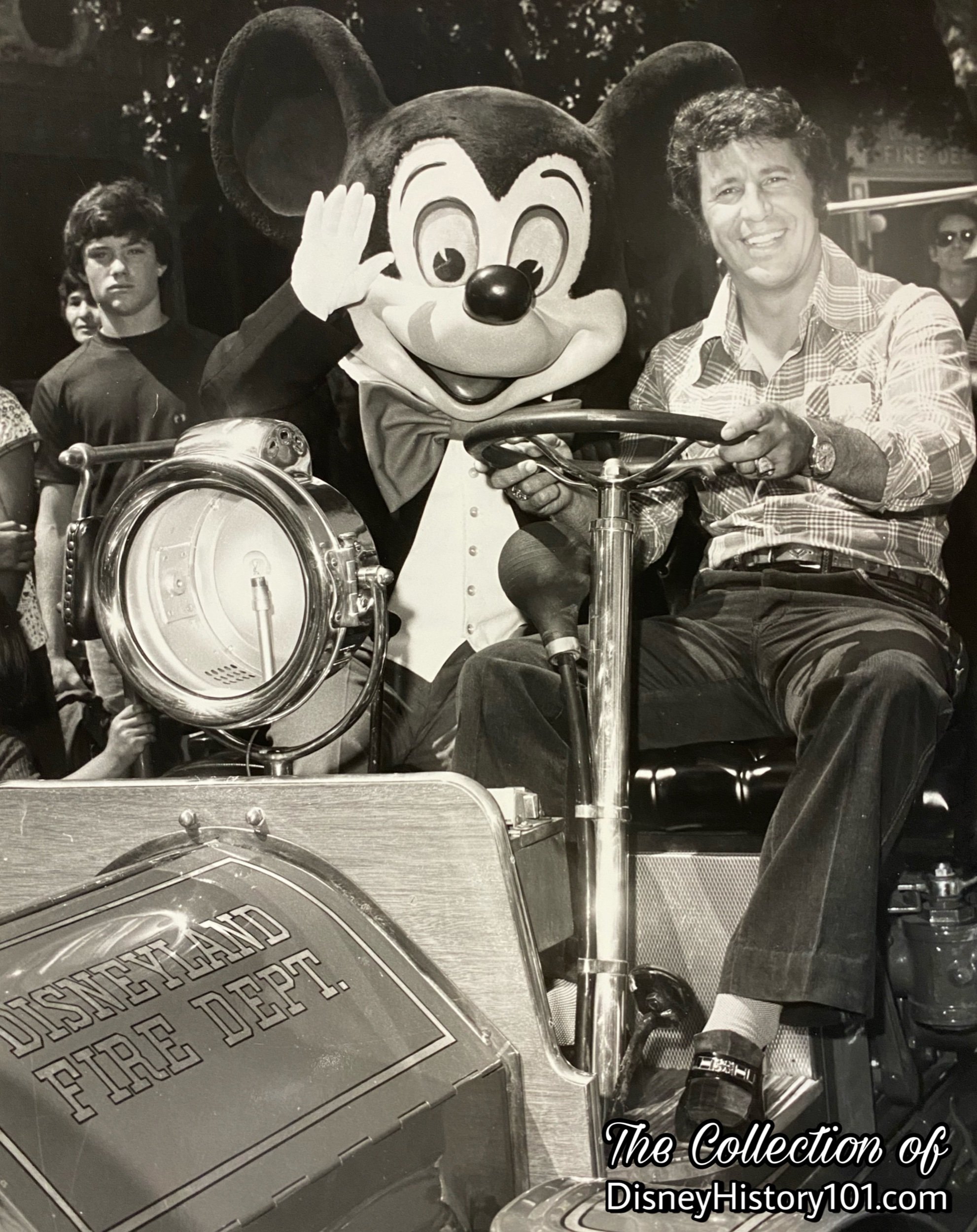
©Walt Disney Productions.

(The Collection of Bob Penfield ; The Walt Disney Hometown Museum)
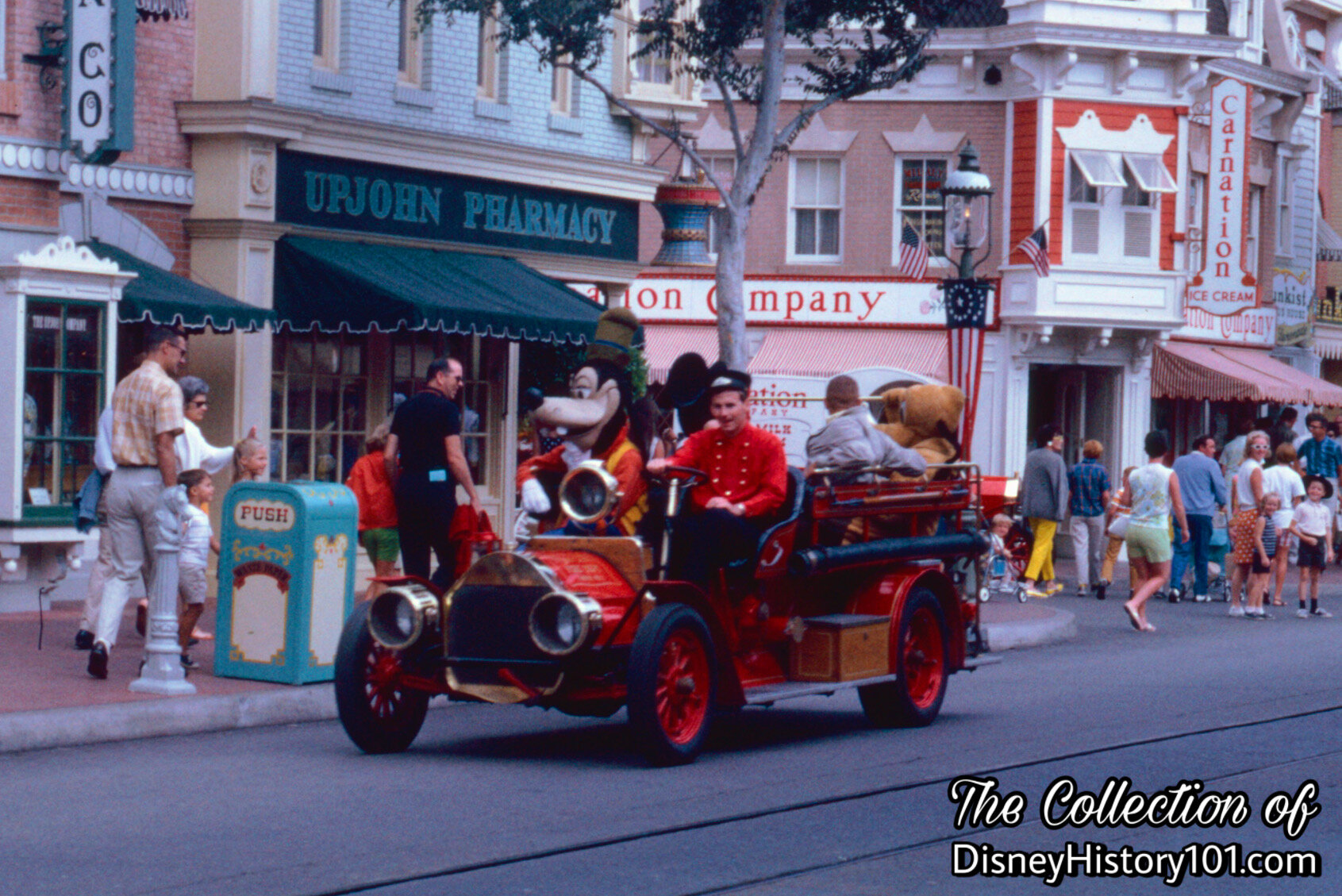
The Disney Characters and perhaps a Character Attendant take a ride aboard the Disneyland Fire Department Engine
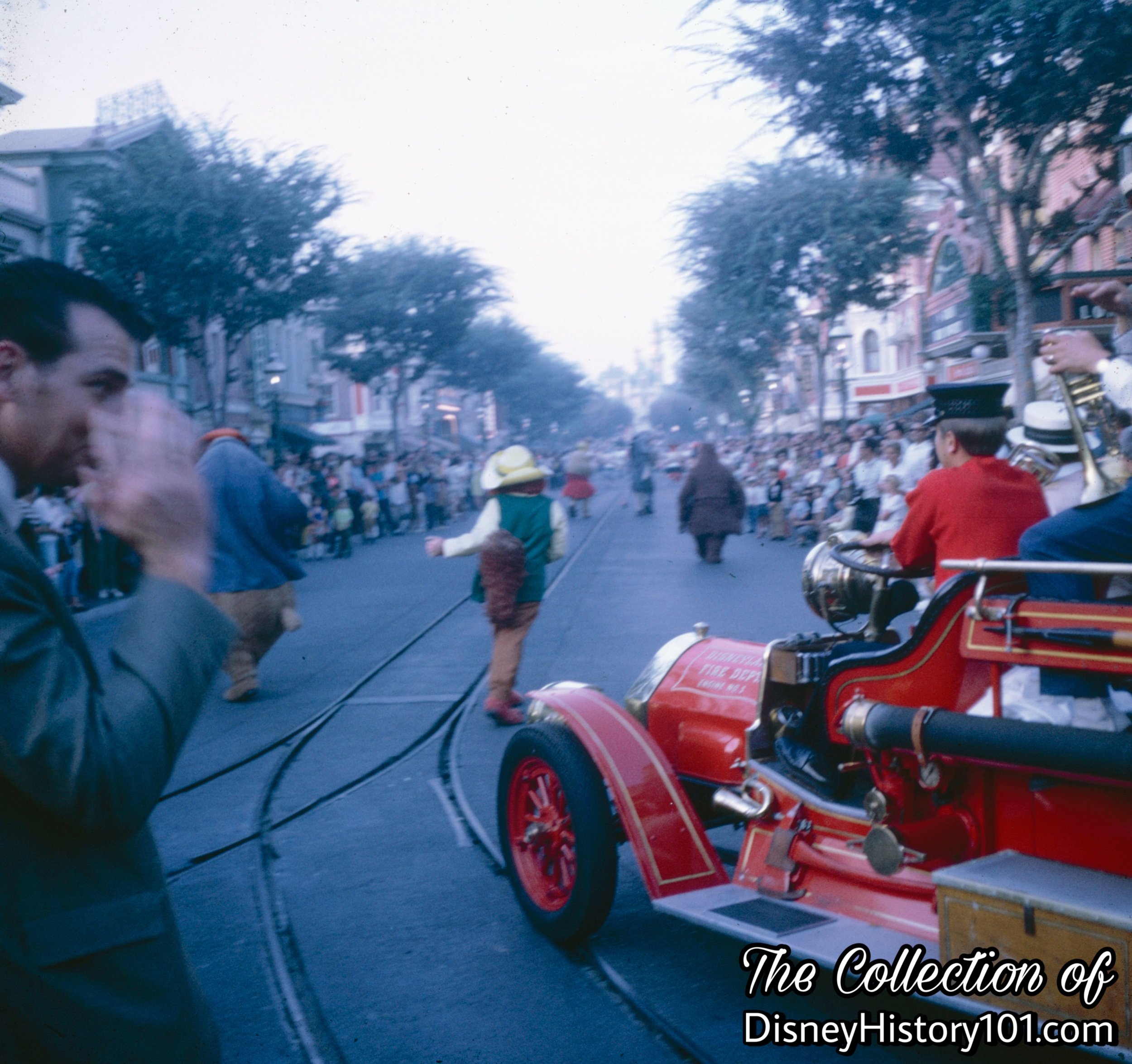
Disneyland Fire Department Engine, (1969)

Disneyland Fire Department Engine, (September 17, 1970)
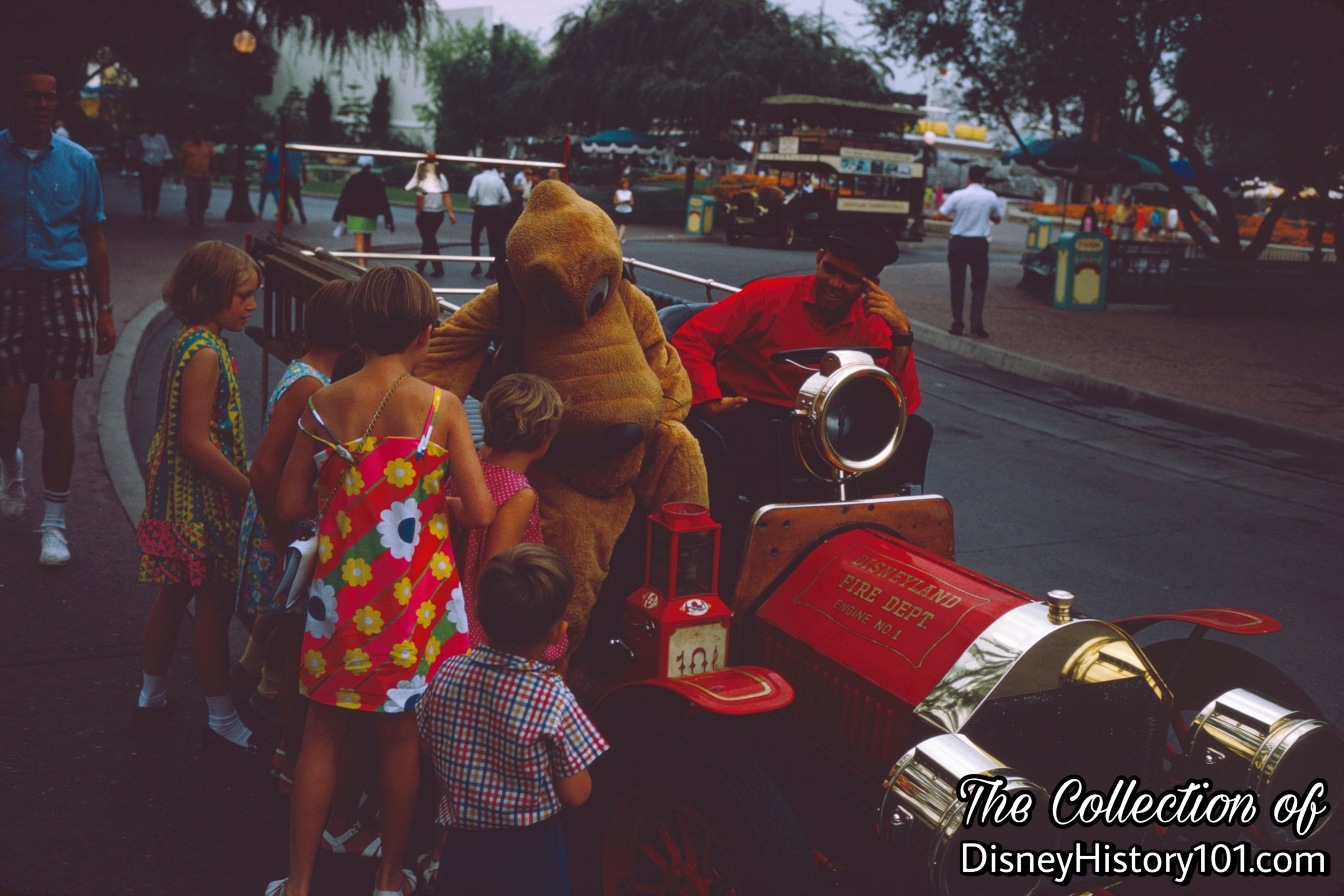

Donald extends a courteous smile as he takes a ride aboard the Disneyland Fire Department Engine, September, 1972.
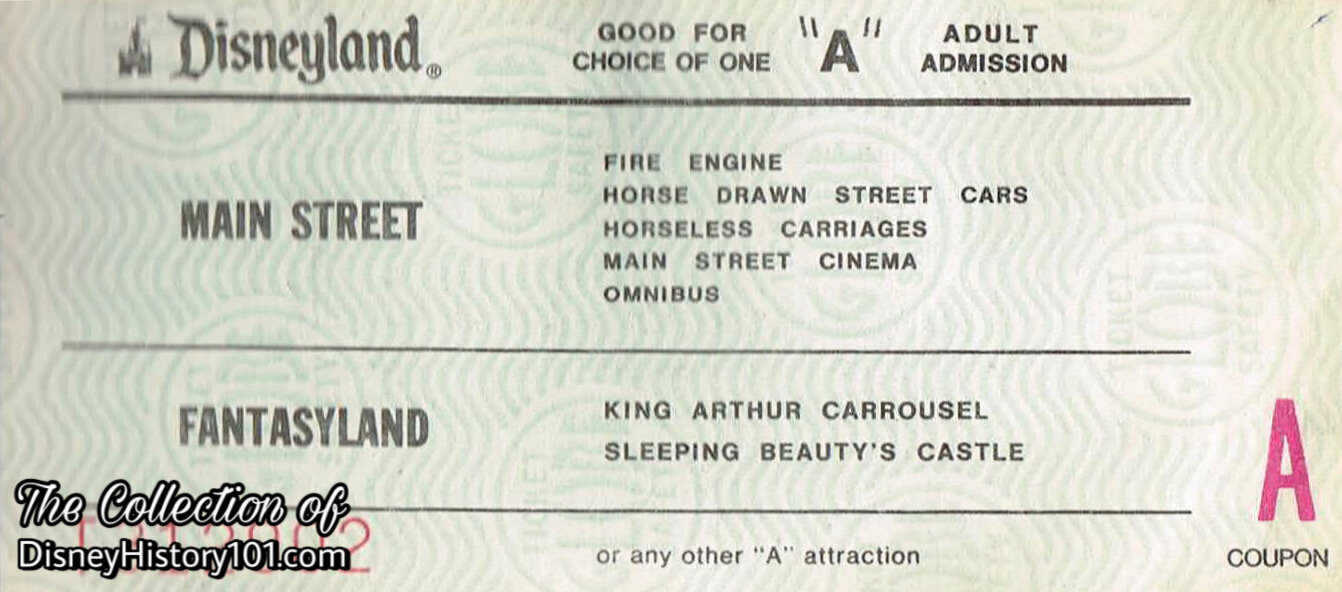
Disneyland "A" Attraction Coupon
By 1981 Main Street Vehicles contributed $24,000 in revenue (of $94,576,000 area sales) for Center Stage at Disneyland.
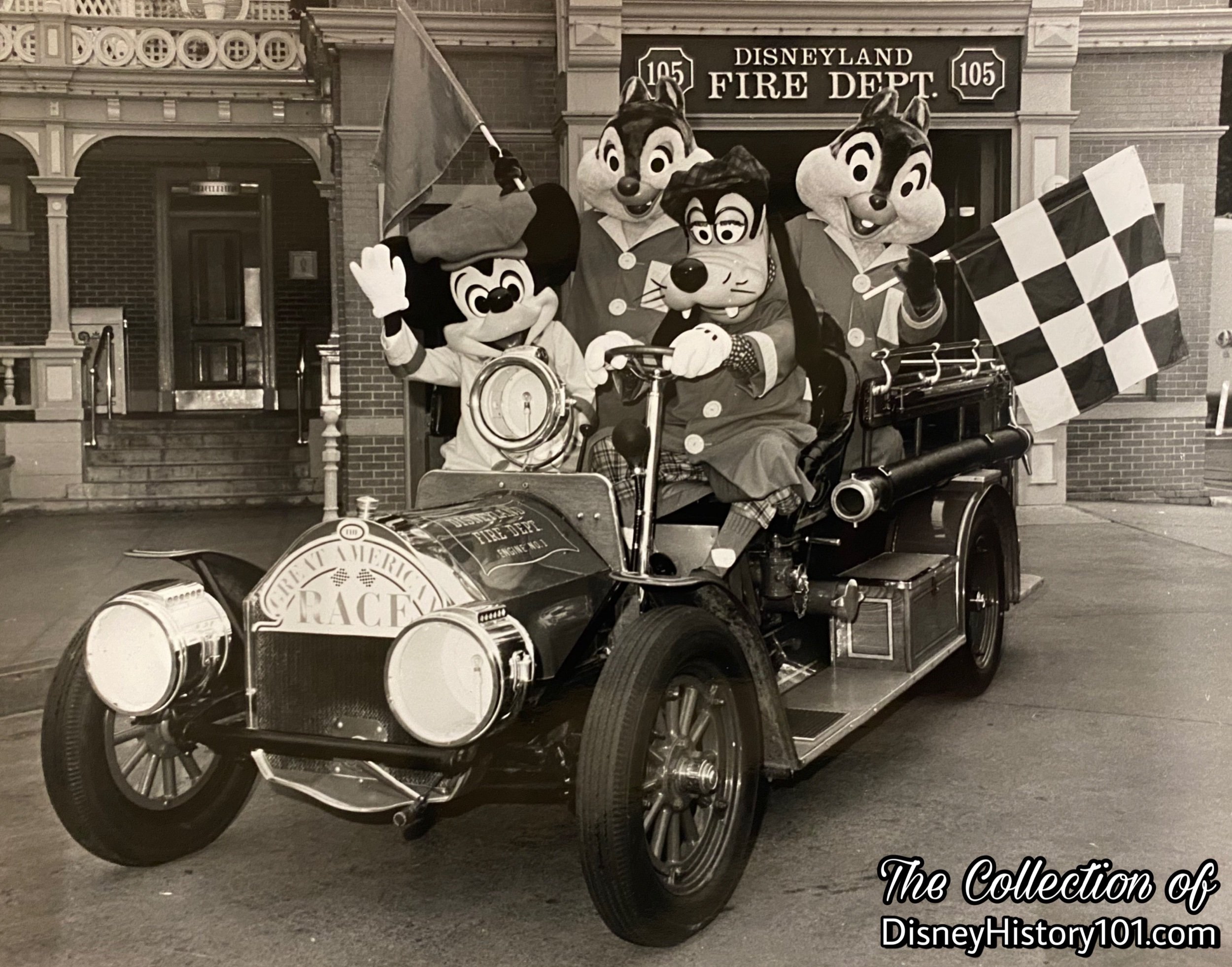
The Disneyland Fire Engine in the Great American Race at Disneyland in Anaheim, California on June 25, 1986; ©Walt Disney Productions.
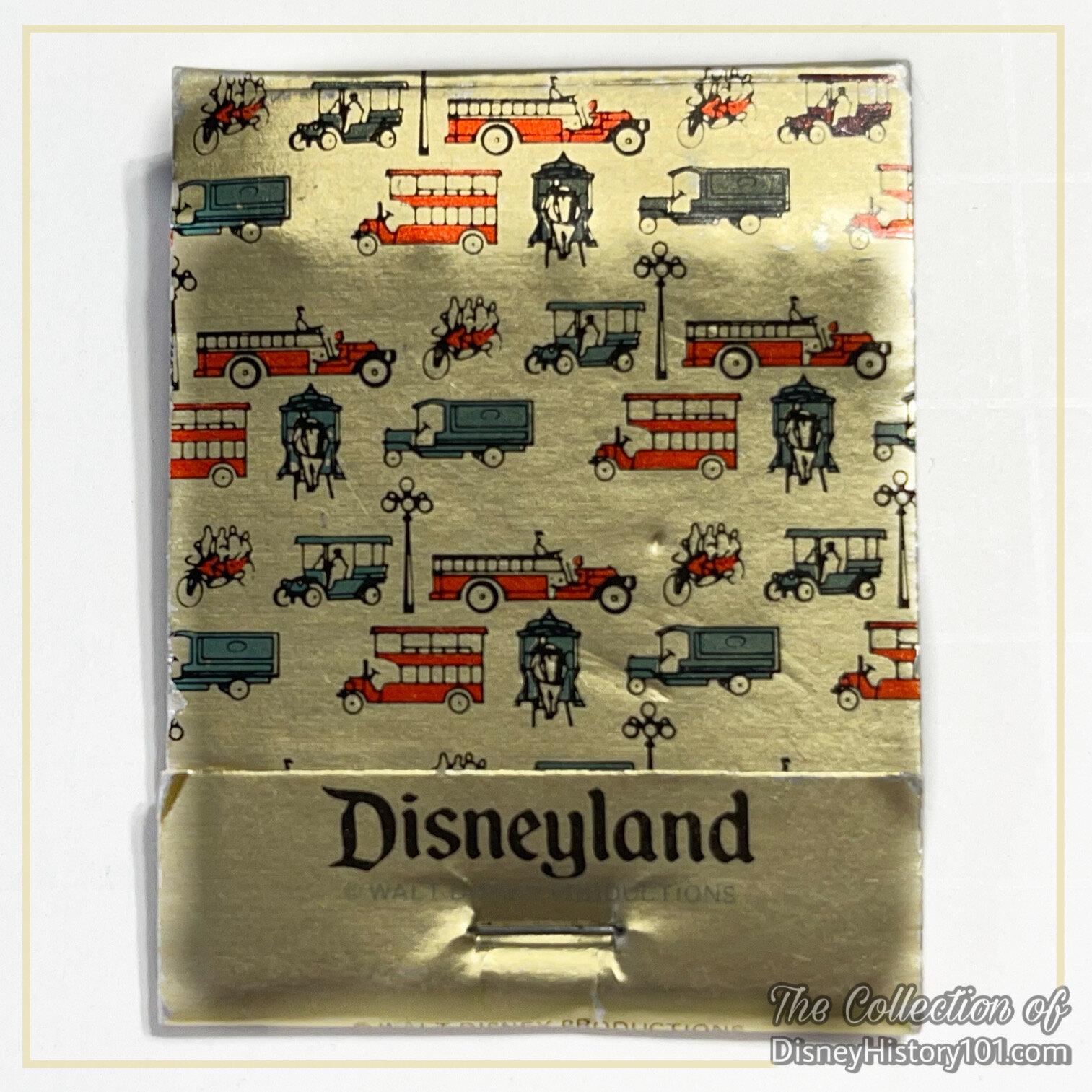
Disneyland Motor Vehicle Souvenir Matchbook, (c.1960’s)
Every now and then, some licensed merchandise was produced, inspired by the Disneyland Fire Engine. One of the most fascinating pieces that was never produced was an Old Fashioned Fire Engine model kit by Strombeck-Becker, Mfg. During 1955, this kit was discussed between Philip Sammeth of Walt Disney Productions Character Merchandise Division and C.S. Olson of Strombeck-Becker. While the possibility of a Fire Engine model (based on the Horse Drawn Chemical Wagon; proportionate in size to the Stage Coach Model Kit) was explored, it was never fully realized or produced.
One of my favorites (among the licensed merchandise produced) remains this matchbook, which commemorates the D.M.C. vehicles of both the motor-driven and horse-drawn variety. The Dapper Dan’s custom bicycle makes several appearances, as well as the Disneyland Fire Engine.
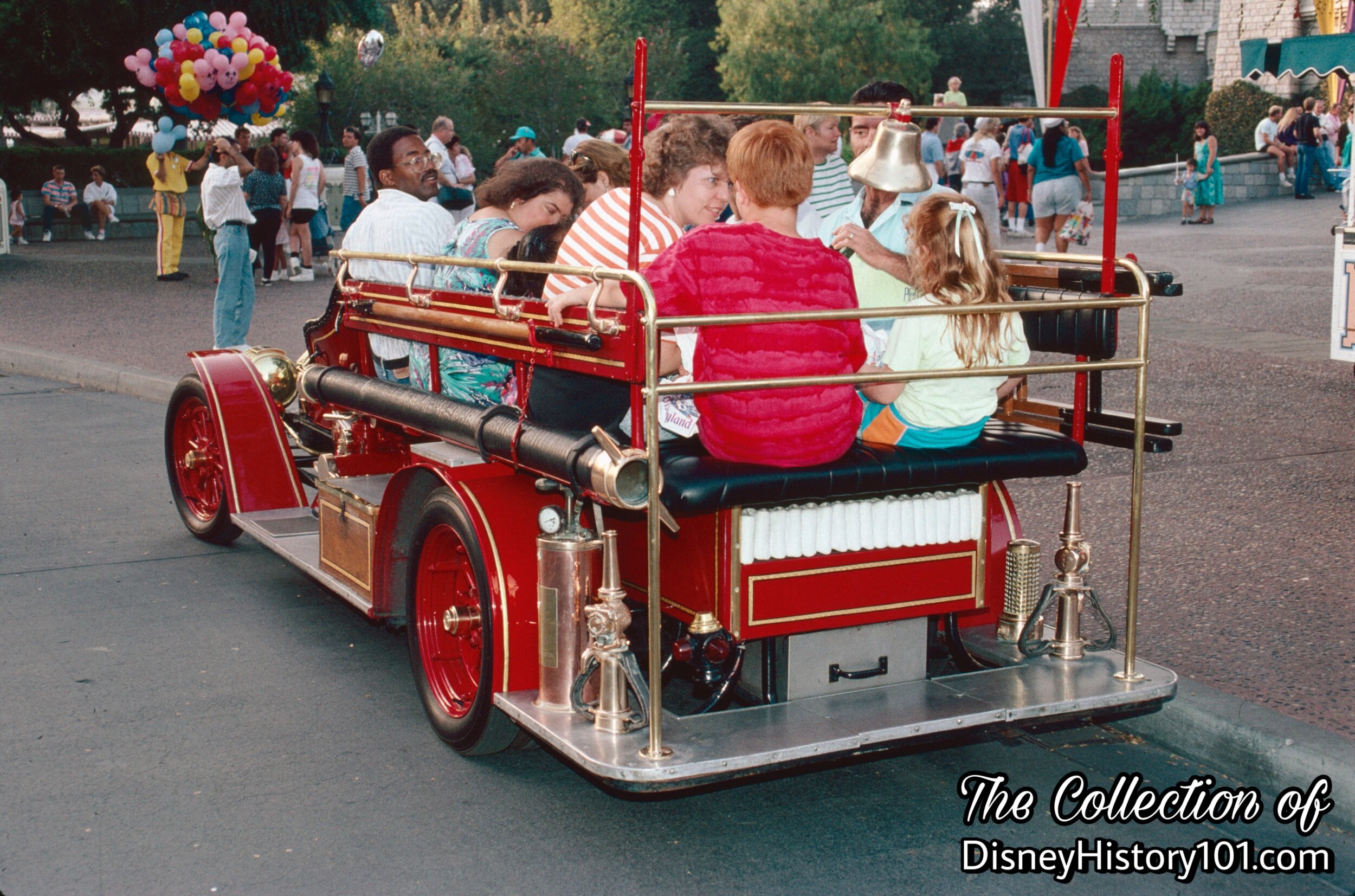
Disneyland Fire Department Engine, (1991)
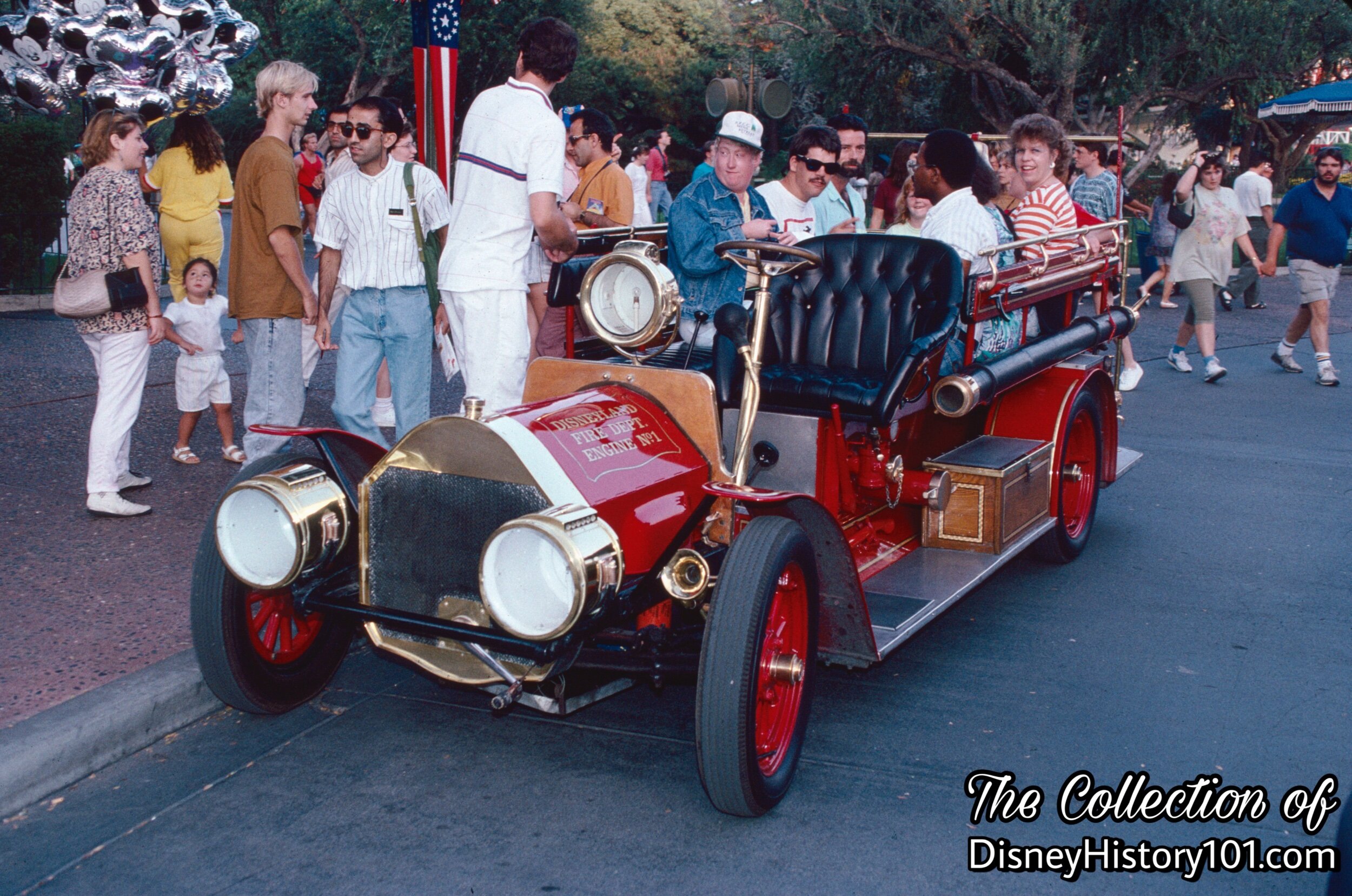
Disneyland Fire Department Engine, (1991)
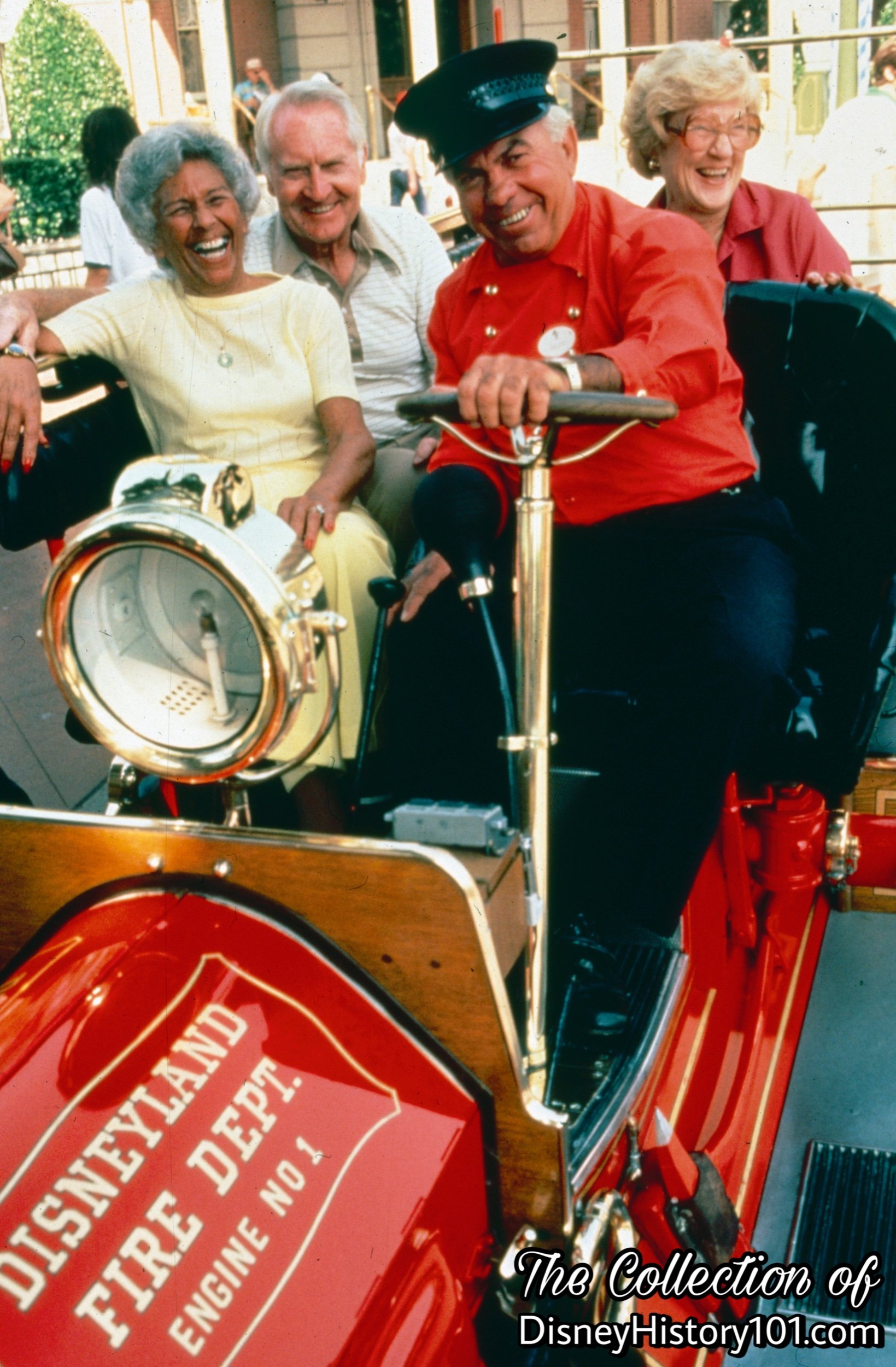
“It has been said that a Guest interacts with about 60 Cast Members during a visit. Keep in mind, this estimate refers to ‘interactions’, not all of the Cast Members a Guest actually sees.” This number includes the Hosts and Hostesses that re-create Main Street, U.S.A. with a show that is played up to Walt Disney standards. Hosts show an enthusiastic personality - an appearance, smile, and both outgoing and enthusiastic personality. They wear proper attire, a prescribed wardrobe in good repair and properly worn at all times. Hosts deliver an interesting narration - a good one. They know their facts, state them in an interesting way, and give them with enthusiasm. Hosts have a sparkling and clean appearance, that is essential to Disneyland showmanship. Hosts do their part in keeping their vehicle clean at all times. They are “popcorn picker-uppers”. Their realistic performance is most-important, living their role. The Disneyland Fire Engine Host is a conductor or driver at the turn of the century - only much more friendly and courteous!
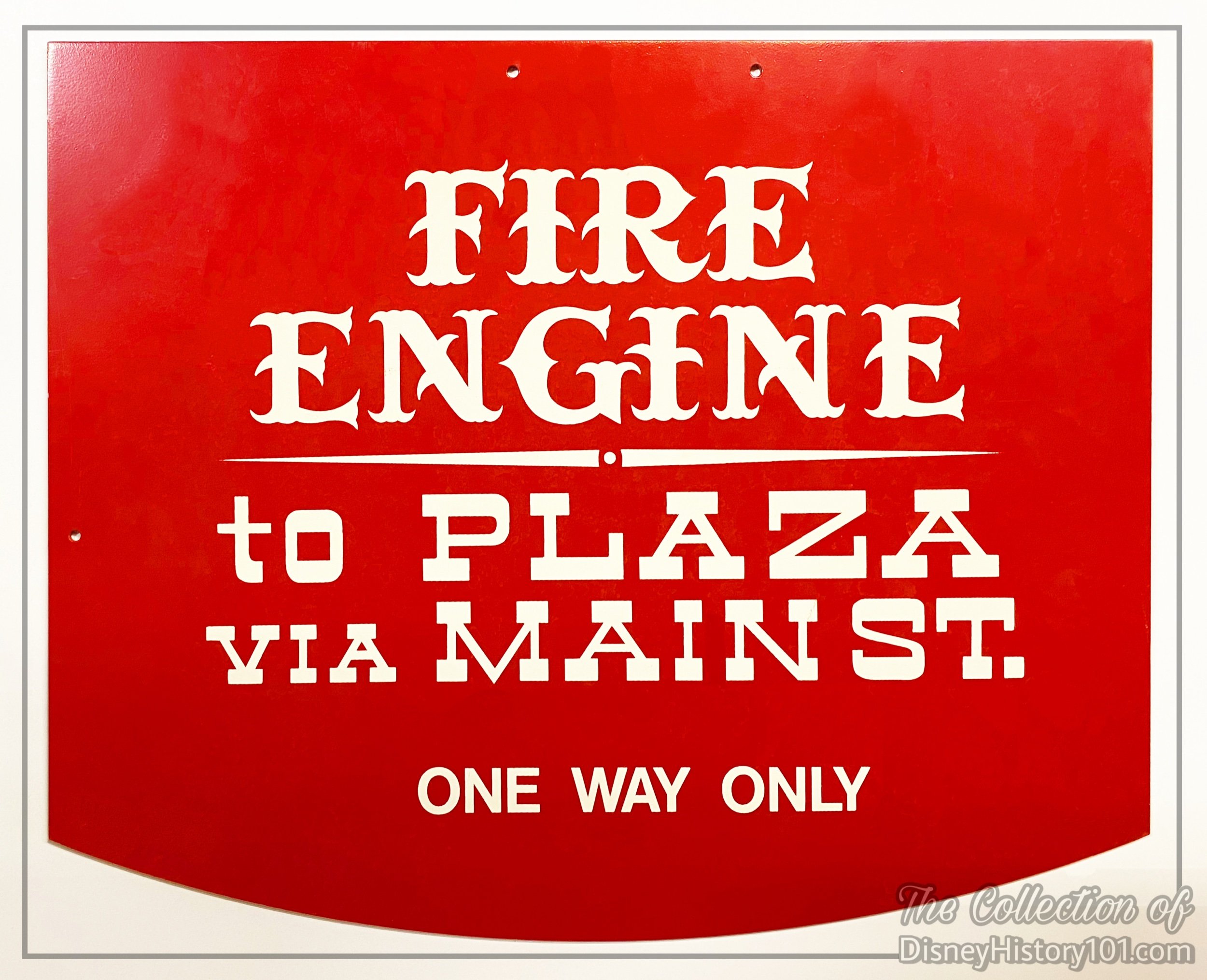
By 1996, the Main Street Vehicles (Fire Engine, Horseless Carriage, Omnibus, Horse-Drawn Streetcars, ‘03 Red, ‘03 Yellow, Double-decker touring bus (5/8-scale), and Horse-powered trolley cars were presented by National Interrent.
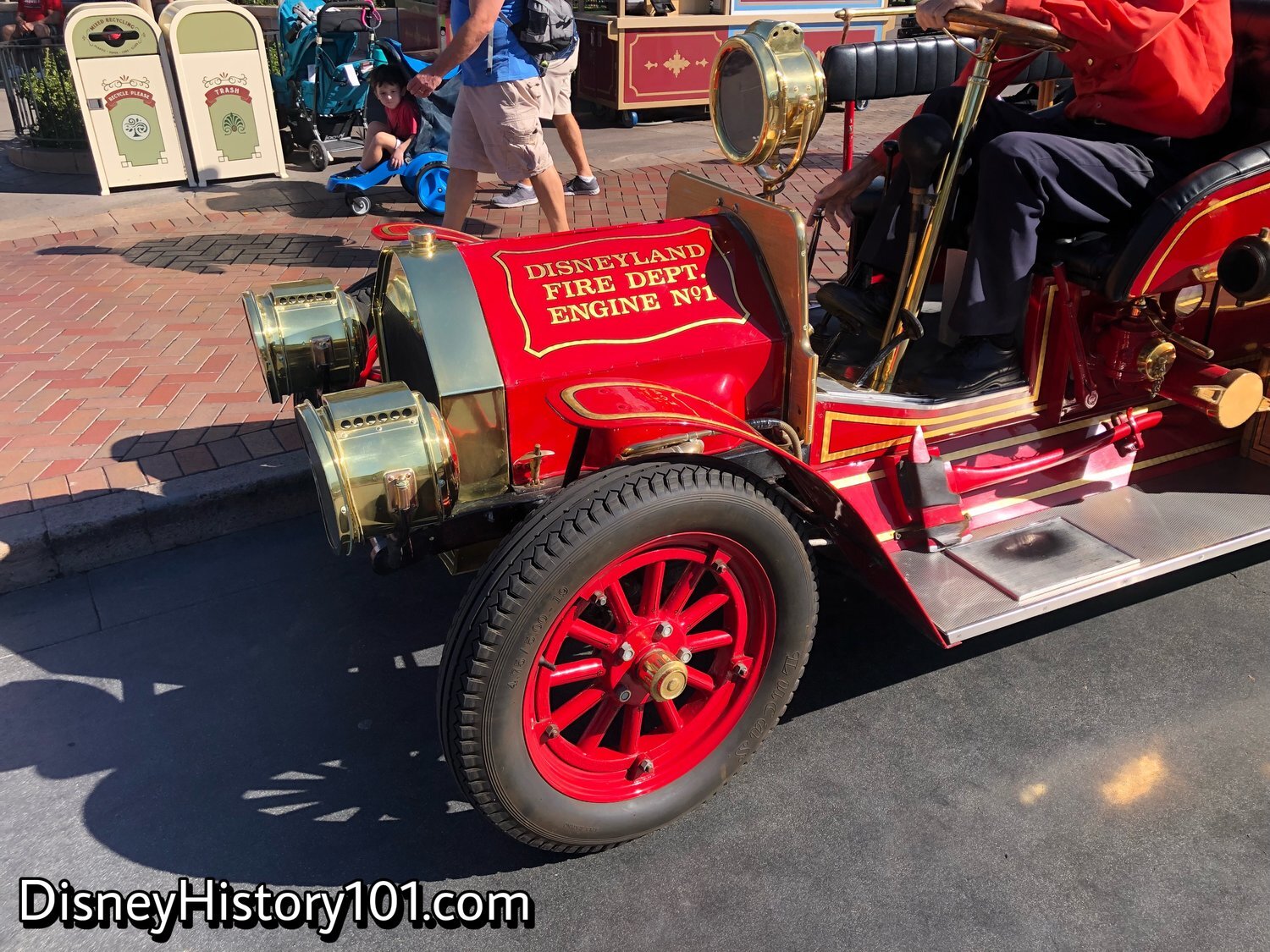
The sparkling appearance of the Disneyland Fire Department Engine
The Disneyland Fire Department Engine has received regular maintenance and rehabilitations through the decades. Some (like the new gold-leaf font of the characters on the hood) are more noticeable than others.
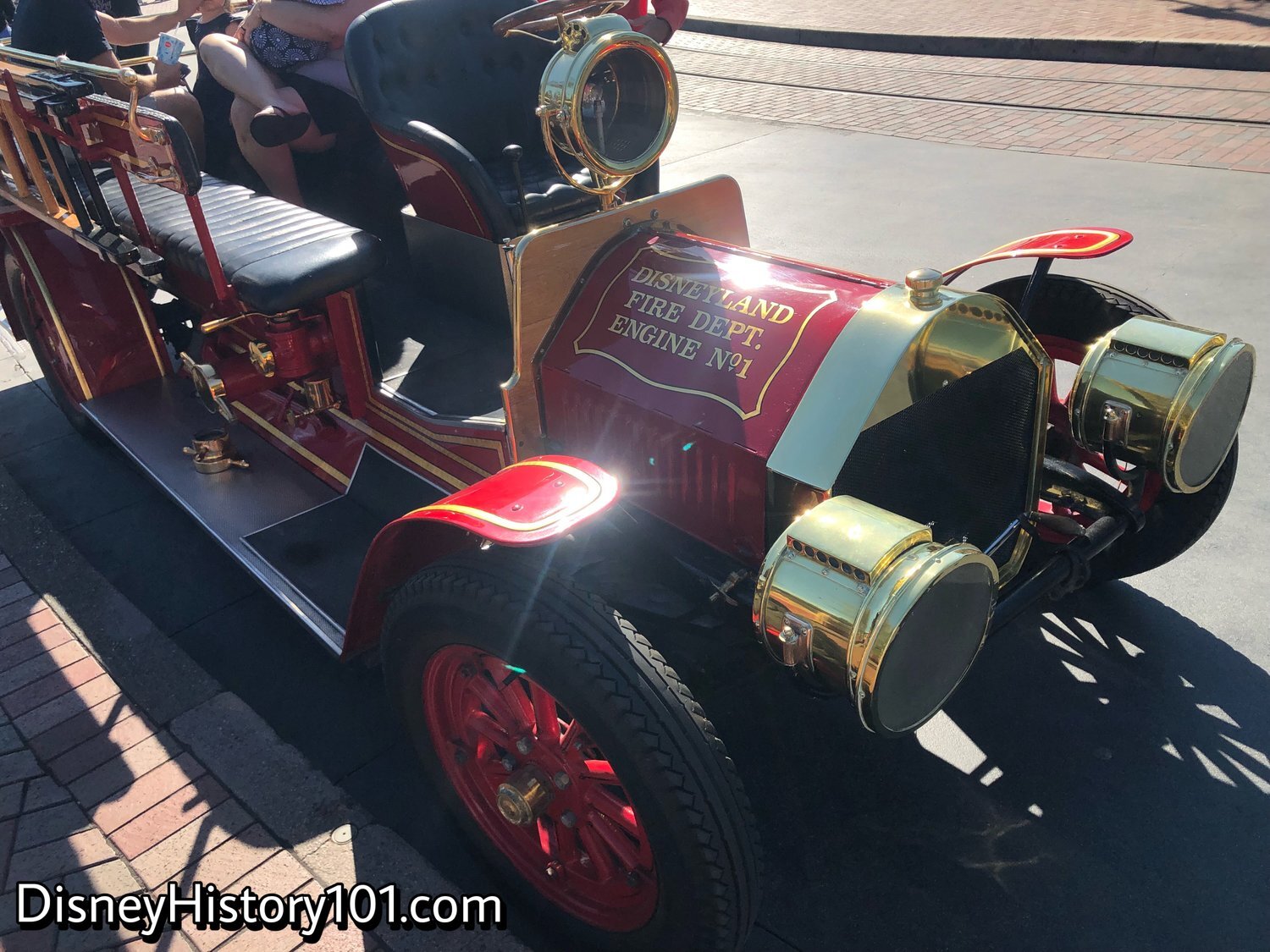
The sparkling appearance of the Disneyland Fire Department Engine, The Present
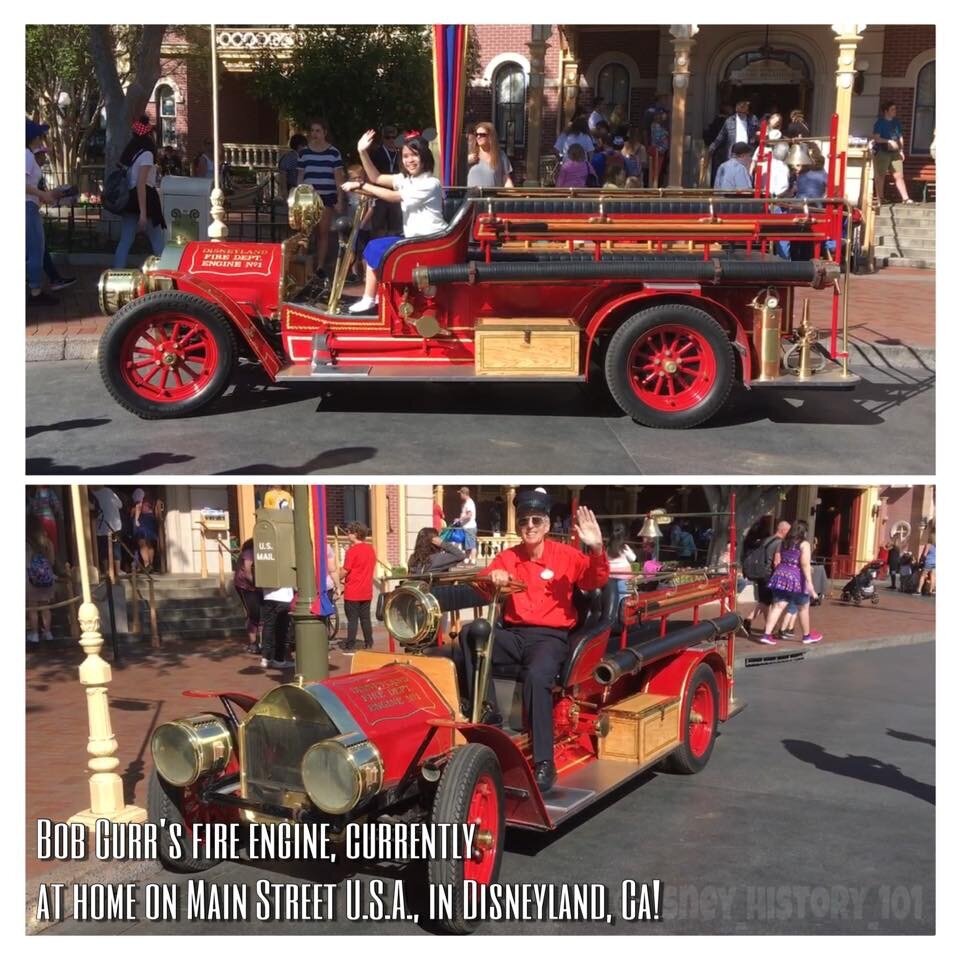
Disneyland Fire Department Engine, The Present
Disneyland actually looses money on Main Street vehicles, but they are vitally important to the showmanship of Walt’s recreation of Main Street U.S.A. These are essential, operated by the “first impression” and “last impression” representative host of Disneyland.
By the 1990s, the name on the attraction’s sign had been shortened from Main Street Fire Engine to simply, Fire Engine.

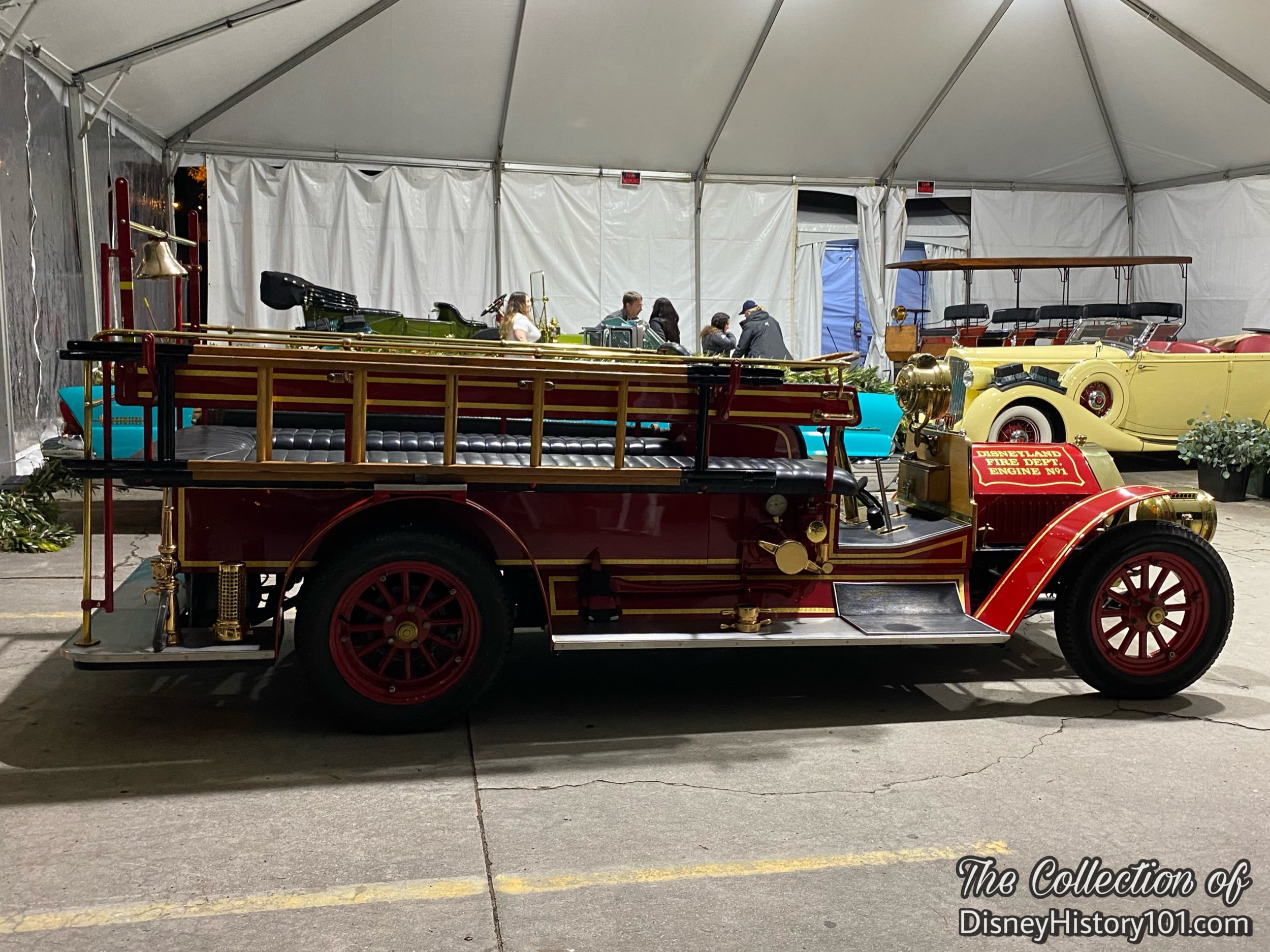
Disneyland Fire Engine awaits its appearance in the 2023 Tournament of Roses Parade.
